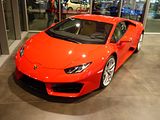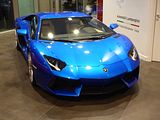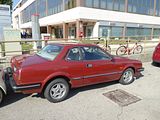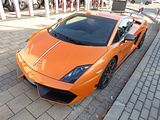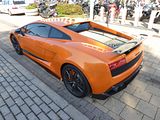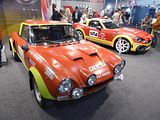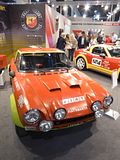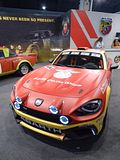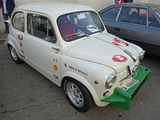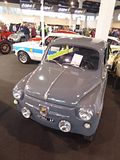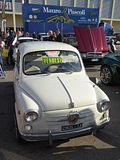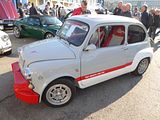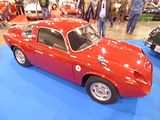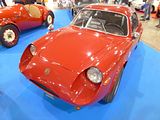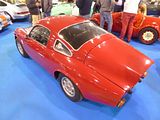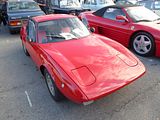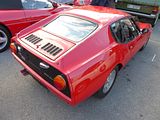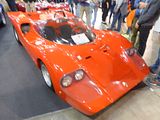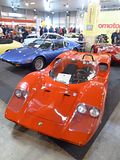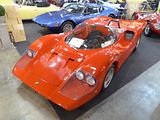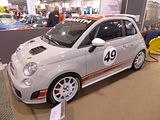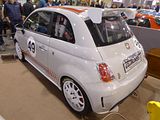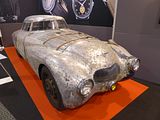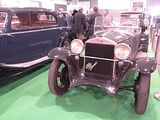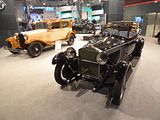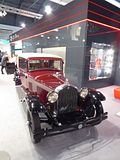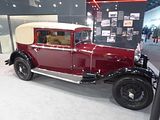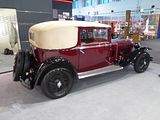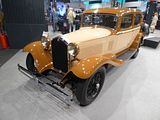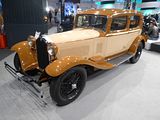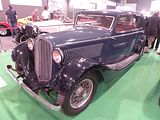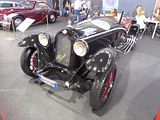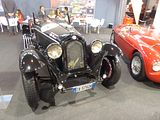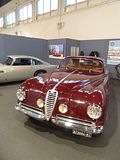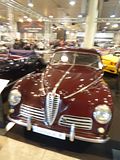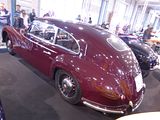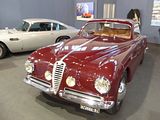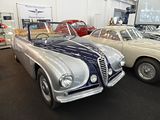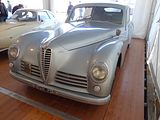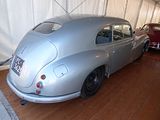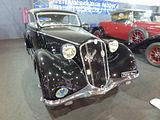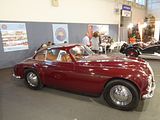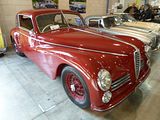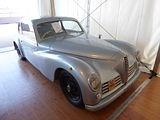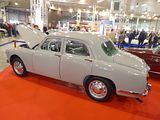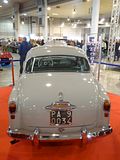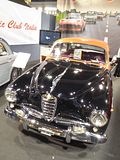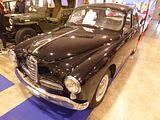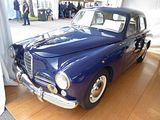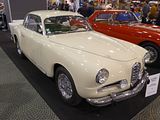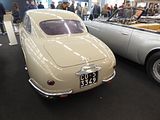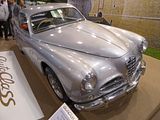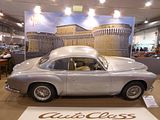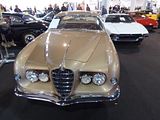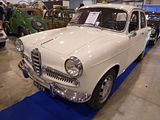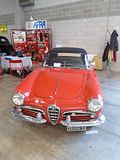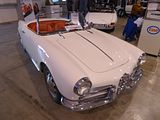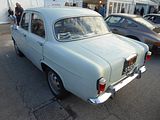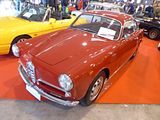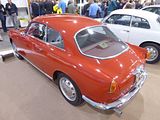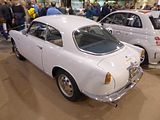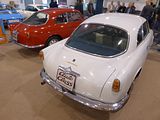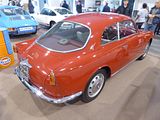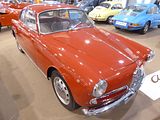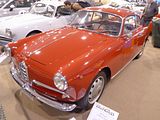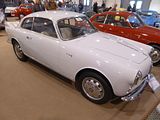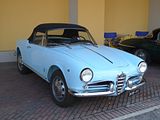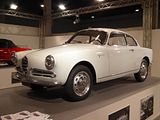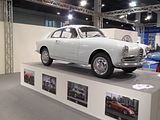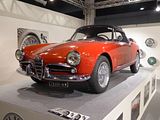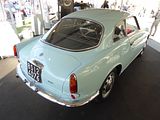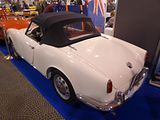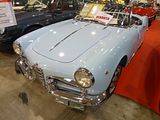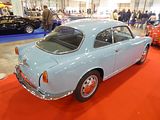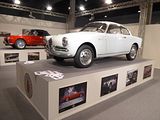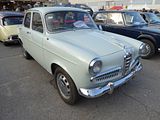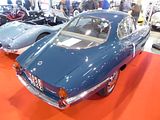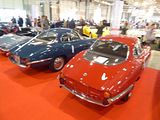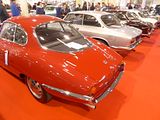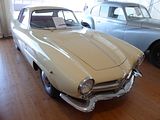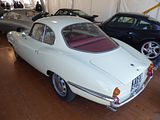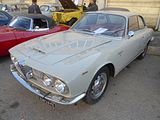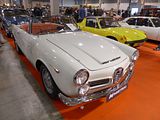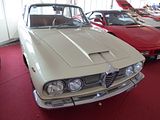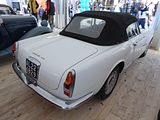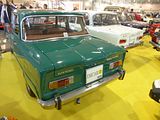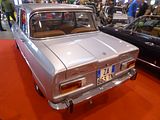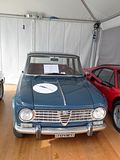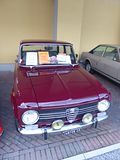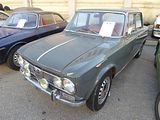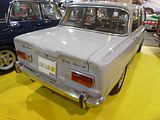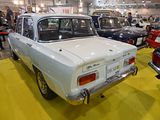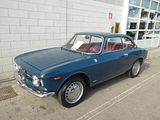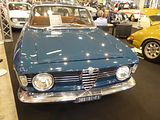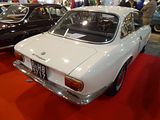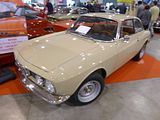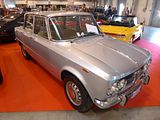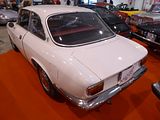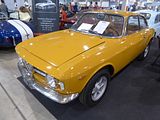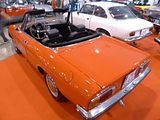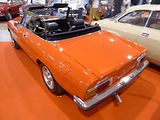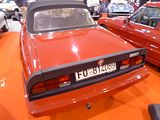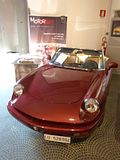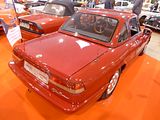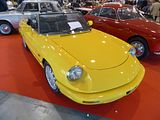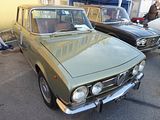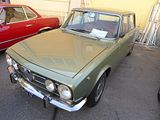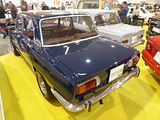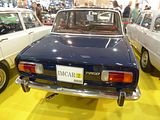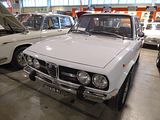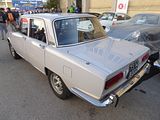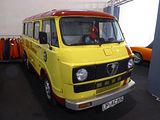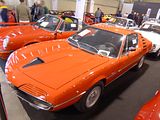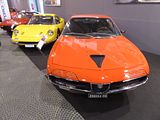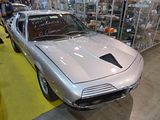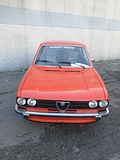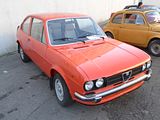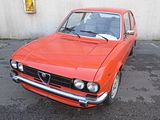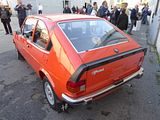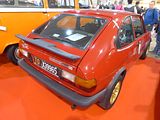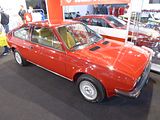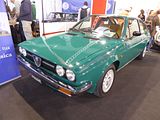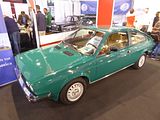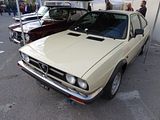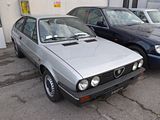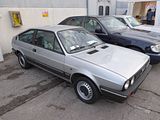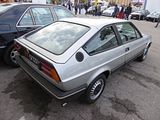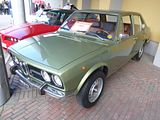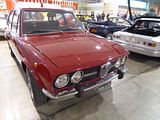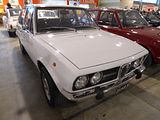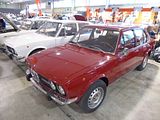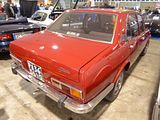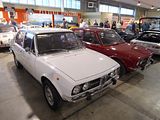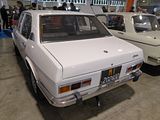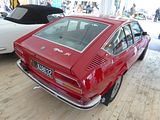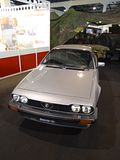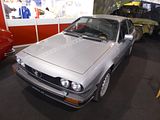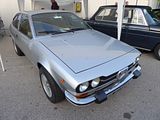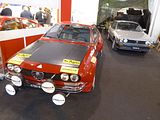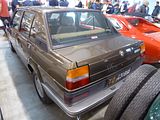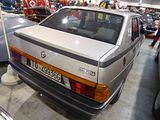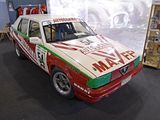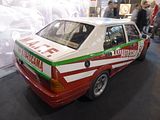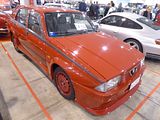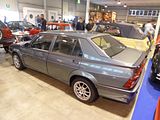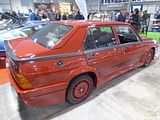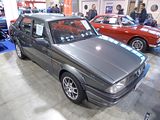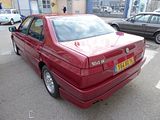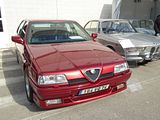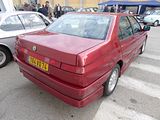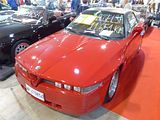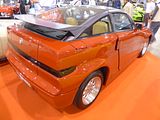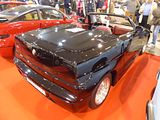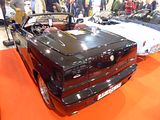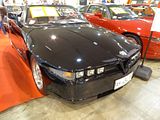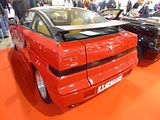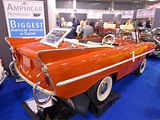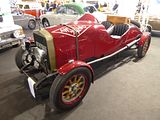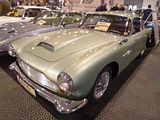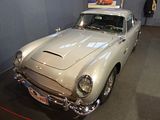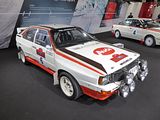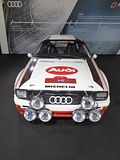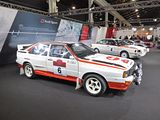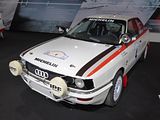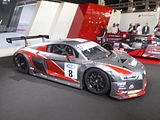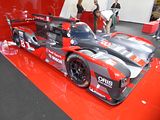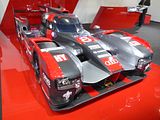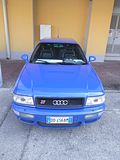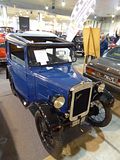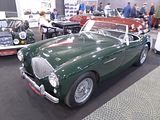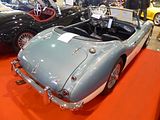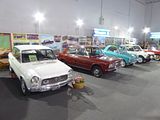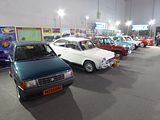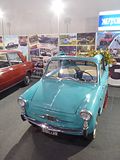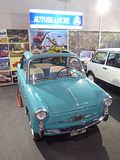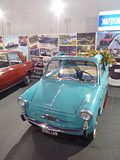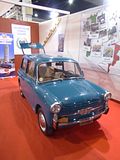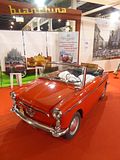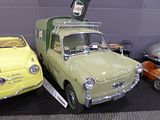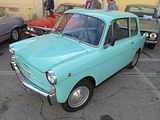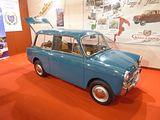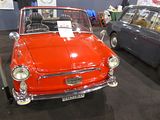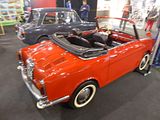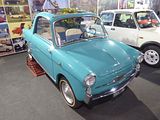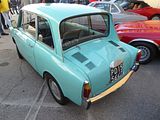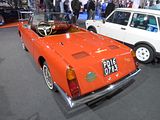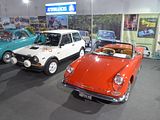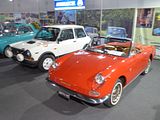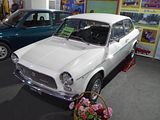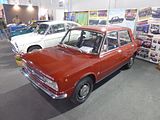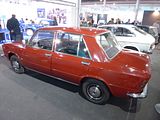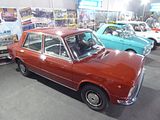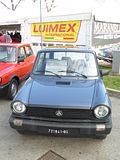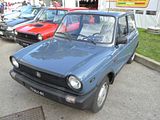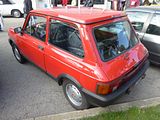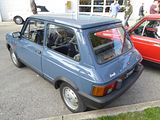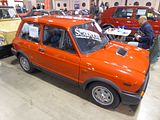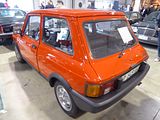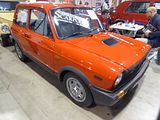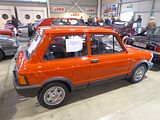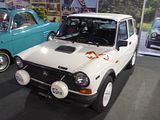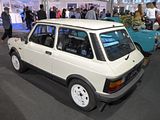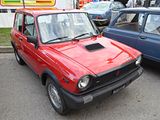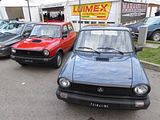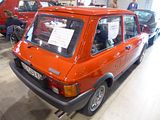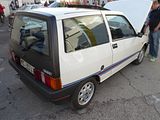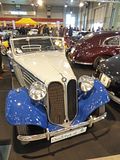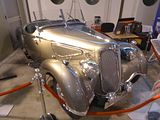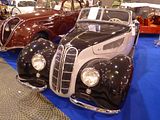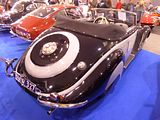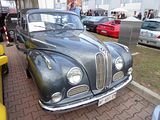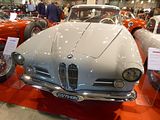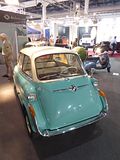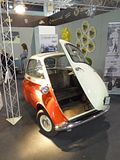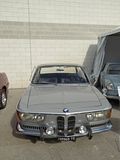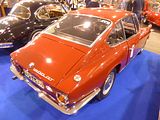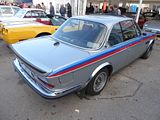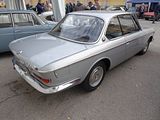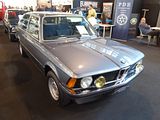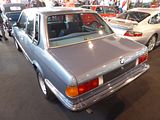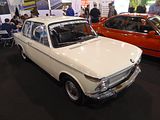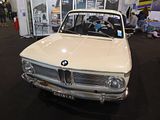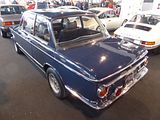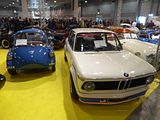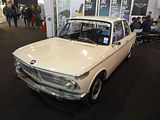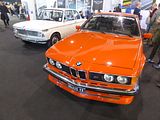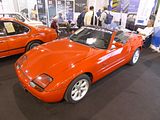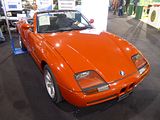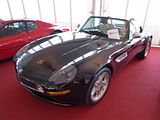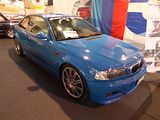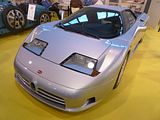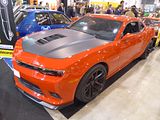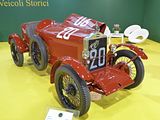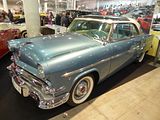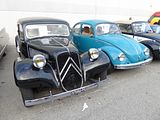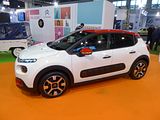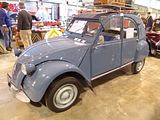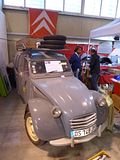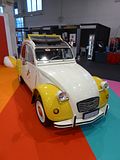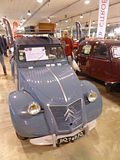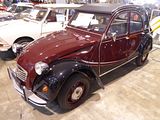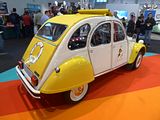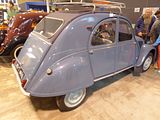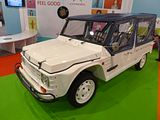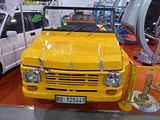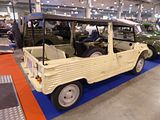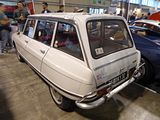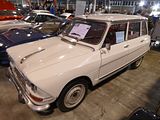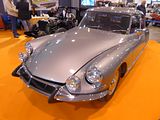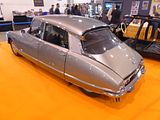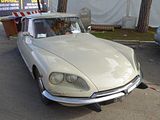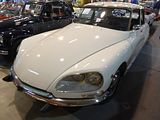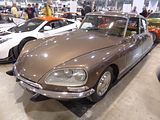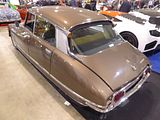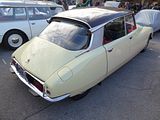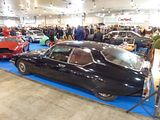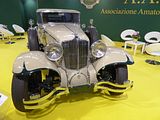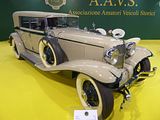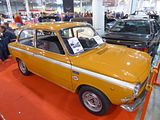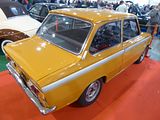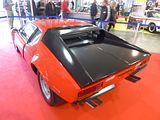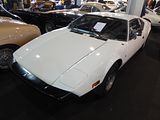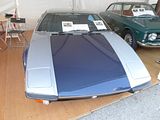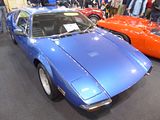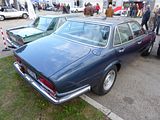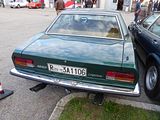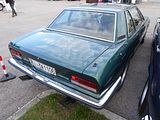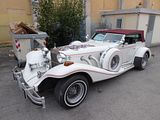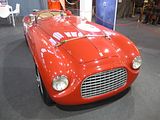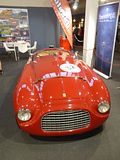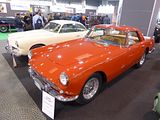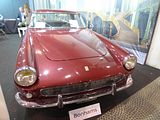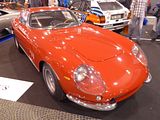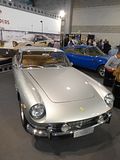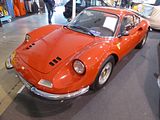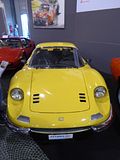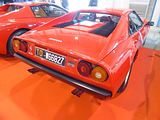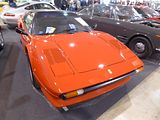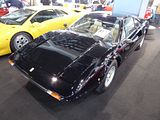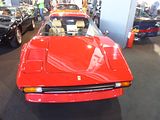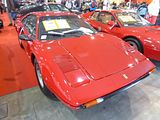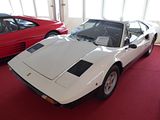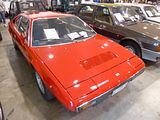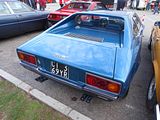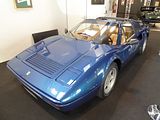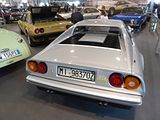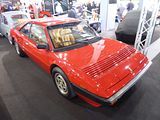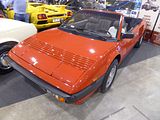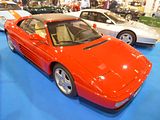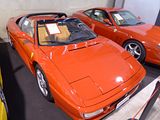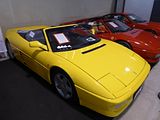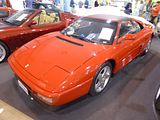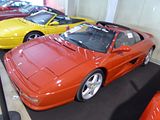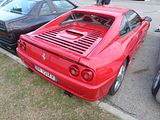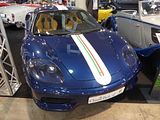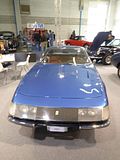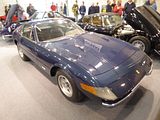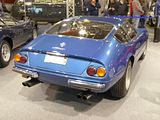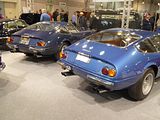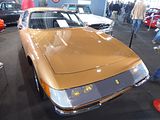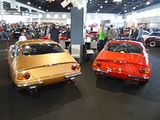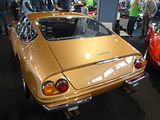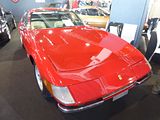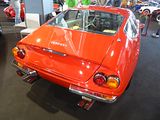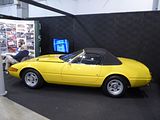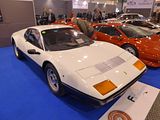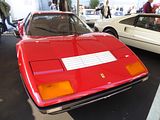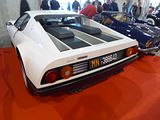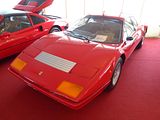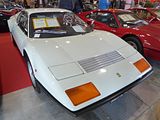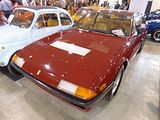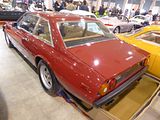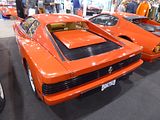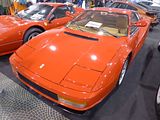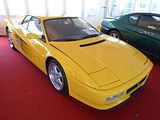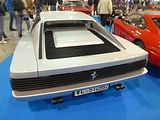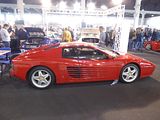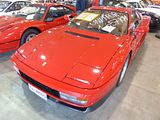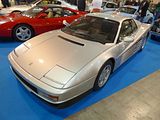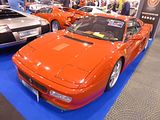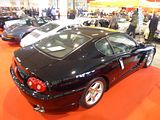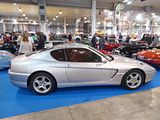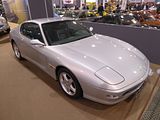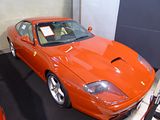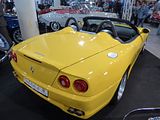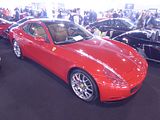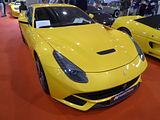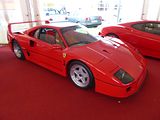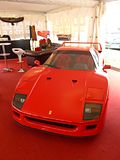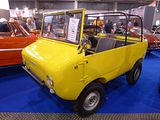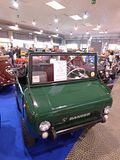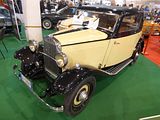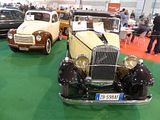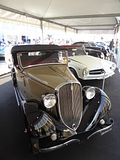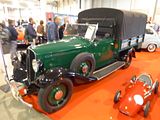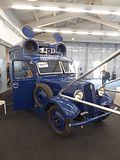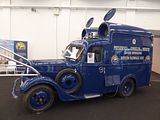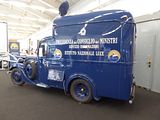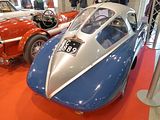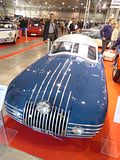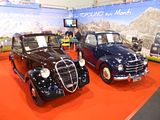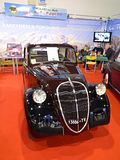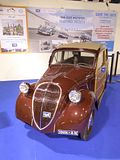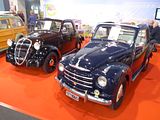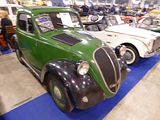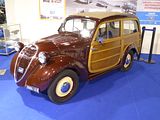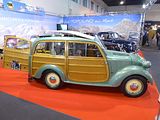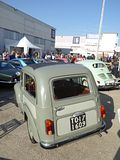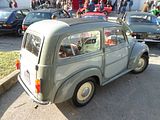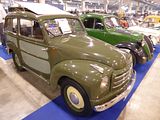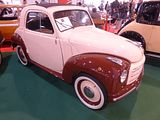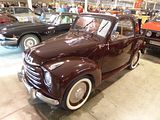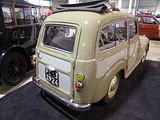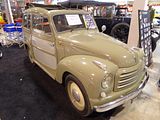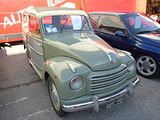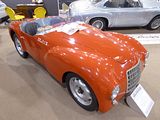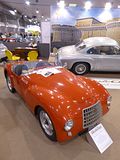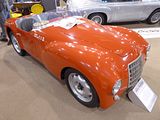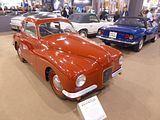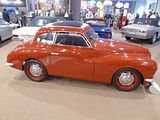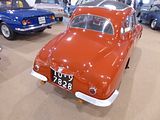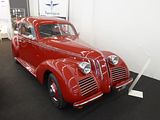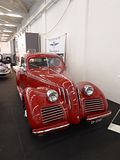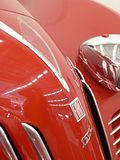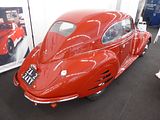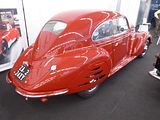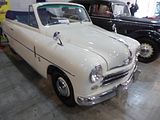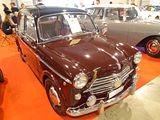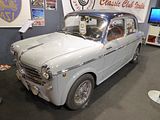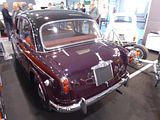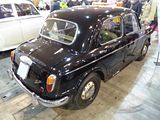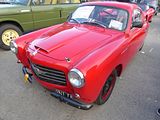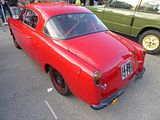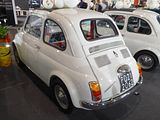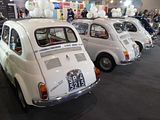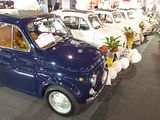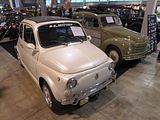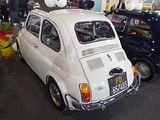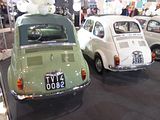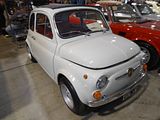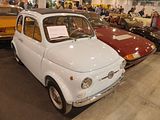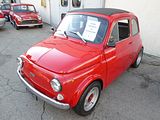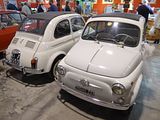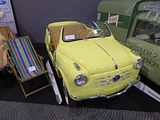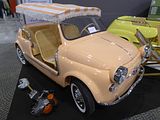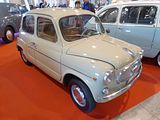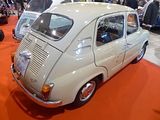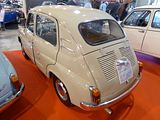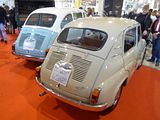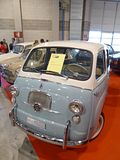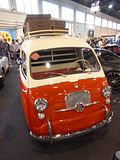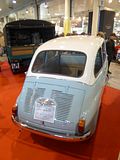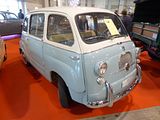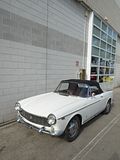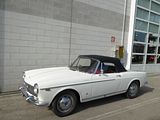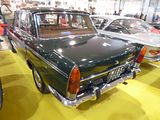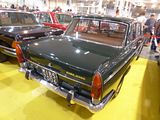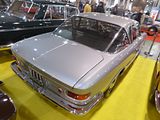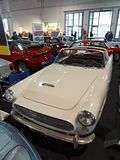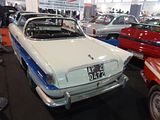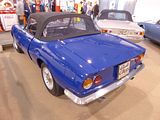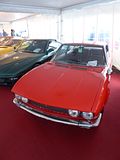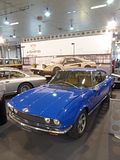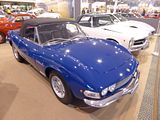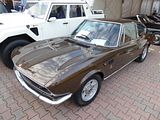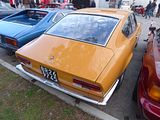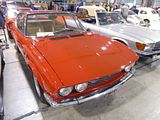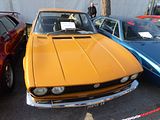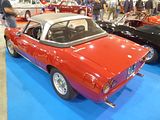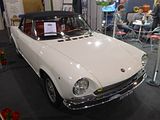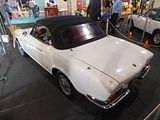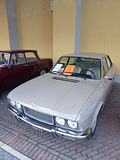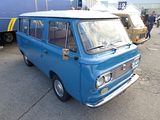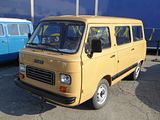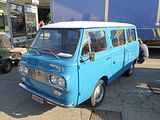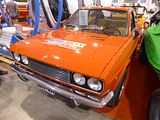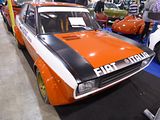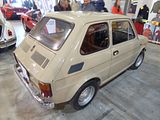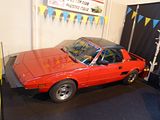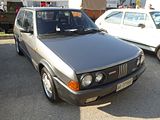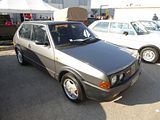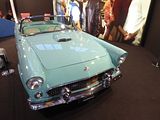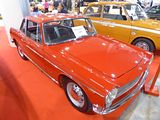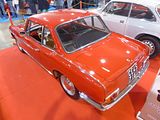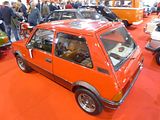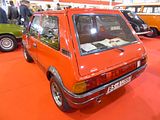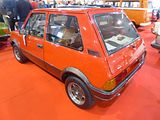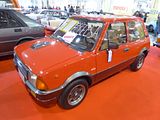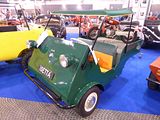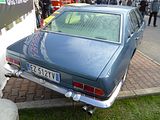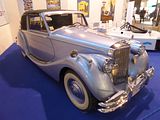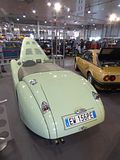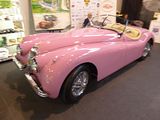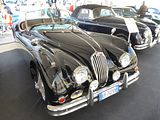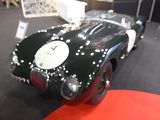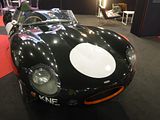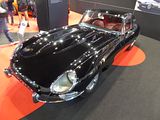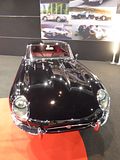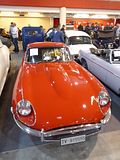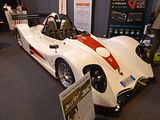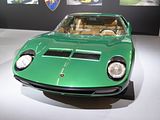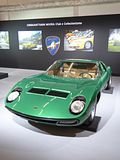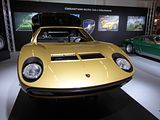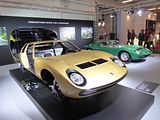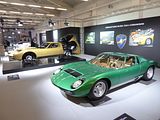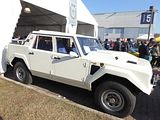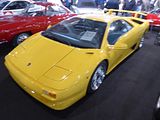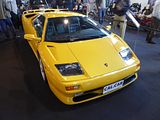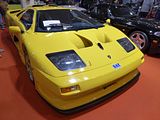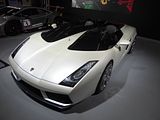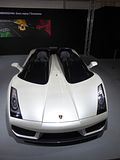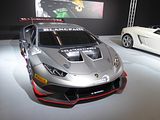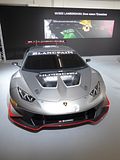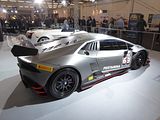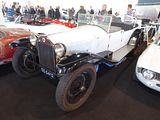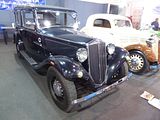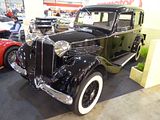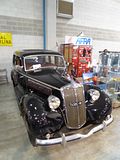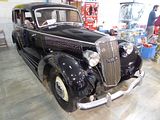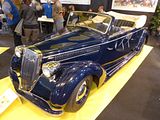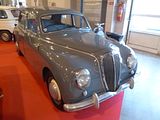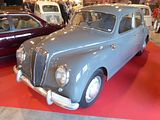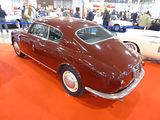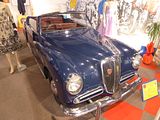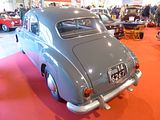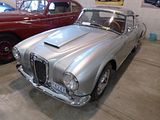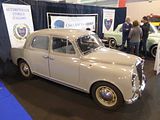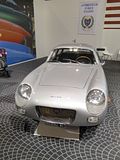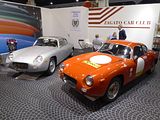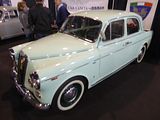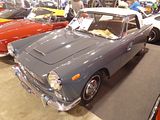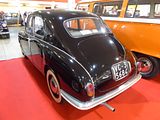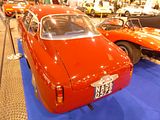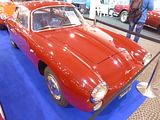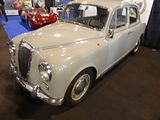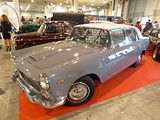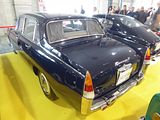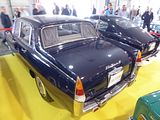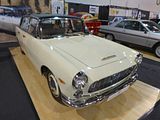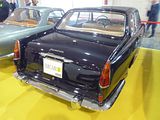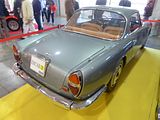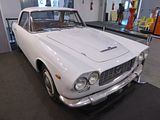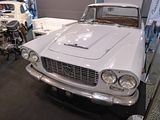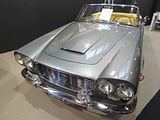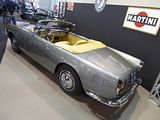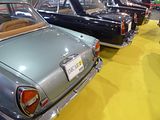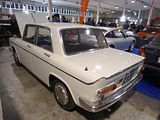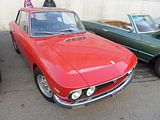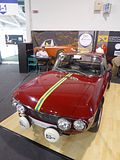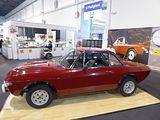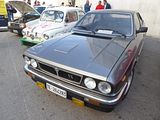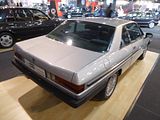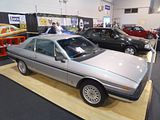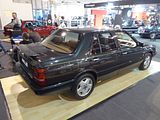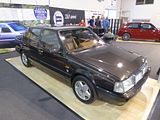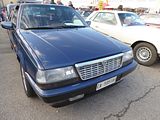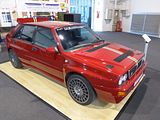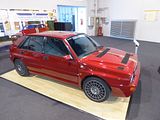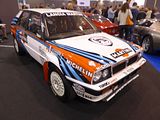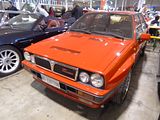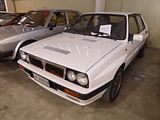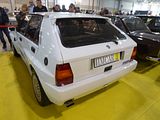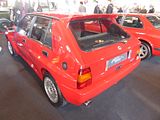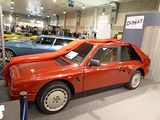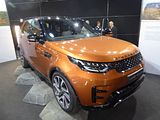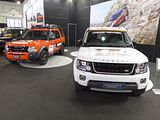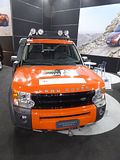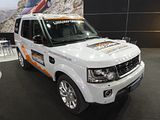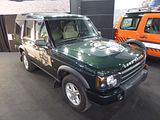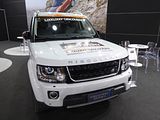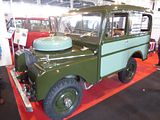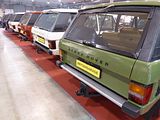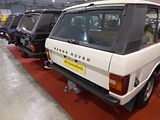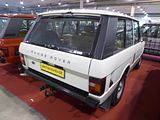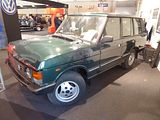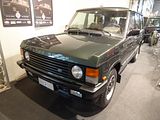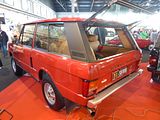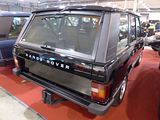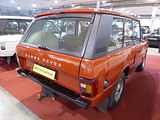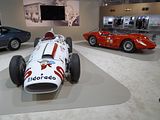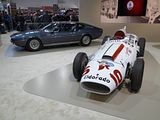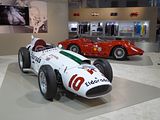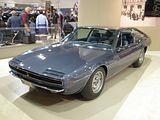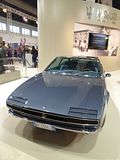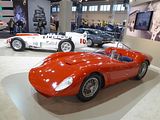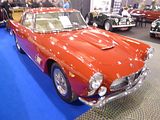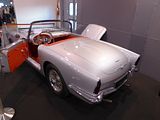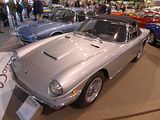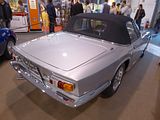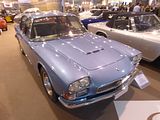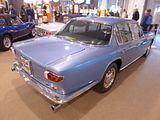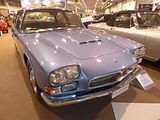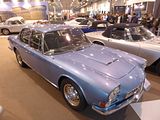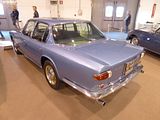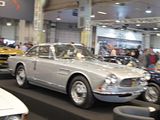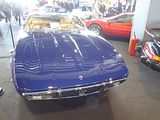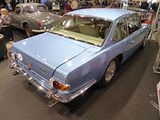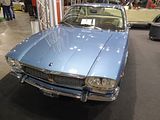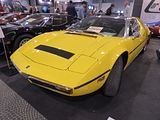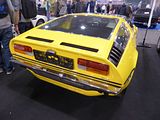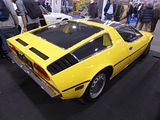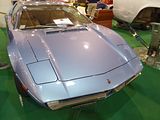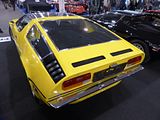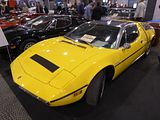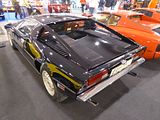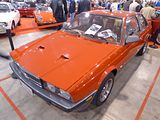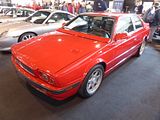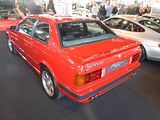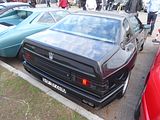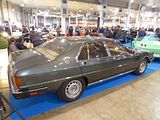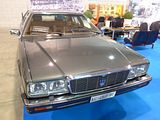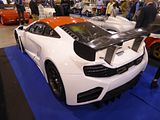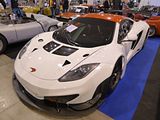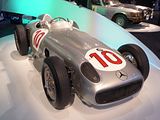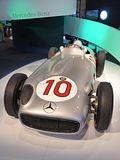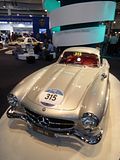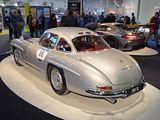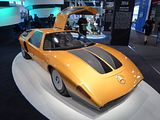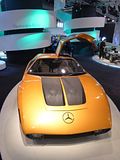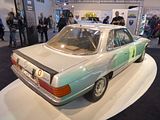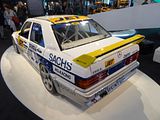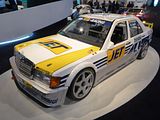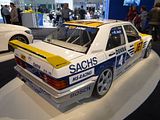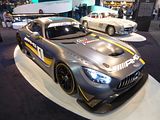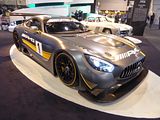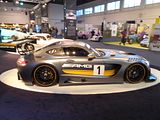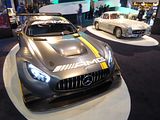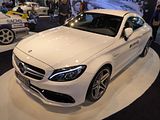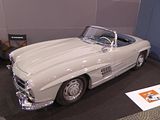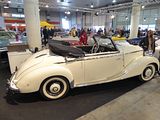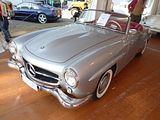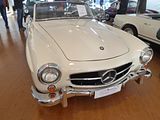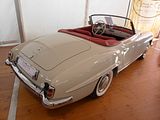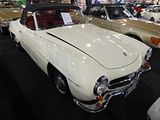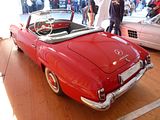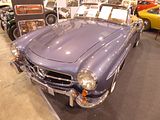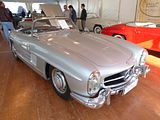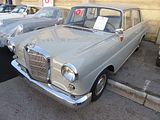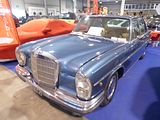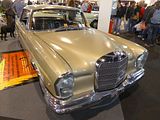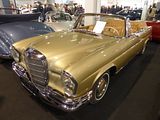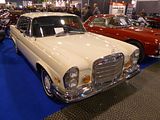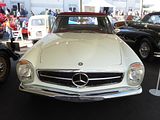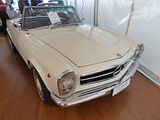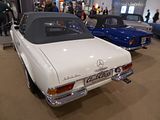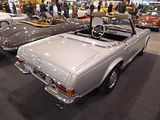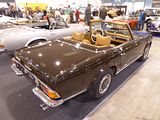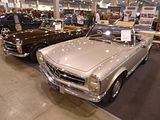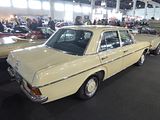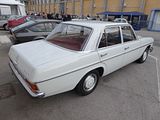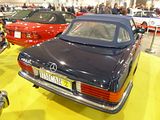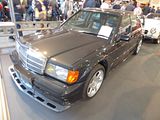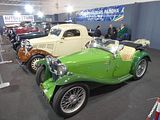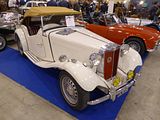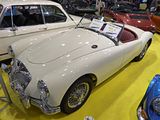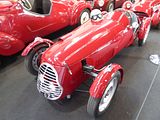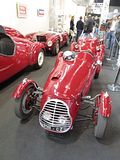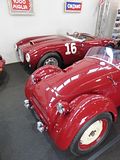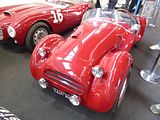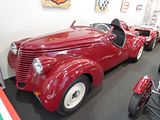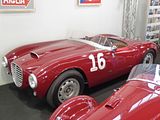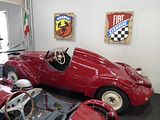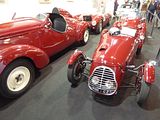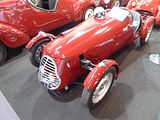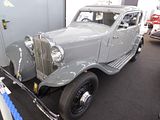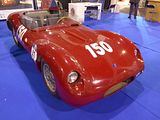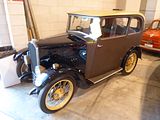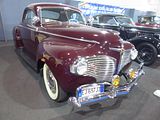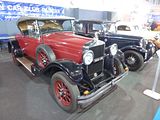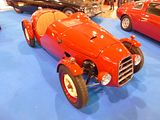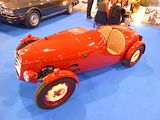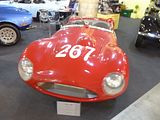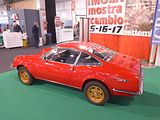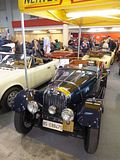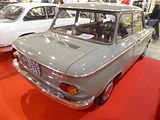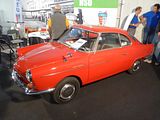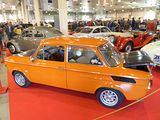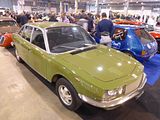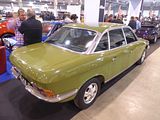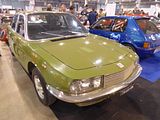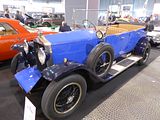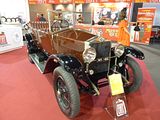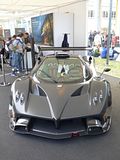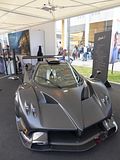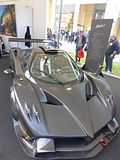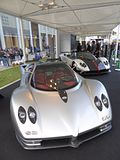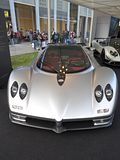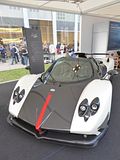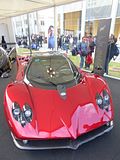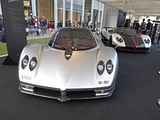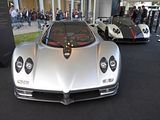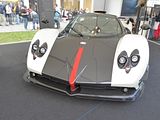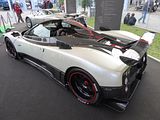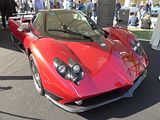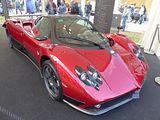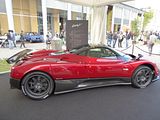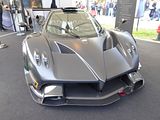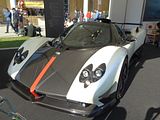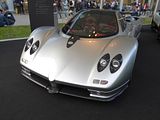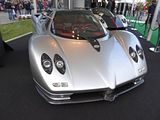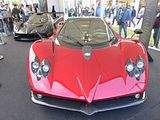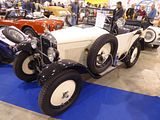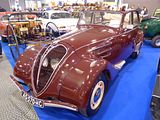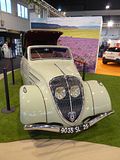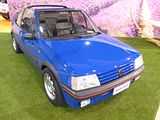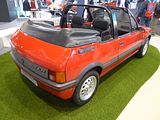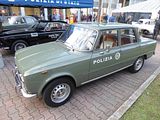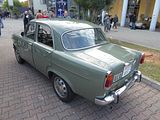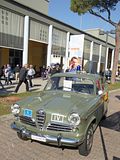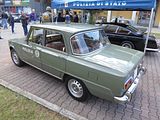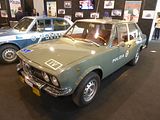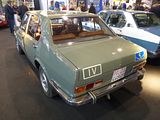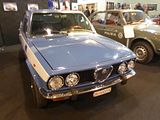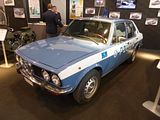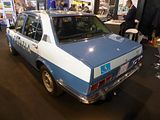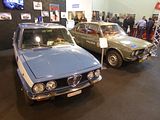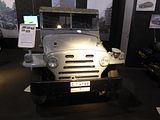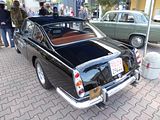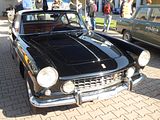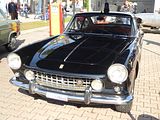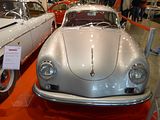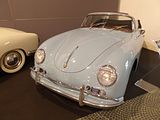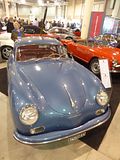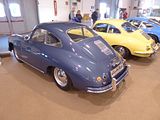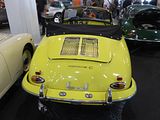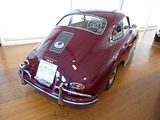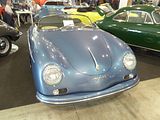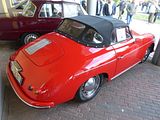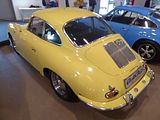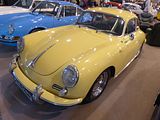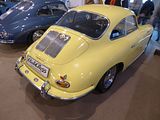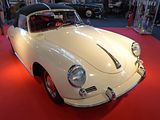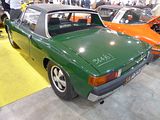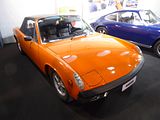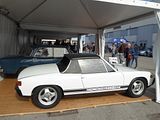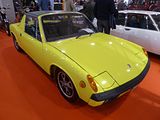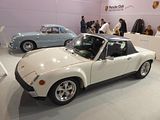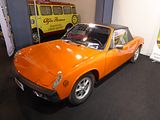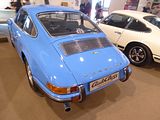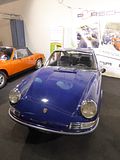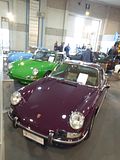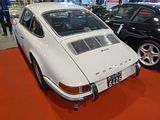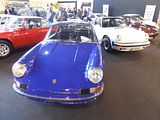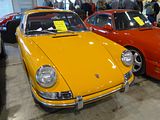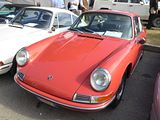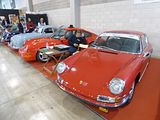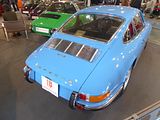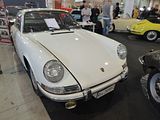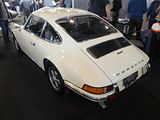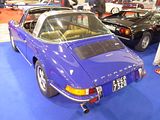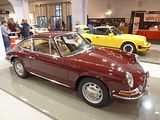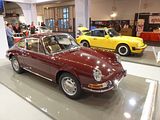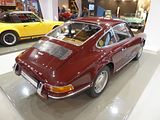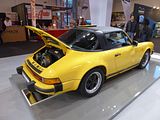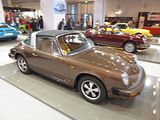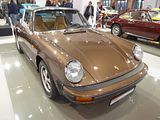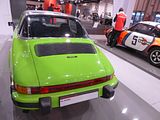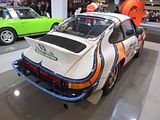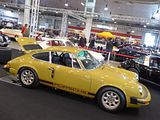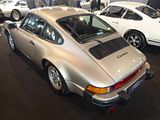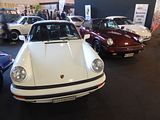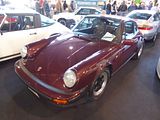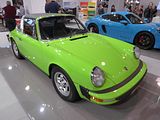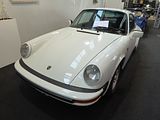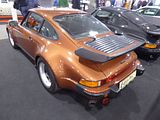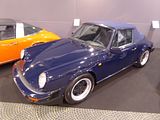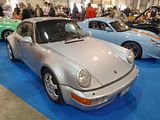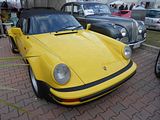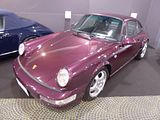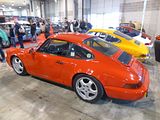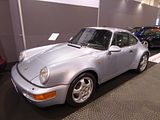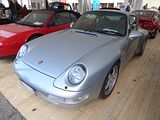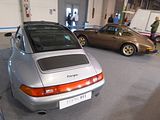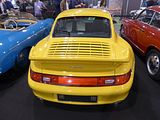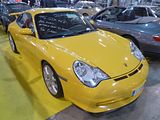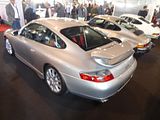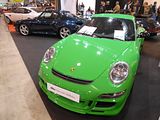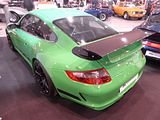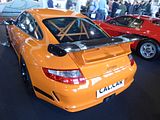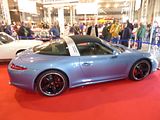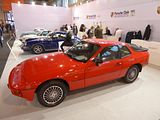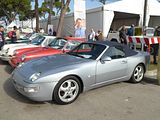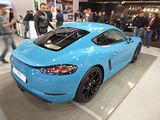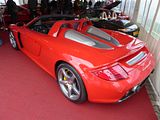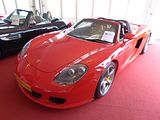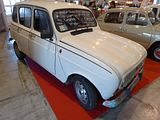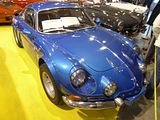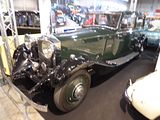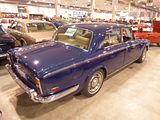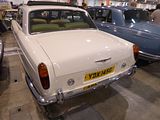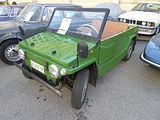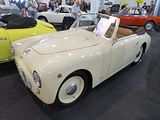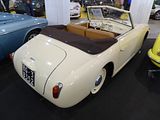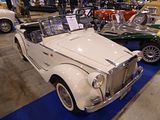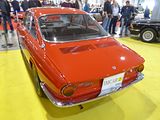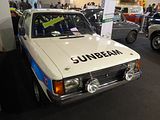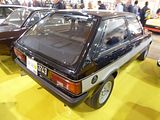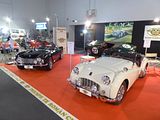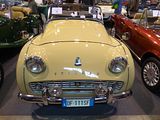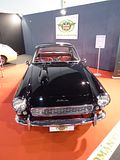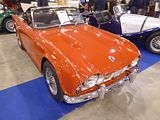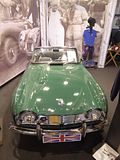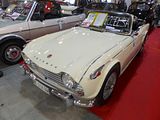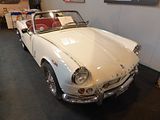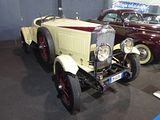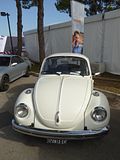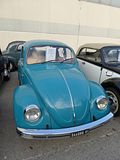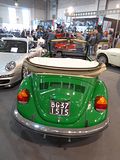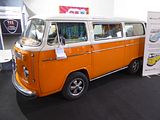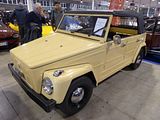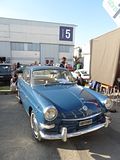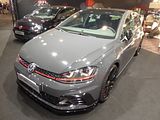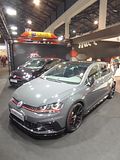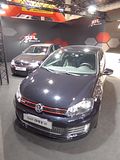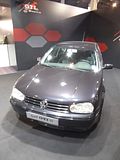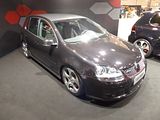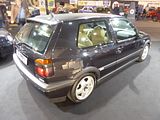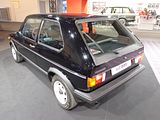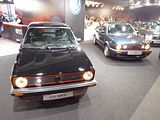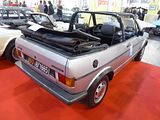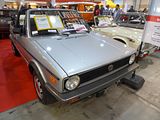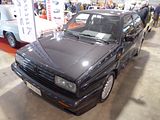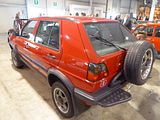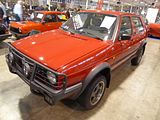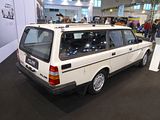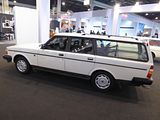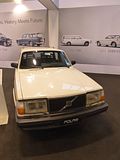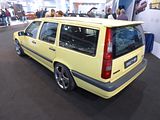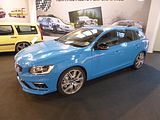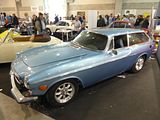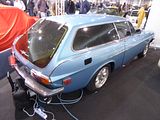There are lots of events in the UK specifically for Italian cars, and plenty more where cars from that country constitute a significant percentage of what you will see, and if you go to more than a couple of these – as I do indeed do – then you are likely to see some rarities as well as the more popular and numerous classics from Alfa Romeo, Fiat, Lancia and the supercar manufacturers. But if you really want to see some of the rare and often unique cars, many of them the products of long extinct coachbuilders, then you need to head to a show in Italy. And the biggest of the lot is the one held in Padova (Padua), called Auto e Moto d’Epoca, taking place around the end of October each year. It was held for the first time in 1983, and the show has grown in popularity ever since. By 2010, around 2,500 cars were on show and 60,000 people visited the event, and by 2015, those numbers had swollen to 4,500 display cars and 90,000 visitors. It takes place at the Fiera in the centre of Padova, over a four day period, and although 90,000 sounds like a lot of people, the site comprises around 15 separate exhibition halls and plenty of outdoor display space, so it does not get impossibly crowded. Having discovered the event in 2011, it’s now a firm fixture on my events plan for the year, and the 2016 show was the fourth time I’ve attended. There was a lot to see, as this report will attest.
LAMBORGHINI at the AIRPORT
Even before arriving at the Show, there is a treat in store, and it comes if you fly – as I do – into Bologna airport, as positioned in what would seem to be permanent display space, are a couple of cars from the Lamborghini factory. Well, Sant’Agata da Bolognese is only 30 minutes or so away, so I guess these can be considered to be “local produce”. The two cars on show this time were the Huracan and its larger and more potent brother, the Aventador S.
APPROACHING THE EVENT
Having parked up in the same car park that I have used every time I’ve attended the event, it is a 10 minute walk to the entry point and there’s usually something interesting whilst en route, in addition to the fact that you pass Padova’s BMW and MINI dealer and a showroom for the Fiat Chrysler Automotive Group which means that there are a number of new Alfa, Fiat and Abarth cars parked outside. However, the first car to catch my attention was this now rare Honda Prelude.
I also spotted this Gallardo Superleggera, parked up outside the Fiera.
ABARTH
One of the main halls contains a large stand for the various brands that constitute FCA, Fiat Chrysler Automotive, and there is always an interesting mix of historic models from the firm’s collections as well as some brand new products, especially where there is a link to the back catalogue, or an obvious future classic being launched. For Abarth that meant a pairing of the first 124 Spider and the latest one, both of them in rally guises.
There were a number of historic Abarth models dispersed around the event. Best known of these were these 1000 and 1000 TCR cars. These were an evolution of the earlier 850 cars, based on the contemporary Fiat 600. Officially known as the Fiat-Abarth 850TC Berlina (Turismo Competizione, or “touring competition”), it was introduced towards the end of 1960, using Fiat 600 bodywork with some modifications, most notably a boxlike structure ahead of the front bumper which held the engine’s oil cooler. The rear wings were usually blistered, to accommodate larger wheels. The engine is a four-cylinder model based on a Fiat unit, with 847 cc capacity and 51 hp. Overall length is 3,090 mm (122 in), overall width is 1,400 mm (55 in), height is 1,380 mm (54 in), wheelbase is 2,000 mm (80 in), and its front and rear track are 1,160 mm (46 in). The fuel tank holds 5.9 imperial gallons, and its empty weight was 793 kg (1,748 lb). The 850TC remained in the price lists until 1966. In 1962 the 850TC Nürburgring was introduced, with 55 PS at 6500 rpm. The name was intended to celebrate the class victory of an Abarth 850TC at the 1961 Nürburgring 500 km race. There followed the 850TC/SS with two more horsepower; this was renamed the 850TC Nürburgring Corsa towards the end of the year. Between 1962 and 1971 the 850cc and 1000cc class cars won hundreds of races all over the World and were commonly called “Giant Killers” due to their superior performance over much larger cars, culminating in a famous dispute with SCCA authorities in the USA when Alfred Cosentino (FAZA) was banned from running his 1970 Fiat Abarth Berlina Corsa 1000 TCR “Radiale” engine because his car was faster (mainly in wet conditions) to many V8 Mustangs, AMC AMX’s and Chev Camaro’s etc. The SCCA authorities dictated FAZA and Cosentino be forced to use an early design engine a non “Radiale” engine from 1962 model in his cars but still achieved 51 Victories from 53 races. The most victories in SCCA racing history, thereby cementing the superiority of the Fiat Abarth Berlina Corsa over larger and more powerful cars.
This is a 1961 850 SS Coda Tronca. An important example of the classic Fiat-Abarth, the original 750 Record Monza was a sporting dual-purpose machine designed to be at home on both road and track. Based on the rugged Fiat 600 platform and evolved from the wildly successful 750 GT, the 750 Record Monza was in celebration of Abarth’s numerous record-setting endurance runs at the famed Italian Autodromo. Like its predecessor, it was carefully developed by the Abarth engineers at Torino and bodied by Zagato, the Milanese coachbuilder famed for its extensive use of aluminium and aerodynamic designs. Introduced in 1959, the new Fiat-Abarth was immediately distinguished by its revised coachwork details and highly tuned twin-cam engine. Fittingly, the new model captured its first major victory at the gruelling Monza 12-hour race. For the 1960 season, the small-displacement classes were revised and Abarth responded with a new line of 700-cubic centimetre, 850-cubic centimetre, and 1,000-cubic centimetre engines to meet the updated requirements. The 850 Record Monza, a more powerful 71 bhp version of the original design, was purpose built to contest the 850-cubic centimetre category of the Italian Gran Turismo championship. Constructed in limited numbers, these rare Abarths remained competitive at local and international events well into the 1960s.
There’s an even more complex history associated with this car, which bore a number of badges during its production life. Among the badges are the Abarth Scorpione 1000, as well as the Lombardi Grand Prix,. This was a small, rear-engined sports car, based on Fiat 850 underpinnings, developed by the Carrozzeria Francis Lombardi with an in-house design by Giuseppe Rinaldi. It was first shown in March 1968, at the Geneva Motor Show. The design had a Kammback rear and a very low nose with flip-up headlights, and a large single windshield wiper. The headlights were electrically powered. The bodywork was all steel, except the rear panel. The design was originally shown as a prototype based on the front-wheel drive Autobianchi A112, and was adapted by Lombardi for the 850 sedan’s floorpan. At the 1969 Turin Show, a targa version was also shown; called the “Monza”, this open model has a rollover bar. At least two were built but it is unknown whether any were sold. The original Lombardi Grand Prix had the regular 843 cc Fiat 850 engine with 37 PS at 5000 rpm, coupled to a four-speed gearbox. Low drag resistance and weight (630 kg or 1,390 lb) meant that this was supposedly enough for a top speed of 99 mph. Later production models had the 850 Special engine, with 47 PS at 6400 rpm – in a period German test the maximum speed of the more powerful variant was 95.6 mph. Luggage space is limited, with very little space next to the spare wheel up front and with a tiny area behind the seats. In case the electric wind-up mechanism for the headlights should fail, there is also a mechanical lever underneath the bonnet. The single round tail lights are Fiat 850 Coupé units. The front suspension consists of a transverse leaf spring on the bottom and A-arms on top, while the rear received coil sprung semi-trailing arms. The Lombardi Grand Prix was built in two series: early models used the regular, metal engine cover from the Fiat 850 while the Series II has a louvred unit in black metal. The door windows are also different, being of a three-piece design (one on top, two lower pieces of which one could be slid open) while later cars have a more conventional layout with a vent window up front and a single piece which, however, could only be rolled halfway down. A Cypriot casino owner and millionaire had also shown interest in the Lombardi Grand Prix around the time of its introduction. Frixos Demetriou intended to market the car in the United Kingdom and began planning for an order of 1000 cars. After his death in a British Army tank accident in Cyprus, this project came to a sudden halt. Only ten cars were imported into the UK, with the remaining parts languishing in storage in Turin. A few unsold cars were re-exported to Cyprus in 1969 to avoid pending customs bills. The story gets more complex than that. The tiny OTAS company (Officina Trasformazioni Automobili Sportive, or “Sports car conversion shop”) was founded in 1969 and was a collaboration between Francis Lombardi and Franco Giannini – the son of Domenico Giannini of Giannini Automobili – allowing for a more powerful, Giannini-engined Grand Prix model to be marketed abroad. The resulting OTAS Grand Prix has a tuned, 982 cc twin-cam “Tigre” engine. In Italy, this model was sold as the “Giannini 1000 Grand Prix” (beginning in 1969). In a very convoluted operation, Francis Lombardi sold engineless cars to Giannini, while Giannini sold their engines to OTAS for sale outside of Italy. Responding to interest in the important North American market, OTAS also sold the Grand Prix in the United States and in Canada as the “OTAS Grand Prix 820cc”, to give the tiny car its full name. Going on sale in 1970 it was fitted with the same down-sleeved 817 cc version of the inline-four engine as used in federalised Fiat 850s – all to sneak under 50 cubic inches, thereby avoiding the need to carry emissions controls equipment. Sixty-five of these cars were brought to North America, or perhaps as many as a hundred. Fiat 850 chassis numbers were retained for the OTAS 820. Importer John Rich of Glendale, California, also offered tune-up kits directly and Siata International in New Jersey imported nine of the bigger Tigre-engined cars before the strictures of the EPA put a halt to such activities. This was the first car to have US sales curtailed by the EPA. The OTAS was sold until 1971, when the company shut its doors following homologation troubles. The car never sold particularly well, being expensive considering its performance and with a tendency to overheat. Along with other tuners (such as Giannini), Carlo Abarth also had a look at the Grand Prix. Abarth’s version, first seen at the 1968 Paris Motor Show, received a tuned version of the larger 903 cc engine from the recently introduced Fiat 850 Sport Coupé/Sport Spider. The resulting variant has a claimed 52 PS, providing performance more suitable to the sporting bodystyle and name. For better cooling than the original Lombardi and OTAS, Abarth mounted the cooler up front, in the air stream. In 1970 Abarth showed the considerably more powerful “Abarth 1300 Scorpione”, which was to be Abarth’s last independently developed car. Equipped with a version of the Fiat 124s 1.2 litre engine, bored out by 2.5 mm for a total of 1280 cc, this model has 75 PS and only moderately more weight, ranging from 680 to 750 kg (1,500 to 1,650 lb) depending on the source. In a 1970 road test by Auto, Motor und Sport, the Scorpione reached 109.1 mph, close to the claimed 112 mph. There is also mention of a 982 cc Abarth 1000 OT-engined version of the Scorpione. The Scorpione had a special Abarth-made bell housing, to allow matching the 124 engine to the four-speed 850 gearbox. After Abarth was taken over by Fiat in 1971, the Scorpione was quickly cancelled.
This is an Abarth 2000 Sport Tipo SE10, dating from 1968, a car built for racing. By the late ’60s, noting a dramatic decline in sales of its vehicles, Carlo Abarth decided to focus on the production of sports cars for sale to private entrants. To encourage them with a purchase, he created this car, the 2000 Sport Tipo SE 010. The engine was a four-cylinder 2 litre with two Weber 58 DC03 carburettors that generated 250 hp and gave a maximum speed of 270 km/h. There was a five-speed manual transmission. The chassis frame was of a tubular type made of steel. The front suspensions consisted of oscillating trapezoids, coil springs, stabilizer bars and telescopic hydraulic shock absorbers, while the rear ones had oscillating arms, coil springs, stabilizer bars and telescopic hydraulic shock absorbers. Driven for the first time in the uphill race at Ampus, in France, the 2000 Sport obtained numerous victories and placements, including claiming the first three positions in the 500 km of the Nürburgring in 1968 with Shetty, Ortner and Merzario.
Bringing things somewhat uptodate was this 500 Assetto Corse. Unveiled at the 2008 Paris Auto Show, the 500 Abarth Assetto Corse was a limited production model of 49 cars, designed by the Fiat Group Automobiles Style Centre and produced by a team of Abarth Engineers and Designers. The engine is rated at 200 PS at 6500 rpm and 300 N⋅m (220 lb⋅ft) at 3000 rpm. It includes white 17-inch special ultralight racing wheels, low ride, sports racing mirrors and a place for a number on the sides, pastel grey body with red Abarth side stripes.
AC
Dating from 1935, this Sport Special is based on the 16/80 model.
ADLER
This unrestored car is a 1937 Super Trumpf Rennlimousine. In the latter half of the 1930s, most racing cars remained open-cockpit in design, sent power to the rear wheels (Harry Miller’s FWD Indy Car excepted), and featured the most powerful engines allowed by competition rules. German automaker Adler believed it had a better idea, and its Trumpf Rennlimousine was a combination of rolling laboratory, race car and show car. Roughly six were built, and three are known to survive today. Designed by Hans-Gustav Röhr, the Trumpf platform dated to 1932 and featured front-wheel drive and a four-wheel independent suspension. Not all Trumpf designs were cutting-edge, however, as the car also employed thermosiphon cooling that negated the need for a water pump, at the expense of some cooling efficiency. Turning a modestly powered sedan into a race car would take a bit of engineering, so Adler turned to the body designs of airship engineer Paul Jaray. Licensing Jaray’s designs, the Rennlimousine featured an enclosed cabin, a tapered rear and a windshield that wrapped around a full 180 degrees, allowing cleaner airflow across the body. Styled without the use of a wind tunnel, the Adler was tested on the road, at speed, with lengths of string attached to its body to monitor the way that wind flowed across its shape. Such a sleek design allowed the use of a smaller and more efficient engine, and chassis 167 671 was campaigned with a 1.9-litre inline-four that produced just 56 horsepower. While acceleration wasn’t spectacular, the car’s wind-cheating shape provided a distinct fuel consumption advantage in endurance races like the 24 Hours of Le Mans. Reportedly entered as car #34 in the 1937 running of Le Mans, chassis 167 671 finished in ninth place overall (but fourth in the 2.0-litre class), with drivers Otto Löhr and Paul von Guilleaume at the wheel. The car raced again at the 24 Hours of Spa in 1938, wearing the number 32, but an accident ended its day, and perhaps its racing career, prematurely. The Rennlimousine was sent to the factory for repairs, and upon completion was shipped to an Adler importer to serve as a demonstration and show car.
ALFA ROMEO
As you might expect from an event in Italy, there were literally dozens of Alfa models here, scattered among all the halls and parked up outside. Some were on Club stands, and the rest were singletons. Collating them all for this report is a pretty good history lesson in the marque with lots of lovely models to delight the enthusiast.
There were several examples of the fabulous 6C Alfa Romeo here, thanks to an impressive display on Alfa Romeo’s stand. In the mid-1920s, Alfa’s RL was considered too large and heavy, so a new development began. The 2-litre formula that had led to Alfa Romeo winning the Automobile World Championship in 1925, changed to 1.5-litre for the 1926 season. The 6C 1500 was introduced in 1925 at the Milan Motor Show and production started in 1927, with the P2 Grand Prix car as starting point. Engine capacity was now 1487 cc, against the P2’s 1987 cc, while supercharging was dropped. The first versions were bodied by James Young and Touring. In 1928, a 6C Sport was released, with a dual overhead camshafts engine. Its sport version won many races, including the 1928 Mille Miglia. Total production was 3000 (200 with DOHC engine). Ten copies of a supercharged (compressore, compressor) Super Sport variant were also made. The more powerful 6C 1750 was introduced in 1929 in Rome. The car had a top speed of 95 mph, a chassis designed to flex and undulate over wavy surfaces, as well as sensitive geared-up steering. It was produced in six series between 1929 and 1933. The base model had a single overhead cam; Super Sport and Gran Sport versions had double overhead cam engines. Again, a supercharger was available. Most of the cars were sold as rolling chassis and bodied by coachbuilders such as Zagato, and Touring. Additionally, there were 3 examples built with James Young bodywork. In 1929, the 6C 1750 won every major racing event it was entered, including the Grands Prix of Belgium, Spain, Tunis and Monza, as well as the Mille Miglia was won with Giuseppe Campari and Giulio Ramponi, the Brooklands Double Twelve and the Ulster TT was won also, in 1930 it won again the Mille Miglia and Spa 24 Hours. Total production was 2635.
Final evolution of the Alfa Romeo 6C was the 2500 which was announced in 1938. The 2500 had an enlarged engine compared to the predecessor models, with this Vittorio Jano designed double overhead cam engine available with either one or three Weber carburettors. The triple carburettor version was used in the top of line SS (Super Sport) version. The 2443 cc engine was mounted in a steel ladder frame chassis, which was offered with three wheelbase lengths: 3,250 mm (128.0 in) on the Turismo, 3,000 mm (118.1 in) on the Sport and 2,700 mm (106.3 in) on the Super Sport. Although it was clear that World War II was coming and car development would be stopped, Alfa did continue to produce a few hundred 6C 2500s were built from 1940 to 1945 before resuming production, Postwar. The first new Alfa in his period was the 1946 6C 2500 Freccia d’Oro (Golden Arrow), of which 680 were built through 1951, with bodies by Alfa. Various coachbuilders made their own versions of the 2500, with most of the bodies made by Touring of Milan, though this one has a Rigoli Robini Cabriolet style which is rather attractive. The car was sold to wealthy customers like King Farouk, Alì Khan, Rita Hayworth, Tyrone Power, and Prince Rainier. One was also featured in The Godfather in 1972. The 6C 2500 was one of the most expensive cars available at the time. The last 6C was produced in 1952, when it was replaced by the 1900. As well as a Touring and a rare Berlina model here, there were a number of the Freccia d’Oro version here.
Designed by Orazio Satta, the 1900 was Alfa Romeo’s first car built entirely on a production line. It was also Alfa’s first production car without a separate chassis and the first Alfa offered with left-hand drive. Launched at the 1950 Paris Motor Show, the 1900 was offered in two-door or four-door models, with a new 1,884 cc 90 bhp 4-cylinder twin cam engine. It was spacious and simple, yet quick and sporty. The slogan Alfa used when selling it was “The family car that wins races”, not-so-subtly alluding to the marque’s success in the Targa Florio, Stella Alpina, and other competitions. In 1951 the short wheelbase 1900C (C for Corto, the Italian for short) version was introduced. It had a wheelbase of 2,500 mm In the same year the 1900TI with a more powerful 100 bhp engine was introduced, it had bigger valves, a higher compression ratio and it was equipped with a double carburetor. Two years later the 1900 Super and 1900 TI Super (also 1900 Super Sprint) with 1975 cc engine were introduced. The TI Super had two double carburettors and 115 bhp. The transmission was a 4-speed manual on basic versions and 5-speed manual in Super Sprint version, the brakes were drums. The 1900 had independent front suspension (double wishbones, coil springs and hydraulic telescopic shock absorbers) and live rear axle. Production at the company’s Milan plant continued until 1959: a total of 21,304 were built, including 17,390 of the saloons.
The 1900C was introduced in 1951 as the coupe version of the four-door Alfa Romeo 1900. The addition of the C in the name wasn’t for coupe as many assume, but for corto – the Italian word for short. Although the 1900 model series was the first with a unibody chassis, and the the first to be fitted with the new 1884cc DOHC inline-4, the then general manager of Alfa Romeo, Iginio Alessio, chose to develop the unibody chassis in such a way that the iconic Italian carrozzerie, or coachbuilders, could build custom bodies for it. He had become concerned with the difficulty posed by creating custom bodies for these newly engineered cars – and as a result of this decision the Alfa Romeo 1900 and 1900C were both bodied by some of the greatest names in Italian coachbuilding – including Zagato, Touring, Pinin Farina, Bertone, Boneschi, Boano, Colli, Stabilimenti Farina, Vignale, and of course, Ghia. Alfa Romeo gave official contracts to Touring to build the sporty 1900 Sprint coupé and to Pinin Farina to build an elegant four seat Cabriolet and Coupé. Carrozzeria Zagato built a small series of coupés with the unofficial designation of 1900 SSZ, designed for racing with an aerodynamic lightweight aluminium body and Zagato’s trademark double bubble roof. One-off specials were numerous, from the famous Bertone BAT series of aerodynamic studies, to an infamous sci-fi like Astral spider designed by Carrozzeria Boneschi for Rafael Trujillo the dictator of the Dominican Republic. There was a Barchetta or “Boat Car” made by Ghia-Aigle in Lugano Switzerland designed by Giovanni Michelotti at the request of a wealthy Italian who had two passions: the ‘Riva’ boats and a woman, his mistress, the car has no doors or windscreen wipers. A number of them were to be seen here including the SS Touring and the very rare Ghia.
Following the 1900 family, Alfa’s next new model range would be cheaper and aimed at capturing some of the market from middle class buyers. Known as Giulietta, the 750 and later 101 Series were a series of family-sized cars made from 1954 to 1965, and Alfa Romeo’s first, successful, foray into the 1.3-litre class. The first to be introduced was the Giulietta Sprint 2+2 coupé which was premiered at the 1954 Turin Motor Show. Designed by Franco Scaglione at Bertone, it was produced at the coachbuilder’s Grugliasco plant, near Turin. A year later, at the Turin Motor Show in April 1955, the Sprint was joined by the 4-door saloon Berlina. In mid 1955, the open two-seat Giulietta Spider, featuring convertible bodywork by Pininfarina arrived. The Giulietta used unibody construction and a front-engine, rear-wheel-drive layout. Front suspension was by control arms, with coaxial coil springs and hydraulic dampers. At the rear there was a solid axle on coil springs and hydraulic dampers. The axle was located by a longitudinal link on each side, and by a wishbone-shaped arm linking the top of the aluminium differential housing to the chassis. All Giuliettas (save for the last SZ examples) had hydraulic drum brakes on all four corners. The Giulietta used an Alfa Romeo Twin Cam straight-four of 1290 cc, with an aluminium alloy engine block and cast iron inserted sleeves. Bore and stroke measured 74.0 mm and 75.0 mm. The aluminium alloy cylinder head was of a crossflow design and featured hemispherical combustion chambers. The double overhead camshafts were driven by two timing chains, and acted on two valves per cylinder, angled 80°. In 1957 a more powerful Berlina version, called Giulietta T.I. (Turismo Internazionale) was presented with minor cosmetic changes to the bonnet, the dial lights and rear lamps. Carrozzeria Colli also made the Giulietta station wagon variant called Giulietta Promiscua. Ninety-one examples of this version were built. Carrozzeria Boneschi also made a few station wagon examples called Weekendina. A new version of the Giulietta Berlina debuted at the Frankfurt Motor Show in 1959. Mechanical changes were limited to shifting the fuel pump from the cylinder head to a lower position below the distributor, and moving the previously exposed fuel filler cap from the tail to the right rear wing, under a flap. The bodywork showed a revised front end, with more rounded wings, recessed head lights, and new grilles with chrome frames and two horizontal bars. The rear also showed changes, with new larger tail lights on vestigial fins, which replaced the earlier rounded rear wings. The interior was much more organised and upholstered in new cloth material; the redesigned dashboard included a strip speedometer flanked by two round bezels, that on the T.I. housed a tachometer and oil and water temperature gauges. The T.I. also received a front side repeater mounted in a small spear, unlike the Normale which kept the earlier small round lamp with no decorations. During 1959 the type designation for all models was changed from 750 and 753 to 101. In February 1961 the 100,001st Giulietta rolled out of the Portello factory, with a celebration sponsored by Italian actress Giulietta Masina. In Autumn 1961 the Giulietta was updated a second time. Both Normale and T.I. had revised engines and new exhaust systems; output rose to 61 bhp and 73 bhp. With this new engine the car could reach a speed of almost 100mph. At the front of the car square mesh side grilles were now pieced together with the centre shield, and at the rear there were larger tail lights. Inside the T.I. had individual instead of bench seats, with storage nets on the seatbacks. June 1962 saw the introduction of the Alfa Romeo Giulia, which would eventually replace the Giulietta. As until 1964 the Giulia only had a larger 1.6-litre engine, production of the standard Berlina ended with 1963, whilst the T.I. continued for a full year more. A last T.I. was completed in 1965. The Giulietta sport models had a different fate: Sprint, Sprint Speciale and Spider were fitted with the new 1.6-litre engine, received some updates and continued to be sold under the Giulia name until they were replaced by all-new Giulia-based models during 1965. These days., the Berlina is the model you see the least often. A few of the model are used in historic racing where the car takes on the might of those with far larger engines. A total of 177,690 Giuliettas were made, the great majority in Berlina saloon, Sprint coupé or Spider roadster body styles, all three of which were much in evidence here.
There were also examples of one of the rarer Giulietta models here. This was the Giulietta Sprint Speciale, the earlier version of a car which was produced between 1957 and 1965, latterly with Giulia badging. Just 1,366 examples were made. The first cars were fitted with the 1,290cc Giulietta engine and then in 1963 this was replaced by the more powerful 1,570cc Giulia unit. The SS, or Sprint Speciale series was never intended to be a volume car and it was considerably more expensive than the other models in the Giulietta and Giulia ranges. It certainly looked special, with streamlined bodywork which bore a marked resemblance to some of the marque’s earlier competition designs, particularly the famous Disco Volante sports-racer, not to mention the BAT 9 show car. With an all-up weight of under 950kgs, a five-speed gearbox and an output of 112bhp (in Giulia form) these were excellent road cars and were equally used in competition. They don’t come up for sale very often, and needless to say, the price tag is not small when they do.
The 2600, or 106 Series, were an evolution of the model first seen in 1958 as a replacement for the 1900, and called the 2000 and known internally as the 102 Series. This was the time when Alfa was still in transition from being a maker of exclusive coachbuilt and racing cars to one that offered volume production models. The 102 Series were never likely to be big sellers, in a world that was still recovering economically from the ravages of the Second World War, but the range was an important flagship, nonetheless. The 2000 models ran for 4 years, from 1958 to 1962, at which point they were updated, taking on the name of 106 Series, with minor styling changes being accompanied by a larger 2600cc engine under the bonnet. As with the 2000 models, the new 2600 cars were sold in Berlina (Saloon), Sprint (Coupe) and Spider (Convertible) versions, along with a dramatically styled SZ Coupe from Italian styling house Zagato and a rebodied Berlina from OSI, all of them with an inline twin overhead cam six cylinder engine of 2.6 litres, the last Alfas to offer this configuration. Just 6999 of the Sprint models were made and 2255 Spiders, very few of which were sold new in the UK where they were exceedingly expensive thanks to the dreaded Import Duty which made them much more costly than an E Type. Many of the parts were unique to these cars, so owning one now is far harder than the more plentiful 4 cylinder Alfas of the era. Whilst the rather square styling of the Berlina, which won it relatively few friends when new and not a lot more in recent times means that there are few of these versions to be seen, the Sprint and Spider models do appear from time to time, and market interest in the cars is now starting to accelerate, with values rise accordingly. Seen here was a Spider version of the 2600, which I think looks absolutely fantastic. The cars had a strong domestic rival in the form of the Lancia Flaminia and a recent article in “Classic and Sports Car” magazine compared the two. It concluded (reluctantly, given the declared bias of the author) that the contemporary Lancia Flaminia was actually the better car, but I could quite understand why anyone would fall for the Alfa cars.
It was with the 105 Series of cars that Alfa really found the sort of sales volume that they would need to be able to survive throughout the 1960s. The first car in this range, known as the Giulia, because it was larger than the Giulietta, was the Berlina model launched in 1962. The Giulia was produced from 1962 to 1978 in a bewildering array of similar models, which even the marque enthusiast can find hard to untangle. The styling was quite straight forward, but great attention was paid to detail. The engine bay, cabin and boot were all square shaped. But the grille, the rooflines and details on the bonnet and boot made for an integrated design from bumper to bumper. Thanks to Alfa Romeo using a wind tunnel during its development, the Giulia was very aerodynamic with a drag coefficient of Cd=0.34, which was particularly low for a saloon of the era and not a bad figure even for cars of today. Couple that with the fact that Alfa Romeo was one of the first manufacturers to put a powerful engine in a light-weight car (it weighed about 1,000 kilograms) and thanks to an array of light alloy twin overhead camshaft four-cylinder engine, similar to that of the earlier Giulietta models range, the car had a lively performance which bettered that of many sports cars of the day. The Tipo 105.14 was the first model introduced in 1962. with a 1,570 cc Twin Cam engine with single down-draft carburettor generating 91 hp at 6500 rpm. The “TI” nomenclature referred to a class of Italian saloon car racing known as “Turismo Internazionale”, and had previously been applied to higher-performance versions of the 1900 and Giulietta saloons in the 1950s. However, for the Giulia saloon, the Ti was at first the only version available, and later, with the introduction of the TI Super and Super, the TI became the base version for the 1,600 cc engine class. The steering column gearchange (the only one in the Giulia range) was replaced with a floor change for 1964 (Tipo 105.08). Right hand drive cars, available from 1964, only ever had a floor change (Tipo 105.09). Brakes were by drums all around at first. Discs were introduced later, first at the front, and later all around. A brake servo was not fitted at first, but was introduced in later cars. The steering wheel featured the only horn ring ever in the Giulia range. The dashboard with a strip speedo is a notable feature, as is the steering wheel with a horn ring. The Giulia TI was phased out in 1968 and re-introduced as the austerity model 1600 S. Tipo 105.16 was a special racing model introduced in 1963. Quadrifoglio Verde stickers on the front wings were a distinguishing feature. Only 501 were made for homologation and today it is very rare and desirable. The 1,570 cc engine was fitted with two double-choke horizontal Weber 45DCOE carburettors for 110 hp at 6500 rpm. The body was lightened and a floor gearchange was fitted as standard, as were alloy wheels of very similar appearance to the standard steel ones of the TI. The TI’s instrument cluster with its strip speedometer was replaced with a three-instrument binnacle comprising speedometer, tachometer and a multi-gauge instrument (fuel, water temperature, oil temperature and pressure) – these instruments were similar to those fitted to the contemporary Giulia Sprint and Sprint Speciale coupes and Spider convertibles. The steering wheel was a three-spoke item with centre hornpush, also similar to that of the more sporting models. Braking was by discs all around, although the first cars used drums and early disc models lacked a servo which was introduced later. The police cars seen in The Italian Job were of this type. Tipo 105.06 was an austerity model made from 1964 to 1970 with a 1,290 cc single-carburettor engine for 77 hp at 6000 rpm. Four-speed gearbox with floor change fitted as standard (the 1300 was the only Giulia model not fitted with a five-speed gearbox). Though the engine was given a 105 series type number, it was basically the engine from the 101 series Giulietta Ti. This model appears not to have been exported to many markets outside Italy, if at all. Braking was by discs all around, without a servo at first, later with a servo. Tipo 105.26 was introduced in 1965. It transferred the technology from the racing TI Super to a road car, to make the most successful Giulia saloon. 1,570 cc engine with two double-choke Weber 40DCOE carburettors for a milder, but torquier tune than the TI Super – 97 hp at 5500 rpm. There was a new dashboard with two large round instruments (speedo and tacho) and clock, a sportier steering wheel with three aluminium spokes and centre horn push, similar to that of the Ti Super, later changed for one with the horn pushes in the spokes. All-around disc brakes with servo were fitted as standard from the outset. The serpent crest of the Sforza family appears in a badge on the C-pillar and is a distinguishing feature of the Super. For 1968, there was a suspension update, including revised geometry and a rear anti-roll bar. The wheels were changed in size from 5J x 15 to 5J x 14, and tyres from 155/15 to 165/14. For 1970, updates included dual-circuit brakes, centre-mounted handbrake lever to replace under-dash “umbrella handle”, larger external doorhandles, and top-hinged pedals (the latter in left hand drive models only; right hand drive continued with bottom-hinged pedals to the end of production). In 1972, Tipo 105.26 was rationalised into the Giulia 1.3 – Giulia 1.6 range. Tipo 105.39 built from 1965 to 1972. Right hand drive model replaced in 1970 by the 1300 Super. 1,290 cc engine with single down-draft carburettor for 81 hp at 6000 rpm. Unlike the re-deployed 101-series Giulietta engine of the austerity-model 1300, the 1300 ti motor was a 105 series engine, basically that of the sportier GT1300 Junior coupe with different camshaft timing (but the same camshafts) and induction system. Five-speed gearbox. Three-spoke bakelite steering wheel with plastic horn push covering the centre and spokes. Dashboard initially with strip speedo like that of the TI. For 1968, updates included a dashboard based on that of the Super, but with a simpler instrument binnacle, still featuring two large round instruments (speedo and tacho) and a separate fuel gauge, and the same suspension, wheel and tire updates applied to the Giulia Super in the same year. For 1970, updates included dual-circuit brakes, centre handbrake, larger external doorhandles and top-hinged pedals (on left hand drive cars only), again as applied to the Super for that year. Tipo 105.85 was basically a Giulia TI re-introduced in 1968 as a lower-level model to come between the 1300 and 1300 ti on one hand, and the Super on the other. It had a re-interpretation of the 1,570 cc single-carburettor engine for 94 hp at 5500 rpm and similar trim to the 1300 ti. Replaced in 1970 by the 1300 Super which offered similar performance in a lower tax bracket. The last cars from 1970 featured the top-hinged pedals, centre handbrake and dual-circuit brakes as for the Super and 1300 ti. Tipo 115.09 was introduced in 1970. It was basically a 1300 ti fitted with the engine from the GT 1300 Junior coupe that featured two double-choke horizontal carburettors; the engine actually had the GT 1300 Junior type number. This model was rationalised into the Giulia Super 1.3 – Giulia Super 1.6 range in 1972. In 1972 a rationalisation of the Giulia range saw the Super 1300 (Tipo 115.09) and the Super (Tipo 105.26) re-released as the Super 1.3 and Super 1.6. The two models featured the same equipment, interior and exterior trim, differing only in engine size (1,290 cc and 1,570 cc) and final drive ratio. The 1300 ti was dropped. A small Alfa Romeo badge on the C-pillar is a distinguishing feature, as are hubcaps with exposed wheel nuts. In December 1972 Alfa-Romeo South Africa released the 1600 Rallye. This locally developed more powerful 1600 cc version of the 1300 Super, using the 1300’s single-headlight body shell. The car was largely ready for competition and was only planned to be built in limited numbers, and was fitted with racing-style rear-view mirrors, rally lamps, fully adjustable seats, and a limited-slip differential. Claimed power was 125 hp. The Giulia Super range was re-released in 1974 as the Nuova Super range, including the Giulia Nuova Super 1300 and 1600 This and featured a new black plastic front grille and a flat boot lid without the characteristic centre spine. Otherwise the cars differed little from their Giulia Super predecessors and bore the same Tipo numbers with an S suffix. A Nuova Super fitted with a Perkins 1,760 cc diesel with 54 hp at 4000 rpm, the firm’s first attempt at diesel power. The same Perkins diesel was used also in Alfa Romeo F12 van. The diesel version was slow, 138 km/h (86 mph), and the engine somehow unsuitable for a sport sedan so it was not big seller, only around 6500 examples were made in 1976 and the car was not sold in the UK. Production of the Giulia ceased in 1977.
By 1963, Alfa were ready to add a Coupe version to their new 105 Series Giulia range. It evolved over a 14 year production life, with plenty of different models, though the basic design changed little. The first car was called the Alfa Romeo Giulia Sprint GT, and was revealed at a press event held at the then newly opened Arese plant on 9 September 1963, and displayed later the same month at the Frankfurt Motor Show. In its original form the Bertone body is known as scalino (step) or “step front”, because of the leading edge of the engine compartment lid which sat 1/4 an inch above the nose of the car. The Giulia Sprint GT can be distinguished from the later models by a number of features including: Exterior badging: Alfa Romeo logo on the front grille, a chrome script reading “Giulia Sprint GT” on the boot lid, and rectangular “Disegno di Bertone” badges aft of the front wheel arches; flat, chrome grille in plain, wide rectangular mesh without additional chrome bars; single-piece chrome bumpers; no overriders. Inside the cabin the padded vinyl dashboard was characterised by a concave horizontal fascia, finished in grey anti-glare crackle-effect paint. Four round instruments were inset in the fascia in front of the driver. The steering wheel was non-dished, with three aluminium spokes, a thin bakelite rim and a centre horn button. Vinyl-covered seats with cloth centres and a fully carpeted floor were standard, while leather upholstery was an extra-cost option. After initially marketing it as a four-seater, Alfa Romeo soon changed its definition of the car to a more realistic 2+2. The Giulia Sprint GT was fitted with the 1,570 cc version of Alfa Romeo’s all-aluminium twin cam inline four (78 mm bore × 82 mm stroke), which had first debuted on the 1962 Giulia Berlina. Breathing through two twin-choke Weber 40 DCOE 4 carburettors, on the Sprint GT this engine produced 105 hp at 6,000 rpm. Like all subsequent models, the Sprint GT was equipped with an all-synchromesh 5-speed manual transmission. The braking system comprised four Dunlop disc brakes and a vacuum servo. The rear brakes featured an unusual arrangement with the slave cylinders mounted on the axle tubes, operating the calipers by a system of levers and cranks. According to Alfa Romeo the car could reach a top speed of “over 180 km/h (112 mph)”. In total 21,902 Giulia Sprint GT were produced from 1963 to 1965, when the model was superseded by the Giulia Sprint GT Veloce. Of these 2,274 were right hand drive: 1,354 cars fully finished in Arese, and 920 shipped in complete knock-down kit form for foreign assembly. For 1966, the Giulia Sprint GT was replaced by the Alfa Romeo Giulia Sprint GT Veloce, which was very similar but featuring a number of improvements: a revised engine—slightly more powerful and with more torque—better interior fittings and changes to the exterior trim. Alongside the brand new 1750 Spider Veloce which shared its updated engine the Sprint GT Veloce was introduced at the 36th Geneva Motor Show in March 1966, and then tested by the international specialist press in Gardone on the Garda Lake. Production had began in 1965 and ended in 1968. The Giulia Sprint GT Veloce can be most easily distinguished from other models by the following features: badging as per Giulia Sprint GT, with the addition of round enamel badges on the C-pillar—a green Quadrifoglio (four-leaf clover) on an ivory background—and a chrome “Veloce” script on the tail panel; black mesh grille with three horizontal chrome bars; the grille heart has 7 bars instead of 6; stainless steel bumpers, as opposed to the chromed mild steel bumpers on the Giulia Sprint GT. The bumpers are the same shape, but are made in two pieces (front) and three pieces (rear) with small covers hiding the joining rivets. Inside the main changes from the Giulia Sprint GT were imitation wood dashboard fascia instead of the previous anti-glare grey finish, front seats revised to a mild “bucket” design, and a dished three aluminium spoke steering wheel, with a black rim and horn buttons through the spokes. The Veloce’s type 00536 engine, identical to the Spider 1600 Duetto’s, featured modifications compared to the Giulia Sprint GT’s type 00502—such as larger diameter exhaust valves. As a result it produced 108 hp at 6,000 rpm, an increase of 3 hp over the previous model, and significantly more torque. The top speed now exceeded 185 km/h (115 mph). Early Giulia Sprint GT Veloces featured the same Dunlop disc brake system as the Giulia Sprint GT, while later cars substituted ATE disc brakes as pioneered on the GT 1300 Junior in 1966. The ATE brakes featured an handbrake system entirely separate from the pedal brakes, using drum brakes incorporated in the rear disc castings. Though the Sprint GT Veloce’s replacement—the 1750 GT Veloce—was introduced in 1967, production continued throughout the year and thirty final cars were completed in 1968. By then total Giulia Sprint GT Veloce production amounted to 14,240 examples. 1,407 of these were right hand drive cars, and 332 right hand drive complete knock-down kits. The Alfa Romeo 1750 GT Veloce (also known as 1750 GTV) appeared in 1967 along with the 1750 Berlina sedan and 1750 Spider. The same type of engine was used to power all three versions; this rationalisation was a first for Alfa Romeo. The 1750 GTV replaced the Giulia Sprint GT Veloce and introduced many updates and modifications. Most significantly, the engine capacity was increased to 1779 cc displacement. Peak power from the engine was increased to 120 hp at 5500 rpm. The stroke was lengthened from 82 to 88.5 mm over the 1600 engine, and a reduced rev limit from 7000 rpm to 6000 rpm. Maximum torque was increased to 186 N·m (137 lb·ft) at 3000 rpm. A higher ratio final drive was fitted (10/41 instead of 9/41) but the same gearbox ratios were retained. The result was that, on paper, the car had only slightly improved performance compared to the Giulia Sprint GT Veloce, but on the road it was much more flexible to drive and it was easier to maintain higher average speeds for fast touring. For the United States market, the 1779 cc engine was fitted with a fuel injection system made by Alfa Romeo subsidiary SPICA, to meet emission control laws that were coming into effect at the time. Fuel injection was also featured on Canadian market cars after 1971. Carburettors were retained for other markets. The chassis was also significantly modified. Tyre size went to 165/14 from 155/15 and wheel size to 5 1/2J x 14 instead of 5J x 15, giving a wider section and slightly smaller rolling diameter. The suspension geometry was also revised, and an anti-roll bar was fitted to the rear suspension. ATE disc brakes were fitted from the outset, but with bigger front discs and calipers than the ones fitted to GT 1300 Juniors and late Giulia Sprint GT Veloces. The changes resulted in significant improvements to the handling and braking, which once again made it easier for the driver to maintain high average speeds for fast touring. The 1750 GTV also departed significantly from the earlier cars externally. New nose styling eliminated the “stepped” bonnet of the Giulia Sprint GT, GTC, GTA and early GT 1300 Juniors and incorporated four headlamps. For the 1971 model year, United States market 1750 GTV’s also featured larger rear light clusters (there were no 1970 model year Alfas on the US market). Besides the chrome “1750” badge on the bootlid, there was also a round Alfa Romeo badge. Similar Quadrofoglio badges to those on the Giulia Sprint GT Veloce were fitted on C pillars, but the Quadrofoglio was coloured gold instead of green. The car also adopted the higher rear wheelarches first seen on the GT 1300 Junior. The interior was also much modified over that of earlier cars. There was a new dashboard with large speedometer and tachometer instruments in twin binnacles closer to the driver’s line of sight. The instruments were mounted at a more conventional angle, avoiding the reflections caused by the upward angled flat dash of earlier cars. Conversely, auxiliary instruments were moved to angled bezels in the centre console, further from the driver’s line of sight than before. The new seats introduced adjustable headrests which merged with the top of the seat when fully down. The window winder levers, the door release levers and the quarterlight vent knobs were also restyled. The remote release for the boot lid, located on the inside of the door opening on the B-post just under the door lock striker, was moved from the right hand side of the car to the left hand side. The location of this item was always independent of whether the car was left hand drive or right hand drive. Early (Series 1) 1750 GTV’s featured the same bumpers as the Giulia Sprint GT Veloce, with the front bumper modified to mount the indicator / sidelight units on the top of its corners, or under the bumper on US market cars. The Series 2 1750 GTV of 1970 introduced other mechanical changes, including a dual circuit braking system (split front and rear, with separate servos). The brake and clutch pedals on left hand drive cars were also of an improved pendant design, instead of the earlier floor-hinged type. On right hand drive cars the floor-hinged pedals were retained, as there was no space for the pedal box behind the carburettors. Externally, the series 2 1750 GTV is identified by new, slimmer bumpers with front and rear overriders. The combined front indicator and sidelight units were now mounted to the front panel instead of the front bumper, except again on the 1971-72 US/Canadian market cars. The interior was slightly modified, with the seats retaining the same basic outline but following a simpler design. 44,269 1750 GTVs were made before their replacement came along. That car was the 2000GTV. Introduced in 1971, together with the 2000 Berlina sedan and 2000 Spider, the 2 litre cars were replacements for the 1750 range. The engine displacement was increased to 1962 cc. Oil and radiator capacities remained unchanged. The North American market cars had fuel injection, but everyone else retained carburettors. Officially, both versions generated the same power, 130 hp at 5500 rpm. The interior trim was changed, with the most notable differences being the introduction of a separate instrument cluster, instead of the gauges installed in the dash panel in earlier cars. Externally the 2000 GTV is most easily distinguished by its grille with horizontal chrome bars, featuring protruding blocks forming the familiar Alfa heart in outline, smaller hubcaps with exposed wheel nuts, optional aluminium alloy wheels of the same size as the standard 5. 1/2J × 14 steel items, styled to the “turbina” design first seen on the alloy wheels of the Alfa Romeo Montreal, and the larger rear light clusters first fitted to United States market 1750 GTV’s were standard for all markets. From 1974 on, the 105 Series coupé models were rationalised and these external features became common to post-1974 GT 1300 Junior and GT 1600 Junior models, with only few distinguishing features marking the difference between models. 37,459 2000 GTVs were made before production ended and these days they are very sought after with prices having sky-rocketed in recent years. There were several of these cars here, ranging from the “Step front” Giulia GT to the 1750 GTV and GT Junior on show.
Alfa replaced the Giulia-based Spider model with an all-new design which finally made its debut in 1966 together with the Giulia Sprint GT Veloce at an event organised in Gardone Riviera. With its boat tailed styling, it quickly found favour, even before taking a starring role in the film “The Graduate”. The original 1600cc engine was replaced by a more powerful 1750cc unit at the same time as the change was made to the rest of the range, and the car continued like this until 1970, when the first significant change to the exterior styling was introduced on the 1750 Spider Veloce, with the original’s distinctive elongated round tail changed to a more conventional cut-off tail, called the “Kamm tail”, as well as improving the luggage space. Numerous other small changes took place both inside and out, such as a slightly different grille, new doorhandles, a more raked windscreen, top-hinged pedals and improved interior trim. 1971 saw the Spider Veloce get a new, larger powerplant—a 1962 cc, 132 hp unit—and consequently the name was changed from 1750 Spider Veloce to 2000 Spider Veloce. The 1600 Spider restarted production a year later as the Spider 1600 Junior, and was visually identical to the 1300. 1974 saw the introduction of the rare, factory request, Spider-Targa. Based upon the Spider, it featured a Porsche style solid rear window and lift out roof panels, all made out of black GRP type material. Less than 2,000 models of such type were ever made and was the only part solid roof Spider until the introduction of the factory crafted hard top. The 1300 and 2000 cars were modified in 1974 and 1975 respectively to include two small seats behind the front seats, becoming a “two plus two” four seater. The 1300 model was discontinued in 1977. Also, between 1974 and 1976, the early-style stainless-steel bumpers were discontinued and replaced with black, rubber-clad units to meet increasingly stringent North American crash requirements. 4,557 examples of the 1300 Junior were made and 4,848 of the 1600 Junior as well as 16,320 2000 Spider Veloces and 22,059 of 2000 Spider Veloce US version. There were also 4,027 1750 Spider Veloces produced. Several examples of the Series 1 and Series 2 and 3 cars were to be seen here.
Although demand for the car in Europe dropped in the 1980s, it remained popular in the US, which meant that Alfa not only kept the car in production, but also updated a couple more times. The S4 marked the final major change to the long running Spider when it came out in 1990. Mechanically, the biggest different was the use of Bosch Motronic electronic fuel injection with an electric fan. Externally, the Spider lost its front under-bumper spoiler and the rather ungainly rear boot spoiler of the S3, and picked up 164-style rear lights stretching across the width of the car as well as plastic bumpers the same colour as the car. This also marked the first generation of the car with automatic transmission, as well as on-board diagnostics capabilities. The car had remained in production largely thanks to continued demand in North America, though this market had to wait until 1991 for the changes to appear on their cars. European markets were offered a car with a 1600cc engine and carburettors as well as the 2 litre injected unit. As with the earlier S3, the car was not sold new in the UK by Alfa Romeo, but a number of them were imported at the time, and more have found their way to the UK since. Some, such as Simon’s car have been converted to right hand drive, which makes the car more usable in the UK. Production finally ended in 1993, with an all new model, the 916 Series Spider appearing a year later.
Looking very different from the rest of the range was a rather special Coupe, designed by Zagato. First seen in public at the Turin Motor Show of 1969, the GT 1300 Junior Zagato was a limited production two seater coupe with aerodynamic bodywork penned by Ercole Spada while he was at renowned Milanese styling house Zagato Based on the floorpan, driveline and suspension of the 1300 Spider, the Junior Zagato had a floorpan shortened behind the rear wheels to fit the bodyshell. the model evoked the earlier, race-oriented Giulietta Sprint Zagatos which featured aluminium bodywork and had a very active competition history. However, the Junior Zagato featured a steel bodyshell with an aluminium bonnet and, on early cars, aluminium doorskins. The Junior Zagato was not specifically intended for racing and did not see much use in competition. In total 1,108 units were constructed, with the last being built in 1972 although the records suggest that a further 2 cars were built in 1974. In 1972 the 1600 Zagato came out of which 402 units were produced. In this case the floorpan was unaltered from the 1600 Spider, so that the normal fueltank could be left in place. As a consequence, the 1600 Zagato is approximately 100 mm (3.9 in) longer than the 1300 model. This can be seen at the back were the sloping roofline runs further back and the backpanel is different and lower. The lower part of the rear bumper features a bulge to make room for the spare wheel. The 1600 Zagato has numerous other differences when compared to the 1300 Junior Zagato.so if you ever see two side by side, and were a real expert, you could probably tell them apart easily. The last 1600 Zagato was produced in 1973 and the cars were sold until 1975. This is definitely a “marmite” car, with some people loving the rather bold styling and others finding to just odd for their tastes. I am in the former category.
The 1750 and 2000 Berlina models are largely ignored these days in favour of the GTV models, and whereas you would also say the Coupe cars are genuinely pretty whereas the Berlina is, in its own rather boxy way, more of an elegant car, it still seems a shame to me that this car is so little known outside Alfa enthusiast circles. With the commercially unsuccessful 2600 Berlina out of production, Alfa’s only Saloon car of the mid 1960s was the Giulia, and it was clear that they needed something larger to compete against the Ford Corsair, BMW 2000 and Lancia Flavia, the result being the 1750 Berlina which as introduced in Italy in January 1968, along with the 1750 engined versions of the established GT Veloce Coupé and Spider Veloce. Based on the Giulia saloon, which continued in production, and indeed would outlast its larger sibling, the 1750 had a longer wheelbase and revised external panels, but it shared many of the same internal panels and the windscreen. The revisions were carried out by Bertone, and while it resembled the Giulia some of that vehicle’s distinctive creases were smoothed out, and there were significant changes to the trim details. The car’s taillights were later used on the De Tomaso Longchamp. The new car had a 1,779 cc twin-carb engine which produced 116 hp with the help of twin carburettors on European cars and SPICA fuel injection in the US. There was a hydraulic clutch. In 1971, the 1750 Berlina was fitted with an experimental three-speed ZF automatic gearbox. The model designation was 1750A Berlina. The automatic gearbox wasn’t well-suited to the four-cylinder motor due to baulky shifting and ill-chosen gear ratio. Because of this, its fuel consumption was frighteningly high and acceleration was a bit too slow. According to official Alfa Romeo archives, just 252 of these were produced with very few surviving to this day. During 1971 the 1750 series was superceded across the Alfa Romeo range by the 2000 series; creating, in this case, the 2000 Berlina. Key difference was a larger engine, bored and stroked out to 1,962 cc. With two carburettors, this 2 litre Alfa Romeo Twin Cam engine produced 130 hp, giving a top speed of 200 km/h (124 mph) and 0-100 km/h (62 mph) acceleration took 9 seconds. The gearbox was a 5-speed manual though the 3-speed automatic was also offered. A different grille distinguishes the 2000 from 1750, and the lights were also changed. The 1750 had 7 inch diameter outboard headlights, whereas on the 2000 all four units were of 5 3/4 inch diameter. The tail light clusters were also of a simpler design on the 1750. In USA this engine was equipped with mechanical fuel injection.. A direct replacement for the car in the 1.8-litre saloon class came that same year, in the form of the all-new Alfa Romeo Alfetta, though the two models ran in parallel for the next five years and it was only in 1977 with the launch of the Alfetta 2000, that the 2000 Berlina was finally discontinued. version, replaced the 2000 Berlina. Total sales of the 1750/2000 amounted to 191,000 units over a 10 year production life, 89,840 of these being 2000 Berlinas, of which just 2.200 units were fitted with the automatic gearbox. You don’t see these cars that often.
Many people will be unaware that Alfa Romeo have produced Vans in their past. The first the Autotutto was launched back in 1954, and it was updated three times in the following 11 years before being replaced with by the Giulia engined Alfa Romeo F12 and A12 vans in 1967. The front of the vehicle was updated with wider chrome and mesh grille, and the 1,290 cc Alfa Romeo Twin Cam engine was updated now having 52 hp. The front-engined van had four-speed gearbox and front-wheel drive. In 1973 an inline-four 1,760 cc Perkins diesel was also offered, with 50 hp. This same engine was also available in the Giulia Berlina from 1976. The van had top speed of around 115 km/h (71 mph). The front brakes were discs and rear ones drums. Abandoning the use of a model name, “F” denoted a furgone, or van, “A” depicted an autocarro or light truck, while “12” indicated the carrying capacity of 12 quintali (1 quintale = 100 kg (220 lb)). Motor Ibérica took over of FADISA in 1967, this company made Ebro trucks and these FADISA trucks were merged to this same division. As a result, the Alfa Romeo F12 was named as Ebro F-100 in Spain and after the facelift it was sold as the F-108. In 1987 Nissan Motors took control of Motor Ibérica and Ebro trucks were renamed “Nissan Trade”. They continued to be made until the beginning of the 2000s at the Ávila plant in Spain. Between 1967 and 1971 a “light” A11 or F11 version was also available. This has a lighter payload and a lower horsepower rating. All Alfa Romeo vans were facelifted in 1977 with a new black plastic radiator grille, and chrome badging was replaced with black adhesive stickers. Production stopped in 1983. The total production of all A11, A12, F11, and F12 was around 17,300 units.
During the 1950s, Alfa underwent a fairly fundamental transformation from producing cars designed for racing or very high-end sports touring road machines, in small quantities, to being a manufacturer of more affordable cars, albeit with a sporting bias to their dynamics. But the desire to produce something exclusive and expensive was not completely lost, and indeed it was re-manifest in the next Alfa to be seen here, the very lovely Montreal. First seen as a concept car in 1967 at Expo 67, as depicted above in this report, the car was initially displayed without any model name, but the public took to calling it the Montreal. It was a 2+2 coupe using the 1.6-litre engine of the Alfa Romeo Giulia TI and the short wheelbase chassis of the Alfa Romeo Giulia Sprint GT, with a body designed by Marcello Gandini at Bertone. One of the two concept cars built for Expo 67 is displayed in the Alfa Romeo Historical Museum in Arese, Italy, while the other is in museum storage. Reaction to the concept was sufficiently encouraging that Alfa decided to put the car into production. The result, the Tipo 105.64, was shown at the 1970 Geneva Motor Show and was quite different from the original, using a 2593 cc 90° dry-sump lubricated V8 engine with SPICA (Società Pompe Iniezione Cassani & Affini) fuel injection that produced around 200 PS (197 hp), coupled to a five-speed ZF manual gearbox and a limited-slip differential. This engine was derived from the 2-litre V8 used in the 33 Stradale and in the Tipo 33 sports prototype racer; its redline was set at 7,000 rpm, unheard of for a V8 at that time. The chassis and running gear of the production Montreal were taken from the Giulia GTV coupé and comprised double wishbone suspension with coil springs and dampers at the front and a live axle with limited slip differential at the rear.Since the concept car was already unofficially known as The Montreal, Alfa Romeo kept the model name in production. Stylistically, the most eye catching feature was the car’s front end with four headlamps partly covered by unusual “grilles”, that retract when the lights are switched on. Another stylistic element is the NACA duct on the bonnet. The duct is actually blocked off since its purpose is not to draw air into the engine, but to optically hide the power bulge. The slats behind the doors contain the cabin vents, but apart from that only serve cosmetic purposes. Paolo Martin is credited for the prototype instrument cluster. The Montreal was more expensive to buy than the Jaguar E-Type or the Porsche 911. When launched in the UK it was priced at £5,077, rising to £5,549 in August 1972 and to £6,999 by mid-1976. Production was split between the Alfa Romeo plant in Arese and Carrozzeria Bertone’s plants in Caselle and Grugliasco outside Turin. Alfa Romeo produced the chassis and engine and mechanicals and sent the chassis to Caselle where Bertone fitted the body. After body fitment, the car was sent to Grugliasco to be degreased, partly zinc coated, manually spray painted and have the interior fitted. Finally, the car was returned to Arese to have the engine and mechanicals installed. It is worth noting that because of this production method, there is not necessarily any correspondence between chassis number, engine number and production date. The Montreal remained generally unchanged until it was discontinued in 1977. By then, production had long ceased already as Alfa were struggling to sell their remaining stock. The total number built was around 3900. None of them were sold in Montreal, Quebec since Alfa did not develop a North American version to meet the emission control requirements in the United States & Canada. The car was both complex and unreliable which meant that many cars deteriorated to a point where they were uneconomic to restore. That position has changed in the last couple of years, thankfully, with the market deciding that the car deserves better, and prices have risen to you whereas a good one would have been yours for £20,000 only a couple of years ago, you would now likely have to pay more than double that.
One of the stands I always like visiting here is the one of the AlfaSud Club, as they tend to have some unusual models on show, sometimes including the rare Giardiniera (Estate), though that was not the case this time. There were a number of other AlfaSuds throughout the event, as well. These characterful small cars evoke a very positive reaction, with many people wistfully recollecting one that they, or their parents, owned back in the 1970s, but observing that the car, whilst divine to drive, simply rusted away almost before your very eyes. There are a lot more of these cars left in the UK than you might imagine, but most of them are on SORN, needing massive restorations that may or may not ever happen. That should not detract from the splendour of the models on show at this event. Alfa Romeo had explored building a smaller front wheel drive car in the 1950s but it was not until 1967 that firm plans were laid down for an all-new model to fit in below the existing Alfa Romeo range. It was developed by Austrian Rudolf Hruska, who created a unique engineering package, clothed in a body styled by Giorgetto Giugiaro of ItalDesign. The car was built at a new factory at Pomigliano d’Arco in southern Italy, hence the car’s name, Alfa Sud (Alfa South). January 18, 1968, saw the registration at Naples of a new company named “Industria Napoletana Costruzioni Autoveicoli Alfa Romeo-Alfasud S.p.A.”. 90% of the share capital was subscribed by Alfa Romeo and 10% by Finmeccanica, at that time the financial arm of the government controlled IRI. Construction work on the company’s new state sponsored plant at nearby Pomigliano d’Arco began in April 1968, on the site of an aircraft engine factory used by Alfa Romeo during the war. The Alfasud was shown at the Turin Motor Show three years later in 1971 and was immediately praised by journalists for its styling. The four-door saloon featured an 1,186 cc Boxer water-cooled engine with a belt-driven overhead camshaft on each cylinder head. It also featured an elaborate suspension setup for a car in its class (MacPherson struts at the front and a beam axle with Watt’s linkage at the rear). Other unusual features for this size of car were four-wheel disc brakes (with the front ones being inboard) and rack and pinion steering. The engine design allowed the Alfasud a low bonnet line, making it very aerodynamic (for its day), and in addition gave it a low centre of gravity. As a result of these design features, the car had excellent performance for its engine size, and levels of roadholding and handling that would not be equaled in its class for another ten years. Despite its two-box shape, the Alfasud did not initially have a hatchback. Some of the controls were unorthodox, the lights, turn indicators, horn, wipers and heater fan all being operated by pulling, turning or pushing the two column stalks. In November 1973 the first sport model joined the range, the two-door Alfasud ti—(Turismo Internazionale, or Touring International).Along with a 5-speed gearbox, it featured a more powerful version of the 1.2 engine, brought to 67 hp by adopting a Weber twin-choke carburettor; the small saloon could reach 160 km/h. Quad round halogen headlamps, special wheels, a front body-colour spoiler beneath the bumper and rear black one around the tail distinguished the “ti”, while inside there were a three-spoke steering wheel, auxiliary gauges, leatherette/cloth seats, and carpets in place of rubber mats. In 1974, Alfa Romeo launched a more upscale model, the Alfasud SE. The SE was replaced by the Alfasud L (Lusso) model introduced at the Bruxelles Motor Show in January 1975. Recognisable by its bumper overriders and chrome strips on the door sills and on the tail, the Lusso was better appointed than the standard Alfasud (now known as “normale”), with such features as cloth upholstery, headrests, padded dashboard with glove compartment and optional tachometer. A three-door estate model called the Alfasud Giardinetta was introduced in May 1975. It had the same equipment of the Alfasud “L”. It was never sold in the UK and these models are particularly rare now. The Lusso model was produced until 1976, by then it was replaced with the new Alfasud 5m (5 marce, five speed) model, the first four-door Alfasud with a five-speed gearbox. Presented at the March 1976 Geneva Motor Show, it was equipped like the Lusso it replaced. In late 1977 the Alfasud Super replaced the range topping four-door “5m”; it was available with both the 1.2- and 1.3-litre engines from the “ti”, though both equipped with a single-choke carburettor.The Super introduced improvements both outside, with new bumpers including large plastic strips, and inside, with a revised dashboard, new door cards and two-tone cloth seats. Similar upgrades were applied to the Giardinetta. In May 1978 the Sprint and “ti” got new engines, a 78 hp 1.3 (1,350 cc) and a 84 hp 1.5 (1,490 cc), both with a twin-choke carburettor. At the same time the Alfasud ti received cosmetic updates (bumpers from the Super, new rear spoiler on the boot lid, black wheel arch extensions and black front spoiler) and was upgraded to the revised interior of the Super. The 1.3 and 1.5 engines were soon made available alongside the 1.2 on the Giardinetta and Super, with a slightly lower output compared to the sport models due to a single-choke carburettor. All Alfasuds were upgraded in 1980 with plastic bumpers, new instrument panel, headlamps and rear lights as well as other revisions. The Ti version was now fitted with a twin-carburettor version of the 1490 cc engine that had been fitted to the Sprint the previous year, developing 95 bhp A three-door hatchback was added to the range in 1981 in either SC or Ti trim and the two-door Ti and Giardinetta were deleted from most markets around this time. Belatedly in 1982 the four-door cars were replaced by five-door versions as by now, most of its competitors were producing a hatchback of this size, although some also produced a saloon alternative. The range was topped by the five-door Gold Cloverleaf, featuring the 94 hp engine from the Ti and enhanced interior trim. In 1983 an attempt to keep pace with the hot hatchback market, the final version of the Alfasud Ti received a tuned 1490 cc engine developing 105 PS Now named Quadrifoglio Verde (Green Cloverleaf) this model was also fitted with Michelin low profile TRX tyres on metric rims as well as an enhanced level of equipment. The five-door Alfasud saloons were replaced by the 33 models in 1983. The 33 was an evolution of the AlfaSud’s floorpan and running gear, including minor suspension changes and a change from four-wheel disc brakes to front disc and rear drum brakes to reduce costs. The three-door versions continued for a further year before being replaced by the unsuccessful Alfa Romeo Arna a joint venture between Alfa Romeo and Nissan.
There were a number of the coupe versions of the ‘Sud here, too. Known initially as the Alfasud Sprint. and later just as the plain Sprint, these were elegant cars, depressingly few of which have survived thanks among other reasons to the poor quality steel from which they were made. Prospective buyers had endured a much longer wait for a Coupe version of the AlfaSud than there had been for the larger Alfetta, the Alfasud Sprint being presented to the press in September 1976 in Baia Domizia and shown at the Turin Motor Show in November some five years after the launch of the saloon. Designed by Giorgetto Giugiaro like the AlfaSud, whose mechanicals it was based on, it had a lower, more angular design, featuring a hatchback, although there were no folding rear seats. The AlfaSud Sprint was assembled together with the AlfaSud in the Pomigliano d’Arco plant, located in southern Italy—hence the original “Sud” moniker. Under the Alfasud Sprint’s bonnet there was a new version of the AlfaSud’s 1186 cc four-cylinder boxer engine, stroked to displace 1,286 cc, fed by a twin-choke carburettor and developing 75 hp at 6,000 rpm. Mated to the flat-four was a five-speed, all-synchromesh gearbox. The interior was upholstered in dark brown Texalfa leatherette and tartan cloth. Options were limited to alloy wheels, a quartz clock and metallic paint. In May 1978 the AlfaSud Sprint underwent its first updates, both cosmetic and technical. Engine choice was enlarged to two boxers, shared with the renewed AlfaSud ti, a 78 hp 1.3 (1,350 cc) and a 84 hp 1.5 (1,490 cc); the earlier 1286 cc unit was not offered anymore, remaining exclusive to the AlfaSud. Outside many exterior details were changed from chrome to matte black stainless steel or plastic, such as the wing mirrors, window surrounds and C-pillar ornaments; the B-pillar also received a black finish, the side repeaters changed position and became square, and the front turn signals switched from white to amber lenses. In the cabin the seats had more pronounced bolsters and were upholstered in a new camel-coloured fabric. Just one year later, in June 1979, another engine update arrived and the AlfaSud Sprint became the AlfaSud Sprint Veloce. Thanks to double twin-choke carburettors (each choke feeding a single cylinder) and a higher compression ratio engine output increased to 85 hp and 94 hp, respectively for the 1.3 and 1.5. In February 1983 Alfa Romeo updated all of its sports cars; the Sprint received a major facelift. Thereafter the AlfaSud prefix and Veloce suffix were abandoned, and the car was known as Alfa Romeo Sprint; this also in view of the release of the Alfa Romeo 33, which a few months later replaced the AlfaSud family hatchback. The Sprint also received a platform upgrade, which was now the same as that of the Alfa Romeo 33; this entailed modified front suspension, brakes mounted in the wheels instead of inboard like on the AlfaSud, and drum brakes at the rear end. Three models made up the Sprint range: 1.3 and 1.5, with engines and performance unchanged from the AlfaSud Sprint Veloce, and the new 1.5 Quadrifoglio Verde—1.5 Cloverleaf in the UK. A multitude of changes were involved in the stylistic refresh; there were a new grille, headlamps, wing mirrors, window surrounds and C-pillar ornaments. Bumpers went from chrome to plastic, and large plastic protective strips were added to the body sides; both sported coloured piping, which was grey for 1.3 cars, red for the 1.5 and green for the 1.5 Quadrifoglio. At the rear new trapezoidal tail light assemblies were pieced together with the license plate holder by a black plastic fascia, topped by an Alfa Romeo badge—never present on the AlfaSud Sprint. In the cabin there were new seats with cloth seating surfaces and Texalfa backs, a new steering wheel and changes to elements of the dashboard and door panels. Sprint 1.3 and 1.5 came with steel wheels with black hubcaps from the AlfaSud ti. The newly introduced 1.5 Quadrifoglio Verde sport variant was shown at the March 1983 Geneva Motor Show. Its engine was the 1,490 cc boxer, revised to put out 104 hp at 6,000 rpm; front brake discs were vented and the gearing shorter. In addition to the green bumper piping, also specific to the Quadrifoglio were a green instead of chrome scudetto in the front grille, a rear spoiler and 8-hole grey painted alloy wheels with metric Michelin TRX 190/55 tyres. Inside a three-spoke leather-covered steering wheel, green carpets and sport seats in black cloth with green embroidery. In November 1987 the Sprint was updated for the last time; the 1.3 variant was carried over, while the 1.5 engine was phased out and the 1.5 QV was superseded by the 116 hp Sprint 1.7 Quadrifoglio Verde. The 1,286 cc engine was directly derived from the 33 1.7 Quadrifoglio Verde, and could propel the Sprint from 0 to 100 km/h in 9.3 seconds; to cope with the increased engine power, the 1.7 QV adopted vented brake discs upfront. the coloured piping and side plastic strips were deleted, and the Quadrifoglio had alloy wheels of a new design. A fuel injected and 3-way Catalytic converter-equipped 1.7 variant, with an engine again derived from a 33, was added later for sale in specific markets. There were a total of 116,552 Sprints produced during its lifespan, which lasted from 1976 to 1989. 15 of these formed the basis of the Australian-built Giocattolo sports car, which used a mid-mounted Holden 5.0 group A V8 engine. The Sprint had no direct predecessor or successor.
Taking its name from the successful Formula One car of 1951, the Type 159, was the Alfetta, and there were several of these to be seen here. The 116 Series Alfetta was launched in 1972, equipped with a 1.8-litre four-cylinder. It was a three-box, four-door saloon (Berlina in Italian) with seating for five designed in-house by Centro Stile Alfa Romeo; the front end was characterised by twin equally sized headlamps connected to a central narrow Alfa Romeo shield by three chrome bars, while the tail lights were formed by three square elements. At the 1975 Brussels Motor Show Alfa Romeo introduced the 1,594 cc 08 PS Alfetta 1.6 base model, easily recognizable by its single, larger round front headlights. Meanwhile, the 1.8-litre Alfetta was rebadged Alfetta 1.8 and a few months later mildly restyled, further set apart from the 1.6 by a new grille with a wider central shield and horizontal chrome bars. Engines in both models were Alfa Romeo Twin Cams, with two overhead camshafts, 8-valves and two double-barrel carburettors. Two years later the 1.6 was upgraded to the exterior and interior features of the 1.8. In 1977 a 2.0-litre model was added. Launched at the March Geneva Motor Show, the Alfetta 2000 replaced the long running 115 Series Alfa Romeo 2000. This range-topping Alfetta was 10.5 cm (4.1 in) longer than the others, owing to a redesigned front end with square headlights and larger bumpers with polyurethane inserts; the rectangular tail light clusters and C-pillar vents were also different. Inside there were a new dashboard, steering wheel and upholstery materials. Just a year later, in July 1978, the two-litre model was updated becoming the Alfetta 2000 L. Engine output rose from 122 PS to 130 PS; inside, the upholstery was changed again and dashboard trim went from brushed aluminium to simulated wood. The 2000 received fuel injection in 1979. A turbodiesel version was introduced in late 1979, the Alfetta Turbo D, whose engine was supplied by VM Motori. Apart from a boot lid badge, the Turbo D was equipped and finished like the top-of-the-line 2000 L both outside and inside. Therefore, it received a tachometer—very unusual in diesels of this era, but no standard power steering, in spite of the additional 100 kg (220 lb) burden over the front axle. The turbodiesel, a first on an Alfa Romeo’s passenger car, was of 2.0 litres and produced 82 PS. The Alfetta Turbo D was sold mostly in Italy and in France, as well as a few other continental European markets where the tax structure suited this model. It was never offered in the UK. In 1981 Alfa Romeo developed in collaboration with the University of Genoa a semi-experimental Alfetta version, fitted with a modular variable displacement engine and an electronic engine control unit. Called Alfetta CEM (Controllo Elettronico del Motore, or Electronic Engine Management), it was shown at the Frankfurt Motor Show. The 130 PS 2.0-litre modular engine featured fuel injection and ignition systems governed by an engine control unit, which could shut off two of four cylinders as needed in order to reduce fuel consumption. An initial batch of ten examples were assigned to taxi drivers in Milan, to verify operation and performance in real-world situations. According to Alfa Romeo during these tests cylinder deactivation was found to reduce fuel consumption by 12% in comparison to a CEM fuel-injected engine without variable displacement, and almost by 25% in comparison to the regular production carburetted 2.0-litre. After the first trial, in 1983 a small series of 1000 examples was put on sale, offered to selected clients; 991 examples were produced. Despite this second experimental phase, the project had no further developments. In November 1981 the updated “Alfetta ’82” range was launched, comprising 1.6, 1.8, 2.0 and 2.0 Turbo Diesel models. All variants adopted the bodyshell and interior of the 2.0-litre models; standard equipment became richer. All Alfettas had black plastic rubbing strips, side sill mouldings, tail light surround and hubcaps; the 2000 sported a satin silver grille and a simulated mahogany steering wheel rim. July 1982 saw the introduction of the range topping Alfetta Quadrifoglio Oro (meaning Gold Cloverleaf, a trim designation already used on the Alfasud), which took the place of the discontinued 2000 L. The Quadrifoglio Oro was powered by a 128 PS version of the usual 1962 cc engine, equipped with the SPICA mechanical fuel injection used on US-spec Alfettas; standard equipment included several digital and power-assisted accessories like a trip computer, check control panel and electrically adjustable seats. Visually the Quadrifoglio Oro was distinguished by twin round headlights, concave alloy wheels, and was only available in metallic grey or brown with brown interior plastics and specific beige velour upholstery. In March 1983 the Alfetta received its last facelift; the exterior was modernised with newly designed bumpers (integrating a front spoiler and extending to the wheel openings), a new grille, lower body plastic cladding, silver hubcaps and, at the rear, a full width grey plastic fascia supporting rectangular tail lights with ribbed lenses and the number plate. The C-pillar ventilation outlets were moved to each side of the rear screen. Inside there were a redesigned dashboard and instrumentation, new door panels and the check control panel from the Quadrifoglio Oro on all models. Top of the range models adopted an overhead console, which extended for the full length of the roof and housed three reading spot lamps, a central ceiling light, and controls for the electric windows. Alongside the facelift two models were introduced: the 2.4 Turbo Diesel, replacing the previous 2.0-litre, and a renewed Quadrifoglio Oro, equipped with electronic fuel injection. Thanks to the Bosch Motronic integrated electronic fuel injection and ignition the QO had the same 130 PS output of the carburetted 2.0, while developing more torque and being more fuel efficient. In April 1984 the successor of the Alfetta debuted, the larger Alfa Romeo 90. At the end of the year the Alfetta Berlina went out of production, after nearly 450,000 had been made over a 12-year production period.
As was still the practice in the 1970s, Alfa followed up the 1972 launch of the Alfetta Berlina with a very pretty coupe. Styled by Giugiaro, this car, initially called the GT, and premiered in the autumn of 1974, looked completely unlike the saloon on which it was based. The first cars had 1.8 litre four cylinder engines and there was one of those on show. In 1976 the range was expanded both up and down with a 1.6 and a 2.0 model, the latter adopting the legendary GTV name. In 1981, with the 2.5 litre V6 engine that had been developed for the ill-fated Alfa 6 luxury saloon available, Alfa was able to create a true rival for the 2.8 litre Capri with the GTV6. A facelift modernised the look of the car with plastic bumpers front and rear and a new interior looked rather better as well as being more ergonomically logical. These days you more often see the later plastic bumpered models, and these were the cars on display here. Included among them were a couple of cars sporting 3.0 badging and right hand drive. These are South African cars. From 1974 South African Alfetta’s were manufactured at Alfa Romeo’s own Brits plant. South Africa was one of two markets to have a turbocharged GTV6, with a Garrett turbocharger and a NACA intake. An estimated 750 were assembled before all production ceased in 1986. The South African range included a 3.0 litre GTV-6, predating the international debut of the factory’s 3.0 litre engine in 1987 (for the Alfa 75). and 212 of these were built in South Africa for racing homologation. The last 6 GTV-6 3.0’s were fuel injected. To this day, the GTV-6 remains the quintessential Alfa Romeo for South Africans.
Slotting into the range below the Alfetta was the 116 series Giulietta, and there was just one of these cars, a late model. This Giulietta was introduced in November 1977 and while it took its name from the original Giulietta of 1954 to 1965, it was a new design based on the Alfa Romeo Alfetta chassis (including its rear mounted transaxle). While it was a conventional three-box saloon/sedan body style, a defining point of difference was at the rear, where there was a short boot, and a small aerodynamic spoiler, integrated into the body. The Giulietta was only offered in saloon form, but there were several estate/station wagon conversions made. First out was Moretti, whose conversion appeared in the first half of 1978. At launch, two models were available: Giulietta 1.3, with an oversquare 95 PS 1357 cc engine, and Giulietta 1.6, with a 109 PS 1570 cc engine, both Alfa Romeo Twin Cam inline-fours fed by two twin-choke carburettors. In April 1979, just under two years later, Giulietta 1.8 with a 122 PS 1,779 cc engine was added, and in May of the following year the Giulietta Super with a 2-litre engine (1,962 cc, 130 PS appeared. In summer of 1981, the Giulietta received a minor facelift, externally and internally, while the engines remained the same. The car got plastic protection around the lower body, while interior modifications included a new steering wheel and new seats. The instrument panel and the centre armrest were also modified. The Autodelta-produced Giulietta 2.0 Turbo Autodelta (175 PS) was introduced at the 1982 Paris motor show. This special version had a turbocharged 1,962 cc engine. The production Giulietta Turbodelta version had 170 PS and a KKK turbocharger coupled with two double-barrel Weber carburettors. All turbo versions were black with red interior; only 361 were produced. In the same year, the Giulietta 2.0 Ti and turbodiesel (VM) 1995 cc version with 82 PS were also introduced, going on sale in early 1983. In 1982, Alfetta and Giulietta turbodiesels achieved seven world speed records over 5/10/25/50 thousand kilometres and 5/10/25 thousand miles at Nardò (Lecce). While one of the quickest diesels in its category at the time, the Giulietta was rather costly and suffered from a very forward weight distribution (56.9 per cent over the front wheels). In late 1983, the “84” Giulietta (Series 3) was presented, with minor differences in appearance, bumpers were redesigned and the dashboard was significantly re-designed, the instruments changed slightly and the rear seat in some versions changed its form. Mechanically it was basically the same, with minor modifications to the brake booster and inlet manifold on some versions. The largest market for the Giulietta was South Africa, where a very successful TV advertising campaign by Alfa Romeo produced good sales between 1981 and 1984. Central to this campaign was emphasis of the Giulietta’s new ‘aerodynamic’ line, which was carried over to the 75, and then the 33. The Giulietta was the ‘last hurrah’ for Alfa in South Africa before the appearance of the 164 and 156 models in the 1990s. In 1985, after around 380,000 Giuliettas had been built, it was replaced by the Alfa Romeo 75, which used much of the Alfetta/Giulietta underpinnings.
There were a number of Alfa 75s here, the last Alfa model to be developed before the company was bought by Fiat. It was introduced in May 1985, to replace the 116 Series Giulietta with which it shared many components. It was named to celebrate Alfa’s 75th year of production. The body, designed by head of Alfa Romeo Centro Stile Ermanno Cressoni, was styled in a striking wedge shape, tapering at the front with square headlights and a matching grille. The 75 was only ever sold as a four door saloon, though at the 1986 Turin Auto Salon, a prototype 75 estate was to be seen, an attractive forerunner of the later 156 Sportwagon. This version was, however, never listed for sale, being cancelled after Fiat took control of Alfa Romeo. The car, dubbed the 75 Turbo Wagon, was made by Italian coachbuilder Rayton Fissore using a 75 Turbo as the basis. Two estate versions were to be found at the later 1987 Geneva Motor Show; one was this Turbo Wagon and the other was a 2.0 litre version named the Sportwagon. The 75 featured some unusual technical features, most notably the fact that it was almost perfectly balanced from front to rear. This was achieved by using transaxle schema — mounting the standard five-speed gearbox in the rear connected to the rear differential (rear-wheel drive). The front suspension was a torsion bar and shock absorber combination and the rear an expensive de Dion tube assembled with shock absorbers; these designs were intended to optimize the car’s handling; moreover the rear brake discs were fitted at the centre of the rear axle, near the gearbox-differential group. The engine crankshaft was bolted directly to the two-segment driveshaft which ran the length of the underside from the engine block to the gearbox, and rotated at the speed of the engine. The shaft segments were joined with elastomeric ‘doughnuts’ to prevent vibration and engine/gearbox damage. The 2.0 litre Twin Spark and the 3.0 Litre V6 were equipped with a limited slip differential. The 75 featured a then-advanced dashboard-mounted diagnostic computer, called Alfa Romeo Control, capable of monitoring the engine systems and alerting the drivers of potential faults. The 75 engine range at launch featured four-cylinder 1.6, 1.8 and 2.0 litre petrol carburettor engines, a 2.0 litre intercooled turbodiesel made by VM Motori, and a 2.5 litre fuel injected V6. In 1986, the 75 Turbo was introduced, which featured a fuel-injected 1779 cc twin-cam engine using Garrett T3 turbocharger, intercooler and oil cooler. In 1987, a 3.0 litre V6 was added to the range and the 2.0 lire Alfa Romeo Twin Cam engine was redesigned to have now two spark plugs per cylinder, the engine was named as Twin Spark. With fuel injection and variable valve timing this engine produced 146 hp. This was the first production engine to use variable valve timing. In North America, where the car was known as the Milano, only the 2.5 and 3.0 V6s were available, from 1987 to 1989. The North American 2.5-litres were fundamentally different from their European counterparts. Due to federal regulations, some modifications were required. Most noticeable from the outside were the ‘America’ bumpers, with the typical rubber accordions in them. Furthermore, these bumpers had thick (and heavy) shock-absorbing material inside them and in addition, they were mounted to the vehicle on shock absorbers. To accommodate these shock absorbers, the ‘America’-bodies were slightly different from the European ones. The North American cars also had different equipment levels (depending on the version: Milano Silver, Milano Gold or Milano Platinum). electrically adjustable outside mirrors, electrically reclining seats and cruise control were usually optional in Europe. The car was also available with a 3-speed ZF automatic gearbox option for the 2.5 V6. Other, more common options such as electrically operated rear windows and an A/C system were standard in the USA. The USA-cars also had different upholstery styles and of course different dashboard panels also indicating speed in mph, oil pressure in psi and coolant temperature in degrees F, and as a final touch the AR control was different, including a seat belt warning light. The European-spec 2.5 V6 (2.5 6V Iniezione or 2.5QV) was officially sold only between 1985 and 1987, although some of them were not registered until 1989. Relatively few of them were sold (about 2800 units), especially when the 155 PS 1.8 Turbo was launched, which in some countries was cheaper in taxes because of its lower displacement. To create a bigger space between the V6 and the inline fours, the 2.5 was bored out to 2959 cc’s to deliver 188 PS and this new engine was introduced as the 3.0 America in 1987. As its type designation suggests, the 3.0 only came in the US-specification, with the impact-bumpers and in-boot fuel tank. However, the European ‘America’s’ were not equipped with side-markers or the door, bonnet and boot lid fortifications. Depending on the country of delivery, the 3.0 America could be equipped with a catalytic converter. In 1988 engines were updated again, the 1.8 litre carburettor version was replaced with fuel injected 1.8 i.e. and new bigger diesel engine was added to the range. In the end of 1989 the 1.6 litre carburettor version was updated to have fuel injection and 1990 the 1.8 Turbo and 3.0i V6 got some more power and updated suspension. The 3.0 V6 was now equipped with a Motronic system instead of an L-Jetronic. The 1.8 Turbo was now also available in ‘America’-spec, but strangely enough not available for the USA market. The 3.0 V6 did make it to the United States, and was sold as Milano Verde. The UK never particularly warmed to the 75 when it was new, but its reputation has got ever stronger as the car ages. Many UK cars were snapped up by the owners of driving schools at racing circuits, thanks to its handling characteristics, but there are also some nice road cars left and there were a couple here as well as a race car.
I was delighted to see that the larger 164 was also represented here, though there appeared to be just the one car, a Q4 Quadrifoglio model, as I had the pleasure of driving one for 4 years and 160,000 miles and to this day, it is the car I regret parting with more than any other of the fleet that I have owned over the years. When I bought mine, Alfa were selling a very small number of cars per month in the UK, so they were never that common, and sadly, survival rates are very low. Most people who know anything about the history of the 164 will be aware that this is one of the four so-called Type 4 cars, a joint venture involving Alfa Romeo, Fiat, Lancia and Saab. In 1978 these four marques agreed to each develop an executive saloon based on a shared platform to compete against the likes of the Ford Granada and Opel Rekord (Vauxhall Carlton) as well as more premium saloons by BMW and Mercedes-Benz in the form of the 5-Series and E-Class, respectively. Alfa’s Project 164 started life as Project 154 and was completed in 1981, then still under Alfa Romeo. A year later, that project morphed into the 164 based on the Type Four platform. This new model was designed by Enrico Fumia of Pininfarina, with a wedge shape that afforded it a leading drag coefficient of Cd=0.30. The design would later influence the rest of the Alfa Romeo range starting in 1990 with the major redesign of the 33 and culminating with the 155, and Pininfarina also adapted it (much to the maker’s chagrin) for the 1987 Peugeot 405 and the 1989 Peugeot 605 saloons. Initial testing of the 164’s dynamic elements (engine and drivetrain) began in 1984, where mules based on the then contemporary Giulietta were used. In 1985, the first pre-production 164’s were put through their paces on the road. Heavily disguised, with many false panels and even a false nose design (borrowing heavily from the then equally undeveloped 155), sporting 4 round headlamps, these vehicle mules served to test the 164 for the gruelling 1 million kilometre static and road testing demanded of the design. In 1986 and 1987, the first 150 164’s were given their pre-production testing. In terms of engineering demands, these exceeded every Alfa before, and by quite a substantial margin. In Morocco, desert testing saw 5 grey 164 Twin Sparks and V6’s undergo the equivalent of the Paris-Dakar rally. Road conditions varied from good tarmac to off-road conditions, and accelerometers confirmed the superiority of the 164 in terms of passenger comfort. This data was cross-confirmed in the engineering laboratory with a sophisticated dummy in the driver’s seat, with accelerometers both in its seat, and in its ears to mimic that of the semi-circular canals of the ear. The Twin Spark and the V6 underwent handling trials at Arese. The Twin Spark displayed very mature driving manners at the limit, with minimal skid. The V6 displayed a 25% increase in at-the-limit skid, a natural consequence of its greater nose weight. ABS testing confirmed that the Twinspark has superior braking to the V6. Brake linings of the 164’s were run at maximum braking until they literally glowed with heat, and displayed no deviation in form. The 164 was the first Alfa to feature slotted double-walled disc brakes. At no point were the discs drilled to release excess heat, the original design being demonstrated to be excellent. Sound production was tested in an anechoic chamber, the car being subjected to stress and road noise testing, with instruments and with live subjects at the wheel, on a specially designed rig. Electromagnetic stability of the complex electronic system was also tested, in an anechoic chamber equipped with EM emitters (radar). The 164 engines were run to destruction, the Twinspark proving to be the most robust, and with the longest possible engine life. The V6 displayed only 10% shorter overall engine life. All this testing meant that by the time the production car, called the 164 was unveiled at the 1987 Frankfurt Motor Show – the last model to be developed while the Alfa Romeo was still a fully independent company, even though the launch was a few months after the takeover by Fiat – that the car was far more thoroughly developed and tested than any Alfa preceding it. There were plenty of innovations in the build, too, thanks to the extensive use of galvanised steel for the frame and various body panels for the first time in the brand’s history. Moreover, the car featured advanced electronics thanks to the most complex wiring harness fitted to any Alfa Romeo. For example: it had three onboard computers (one for air conditioning, one for instrumentation, and one for the engine management); air conditioning and instrument functions shared a multiple-mode coded Zilog Z80-class microcontroller for dashboard functioning). The instrumentation included a full range of gauges including an advanced check-panel.. The car was a sensation at launch. For a start, it looked fantastic thanks to Enrico Fumia of Pininfarina’ design. The first 1:1 scale model of the car had been produced in 1982 and design cues had been publicly revealed on the Alfa Romeo Vivace concept car, which was exhibited at the 1986 Turin Motorshow that went on to influence the design of the Alfa Romeo GTV and Spider (916 series) launched in 1993, but the result was distinctive and elegant and very different from any of its rivals, or indeed any of the other Tipo 4 cars. The 164 became the first Alfa to benefit from extensive use of computer aided design, used to calculate structural stresses that resulted in a very rigid but still relatively lightweight chassis. Although sharing the same platform as that of the Lancia Thema, Fiat Croma and Saab 9000, by virtue of the fact that it was the last of the four to enter production, it featured unique front suspension geometry and the most distinctive styling of the lot. In fact, for example, the other cars all shared identical side door panels. Though still voluminous, the 164 had the tightest aperture to the boot, which had a 510-Litre capacity. The interior was spacious and modern, available with standard velour seating or leather trim depending on the model. Its dashboard continued the avantgarde design of the exterior with a centre dashboard that was dominated by a large number of seemingly identical buttons arranged in rows. Air-direction within the ventilation system was controlled by a pair of servomechanisms, which were constructed using notoriously fragile plastic gears that were prone to failure. Depending on the model, the 164 could feature automatic climate control and electronically controlled damping suspension – the latter, for example, in the sports-oriented Quadrifoglio Verde (“Green Cloverleaf “) and 164S models. This suspension actively reduced damping in response to conditions to provide a dynamic compromise between road holding and comfort. At launch, the original 164 range comprised three models: a 148 bhp 2.0 Twin Spark, the 192 bhp 3.0i V6 12-valve and a 2.5 Turbodiesel (badged “TD”). It took a year before the first cars reached the UK and the first eighteen months saw only the 3 litre model offered. The bigger selling 2.0 TS arrived in the simmer of 1990, just before the range was expanded by the 4-cylinder 2.0i Turbo, the sports-oriented 3.0i V6 Quadrifoglio Verde (badged “QV” or “S”) and North American export versions that included the luxury-oriented 164 L (“L” for Lusso) and the 164 S (in essence, the “QV”). Apart from minor running production upgrades, the next change came in 1993 with the launch of the 164 Super. Key differences on the outside consisted of larger bumpers with chrome trimmings added to the upper edge and revised headlights with a slimmer profile. Inside, there were revised instruments and a centre console that featured more delineated switchgear. The range was now also bolstered by a 3.0 V6 24V with a 24-valve engine upgrade and the 3.0 V6 Quadrifoglio 4 (badged “Q4”), which was the most powerful and sole all wheel drive variant built. Production ended in late 1997, with a gap of nearly two years before the replacement model would go on sale.
It was more than 10 years after the Montreal had ceased production before Alfa offered another high-end and costly Coupe model, and the result, seen for the first time in 1989, could hardly have been more different than its forebear. That car had been praised for its looks, whereas this one, the SZ, and cruelly nicknamed “Il Mostro”, was almost wilfully, well, “different”. First seen at the 1989 Geneva Show, the car was also first shown simply as a concept, called the ES-30, for Experimental Sports car 3 litre. It was produced by Zagato. Robert Opron of the Fiat design studio was responsible for the initial sketches while Antonio Castellana was largely responsible for the final styling details and interior. Only the ‘Z’ logo of Zagato was kept. The car possessed unusual headlights positioned in a trio on each side – a styling used more subtly on later Alfa Romeos in the 2000s. Mechanically and engine-wise, the car was based on the Alfa 75, production being carried out by Zagato at Terrazzano di Rho near the Alfa factory in Arese. The thermoplastic injection moulded composite body panels were produced by Italian company Carplast and French company Stratime Cappelo Systems. The suspension was taken from the Alfa 75 Group A/IMSA car, and modified by Giorgio Pianta, engineer and team manager of the Lancia and Fiat rally works team. A hydraulic damper system was made by Koni. The SZ was originally equipped with Pirelli P Zero tyres (front 205/55 ZR 16, rear 225/50 ZR 16) and is able to sustain over 1.1 G in cornering, some drivers have measured a cornering force of 1.4 G, which remains an excellent performance figure. Low volume production got underway late in 1989, and over the next three years, 1036 were built, slightly more than planned. With the exception of a black car made for Zagato, all of them were red. Subsequently a convertible version, the RZ (for Roadster Zagato), was produced from 1992 until December 1994. Although almost identical to look at the two cars had completely different body panels save for the front wings and boot. The RZ had a revised bumper and door sills to give better ground clearance and the bonnet no longer featured the aggressive ridges. Three colours were available as standard: black, yellow and red, with black and yellow being the more popular choices. Yellow and red cars got a black leather interior and black cars burgundy. Although the interior layout was almost unchanged from the SZ, the RZ had a painted central console that swept up between the seats to conceal the convertible roof storage area. 350 units were planned but production was halted after 252 units when the Zagato factory producing the cars for Alfa Romeo went in to receivership, a further 32 cars were then completed under the control of the receivers before production finished at 284 units. Of those final three were painted silver with burgundy interior and another pearlescent white. Seen here were both the SZ and the open-topped RZ.
And finally, there was an Arna here, the ill-fated venture between Alfa Romeo and Nissan. On October 9, 1980, Takashi Ishihara of Nissan and Alfa Romeo President Ettore Massacesi signed a memorandum in Tokyo for increased cooperation between their two firms, and revealed their intent to create a joint production venture called AR.N.A. S.p.A. (Alfa Romeo Nissan Autoveicoli). Italian Prime Minister Francesco Cossiga endorsed the deal, despite political and auto industry opposition, because he hoped to bolster the fortunes of the state owned manufacturer, which had a cult following but was losing money. The immediate priority of Alfa management, including Massacesi and managing director Corrado Innocenti was to field a competitor in the increasingly lucrative family hatchback market sector where the compact Volkswagen Golf and Lancia Delta were proving successful, and they hoped an alliance with Nissan would bring a competitive model to market quicker and more cheaply. During that period, European countries were engaging in protectionism to guard their domestic car industries, with France even banning the import of Japanese made vehicles. Working with Alfa Romeo, who controlled a respectable amount of European auto sales at the time was seen as a good hedge for Nissan and a chance to establish a foothold in the European market. For the joint venture, a new plant was constructed in Pratola Serra, near Naples. The body panels of the car were constructed in Japan by Nissan, then shipped to Italy for final assembly. Nissan and Alfa Romeo also engaged in a commercial cabover truck, called the Romeo and rebadged as the Nissan Trade for a short time. The product of the relationship was launched at the 1983 Frankfurt Motor Show; the car’s name was an acronym meaning Alfa Romeo Nissan Autoveicoli. The Arna was largely based on the N12 series Nissan Pulsar / Nissan Cherry but featured Alfa Romeo engines carried over from the Alfasud, as well as an Alfa transmission, steering, front brakes and front suspension. It did however use an independent rear suspension and rear brakes from Nissan. The Arna was also briefly marketed as the Nissan Cherry Europe in the United Kingdom and Spain. Italian built cars badged as Nissan Cherry Europe can be readily identified by their rear lighting clusters, which match those of the Arna rather than the Japanese built Cherry. Although no variants of the Italian built Arna were ever sold in Japan, a domestic version of the N12 Nissan Pulsar, labelled the Nissan Pulsar Milano X1, made use of the Alfa Romeo connection in its publicity and was fitted with the same black and green interior as the Arna Ti or Cherry Europe GTi. The model was entirely N12 based, though, and featured the usual transversely mounted Nissan E engine. While British Leyland and Honda had a limited partnership in the United Kingdom at that time, the Nissan and Alfa Romeo alliance was the first of its kind between a European and Japanese automaker with joint investment into manufacturing and development. It was feared by the European Economic Community and ironically, Alfa’s future parent Fiat, that the success of this partnership would be a Trojan horse for Japanese automakers to unfairly compete in Europe and decimate the European automotive manufacturing industry. However, such fears were quickly allayed upon the Arna’s release when it became obvious that the Arna exhibited the worst qualities of each of its parents. The Arna featured tempestuous mechanicals and indifferent build quality courtesy of Alfa Romeo, married to a Nissan body of questionable build and frumpy, box like styling, with insipid handling common to Japanese cars of the time. This mismatch of technical strengths served to kill the sales of the Arna very rapidly. As the car gained a reputation for poor build quality and questionable reliability, sales of the Nissan badged Cherry Europe sister car also nose-dived, as loyal Nissan customers shunned it in favour of the “genuine” Japanese built Cherry instead. The Arna was initially sold as a three door L and a five door SL, and was fitted with the Alfasud 1.2 boxer engine (63 PS). In 1984, a three door TI version, with an 86 PS 1.3 litre boxer four engine, was introduced, which was capable of reaching a top speed of 170 km/h (106 mph). In November 1984 came a more powerful 1.2 engine in the same trim configurations with 68 PS, while there were no external differences there were light alterations to the interior. Later, there were also some TI trim cars built with 1.5 litre engines, sold also as the Nissan Cherry Europe GTI.[9] The more powerful 1.5 TI/Cherry GTI had a top speed of 175 km/h (109 mph). The TI version was discontinued halfway through 1986. By 1986, Alfa Romeo’s parent company, the Italian government owned Istituto per la Ricostruzione Industriale was suffering from heavy losses, and IRI president Romano Prodi put Alfa Romeo up for sale, with Fiat ultimately emerging as the new owner of Alfa. Fiat’s first decision was to cease Arna production owing to its poor reputation and poor sales, and to terminate the unsuccessful Alfa Romeo Nissan alliance. Production ceased in 1987, with Fiat intending to strengthen the competitiveness of the Alfa Romeo 33 as Alfa’s entry in that segment. By this time, Nissan had set up a European operation of its own at Nissan Motor Manufacturing UK in Sunderland, which became hugely successful.
AMPHICAR
The Amphicar Model 770 is an amphibious automobile, the first such vehicle mass-produced for sale to the public, starting in 1961. The German vehicle was designed by Hans Trippel and manufactured by the Quandt Group at Lübeck and at Berlin-Borsigwalde, and used Triumph Herald components under its glassfibre body. The name is a portmanteau of “amphibious” and “car”, and it truly could be drive on the road, and then by pulling a lever, converted into a boat. Compared to most boats or cars, its performance was modest, and it was expensive, so it is no surprised that only 4000 were produced by 1965. Most of them were sold in the USA, and most of them have rusted away as once they got wet, well, you can imagine what that did to the metalwork. Nevertheless, it is still among the most successful amphibious civilian autos of all time, and still often prized and preserved as a novelty collectible automobile. This one was in splendid condition.
ANSALDO
ASTON MARTIN
Older of the two Aston Martin cars I spotted was this DB4, which was one of a number of cars on the Touring stand. Technically, the DB4 was a development of the DB Mark III it replaced but with a completely new body. The DB4’s design formed the basis for later Aston Martin classics, such as the DB4 GT Zagato, the Lagonda Rapide 4-door saloon. It was eventually replaced by the Aston Martin DB5. The lightweight superleggera (tube-frame) body was designed by Carrozzeria Touring in Milan, and its Continental looks caused a sensation on its unveiling at the 1958 London Motor Show. Although the design and construction techniques were Italian, the DB4 was the first Aston to be built at the company’s Newport Pagnell works. The 3670 cc engine, designed by Tadek Marek, was a double overhead cam straight-6, with cylinder head and block of cast R.R.50 aluminium alloy, a further development of the earlier engine. The engine was prone to overheating initially, but the 240 hp produced by the twin-SU carburettor version made buyers forgive this unfortunate trait[citation needed]. Servo-assisted disc brakes were fitted all round: early 11.5 in Dunlops were replaced by Girlings. The independent front suspension used ball-jointed wishbones, coil springs and rack-and-pinion steering. The live rear axle also used coil springs and was located by a Watt’s linkage. The normal final-drive ratio for British and European use was 3.54:1: in the United States the ratio was usually 3.77. Customers wanting a car with an especially high top speed could choose a 3.31:1 ratio. A car with the British standard 3.54 final drive ratio tested by The Motor magazine in 1960 had a top speed of 139.3 mph and could accelerate from 0-60 mph in 9.3 seconds. A fuel consumption of 17.7 mpg. The test car cost £3967 including taxes. There were five “series” of DB4. The most visible changes were the addition of window frames in Series II and the adoption of a barred (rather than eggcrate) grille in Series IV. The Series III cars differed from the earlier ones in having taillights consisting of three small lamps mounted on a chrome backing plate. Earlier cars have single-piece units and the last Series V cars of September 1962 have similar taillights but recessed. The Series V also has a taller and longer body to provide more interior space, though the diameter of the wheels was reduced to keep the overall height the same. The front of the Series V usually was of the more aerodynamic style as already used on the Vantage and GT models, a style that was later carried over to the DB5 cars. A convertible was introduced in October 1961. It featured in-house styling similar to the Touring saloon, and an extremely rare factory hardtop was also available. In total, 70 DB4 convertibles were made from a total DB4 production run of 1,110 cars. 30 of these were Series IV, with the remaining 40 belonging to the Series V. 32 of the total convertibles built (11 and 21 of the different series respectively) were equipped with the more powerful Vantage engine. Top speed for the regular version is about 136 mph.
Needing little in the way of introduction, as thanks to its starring role with James Bond, this has to be one of the world’s most recognised cars, is the DB5, a couple of examples of which were on show. The DB5 was designed by the Italian coachbuilder Carrozzeria Touring Superleggera. Released in 1963, it was an evolution of the final series of DB4. The principal differences between the DB4 Series V and the DB5 are the all-aluminium engine, enlarged from 3.7 litre to 4.0litre; a new robust ZF five-speed transmission (except for some of the very first DB5s);and three SU carburettors. This engine, producing 282 bhp, which propelled the car to 145 mph, available on the Vantage version of the DB4 since March 1962, became the standard Aston Martin power unit with the launch in September 1963 of the DB5. Standard equipment on the DB5 included reclining seats, wool pile carpets, electric windows, twin fuel tanks, chrome wire wheels, oil cooler, magnesium-alloy body built to superleggera patent technique, full leather trim in the cabin and even a fire extinguisher. All models have two doors and are of a 2+2 configuration. Like the DB4, the DB5 used a live rear axle. At the beginning, the original four-speed manual (with optional overdrive) was standard fitment, but it was soon dropped in favour of the ZF five-speed. A three-speed Borg-Warner DG automatic transmission was available as well. The automatic option was then changed to the Borg-Warner Model 8 shortly before the DB6 replaced the DB5. The high-performance DB5 Vantage was introduced in 1964 featuring three Weber twin-choke 45DCOE side-draft carburettors and revised camshaft profiles, delivering greater top-end performance at the expense of overall flexibility, especially as legendary Webers are renowned as ‘full-throttle’ devices. This engine produced 315 hp. Only 65 DB5 Vantage coupés were built. Just 123 convertible DB5s were produced (also with bodies by Touring), though they did not use the typical “Volante” name until 1965. The convertible model was offered from 1963 through to 1965. Originally only 19 of the 123 DB5 Convertibles made were left-hand drive. 12 cars were originally fitted with a factory Vantage engine, and at least one further convertible was subsequently factory fitted with a DB6 specification Vantage engine. A rare factory option (actually fitted by Works Service prior to customer delivery) was a steel removable hard top. From October 1965 to October 1966, Aston Martin used the last 37 of the Aston Martin DB5 chassis’ to make another convertible model. These 37 cars were known as “Short Chassis” Volantes and were the first Aston Martins to hold the “Volante” name. Although calling it a “Short Chassis” is a bit of a misnomer as the “short” comes from comparing it to the subsequent DB6, which has a longer chassis. When compared to the DB5, it is not “short” but rather the same size, however these cars differ to the DB5 convertible models as they feature DB6 split front and rear bumpers and rear TR4 lights, as also used on the DB6. These days the DB5 is the most valuable of all the DB models from the 1960s, with many of them heading towards the £1 million pound mark.
AUDI
There is always a large Audi Sport stand here, and this year was no exception. A number of different models were presented here with a time span of 35 years between them: the Quattro being the oldest and a B3 generation Audi 80 being only a little more recent. There was also a GT Series R8 GT3 and one of Audi’s series of successful LeMans winning cars.
The Audi RS2 Avant, usually known as Audi 80 RS2, was a limited edition, high-performance Audi five-door, five-seat estate car manufactured from March 1994 to July 1995. Collaboratively designed as a joint venture between Audi AG and Porsche and built on Audi’s 80 Avant, designated internally as P1 (instead of B4/8C that it was based on). It was Audi’s first “RS” vehicle, and the first of their high-performance Avants. It was powered by a modified version of their 2,226 cc inline 5 DOHC 4 valves/cylinder 20 valves total turbocharged petrol engine. This produced 315 PS (311 bhp) @ 6,500 rpm and 410 N⋅m (302 lb⋅ft) @ 3000 rpm of torque. Although much of the car’s underpinnings were manufactured by Audi, assembly was handled by Porsche at their Rossle-Bau plant in Zuffenhausen, Germany, which had become available after discontinuation of the Mercedes-Benz 500E, which Porsche had manufactured there under contract. The Rossle-Bau plant also produced the famous Porsche 959. Like the rest of the vehicle, the RS2’s five-cylinder engine was based on a unit that Audi already produced, although Porsche considerably modified the engine; the standard KKK turbocharger was switched for a larger unit, along with a heavy-duty intercooler and higher flow fuel injectors, a newly designed camshaft, a more efficient induction system, and a low-pressure exhaust system replaced the standard fare; a specially modified URS4/URS6 Bosch-supplied engine management system (ECU) controlled the engine. With so much power available, the RS2 could accelerate from 0 to 100 km/h (62 mph) in 4.8 seconds, and achieve a maximum speed of 262 km/h (163 mph) (electronically restricted), despite weighing over 1,600 kg (3,500 lb). In a road test conducted in 1995, British car magazine Autocar timed the RS2 from 0 to 30 mph (48 km/h) at just 1.5 seconds, which they confirmed was faster than both the McLaren F1 road car, and also Jacques Villeneuve’s Formula One car of that time. Even by more modern standards, its performance is exceptional; it could accelerate on-par with the 5th generation Chevrolet Corvette (C5) and a 996 generation Porsche 911. The top speed was 166 mph (267 km/h). A six-speed manual gearbox was the only transmission choice. Audi’s Torsen-based ‘trademark’ quattro permanent four-wheel drive system was standard. Front and rear final drive units contained a conventional ‘open’ differential, and have a ratio of 4.111, although the rear also has an electro-mechanical diff lock. Porsche-designed braking and suspension systems replaced the standard Audi 80 equipment, however, the Bosch Anti-lock braking system (ABS) was retained. There were upgraded brakes, with large radially ventilated disc brakes, and Brembo four-opposed piston fixed calipers. 40 millimetres (1.6 in) lower than a standard 80 Avant, the suspension and braking upgrades combined to give the RS2 the handling and braking capabilities of a high-end sports car; 7.0Jx17 inch Porsche ‘Cup’ wheels, and high-performance 245/40 ZR17 Dunlop tyres were standard as well. In fact, the braking system wore Porsche-badged Brembo calipers, and both the wheels and side mirrors were identical in design to those of the 964 Turbo. Additionally, the word “PORSCHE” is inscribed in the RS2 emblem affixed to the rear tailgate and front grille. A three-spoke leather steering wheel, Recaro sports-bucket seats (available in full leather or a leather/suede combination), and console materials in either wood or carbon fibre trim rounded out the vehicle’s interior changes. Audi’s proprietary Safety Restraint System, procon-ten remained from its donor vehicle. Approximately 2200 RS2s were to be built initially, but due to demand the total was 2891 cars built. Of these, only 180 were right hand drive cars built for the UK, New Zealand and South African markets.
AUSTIN
Sole Austin here was an early example of the Seven, Herbert Austin’s masterpiece which did much to put Britain on wheels in the 1920s and which was first seen in 1922, as a four seat open tourer. Nicknamed Chummy, the first 100 featured a 696cc four cylinder engine, which was quickly upgraded to the 747cc unit that remained until the end of production some 17 years later. The first cars had an upright edge to the doors and a sloping windscreen, but from 1924, the screen became upright and there was a sloping edge to the doors, as well as a slightly longer body. Stronger brakes came along in 1926, along with a slightly taller nickel-plated radiator grille, conventional coil ignition, a more spacious body and wider doors. An even longer and wider body arrived in 1930, as well as a stronger crankshaft and improvements to the brakes which coupled front and rear systems together so they both worked by the footbrake. In 1931 the body was restyled , with a thin ribbon-style radiator and by 1932 there was a four speed gearbox to replace the earlier three-speeder. 1933 saw the introduction of the Ruby, a car that looked more modern with its cowled radiator. There were also Pearl and Opal versions. Development continued, so in 1937 there was a move to crankshaft shell bearings in place of the white metal previously used, and the Big Seven appeared. The last Seven was made in 1939, by which time 290,000 had been produced. Aside from saloons and tourers, there had been vans and sports derivatives like the Le Mans, the supercharged Ulster and the rather cheaper Nippy. Around 11,000 Sevens survive today.
AUSTIN HEALEY
A staple of UK events, as this is one Britain’s most popular classics, it was good to see the “Big Healey” here. Donald Healey had been producing a range of expensive sports cars from the 1940s, cars such as the Silverstone, the Abbott and the Farnham. For the 1952 London Motor Show, he produced a new design, which was called the Healey Hundred, based on Austin A90 mechanicals, which he intended to produce in-house at his small car company in Warwick. It was one of the stars of the 1952 Show, and it so impressed Leonard Lord, the Managing Director of Austin, who was looking for a replacement to the unsuccessful A90. that Lord struck a deal with Healey on the spot, to build it in quantity. Bodies made by Jensen Motors would be given Austin mechanical components at Austin’s Longbridge factory. The car was renamed the Austin-Healey 100, in reference to the fact that the car had a top speed of 100 mph. Production got under way in 1953, with Austin-Healey 100s being finished at Austin’s Longbridge plant alongside the A90 and based on fully trimmed and painted body/chassis units produced by Jensen in West Bromwich—in an arrangement the two companies previously had explored with the Austin A40 Sports. By early 1956, production was running at 200 cars a month, 150 of which were being sold in California. Between 1953 and 1956, 14,634 Austin-Healey 100s were produced, the vast majority of them, as was the case for most cars in this post war era, going for export. The car was replaced by an updated model in 1956, called the 100-6. It had a longer wheelbase, redesigned bodywork with an oval shaped grille, a fixed windscreen and two occasional seats added (which in 1958 became an option with the introduction of the two-seat BN6 produced in parallel with the 2+2 BN4), and the engine was replaced by one based on the six-cylinder BMC C-Series engine. In 1959, the engine capacity was increased from 2.6 to 2.9 litres and the car renamed the Austin-Healey 3000. Both 2-seat and 2+2 variants were offered. It continued in this form until production ceased in late 1967. The Big Healey, as the car became known after the 1958 launch of the much smaller Austin-Healey Sprite, is a popular classic now. You come across the 3000 models more frequently than the 100s, as they accounted for more than 60% of all Big Healey production.
AUTOBIANCHI
A somewhat forgotten marque these days, it was nice to see a number of examples of the Autobianchi here, with two Club stands – one for the Bianchina, and one for the marque, which had an example of each of the different models produced by the firm. The Bianchina cars were the first Autobianchi models to be produced. Based on the Fiat 500, they were available in various configurations: Berlina (saloon), Cabriolet, Trasformabile (convertible), Panoramica (station wagon), and Furgoncino (van). The car was presented to the public on 16 September 1957 at the Museum of Science and Technology in Milan. Initially, the car was equipped with the smallest Fiat engine, air-cooled 479 cc producing 15 PS. In 1959, the engine power was increased to 17 PS and in 1960, the cabriolet version was launched. In the same year, the Trasformabile, whose engine cylinder capacity was increased to 499 cc (18 hp), was made available in a Special version with bicolour paint and an engine enhanced to 21 PS. The Trasformabile featured fixed B-pillar and partial roof, as the rest of the opening was covered with foldable fabric hood. Cabriolet version had no B-pillar. Also this was the only version to feature suicide doors. In 1962, the Trasformabile was replaced by a four-seat saloon. The engine and chassis were the same as in the Trasformabile. In 1965, a minor facelift was made. In France, the models were sold under different names: the Berlina became the Lutèce, the Familiare the Texane, and the Trasformabile was marketed as the Eden Roc. Production ceased in 1970.
The Stellina was a small spider, a rear-engined cabrio, built for only two years, 1964 and 1965. It was based on the mechanicals of the chassis Fiat 600D, but had a unique unibody structure, with the outside panels made of fibreglass reinforced plastics, based on a steel frame. It was the first Italian car with a fibreglass body, and one of the first in the world. Powered by Fiat 600D’s rear-mounted, water-cooled 767 cc straight-4 engine, delivering 29 hp, the Stellina had drum brakes on all four wheels. With sleek styling penned by Luigi Rapi, the Stellina was first presented as a prototype at the 1963 Turin Motor Show, and went on sale a year later with a price tag of almost a million lira. Only 502 Stellinas were made until production ceased in 1965, when Fiat launched a, slightly larger, similar Fiat 850 Spider.
There was one example of the Primula here. Manufactured between 1964 and 1970, the Primula was Fiat’s first model with rack and pinion steering and is widely known for its innovative Dante Giacosa-designed front-wheel drive, transverse engine layout — that would be later popularised by the Fiat 128 to ultimately become an industry-standard front drive layout. The Primula was originally available with two or four doors, with or without a rear hatchback, referred to in Italian as “berlina”. Beginning in 1965, Autobianchi offered a coupé model, a more spacious 2-door fastback designed by Carrozzeria Touring. Prior to the Primula, all Fiat Group passenger cars were rear-wheel drive; the larger models followed the classic front engine powering the rear axle, and small cars were rear-engined. Meanwhile, a practical concept emerged, namely the front-wheel drive layout with the engine mounted transversely, which allowed for very efficient space utilisation. This arrangement had been popularised by the British Motor Corporation’s Mini, launched in 1959. That car had its transmission integrated into the engine’s oil sump, producing a very compact drivetrain for use on a small car. However the Mini had significant transmission problems early in its production run and the arrangement had poor refinement, high noise levels and was awkward to service. The early issues were resolved and the concept spread to larger BMC products, notably the 1100/1300 series built in Italy by Innocenti. These larger models did not require the transmission-in-sump arrangement for the purposes of space utilisation (as on the Mini) but retained it for design and parts commonality. Fiat’s chief designer, Dante Giacosa, recognised the potential of the concept and sought ways to improve on it – namely by removing the transmission from the sump. This would produce a larger overall powertrain unit but this was not essential in the type of cars Giacosa proposed. In return such cars would be easier to service and repair and benefit from greater refinement and lower noise levels. Fiat was cautiously accepting of Giacosa’s proposal and decided to experiment without risking damage to the image of its popular Fiat-branded cars. Thus the Autobianchi Primula emerged—a car marketed under a less crucial nameplate, for which it was an entry into a whole new class of vehicles. The key to Giacosa’s design was a compact concentric clutch release mechanism using a hydraulic piston mounted inside a hollow gearbox input shaft, thus doing away with the traditional external clutch lever and release arm and the internal clutch thrust bearing. This allowed the powertrain to be short enough to fit across the Primula’s engine bay while allowing for the required steering angles and the determined overall width. With the transmission mounted end-on to the engine and the final drive therefore offset from the car’s centre line, the Primula had unequal-length driveshafts. Initially, the Primula was fitted with the 1221 cc engine from the Fiat 1100 D (for the coupé it was uprated to 65 hp, but in 1968 it was replaced with Fiat 124 engines—the berlinas received the 1197 cc 60 hp engine from the standard versions, while the coupé was fitted with the more powerful 1438 cc 70 hp unit. All engines used in the Primula had overhead valves (OHV)—the later twin cam derivative of the 1438 cc unit was not used in any Autobianchi (Fiat did use it later in the Lancia Beta- the issue at the time in a transverse installation of a twin-cam head being the arrangement of the exhaust manifold of the necessarily cross-flow head). Unlike contemporaneous BMC and Peugeot models, which had the transmission in the oil sump, the Primula had its manual transmission placed end-on, above the differential. The Primula also featured disc brakes on all four wheels, uncommon in small cars of the time. The Primula’s particular configuration of front wheel drive and transverse engine, but with a gearbox on the end of the engine, ingenious Fiat-designed clutch release mechanism and unequal length drive shafts, rather than a gearbox in the sump like the Mini, has become universal among front-wheel-drive cars. Suspension was a single wishbone and upper transverse leaf spring in the front and a “dead” rear axle. The Primula is thus a car design of far greater significance than is often realised, as its design influence spread, far beyond even the mainstream high volume Fiats such as the 128 and the 127 of the late 1960s which used its driveline layout combined with MacPherson struts; to every front wheel drive transverse engined car in production today. Production reached approximately 75,000 before ending in 1970.
Perhaps the least known Autobianchi, and certainly one of the rarest now is the A111. This 4-door saloon family car is the largest Autobianchi ever made. It was conceived as a replacement for the Primula, and followed the configuration of that car, which meant front wheel drive and a transverse engine. However, for this car, the managing director of Autobianchi, Enrico Ghiretti, desired a new three-box saloon. According to Giacosa’s memoirs, Ghiretti feared competition from the upcoming front-wheel drive Fiat 128 small family car (at the time still known as project X1/1) and was a proponent of conservative three-box styling, as opposed to than the Primula’s current 2-box hatchback or fastback bodies. The project was authorised by Fiat management, but since Fiat’s style centre was already overworked, the decision was taken to use a design for the dismissed project that would have been the Fiat 123, a replacement for the Fiat 1100 The chosen design was the most recent proposal for the transverse-engined front-wheel drive 123 E4; it was updated, chiefly in the front end to incorporate new rectangular headlamp lenses, and approved by Ghiretti for production. Therefore, on the outside the A111’s lines unsurprisingly recalled several Fiat designs, especially the 124 and 128. Christened A111, the new car—albeit larger in size—was based on the Primula’s platform and mechanicals, and used the 1.4-litre drivetrain of the most powerful Primula, the Coupé S of 1968. Size-wise, the A111 slotted between Fiat’s 128 and 124 sedans, being also significantly bigger than the previously biggest Autobianchi, the said Primula. The Autobianchi A111 was introduced in April 1969, and deliveries began in May. The interior, seating four or five, was rather well-appointed, with a genuine wood fascia on the dashboard, individual sliding and reclining front seats, fully carpeted floor, and cloth, cloth-and-leatherette or full leatherette upholstery. Autobianchi advertised a top speed of 155 km/h (96 mph). A lightly revised A111 was introduced at the 52nd Turin Motor Show in October/November 1970. A distinguishing feature of these “series 2” cars were double-stacked tail lamps, of the same design seen on the original A111. New bumpers gained rubbing strips but dispensed with the over-riders (bringing overall length to less than four metres), there was new model badging on the tail, and the interior was partly redesigned, including a new centre console and a shorter gear lever. As the 1970s progressed, Fiat introduced an increasing number of FWD cars under its own brand, and thus the Autobianchis became redundant. The last A111 left the production line in 1972, making the total number produced 56,984. The A111 remained without a direct replacement within the Autobianchi range, and thus the brand was reduced to a single model—the A112 upmarket supermini and its successor the Y10, the last car to bear the Autobianchi badge.
There were also a number of examples of the later A112 here. The Autobianchi A112 was a supermini, developed using a shrunken version of the contemporary Fiat 128’s platform. The mechanicals of the A112 subsequently underpinned the Fiat 127. It was introduced in November 1969, as a replacement for the Bianchina and Primula, and was built until 1986, when it made way for the more modern Autobianchi Y10 (branded in most export markets as the Lancia Y10). Over 1.2 million A112s were produced in Autobianchi’s Milan factory. The A112 was available only with a 3-door body. It was offered with the OHV engine of 903 cc from the Fiat 850 capable of attaining 42 PS. The Autobianchi represented the first appearance of this engine in a front-engine, front-wheel drive configuration which would later become familiar to a wider range of drivers in the top selling Fiat 127 and its derivatives. Claimed power increased to 47 PS in 1971, but without any mechanical changes having taken place. The A112 reached a very particular market; by 1984 female buyers represented 35% of A112 owners and about a third were in the 18-24 age range. In September 1971 the A112 E (“E” for Elegant, which also became its name after the 1973 facelift) was introduced. This featured improved seats, higher grade trimming and equipment, as well as a five-speed gearbox later in life. The mechanics were originally identical to the regular version, now referred to as the Normale, but from 1975 until 1977 the Normale’ received a less powerful engine. A performance edition “Abarth” was introduced too. In March 1973 the A112 received a makeover. The grille was new, with a larger mesh, and the bumpers were now of rubber with chrome insert (although the Normale retained the old metal bumpers with rubber strips). A new style of alloys were also available, and the seats and dashboard underwent some changes. The Abarth received a new chess pattern upholstery. In 1975 the third series arrived. The insides in the rear were recontoured, so that the car now became a five-seater (instead of four). The easiest way to spot a third series is that it received new, much larger vents on the C-pillars, as well as redesigned taillights – with integrated reversing lights on the Elegant and Abarth. The Abarth also received a new larger 1050 cc engine (“70HP”), while the Normale’s output dropped to 42 PS in July 1975. All engines were still pushrod units, derived from the old tipo 100 engine first introduced in the Fiat 600. In 1976, due to new emissions standards, the Elegant lost two horsepower, now down to 45 PS. Third series Normales still received metal bumpers, but from now on they were painted black (instead of being chromed) and no longer had a rubber strip. This was the last model to have the diamond shaped turn signals on the front fenders, with later models receiving more orthodox rectangular ones. In November 1977 the “Nuova A112” (new A112) was introduced: The most obvious difference is a slightly taller roof, with a marked edge around the sides. This improved interior habitability considerably. Autobianchi also at this time modified the upmarket version branded as the “A112 Elegant” with an engine enlarged to 965 cc, now promising 48 PS and improved torque. Later, there were also “A112 Elite” and “A112 LX” versions which received even more comfortable equipment. The 903 cc engine of the lesser A112 Normale remained unchanged. In July 1979 the car underwent another styling modification, receiving large black plastic cladding on the rear, surrounding new taillights, and new side trim and bumpers. The grille was also new, and there was black plastic wheelarches to link all of the plastic parts together. The extractor vents behind the rear side windows were also larger, of black plastic, and wrapped around the pillar. In terms of transmissions, a five-speed transmission now became available on certain models. The fifth gear was an overgear, while the ratios of the four lower speeds and the final gearing remained unchanged. The front turn signals were moved from the front of the fenders to a spot just in front of the leading edge of the doors, while a small badge denoting the trim level appeared in the turn signal’s old place. The Normale now became the Junior, and the Elite version was added, a notch above the Elegant in the lineup. There were some very light modifications to the interior. A large, rollback canvas sunroof became available on the Junior, and a rear window wiper became optional across the range. Aside from the new transmission there were no notable mechanical changes. Power outputs remained at 42, 48, and 70 PS. The Abarth also received the new five-speed gearbox, as well as new alloy wheels and foglights as standard. A lot of the plastic excesses of the fifth series were reversed for the sixth series, which was introduced in the autumn of 1982. New smoother bumpers, removal of the wheelarch trim, and a less heavy grille treatment brought back some of the original elegance of the A112, while the interior was also completely renovated. Another new version arrived, the top-of-the-line LX, which featured tinted windows, velvet seat trimming, power windows, metallic paintwork, and a digital clock amongst other creature comforts. Mechanically, the LX was identical to the Elite, with the five-speed transmission and 965 cc engine. The Elegant version was discontinued, with the Elite taking its position in the lineup. The sixth series also received new body-coloured vents on the C-pillar, and the front corner lights were incorporated into the top of the bumper. The seventh series, presented in 1984, only saw minor changes, largely remaining the same as the sixth. The taillights were again redesigned and were now joined by a reflective strip. The rear license plate was relocated to the bumper and the dashboard received modifications, more noticeable in the better equipped Elite and LX versions. The Abarth received standard front foglights, which were optional on the other versions. The Abarth also has red seatbelts. While the Junior retained small hubcaps, and the Abarth received alloys, the rest of the range now received full-face hubcaps. The front corner lights were now white, instead of orange as before. The engines remained as before, all models except the lowest-priced Junior now used five-speed transmissions. By this time, only France, Italy and Israel still used the “Autobianchi” badge; all others had switched to calling the car a Lancia. At the time of the seventh series introduction, a total of 1,115,000 A112s had been built. As the new Autobianchi Y10 was introduced in 1985, the A112 range was cut down considerably, with only the Junior remaining on sale as a low-priced alternative. It was no longer called Junior, however, now being marketed simply as the “Autobianchi A112”. Other than the name change, there were no design changes to the car. Production continued into 1986, at which point 1,254,178 Autobianchi A112s had been built. The most interesting version was the A112 Abarth, introduced in September 1971 at the same time as the Elegant. It was prepared by the motorsports division of the Fiat Group, at first with a 982 cc engine, obtained by increasing the stroke, coupled to a sportive exhaust, a twin carburettor, and a different camshaft. In 1975, displacement was increased to 1,050 cc, while power climbed from 58 HP to 70 HP at 6600 rpm, for a weight of only 700 kg (1,540 lb). The two engines were offered in parallel until production of the smaller unit ended in late 1976. The 1975 model was also the first A112 to use a 5-speed manual gearbox. These changes turned the A112 into a nervous machine, much admired by young performance enthusiasts. The car was entered in various rallying events throughout Europe and even spawned a one-make trophy: the Campionato A112 Abarth spanned eight editions, from 1977 to 1984, and adopted contemporary Group 1 rules, which meant nearly-stock cars. Some famous Italian rally drivers, including Attilio Bettega, Fabrizio Tabaton and Gianfranco Cunico, were among the winners of the championship. The increasing popularity of the A112 in historic rallies and hillclimbs led to the reintroduction of a one-make trophy, called Trofeo A112 Abarth, in 2010. Abarths have often led hard lives, having been preferred by young owners with aggressive driving styles!
Final car to bear the Autobianchi name was the Y10, which was launched in 1985 as a replacement for the long running Autobianchi A112. It retained the Autobianchi badging in some European markets, but in the UK where that brand had never been sold, it was a Lancia. A boutique city car, it created a small market niche all of its own long before the world had become obsessed with “premium” at every point of the market. When first launched, the top model of the range was the Turbo, which was a slightly raw pocket rocket created by the simple expedient of strapping a small IHI turbo on the 1050cc engine, resulting in a car with 85 bhp at its disposal. When the Y10 was facelifted in 1989, the Turbo was gone, replaced by the GTie, which is the version seen here. The new unit, a naturally aspirated 1301cc engine of 1301 cc and Multi Point fuel injection was derived from the previous 1050, and although not quite as potent, with maximum power of 78 hp at 5750 rpm and a maximum torque of 100 Nm at 3250 rpm was still able to propel the car to 178 km/h and to accelerate from 0 to 100 km/h in 11.5 seconds. It also delivered more comfort and a smoother drive than the rather raucous turbo version, which made the GT a much more “usable” and “all-rounder” of a GT. As was common with sports models at the time, the GT i.e. is characterised by red border that frames the front grille, by an adhesive strip, with the mark of identification, which runs through the lower edge of the side, by original hub caps (optional alloy wheels) and chrome tailpipe. It was the lesser models which achieved most of the sales, of course. Over 850,000 Y10s were made between 1985 and 1992.
BMW
There were a couple of pre-war BMW models here, a 319 and a 327.
The BMW 501 was a luxury car manufactured from 1952 to 1958. Introduced at the first Frankfurt Motor Show in 1951, the 501 was the first BMW model to be manufactured and sold after the Second World War, and as the first BMW car built in Bavaria. The 501 and its derivatives, including the V8 powered BMW 502, were nicknamed “Baroque Angels” by the German public. The BMW 502 was the first postwar German car to be manufactured with a V8 engine. The 501 made an impression on the public with its solid engineering and its extravagance. Its list price of more than fifteen thousand Deutsche Mark was about four times the average yearly salary in Germany at the time. Development issues delayed the start of production until late 1952, and even then BMW still did not have equipment for pressing body panels in operation. The first 2,045 four-door saloon bodies were built by Karosserie Baur and were shipped from Baur in Stuttgart to BMW’s factory in Munich for assembly. The thousandth 501 was completed on 1 September 1953. Coupe and convertible versions were available as custom orders from Baur or Autenrieth. While the 501 and 502 model numbers were discontinued in 1958, variations of the model, with the same platform and body, were continued until 1963.
The BMW 503 is a two-door 2+2 grand touring automobile from the 1950s. BMW developed the 503 alongside their 507 roadster in an attempt to sell a significant number of luxury cars in the United States. The 503 and 507 cost about twice their projected price and did not recover their costs. During production from May 1956 to March 1959, 413 units of the 503 were built. Even though it was a prestige model it resulted in heavy losses for BMW. Hanns Grewenig, sales manager of BMW, repeatedly requested the development of a sports car based on their 501 and 502 luxury sedans. In early 1954, influenced by the public reaction to Mercedes-Benz 300SL and 190SL show cars in New York in February 1954, the management of BMW approved the project. Max Hoffman, an influential automobile importer in the United States, saw early design sketches by BMW’s Ernst Loof, and suggested to industrial designer Albrecht von Goertz that he should submit design proposals to BMW. Based on these proposals, BMW contracted Goertz to design the 503 and 507 in November 1954. The 503 was a 2+2 grand tourer that was available as either a coupe or a convertible. It was noted for having a cleaner and more modern design than the “Baroque Angel” 501-based sedans. The convertible version of the 503 was the first European convertible with an electrically operated top. Tasked with designing rolling chassis for two cars while using as much as possible from the existing 502 sedan, engineer Fritz Fiedler designed two versions of a new ladder frame, one with the same wheelbase as the 502, and one with a shortened wheelbase. The long-wheelbase version was used in the 503. Both cars used the steering system and a variant of the front suspension system from the 502; the 503 also used the 502’s rear suspension. As originally designed, the 503 used the 502’s remote gearbox placement and shift linkage. Both cars used the braking system developed for the 3.2 sedan, using drum brakes with vacuum assist. All 503s were configured for left hand drive. Both cars used the 3.2 L version of the 502’s V8 engine developed for the 3.2 sedan, but with two carburettors and with an improved lubrication system using a chain-driven oil pump. The 503’s V8 had a compression ratio of 7.5:1 and yielded 140 bh at 4800 rpm. The 503 had sixteen inch wheels and standard final drive ratio of 3.90:1, A final drive ratio of 3.42:1 was optional. Acceleration of the 503 from standstill to 100 km/h (62 mph) had been measured at 13 seconds; the top speed of the 503 is about 115 mph. In September 1957, the 503’s drivetrain was revised. The gearbox was bolted to the transmission and the shifter was moved from the steering column to the floor. Hoffman had wanted BMW’s sports and GT cars to be positioned between Triumph’s sports cars and the Mercedes-Benz 300 SL, at a selling price close to US$5000. He told BMW he would order thousands of their sports cars at a purchase price of DM12,000. After introduction at the Frankfurt Motor Show in September 1955, the 503 began production in May 1956 with a selling price of DM29,500, while the 507 roadster sold for DM26,500 when it began production seven months later.Despite Battista “Pinin” Farina’s opinion that the 503 was superior in design to the 507, the 503 was largely overshadowed by the 507. However, while neither the 503 nor the 507 sold well enough to earn a profit, the larger, heavier, plainer, more expensive 503 sold 412 units to the 507 roadster’s 253. 139 of the 503s made were convertibles. Production ended in March 1959.
The BMW 600 is a four-seater microcar produced by the German automaker BMW from mid-1957 until November 1959. BMW needed to expand its model range, but they did not have the resources to develop an all-new car with an all-new engine. Therefore, it used the Isetta as starting point for a new four seat economy car. As a result, the 600 used the front suspension and front door of the Isetta. The need to carry four people required a longer frame, a different rear suspension, and a larger engine. A new perimeter frame was designed, using box section side members and straight tube crossmembers. The rear suspension was an independent semi trailing arm design; this was the first time BMW had used this system. The chassis had a wheelbase of 1,700 millimetres (67 in), a front track of 1,220 millimetres (48 in), and a rear track of 1,160 millimetres (46 in). The 600 was powered by the 582 cc flat-twin engine from the R67 motorcycle/sidecar combination. This engine, which delivered 19.5 hp at 4,500 rpm, was mounted behind the rear wheels. A four-speed manual gearbox was standard, while a Saxomat semi-automatic transmission was available. The 600 had a top speed of approximately 100 km/h. Access to the rear seats was by a conventional door on the right side of the vehicle. The Isetta image hurt the sales of this larger, more upscale car. The sales figures for the 600 did not meet BMW’s expectations. During production from August 1957 to 1959, about 35,000 were built. This is attributed to competition with more conventional cars, including the Volkswagen Beetle.
The earlier Isetta was also here.
During the 1950s, the BMW line-up consisted of luxury cars with displacements of two litres or greater, economy cars powered by motorcycle engines, and motorcycles. With their luxury cars becoming increasingly outdated and unprofitable and their motorcycles and economy cars becoming less attractive to an increasingly affluent society, BMW needed a car in the 1.5 to 2 litre class to become competitive. Prototypes powered by a 1.6 L engine based on one bank of the BMW OHV V8 engine were built and evaluated without a convincing result. In 1960, Herbert and Harald Quandt invested heavily in BMW, and gained a controlling interest in the company.That year, the “Neue Klasse” project was begun. Led overall by Fritz Fiedler, the project had Eberhard Wolff in charge of chassis design, Wilhelm Hofmeister in charge of styling and body engineering, and Alex von Falkenhausen in charge of engine design. The team was to produce a new car with a new engine, which BMW had not done since the 303 in 1933. The prototype was introduced in September 1961 at the Frankfurt Motor Show as the BMW 1500 four-door saloon, alongside the BMW 3200 CS, the last BMW with the OHV V8. The term New Class referred to the 1.5–2–litre class from which BMW had been absent since World War II. Introduced in September 1961 at the Frankfurt Motor Show, the BMW 1500 entered regular production in October 1962 and was manufactured until December 1964. The M10 4-cylinder engine used oversquare dimensions of 82 mm bore and 71 mm stroke produced 80 hp in the BMW 1500. Contemporary reports praised the all-round visibility and the commanding driving position while recording that it was necessary to lean forward a little to engage first and third gears due to the long travel distance of the gear lever. The large 40 cm tall luggage compartment was also commended. The 1500 could accelerate to 100 km/h (62 mph) in approximately 15 seconds. The performance was at the time considered lively in view of the engine size, and although the engine needed to be worked hard in order to achieve rapid progress, it ran smoothly even at speeds above 6,000 rpm. The firm suspension and correspondingly harsh ride surprised those conditioned by the BMW 501 to anticipate a more comfort-oriented suspension setup. Notable problems that developed with the 1500 included separation of the semi-trailing arm mounts from the body, rear axle failure, and gearbox problems. These were resolved in later versions of the New Class sedan. The 1500 was replaced in 1964 by the 1600, but it was still made available in markets where capacities greater than 1500 cc incurred higher tax rates. Introduced in September 1963, the BMW 1800 was the second member of the New Class family. This model had an M10 engine with a 84 mm bore and 80 mm stroke, giving a displacement of 1,773 cc. It produced 90 hp at 5,250 rpm and 130 N⋅m (96 lb⋅ft) at 3,000 rpm. The 1800 TI (Turismo Internazionale) model featured components developed for the 1800 by the tuning company Alpina. The upgrades included dual Solex PHH side-draft carburetors and higher-compression pistons for 110 hp at 5,800 rpm and 136 N⋅m (100 lb⋅ft) at 4,000 rpm. A homologation special, the 1800 TI/SA, was introduced in 1964. The TI/SA’s engine had dual Weber DCOE-45 carburettors and a 10.5:1 compression ratio. This engine produced 130 hp at 6,100 rpm and 144 N⋅m (106 lb⋅ft) at 5,250 rpm. The TI/SA also had a Getrag five-speed gearbox, stronger anti-roll bars, and larger-diameter brake discs than the TI. 200 examples of the TI/SA were built and were only sold to licensed racing and sports drivers. An automatic transmission option was introduced in 1966 and in 1967 the 1800 was generally updated along with the 2000. The updates included interior changes (a modernized dashboard design and simpler door panels) as well as styling changes to the front grilles. In 1968 the 1,773 cc engine used in the 1800 was replaced by an engine with the 89 mm bore of the 2.0 L engine and the original 71 mm (2.8 in) stroke, which resulted in a displacement of 1,766 cc and a stroke/bore ratio of 0.798:1 (compared with the previous 1800 engine’s ratio of 0.952:1) The 1600, introduced as the replacement to the 1500 in 1964, used the 84 mm bore of the 1800 with the 1500s 71 mm stroke, resulting in a displacement of 1,573 cc, a power output of 83 hp at 5,500 rpm and 113 N⋅m (83 lb⋅ft) at 3,000 rpm. The 1600 was produced until early 1971. The engines from the 2000C and 2000CS coupes were used in the 4-door sedan body for the 2000 and 2000TI models. The 2000 sedan, released in 1965, used the 75 kW (101 hp) engine from the 2000 C. The 2000TI sedan, released in 1966, used the 121 hp engine from the 2000 CS with twin Solex PHH side-draft carburettors.Intended as an upscale version of the 1800, the 2000 featured distinct wide taillights, more exterior trim, and unique rectangular headlights. The American market 2000 sedans could not have the rectangular headlights due to government regulations. A different grille with four individual round headlights, similar to the design that BMW later used in the 2500 sedan, was offered in the US. The 2000TI retained the ‘1800’ taillights and headlights. A more luxurious 2000TI-lux (later “tilux”) featured the sporty TI engine with a more high-grade interior and accessories, including a wood dashboard and optional leather seats. In 1969, BMW introduced the 2000tii (‘touring international, injected’), BMW’s first fuel-injected model, featuring Kugelfischer mechanical fuel injection. The 2000tii produced 130 hp at 5,800 rpm and 178 N⋅m (131 lb⋅ft) at 4,500 rpm. 1,952 2000tii cars were built of this final New Class sedan model.
The New Class coupé range, which comprised the BMW 2000 C and BMW 2000 CS, was a coupé body style built by Karmann for BMW from the summer of 1965 to 1969. In 1965, BMW ended production of their Bertone-bodied 3200 CS coupé, the last of their line of V8 powered luxury cars from the 1950s. BMW decided to continue with a coachbuilt coupé. Based on the New Class platform, the 2000 C and 2000 CS introduced the 2.0 L version of the M10 4-cylinder engine and replaced the 3200 CS as BMW’s flagship model in 1965. The New Class coupé was developed from the New Class sedans to showcase the 2.0 L version of the M10 engine used in the sedans. The new displacement of 1,990 cc was achieved with the 80 mm stroke of the 1.8 L version combined with a 89 mm bore. The coupé was built for BMW by Karmann in Osnabrück and available as the 2000C, with a single-carburettor engine delivering 100 hp at 5500 rpm, or as the 2000CS with a twin-carburettor engine delivering 120 hp at 5500 rpm. Both versions used a four speed manual transmission as standard, while the 2000C was available with a three speed automatic transmission as an optional extra. The styling was based the New Class sedan, with an all-new front end. The headlights were behind a glass fairing, and the grill consisted solely of a chromed BMW “double-kidney” at the centre of the front. Apart from chrome accents around the headlights and along the top of the front end, the rest of the front was painted metal, with a row of vertical slots behind the bumper on each side to admit air for cooling and engine induction. Reactions to the front end styling have been mixed; Norbye describes it as “a blunt, unattractive front end”, Severson agrees, calling the front clip “odd-looking” and stating that the details of the front end “do no favours for the looks”, while Noakes disagrees, referring to its “imposing front end” being “tidier than the Bertone body’s fussy nose” in comparison to the 3200CS. Replacement of the New Class models began with the larger 2000C and 2000CS coupés, which were replaced by the 6-cylinder E9 2800CS in 1969.
This is a 1600 GT coupe. The car started out as a Glas model, produced by Hans Glas GmbH at Dingolfing. The car was first presented as the Glas 1300 GT in September 1963 at the Frankfurt Motor Show, with volume production starting in March 1964. The much rarer cabriolet version appeared in May 1965 and a larger engined 1700 GT in May 1965. Deliveries of the Glas 1300GT began in March 1964. The body was designed by the Piedmontese firm Frua of Moncalieri. The body shells were built in Moncalierei by coach builders Maggiora, then shipped to the Glas factory at Dingolfing for final assembly. The 1,290 cc engine was a bored-out version of the modern unit that had powered the manufacturer’s 1004 model since 1962, with an overhead camshaft . Claimed power output at this point was 75 PS which provided a top speed of 170 km/h (106 mph). In September 1965 maximum power was increased to 85 PS. The car was fitted with larger wheels and the top speed rose to 175 km/h (109 mph). From September 1965 the cars could be ordered with the 1,682 cc engine from the newly-introduced Glas 1700 TS sedan, which had a maximum power output of 100 PS and a top speed of 185 km/h (115 mph). The longer stroke of the 1,682 cc engine made the unit slightly taller than the smaller engine fitted in the 1300 GT which necessitated a ridge along the center of the bonnet/hood. Matters were simplified by specifying the same bonnet ridge for all GT models regardless of engine size from the September 1965. The 1700 GT was also homologated for sale in the US, which was then a lucrative market for European sports cars. With the BMW acquisition of the Glas business, the GT was refitted to accommodate the 1,573 cc BMW engine already fitted in the BMW 1600. The BMW “new class” models introduced in 1962 had attracted press comment concerning the fact that the engine was canted over at an angle of 30 degrees from the vertical plane, permitting a lower bonnet/hood line, and this feature was retained when the engine was fitted in the Glas GT body to create what was now branded as the BMW 1600GT. By using the BMW engine the car also acquired a further increase in power output, now up to 105 PS. Handling was improved by applying the BMW’s relatively sophisticated semi-trailing arm rear axle with coil springs in place of the more old fashioned rigid rear axle and leaf spring configuration previously employed by the Glas GT. BMW also took the opportunity to fit “new” round rear lights – being those that from 1966 also featured on the BMW 1602, and to reconfigure the front grill to incorporate the BMW “twin kidney” grilles. Between 1964 and 1967 Glas produced 5,376 GTs including 363 cabriolets. Between June 1967 and August 1968 a further 1,259 BMW badged cars were produced.
There were a couple of the legendary 3.0CSL cars here. In BMW-speak, these are the E9, a range of two-door coupés built for BMW by Karmann from 1968 to 1975 and were developed from the New Class-based BMW 2000 CS coupé. The first of the E9 coupés, the 2800 CS, replaced the 2000 C and 2000 CS in 1968. The wheelbase and length were increased to allow the engine bay to be long enough to accommodate the new straight-six engine code-named M30, and the front of the car was restyled to resemble the E3 saloon. The rear axle, however, remained the same as that used in the lesser “Neue Klasse” models and the rear brakes were initially drums – meaning that the 2800 saloon was a better performing car, as it was also lighter. The CS’ advantages were thus strictly optical to begin with The 2800 CS used the 2,788 cc version of the engine used in the E3 2800 ssaloon. The engine produced 170 hp.The 2800CS was replaced by the 3.0 CS and 3.0 CSi in 1971. The engine had been bored out to give a displacement of 2,986 cc, and was offered with a 9.0:1 compression ratio, twin carburettors, and 180 hp in the 3.0 CS or a 9.5:1 compression ratio, Bosch D-Jetronic fuel injection, and 200 hp in the 3.0 CSi. There was a 4 speed manual and an automatic transmission variant. Introduced in May 1972, the 3.0 CSL was a homologation special built to make the car eligible for racing in the European Touring Car Championship. 1,265 were built. The “L” in the designation meant leicht (light), unlike in other BMW designations, where it meant lang (long). The lightness was achieved by using thinner steel to build the unit body, deleting the trim and soundproofing, using aluminium alloy doors, bonnet, and boot lid, and using Perspex side windows. The five hundred 3.0 CSLs exported to the United Kingdom were not quite as light as the others, as the importer had insisted on retaining the soundproofing, electric windows, and stock E9 bumpers on these cars. Initially using the same engine as the 3.0 CS, the 3.0 CSL was given a very small increase in displacement to 3,003 cc by increasing the engine bore by one quarter of a millimetre. This was done in August 1972 to allow the CSL to be raced in the “over three litre” racing category, allowing for some increase in displacement in the racing cars. In 1973,the engine in the 3.0 CSL was given another, more substantial increase in displacement to 3,153 cc by increasing the stroke to 84 mm. This final version of the 3.0 CSL was homologated in July 1973 along with an aerodynamic package including a large air dam, short fins running along the front fenders, a spoiler above and behind the trailing edge of the roof, and a tall rear wing. The rear wings were not installed at the factory, but were left in the boot for installation after purchase. This was done because the wings were illegal for use on German roads. The full aero package earned the racing CSLs the nickname “Batmobile”. In 1973, Toine Hezemans won the European Touring Car Championship in a 3.0 CSL and co-drove a 3.0 CSL with Dieter Quester to a class victory at Le Mans. Hezemans and Quester had driven to second place at the 1973 German Touring Car Grand Prix at Nürburgring, being beaten only by Chris Amon and Hans-Joachim Stuck in another 3.0 CSL 3.0 CSLs would win the European Touring Car Championship again in every year from 1975 to 1979. The 3.0 CSL was raced in the IMSA GT Championship in 1975, with Sam Posey, Brian Redman, and Ronnie Peterson winning races during the season. The first two BMW Art Cars were 3.0 CSLs; the first was painted by Alexander Calder and the second by Frank Stella.
Quite a rarity these days are examples of the E21 3 Series, this one an entry level 316 car. Presented in July 1975, the first 3 Series was only available as a 2 door saloon, looking like a shrunken version of the E12 5 Series which pre-dated it by 3 years. The first cars came with either a 1.6 or 2 litre four cylinder carburettor engine, with a fuel injected 2 litre, in the 320i arriving a few months later. The car was well received, but universally praised, as not only were the cars costly and very spartan, but the rear suspension was capable of catching the unwary out (these days the journalists would praise this, but not in the mid 70s). Visually little changed over the next 6 years, though in late 1977 the 320 received the M20 six cylinder engine and the top of the range received a larger 2.3 litre unit. Baur produced open-topped cabrio versions in small quantities. 1,364,039 examples were produced before the E30 model arrived to replace it in early 1982.
Precursor to the 3 series were the 02 cars, of which there were a number of examples here, including the 2002 Turbo model. The 1600-2, as the first “02 Series” BMW was designated, was an entry-level BMW, and was smaller, less expensive, and less well-appointed than the New Class Sedan on which it was based. BMW’s design director Wilhelm Hofmeister assigned the two-door project to staff designers Georg Bertram and Manfred Rennen. The 9.1 in shorter length and wheelbase and lighter weight of the two-door sedan made it more suitable than the original New Class sedan for sporting applications. As a result, the two door sedan became the basis of the sporting 02 Series. The 1600-2 (the “-2” meaning “2-door”) made its debut at the Geneva Show in March 1966 and was sold until 1975, with the designation being simplified to “1602” in 1971. The 1.6 litre M10 engine produced 84 hp at 5,700 rpm and 96 lb·ft. A high performance version, the 1600 TI, was introduced in September 1967. With a compression ratio of 9.5:1 and the dual Solex PHH side-draft carburettor system from the 1800 TI, the 1600 TI produced 110 hp at 6,000 rpm. Also introduced in September 1967 was a limited-production cabriolet, which would be produced by Baur from 1967 through 1971. A hatchback 1600 Touring model was introduced in 1971 but was discontinued in 1972. It was what came next which was more significant. Helmut Werner Bönsch, BMW’s director of product planning, and Alex von Falkenhausen, designer of the M10 engine, each had a two litre engine installed in a 1600-2 for their respective personal use. When they realised they had both made the same modification to their own cars, they prepared a joint proposal to BMW’s board to manufacture a two litre version of the 1600-2. At the same time, American importer Max Hoffman was asking BMW for a sporting version of the 02 series that could be sold in the United States. As per the larger coupe and 4-door saloon models, the 2.0 engine was sold in two states of tune: the base single-carburettor 2002 producing 101 hp and the dual-carburettor high compression 2002 ti producing 119 hp.In 1971, the Baur cabriolet was switched from the 1.6 litre engine to the 2.0 litre engine to become the 2002 cabriolet, the Touring hatchback version of the 02 Series became available with all engine sizes available in the 02 Series at the time and the 2002 tii was introduced as the replacement for the 2002 ti. The 2002 tii used the fuel-injected 130 hp engine from the 2000 tii, which resulted in a top speed of 185 km/h (115 mph). A 2002 tii Touring model was available throughout the run of the tii engine and the Touring body, both of which ended production in 1974. The 2002 Turbo was launched at the 1973 Frankfurt Motor Show. This was BMW’s first turbocharged production car and the first turbocharged car since General Motors’ brief offerings in the early 1960s. It produced 170 hp. The 2002 Turbo used the 2002 tii engine with a KKK turbocharger and a compression ratio of 6.9:1 in order to prevent engine knocking. Kugelfischer mechanical fuel injection was used, with a sliding throttle plate instead of the usual throttle butterfly. The 2002 Turbo was introduced just before the 1973 oil crisis, therefore only 1,672 were built. The 1802 was introduced in 1971 and was available with either the original 2-door sedan body or the 3-door Touring hatchback introduced that year. Production of the Touring model continued until 1974, with the 1802 sedan ending production the following year. The 1502, an economy model with an engine displacement of 1573 cc was introduced in 1975. This engine had a lower compression ratio of 8.0:1, therefore standard-octane petrol could be used. While the rest of the 02 Series was replaced in 1975 by the E21 3 Series, the 1502 was continued until 1977.
The first car to bear the 6 Series nomenclature was the E24, which was launched in 1976, as a replacement for the E9 model 3.0 CS and CSL coupés first produced in 1965. The 3.0 CS was almost changed by adding a few cm in height to make it easier for customers to get into the car. However, Bob Lutz rebelled against the decision and rough drafted an alternative version that soon became the 6 series. Production started in March 1976 with two models: the 630 CS and 633 CSi. Originally the bodies were manufactured by Karmann, but production was later taken in-house to BMW. In July 1978 a more powerful variant, the 635 CSi, was introduced that featured as standard a special close-ratio 5-speed gearbox and a single piece black rear spoiler. The bigger bore and shorter stroke facilitated max 218 hp at 5200rpm and a better torque curve. For the first year, the 635 CSi was offered in three colours (Polaris, Henna Red, Graphite), and could also be spotted by the front air dam that did not have attached fog lights. These simple cosmetic changes reportedly worked to reduce uplift on the car at high speeds by almost 15% over the non-spoiler body shape. This early model shared suspension components with the inaugural BMW 5-series, the E12. In 1979 the carburettor 630 CS was replaced with the 628 CSi with its fuel injected 2.8 litre engine taken from the BMW 528i. In 1980 the 635 CSi gained the central locking system that is also controlled from the boot. Also, the E24 body style converted from L-jetronic injection to a Bosch Motronic DME. In 1982 (Europe) and 1983 (US), the E24 changed slightly in appearance, with an improved interior and slightly modified exterior. At the same time, the 635 CSi received a new engine, a slightly smaller-bored and longer-stroked 3430 cc six to replace the former 3453 cc engine and became available with a wide-ratio 5-speed manual or an automatic. This slight change was in fact a major change as pre-1982 cars were based on the E12 5-series chassis; after mid-1982, E24s shared the improved E28 5-series chassis. The only parts that remained the same were some of the exterior body panels. E24s produced after June 1987 came with new, ellipsoid headlamps which projects beam more directly onto road surface (newly introduced E32 7-series also sporting them). The sleeker European bumpers were also discontinued. Previous cars had either a European-standard bumper or a larger, reinforced bumper to meet the US standard requiring bumpers to withstand impact at 5 mph without damage to safety-related components. 1989 was the last year for the E24 with production stopping in April. The E24 was supplanted by the considerably heavier, more complex, and more exclusive 8 Series. BMW Motorsport introduced the M 635 CSi in Europe at the Frankfurt Motor Show in 1983. It is essentially an E24 powered by the powerplant of the BMW M1 – the M88 with 286 PS). Most of the cars were equipped with special metric 415 mm diameter wheels requiring Michelin TRX tyres. A catalysed, lower compression ratio version of the car with the S38 engine (260 PS ) was introduced in the U.S. in 1987. All M6 cars came standard with a 25% rear limited slip differential. U.S. models included additional comforts that were usually optional on models sold in Europe such as Nappa leather power seats and a dedicated rear A/C unit with a centre beverage chiller. 4,088 M635CSi cars were built between 1983 and 1988 with 1,767 U.S. M6 built.
There was also a Z1 here, the very striking sports car that was produced only for a short period between 1989 and 1991. The first example of the Z1 was released by BMW to the press in 1986 and later officially presented at the 1987 Frankfurt Motor Show. Initial demand was so fierce that BMW had 5,000 orders before production began. The Z1 was designed over a three-year period by an in-house division of BMW Forschung und Technik GmbH. The development of the Z1 is attributed to Ulrich Bez and his team at BMW Technik GmbH. The BMW Z1 was used to develop and debut several technologies. Z1 designer Harm Lagaay mentioned that Z1 production helped generate patents for BMW’s high-intensity discharge lamp, integrated roll-bar, door mechanism, and underbody tray. Both the engine and the five-speed manual transmission were sourced from the E30 325i. The 2.5 litre 12-valve SOHC straight-six engine sits tilted 20 degrees to the right to accommodate the low bonnet line. The engine produces 168 hp at 5,800 rpm and 164 lb·ft of torque in its original form. The rear suspension, called the Z Axle, was specially designed for the Z1 and this was one of the first BMWs to feature a multi-link design. In the 1990s, the Z Axle would be used on a variety of BMW Group vehicles, including the E36, 3 series, and the R40 Rover 75.The chassis was specially designed for the Z1 and featured a number of innovative features: removable body panels, continuously zinc welded seams, a composite undertray, and the unusual dropped doors. Parts of the car (including the engine, gearbox, and front suspension) were borrowed from the BMW E30 325i and 325Ix, but most of the Z1’s components are unique to the model, and that had the consequence of making it expensive. The body was made from plastic and could be removed completely from the chassis. The side panels and doors are made of General Electric’s XENOY thermoplastic. The hood, trunk, and roof cover are GRP components made by Seger + Hoffman AG. The car is painted in a special flexible lacquer finish developed jointly by AKZO Coatings and BMW Technik GmbH. During the Z1s launch, BMW suggested that owners purchase an additional set of body panels and change the colour of the car from time to time. The car could actually be driven with all of the panels completely removed, similar to the Pontiac Fiero. BMW noted that the body could be completely replaced in 40 minutes, although Z1 owners have reported that this may be optimistic. The entire vehicle was designed with aerodynamics in mind. Specifically, the entire undertray is completely flat and the exhaust and rear valance were designed as integral aerodynamic components to decrease turbulence and rear lift. The front end reportedly induces a high-pressure zone just forward of the front wheels to increase front-wheel traction. The Z1 has a drag coefficient of 0.36 Cd with the top up or 0.43 Cd with it down. The doors retract vertically down into the car’s body instead of swinging outward or upward. The Kaiser Darrin was the first car to have retractable doors; they slid forward into the front wings. The inspiration for these doors came from more traditional roadsters which often feature removable metal or cloth doors. Because removable doors did not fit within BMW’s design goals, the retractable doors were installed instead. The body with its high sills, offers crash protection independent of the doors, the vehicle may be legally and safely driven with the doors up or down, although this is not legal in the U.S. The windows may be operated independently of the doors, although they do retract automatically if the door is lowered. Both the window and door are driven by electric motors through toothed rubber belts and may be moved manually in an emergency. It took a while to get the Z1 into production, by which time demand had dropped considerably, perhaps due to reduced demand from speculators. In the end, BMW only produced 8,000 Z1 models. 6,443 of these were sold in BMW’s native German market. The country to receive the second-greatest number of Z1s, Italy, received less than 7% of the total sold domestically. BMW was reportedly unable to build more than 10 to 20 Z1 vehicles each day. None were initially sold in North America, although examples have been independently imported since the car’s launch. More than half of all Z1 vehicles (specifically, 4,091) were produced for the 1990 model year. Seventy-eight Z1 vehicles were reportedly used as test mules, although most were later sold without a warranty and, presumably, at a lower price. The Z1 was available in six exterior colours and four interior colours. Most (6,177) were red, black, or green with a dark grey interior. Light yellow exterior (fun-gelb in German or fun yellow in English, with 33 examples made and cars with a red interior (38 examples made) are the rarest Z1 colours. The colours swimming pool blue and oh-so-orange were reserved for the car’s designers, Bez and Lagaay. Reportedly, some 1,101 Z1 vehicles were delivered without a factory radio installed. In these vehicles, BMWS AG installed an aftermarket Sony radio in its place. None of the Z1 vehicles were sold with air conditioning. The vehicle’s dashboard is very small and there was no room for both heat and cooling units. Some Z1 vehicles were converted using BMW E30 parts to have air conditioning, but reportedly the heater elements had to be removed. Although prices did drop from the new car cost of around £40,000, these have never been cheap cars to buy, and these days values are increasing again.
Originally presented as a concept, the Z07, a styling exercise intended to evoke and celebrate the 1956-’59 BMW 507 and to celebrate the millennium change, the car was a sensation at the ’97 Tokyo Auto Show and its overwhelming popularity spurred BMW’s decision to produce a limited production model. Fortunately, the Z07 had been designed with production in mind. As a result, practical and regulatory considerations necessitated very few changes for the production model. Nevertheless, the windscreen of the Z8 was extended upward, and a larger front airdam was fitted. Both changes were implemented to provide aerodynamic stability and a reasonably placid cockpit environment. The four-spoke steering wheel of the concept car was replaced by a three spoke design. The hardtop was changed from a double-bubble form with a tapering faring to a single dome with a truncated convex backside. The concept’s exotic driver’s side helmet fairing was eliminated to allow easy operation of the power soft top. Despite these changes, the Z8 remained extremely faithful to the concept car. The side-mounted indicators were integrated into the side vents in a fashion that rendered them invisible until activated. The vintage simplicity of the interior was preserved by hiding the modern equipment under retracting panels. Complex compound curves were preserved through the use of an expensive MIG-welded aluminium space frame. The Z8 even retained the concept’s five-spoke wheel design, albeit without the race-style centre lug nut. The Z8’s spaceframe was produced in the Dingolfing Plant and the car hand-finished in Munich. It had an all-aluminium chassis and body and used a 4941 cc 32-valve V8, that developed 400 hp and 370 lb·ft (500 N·m) torque. This engine, known internally as the S62, was built by the BMW Motorsport subsidiary and was shared with the E39 M5. The engine was located behind the front axle in order to provide the car with 50/50 weight distribution. The factory claimed a 0–100 km/h (0–62 mph) time of 4.7 seconds; Although it could outperform a Ferrari 360 Modena in several respects, as with most BMW products, its top speed was electronically limited to 155 mph (250 km/h). The Z8 used neon exterior lighting, the tail lights and indicators are powered by neon tubes that offer quicker activation than standard lightbulbs and expected to last for the life of the vehicle. The Z8’s head and tail lights were done by Vipin Madhani. Every Z8 was shipped with a colour-matching metal hardtop. Unlike many accessory hardtops, which are provided for practical rather than stylistic considerations, the Z8 hardtop was designed from the outset to complement the lines of the roadster. In order to promote the Z8 to collectors and reinforce media speculation about the Z8’s “instant classic” potential, BMW promised that a 50-year stockpile of spare parts would be maintained in order to support the Z8 fleet. Due to the limited volume of Z8 production, all elements of the car were constructed or finished by hand, thereby compounding the importance of ongoing manufacturer support for the type. The price point and production process allowed BMW to offer custom options to interested buyers. A significant number of Z8s with non-standard paint and interior treatments were produced over the course of the four-year production run by BMW Individual. 5,703 Z8s were built.
Final BMW here was an M3 from the E46 generation.
BUGATTI
Many would tell you that this is THE classic Bugatti, the Type 35 and there was a nice example here. The Type 35 was phenomenally successful, winning over 1,000 races in its time. It took the Grand Prix World Championship in 1926 after winning 351 races and setting 47 records in the two prior years. At its height, Type 35s averaged 14 race wins per week. Bugatti won the Targa Florio for five consecutive years, from 1925 through 1929, with the Type 35. The original model, introduced at the Grand Prix of Lyon on August 3, 1924, used an evolution of the 3-valve 1991 cc overhead cam straight-8 engine first seen on the Type 29. Bore was 60 mm and stroke was 88 mm as on many previous Bugatti models. 96 examples were produced. This new powerplant featured five main bearings with an unusual ball bearing system. This allowed the engine to rev to 6000 rpm, and 90 hp was reliably produced. Solid axles with leaf springs were used front and rear, and drum brakes at back, operated by cables, were specified. Alloy wheels were a novelty, as was the hollow front axle for reduced unsprung weight. A second feature of the Type 35 that was to become a Bugatti trademark was passing the springs through the front axle rather than simply U-bolting them together as was done on their earlier cars. A less expensive version of the Type 35 appeared in May, 1925. The factory’s Type 35A name was ignored by the public, who nicknamed it “Tecla” after a famous maker of imitation jewellery. The Tecla’s engine used three plain bearings, smaller valves, and coil ignition like the Type 30. While this decreased maintenance requirements, it also reduced output. 139 of the Type 35As were sold. The Type 35C featured a Roots supercharger, despite Ettore Bugatti’s disdain for forced induction. Output was nearly 128 hp with a single Zenith carburettor. Type 35Cs won the French Grand Prix at Saint-Gaudens in 1928, and at Pau in 1930. Fifty examples left the factory. The final version of the Type 35 series was the Type 35B of 1927. Originally named Type 35TC, it shared the 2.3 litre engine of the Type 35T but added a large supercharger like the Type 35C. Output was 138 hp, and 45 examples were made. A British Racing Green Type 35B driven by William Grover-Williams won the 1929 French Grand Prix at Le Mans.
The first “official” new Bugatti to produced in recent times was the EB110, of course. Believe it or not, this car owes its origins, at least in part, to Ferruccio Lamborghini. By the mid 1980s, he was no longer involved with the marque which bears his name, but he remained interest in the world of cars, even though he was now making his money as a vintner. He still harboured a dream of once again making cars, and he managed to get introduced to Romano Artiolo, who a the time was one of Ferrari’s most successful European distributors across Germany and Italy, and who owned a number of classic Bugattis. A discussion between the two men at the 1986 about trying to revive the marque led to a scheme with the EB110 at its heart, though Lamborghini soon lost interest in the venture and his part in the Bugatti revival are largely forgotten these days. As plans were made, an array of other stars from the industry came and went. Paolo Stanzani, former Technical Director at Lamborghini did not last long as he did not get on with Artioli and his place was taken by Nicola Materazzi, who had been the project leader on the Lancia Stratos and was heavily involved with the Ferrari Testarossa, 288 GTO and F40. Marcello Gandini, by then a freelancer, was engaged to style the car. No expense was spared, with a purpose-designed state of the art factory being constructed in Campogalliano on the outskirts of Modena. The specification was equally ambitious, with early prototypes with aluminium monocoques being deemed not sufficiently rigid, so aeronautics company Aerospatiale was engaged to develop and produce the carbon fibre tub. The engine was a 3.5 litre all-alloy 60 valve V12, with four small superchargers, which meant that in the SuperSport version, there was 603bhp available. A six speed manual gearbox transmitted all those horses to all four wheels. There was a fairly conventional double wishbone suspension with twin spring/damper units, Brembo brakes and tyres specially developed by Michelin, which all helped the car to establish a production car top speed record of 212.5 mph. Artioli wanted to make ownership painless (relatively) with a three year warranty and service deal. The car was unveiled at the Place de la Defence in Paris in September 1991, on the occasion of Ettore Bugatti’s 110th birthday. Everything looked rosy. but then the world’s economies then stagnated. Artioli’s Suzuki franchise collapsed, though somehow he still had the money to buy up Lotus, but money became tight. The proposed EB112 saloon was quietly shelved, and the EB110 struggled to find buyers. It never got close to the projected 300 units per year. First deliveries were made in December 1992 and when the last car was made in September 1995, just 102 cars had been made. 102 of them were GTs and 38 Supersports. The EB110 was not a bad car, but what really sealed its fate was the McLaren F1, which is just about every respect was simply a better one. That was true back in 1994 and if you look at values of the two cars now, it is clear that the market sees it that way now. On the rare occasions that F1s come up for sale, you are going to have to pay sums in excess of £5 million, which would buy you 10 of the EB110s.
CHEVROLET
One of the more modern cars on show was this recent Camaro, very much an American muscle car brought up to date.
CHIRIBIRI
Not a name I had heard of, I will confess. Antonio ‘Papa’ Chiribiri was born in Venice in 1865 but it was not a natural city for engineering so he moved to Florence to work in a small factory. He quickly moved on to Zust and then Isotta Fraschini as a technical specialist in automobiles. In 1909, he joined the aeronautical manufacturer Miller Aircraft in Turin and took charge of technical design. In 1910, Antonio Chiribiri started his own company manufacturing spare parts and accessories for aeronautics, ‘Fabrica Torinese Velivoli Chiribiri & C’. The company became known for the quality of its aircraft parts and grew to build at least one aircraft, the ‘Chiribiri No. 5’, 2 seater, tractor monoplane which flew in July 1912. Chiribiri started building production automobiles in 1914, when Gustavo Brunetta d’Usseaux, a rich land owner, commissioned the construction of 100 examples of the ‘Siva’, a 980 cc economy car, but the financial side failed so Chiribri carried on alone. In 1915 they started a second production series with a larger chassis and 1300 cc, 12 hp engine, and continued throughout the war. At the 1919 Paris Motor Show Chiribiri launched the ‘Milano’ open bodied, 4 seater, 1593 cc, side valve, 12 hp model that remained in production until 1922 when it was replaced by the 100 km/h ‘Roma 5000’ (Touring and Sport versions) with a 1500 cc, twin overhead cam, engine producing 25 CV engine at 3,200 rpm. This was in turn developed into the ‘Monza’, either as a four-seater torpedo bodied tourer or as a ‘Monza Corsa’ for competition, eventually with a supercharger. The racing debut of the Monza GT model in the hands of Ada Chiribiri, Amadeo Chiribiri, Tazio Nuvolari, Gigi Platé and I’inglese Scalese ‘the Englishman’ Jack Scales (Jan 29 1886-Oct 23 1962) brought three victories in the Susa-Moncenisio race, the Aosta-Gran San Bernardo race and the Voiturette GP at the Monza autodrome. In 1921 Amadeo Chiribiri, racing under the pseudonym of Deo, won the ‘Coppa della Cascine’ in Florence and Mauro Ramassotto came second in the 2,000 cc class of the Rome Criterium. In the 1922 2nd Grand Prix of Penya Rhin (Barcelona) at the Circuit de Vilafranca, a road circuit in the hills behind Sitges, Mauro Ramassotto finished 3rd and Amadeo Chiribiri set the fastest lap (112 km/h) for ‘Voiturettes’ up to 2000 cc. In the 1923 3rd Grand Prix of Penya Rhin (Barcelona) at the Circuit de Vilafranca Tazio Nuvolari was 5th in the 1500 cc Chiribiri, and in the II Spanish Grand Prix at the banked Autodrom Sitges-Terramar, he finished 4th. In 1924, Alete Marconcini was Italian National Champion driving a Chiribiri 12/16 to 3 victories in the Circuito di Belfiore, the Circuito di Cremona and the Circuito del Montenero. Additionally Tazio Nuvolari won the Circuito del Savio and the Circuito del Polesine, whilst Rodolfo Caruso won the Coppa della Perugina. In 1926 Piroli, the riding mechanic, was killed at the Avus in Berlin on 9 July. In 1923 a road version was released with either a 45 CV engine or a new 65 CV version using 5,000 rpm. 2 years later a supercharger was added, delivering 95 CV at 5,700 rpm, and achieving 180 km/h (112 mph). In 1927, the company diversified into diesel and industrial engines. In 1925, the company was revamped and the name was changed to ‘Auto Costruzioni Meccaniche Chiribiri’ but sales of road going vehicles were never high, due in large part to the poor performance of the side-valve Milano whilst its higher ‘aeronautical’ engineering quality standards necessitated higher pricing. So, despite the 1927 venture into diesel and industrial engines, when financial depression hit Europe the company closed on 3 September 1929, its assets being sold to Lancia. The car seen here was a Monza Sport.
CHRYSLER
CITROEN
Oldest of the Citroen cars present was this Traction Avant. 1934 saw the introduction of the Citroen’s revolutionary and mould-shattering front-wheel-drive semi-monocoque car, the Traction Avant. The Traction endured a troubled and prolonged birth process, however, and was part of an ambitious investment programme which involved, also in 1934, the bankruptcy of the business, and its acquisition by Citroën’s principal creditor. The patron himself died in 1935. In this troubled situation, availability of the larger Rosalies (although re-engined with a turned-around version of the new Traction’s OHV four-cylinder engines) continued till 1938: it is only through the distorting prism of subsequent events that its reputation has been diminished when set against the technical brilliance of its successor. Produced for over 20 years, many different versions were made during that time, all with the same styling outline, but with power outputs ranging from 7 to 15CV, and different wheelbases, as well as some with Coupe and Convertible body styles. There was even one model with a large opening tailgate, the Commerciale.
In complete contrast was the very latest Citroen model, the new third generation C3 supermini, which was presented on Citroen’s own stand along with examples of other small Citroen models from the past.
They included a number of the legendary 2CV, including the very distinctive Soleil limited edition version. There were plenty of other 2CV models to be seen elsewhere in the show as well.
There were several examples of the uber-cool Méhari here, one on the Citroen stand and others elsewhere. Much like the way the 1959 Mini became the 1964 Mini Moke, this small Citroen was based on an existing model, in this case, the 2CV/Dyane. 144,953 Méharis were built between the car’s French launch in May 1968 and 1988 when production ceased. A méhari is a type of fast-running dromedary camel, which can be used for racing or transport. A méhariste was a French Armée d’Afrique and Army of the Levant cavalryman that used these camels. The Méhari was based on the Citroën Dyane 6, and had a body made of ABS plastic with a soft-top. It also employed the 602 cc flat twin engine shared with the 2CV6 and Citroën Ami and because the standard Méhari weighed just 535 kg (1,179 lb), performance was respectable though very far from brisk. The vehicle also had the interconnected fully independent long-travel 2CV suspension used by all of the Citroën ‘A-Series’ vehicles. The colour was integrated into the ABS plastic material in production, and as a utilitarian vehicle, the options chart was quite limited. Only the Vert Montana remained in the catalogue for all the 18 years of production. Except for Azur blue, the official names of colours all refer to desert regions. Ultraviolet rays from the Sun impact the colourfastness of ABS plastic, so unrestored cars have a faded appearance. New bodies for restorations are only supplied in white colour, and now require painting on top of a specialist primer. A four-wheel drive version of the Méhari was produced from 1980 to 1983 and had excellent off-road qualities, due to the lightness of the vehicle. Unlike the earlier four wheel drive 2CV Sahara, which had two engines, this car only had one. Only 1300 were produced and so these cars are now both rare and highly sought after. The Méhari was sold in the United States in 1969 and 1970, where the vehicle was classified as a truck. As trucks had far more lenient National Highway Traffic Safety Administration safety standards than passenger cars in the US, the Méhari did not have seat belts. The Mehari did have limited sales success. Budget Rent-A-Car bought a number of them and offered them as rentals in Hawaii. Hearst Castle, in San Simeon, California, used them as groundskeeper cars. The cars had some differences from those sold elsewhere, with an altered front panel with larger 7″ sealed-beam headlamps being the most obvious.
There were also a number of Ami Estate models here. This was a four-door, front-wheel drive supermini (B-segment), made from 1961 to 1978. At times it was the best-selling new car model in France. The Ami was offered in saloon and break (estate) body styles over two generations, the Ami 6 and the Ami 8. The Citroën Ami had its formal French launch on 25 April 1961, four months ahead of the August introduction of the widely anticipated Renault 4. Both the Renault 4 and the Citroën Ami responded to a perceived market need for a vehicle slightly larger and less rustic than the 2CV. The Ami is a rebodied 2CV with certain mechanical upgrades (particularly a larger engine than the 1950s 2CV), to compensate for the added weight. At launch all the cars were powered by an air cooled 602 cc two-cylinder flat engine which would also be offered at extra cost in the 2CV from 1970. The platform chassis and suspension is similar to the 2CV, being independent all round using leading and trailing arms and coil springs interconnected front to rear. The Ami’s seats were easily removable. Sales pitches of the Ami included photographs of the seats being used as picnic chairs. The Ami and the Ford Taunus P3 were the first cars with rectangular or lozenge-shaped (non-round) headlights. This technical innovation was developed by lighting manufacturers Hella (Taunus) and Cibie (Ami). Soon this innovation found its way to the exclusive coach built Maserati 5000 GT. At the time, it was an unquestioned article of faith that headlights were round, and in the United States, it was the law, so these new headlights were illegal there until 1975. Ten years later this had inspired European automakers to come up with various non-round headlamp shapes. The car went on sale in France in April 1961, though Citroën implemented some simple upgrades in time for the Paris Motor Show only six months later. The most visible change involved the replacement of the fixed windows on the rear doors with two-part horizontal sliding windows, similar to those already fitted on the front doors. Sales initially were not as good as those of the older 2CV; the Ami’s first full year of production was 1962, during which only 85,358 of the cars were sold, while the thirteen-year-old 2CV managed 144,759 sales during the same period. Although the Ami had a modern body, it shared the aggressively minimalist underpinnings of the older car, and this made it hard to justify a starting price for the Ami which, at the end of 1961, was 35% higher. The 1961 Ami 6 sedan is distinguished by an unusual reverse-raked notchback rear window, similar in style to the 1959 Ford Anglia 105E. A Break (estate) model joined the range in the autumn of 1964. The later Ami 8 saloon, launched in March 1969 has a fastback rear window. It was redesigned by the French car design and bodywork company, Heuliez. Most notable changes were the front part and bonnet and the sloping, rather than inverted, rear window on the saloon. The estate version of the Ami 8 had a similar general appearance to that of the Ami 6 although the later car’s taillights were integrated into the rear wings. The Ami Super was a flat-4 variant powered by the engine of the GS and produced between 1973 and 1976. At the launch of the GS, its original flat four-cylinder air-cooled 1015 cc 55 bhp DIN engine was considered to be underpowered. With surplus engines available, Citroën decided to fit the engine into the Ami 8 in January 1973. The car, which became the Ami Super, then easily reached 140 km / h. From the outside, it had a new front grille with six additional vents underneath. On the sides of the front wing there was a badge marked 1015 in reference to the new engine. The body is the same as the Ami 8 apart from changes to inner front wings, bonnet, front panel and bumper mountings. The chassis was also modified from the standard Ami 8 with alterations made to accommodate the 1015 cc engine. Other changes included thicker wire in the suspension springs, to give a tauter ride and front anti-roll bars. Rear anti-roll bars were fitted from 1974 onwards until the end of Ami Super Production in 1976. The Ami Super and Ami 8 Break (Estate) were fitted with 135 15 ZX Michelin tyres as standard while the Ami 8 Berline retained the Michelin 125 15 X although 135 15’s could be ordered as an option. Also on the Ami Super headlamps with built in Quartz iodine fog lights were offered as an option, other options included heated rear screens. Inside, the gear change is floor mounted, in place of the dashboard mounted gear lever of the Ami 6 and 8 and to accommodate this the hand brake of the Super curves up instead of down. The speedometer was also specific to the Ami Super differing slightly to allow higher speed numbers to be shown. The Ami Super was offered in the same three trim levels as the Ami 8, Luxe, Confort and Club on Saloon and Luxe and Confort on Break (estate) versions. These trim differences were fairly minor with Luxe models having bench front and rear seats and vinyl floor matting. Confort trim offered reclining front seats in place of the front bench. The Club models can be considered the Pallas of the Ami range featured sound proofing pads on the floor and bulkhead, carpet including boot lining, stainless steel trim on the window frames and side rubbing strips on the doors and rear wings. Club trim was only available up to the end of the 1973 model year, after that point Ami 8 and Ami super were only available in Luxe and Confort specification. From 1974 Ami Super models were revamped to feature a double line graphic along the exterior of the body sides, either in black or silver depending on body colour, with slotted wheels and double line detailing on the hubcaps. The rear window also featured a graphic in white proclaiming “Ami Super 1015cm³” As the Ami Super looked very much like an Ami 8, and could surprise many by demonstrating its dramatic performance advantage compared to the Ami 8 (55 hp compared to 32 hp). Quoted by Autocar magazine in the UK as a “Q car par excellence” sadly in France its 5CV tax rating made little sense in a small car and as a result sales were low compared to the Ami 8. In the UK however where no such tax penalties existed the Ami Super attracted healthy sales although is now a rare sight due to poor corrosion resistance, a feature suffered by many vehicles of this era. The Ami Super production reached close to 42,000 in sedan and station wagon by February 1976. The Ami 8 continued until early 1979 and reached in the region of 722,000 production, a significant percentage of the total of 1,840,396 of all Ami models.
2015 marks the 60th anniversary of the fabulous DS, and there were a number of examples at the event. It is hard to imagine just how revolutionary this car must have seemed when it was unveiled at the Paris Show in 1955. 18 years in secret development as the successor to the Traction Avant, the DS 19 stole the show, and within 15 minutes of opening, 743 orders were taken. By the end of the first day, that number had risen to 12,000. Contemporary journalists said the DS pushed the envelope in the ride vs. handling compromise possible in a motor vehicle. To a France still deep in reconstruction after the devastation of World War II, and also building its identity in the post-colonial world, the DS was a symbol of French ingenuity. It also posited the nation’s relevance in the Space Age, during the global race for technology of the Cold War. Structuralist philosopher Roland Barthes, in an essay about the car, said that it looked as if it had “fallen from the sky”. An American advertisement summarised this selling point: “It takes a special person to drive a special car”. Because they were owned by the technologically aggressive tyre manufacturer Michelin, Citroën had designed their cars around the technically superior radial tyre since 1948, and the DS was no exception. The car featured a novel hydropneumatic suspension including an automatic levelling system and variable ground clearance, developed in-house by Paul Magès. This suspension allowed the DS to travel quickly on the poor road surfaces common in France. In addition, the vehicle had power steering and a semi-automatic transmission (the transmission required no clutch pedal, but gears still had to be shifted by hand though the shift lever controlled a powered hydraulic shift mechanism in place of a mechanical linkage, and a fibreglass roof which lowered the centre of gravity and so reduced weight transfer. Inboard front brakes (as well as independent suspension) reduced unsprung weight. Different front and rear track widths and tyre sizes reduced the unequal tyre loading, which is well known to promote understeer, typical of front-engined and front-wheel drive cars. As with all French cars, the DS design was affected by the tax horsepower system, which effectively mandated very small engines. Unlike the Traction Avant predecessor, there was no top-of-range model with a powerful six-cylinder engine. Citroën had planned an air-cooled flat-6 engine for the car, but did not have the funds to put the prototype engine into production. The 1955 DS19 was 65% more expensive than the car it replaced, the Citroën Traction Avant. This did impact potential sales in a country still recovering economically from World War II, so a cheaper submodel, the Citroën ID, was introduced in 1957. The ID shared the DS’s body but was less powerful and luxurious. Although it shared the engine capacity of the DS engine (at this stage 1,911 cc), the ID provided a maximum power output of only 69 hp compared to the 75 hp claimed for the DS19. Power outputs were further differentiated in 1961 when the DS19 acquired a Weber-32 twin bodied carburettor, and the increasing availability of higher octane fuel enabled the manufacturer to increase the compression ratio from 7.5:1 to 8.5:1. A new DS19 now came with a promised 83 hp of power. The ID19 was also more traditional mechanically: it had no power steering and had conventional transmission and clutch instead of the DS’s hydraulically controlled set-up. Initially the basic ID19 was sold on the French market with a price saving of more than 25% against the DS, although the differential was reduced at the end of 1961 when the manufacturer quietly withdrew the entry level ID19 “Normale” from sale. An estate version was introduced in 1958. It was known by various names in different markets: Break in France, Safari and Estate in the UK, Wagon in the US, and Citroën Australia used the terms Safari and Station-Wagon. It had a steel roof to support the standard roof rack. ‘Familiales’ had a rear seat mounted further back in the cabin, with three folding seats between the front and rear squabs. The standard Break had two side-facing seats in the main load area at the back. During the 20 year production life, improvements were made on an ongoing basis. In September 1962, the DS was restyled with a more aerodynamically efficient nose, better ventilation and other improvements. It retained the open two headlamp appearance, but was available with an optional set of driving lights mounted on the front bumpers. A more luxurious Pallas trim came in for 1965 Named after the Greek goddess Pallas, this included comfort features such as better noise insulation, a more luxurious (and optional leather) upholstery and external trim embellishments. The cars were complex, and not always totally reliable, One of the issues that emerged during long term use was addressed with a change which came in for 1967. The original hydropneumatic system used a vegetable oil liquide hydraulique végétal (LHV), similar to that used in other cars at the time, but later switched to a synthetic fluid liquide hydraulique synthétique (LHS). Both of these had the disadvantage that they are hygroscopic, as is the case with most brake fluids. Disuse allows water to enter the hydraulic components causing deterioration and expensive maintenance work. The difficulty with hygroscopic hydraulic fluid was exacerbated in the DS/ID due to the extreme rise and fall in the fluid level in the reservoir, which went from nearly full to nearly empty when the suspension extended to maximum height and the six accumulators in the system filled with fluid. With every “inhalation” of fresh moisture- (and dust-) laden air, the fluid absorbed more water. For the 1967 model year, Citroën introduced a new mineral oil-based fluid liquide hydraulique minéral (LHM). This fluid was much less harsh on the system. LHM remained in use within Citroën until the Xantia was discontinued in 2001. LHM required completely different materials for the seals. Using either fluid in the incorrect system would completely destroy the hydraulic seals very quickly. To help avoid this problem, Citroën added a bright green dye to the LHM fluid and also painted all hydraulic elements bright green. The former LHS parts were painted black. All models, including the Safari and ID, were upgraded at the same time. The hydraulic fluid changed to the technically superior LHM (Liquide Hydraulique Minéral) in all markets except the US and Canada, where the change did not take place until January 1969, due to local regulations. Rarest and most collectable of all DS variants, a convertible was offered from 1958 until 1973. The Cabriolet d’Usine (factory convertible) were built by French carrossier Henri Chapron, for the Citroën dealer network. It was an expensive car, so only 1,365 were sold. These DS convertibles used a special frame which was reinforced on the sidemembers and rear suspension swingarm bearing box, similar to, but not identical to the Break/Safari frame. The cars here included a nice DS23EFi, the top model in the range, which came with a fuel injected 2.3 litre engine, five speed gearbox as well as those iconic swivelling headlights which turned with the steering wheel.
The splendid SM was here as well. This glamorous Sports/GT Coupe still wows people over 45 years since its debut. The Citroën SM was first shown at the 1970 Geneva Motor Show, but work on the car had started way back in 1961, with ‘Project S’, which was envisaged to be a a sports variant of the revolutionary Citroen DS. For the next few years, many running concept vehicles were developed, and these became increasingly complex and upmarket from the DS. In 1968, Citroën purchased Maserati, with the intention of harnessing Maserati’s high-performance engine technology to produce a true Gran Turismo car, which would combine Citroen’s advanced suspension with a V6 Maserati engine. The car was a sensation when revealed, with its distinctive styling, an amazingly low drag coefficient of just 0.26, and as well as the advanced features from the DS such as lights that swivelled with the steering and the advanced hydropneumatic self-levelling suspension there were numerous technical innovations such as variable assistance for the power steering, rain sensitive wipers and the option of lightweight wheels of composite alloys. It was a further six months before customers could get behind the wheel, with the SM finally going on sale in France in September of that year. The origin of the model name ‘SM’ is not clear. The ‘S’ may derive from the Project ‘S’ designation, and the ‘M’ may refers to Maserati, hence SM is often assumed to stand for ‘Sports Maserati’. Another common hypothesis is that SM stood for Série Maserati and others have suggested it is short for ‘Sa Majesté’ (Her Majesty in French), which would aligns with the explanation that the DS model was so called as a contraction of the French word ‘Déesse’ (The Goddess). Regardless of the origins of the name, it attracted lots of attention, and came third in the 1971 Car of the Year competition (behind Citroen’s own revolutionary GS model). For a couple of years, sales were reasonable, but they fell off dramatically in 1973, not just because of the Oil Crisis that struck late that year, but largely because the SM’s technical complexity came with a price tag of some terrible reliability problems, something which owners of rival cars simply did not experience. To compound the owner’s misery, they needed to find and pay for Citroen specialists who understood the hydraulics and a Maserati specialist for the engine. Both categories were kept busy. Citroen declared bankruptcy in 1974 and the company was purchased in May 1975. Thanks to changes in US legislation, sales in that market, which had hitherto been the SM’s largest had ceased, and so with global sales of under 300 SMs in 1974, having divested itself of Maserati, new owner Peugeot took the obvious decision to cease production of the SM almost immediately. During the SM’s 5 year product life, a total of 12,920 cars were produced. With the exception of a handful of conversions for the Australian market, all SMs were made in left hand drive, which is perhaps one reason why UK sales amounted to just 325 cars from that total. Although this is often labelled as one of the 4 “nightmare cars of the apocalypse” (along with the Triumph Stag and Alfa Montreal), the reality is that the surviving cars have largely been “fixed” and they are now not the fearsome ownership proposition that many still assume.
CORD
L29
DAF
Quite a rarity was this 55 Marathon Saloon. Like all DAF models, the 55s featured the unique Variomatic belt-driven continuously variable transmission, with no manual transmission available. The DAF 55 was developed to be a more powerful version of the 1966 DAF 44. The redesign was extensive. Because the 44’s two-cylinder DAF-designed boxer engine was at the end of its development, DAF partnered with Renault to build a 50 bhp version of their 1108 cc water-cooled inline 4 C-series engine, dubbed the B110. The front suspension was changed from the 44’s transverse leaf spring setup to longitudinally mounted torsion bars. At the rear the 44’s swing axle Variomatic layout was retained. For added safety a dual circuit brake system was fitted. All models also featured front disk brakes as opposed to the 44’s drum brakes. The front panel was changed to provide room and airflow to the radiator. The rest of the car featured detail trim changes to set it apart from the lesser 44. All this heightened performance to a 136 km/h top speed, and made for a more practical car. The saloon was launched at the end of 1967, with the coupe version launched three months later, in March 1968. The coupe was overall more elegant than the saloon, featuring a lower and gently sloping roof line, pillarless doors and a more upscale interior featuring reclining seats, carpet instead of the saloon’s rubber mats and fake wood on the dashboard. Although the roof line turned it from a 4-seater into a 2+2, the coupe was a very successful model; 1 in 8 sold DAF 55s was a coupe. In September 1968 the estate version became available. In August 1969 there was a minor facelift of the whole model range and a delivery version became available, essentially a 55 estate without a rear seat. After the success of the DAF 55 in the London-Sydney Marathon, the dealer option ‘Marathon’ package was introduced. The multi-tier package meant that the dealer could fit an optical package with alloy wheels and interior parts, an uprated suspension, parts to upgrade the B110 engine to 65 bhp, or all of the above. In 1971 the factory version of this package was introduced, simply called the 55 Marathon. This did not feature an upgraded suspension, and had a 63 bhp 1108 cc engine, the BR110. This raised the top speed to 145 km/h. The 55 Marathon featured wider steel wheels, exterior striping and a brake booster was added for safety and comfort. The Marathon was available as a saloon or a coupe. In 1971 the coupe received normal doors with pillars, since the earlier pillarless design proved to be leaky and noisy at speed. The DAF factory was very involved in motorsport, to show the world that the Variomatic transmission was reliable as well as sporty. The 55 relieved the 44 in the works rally program, and had various successes. A 55 won the 1968 Alpine Rally, and in late 1968 Rob Slotemaker finished 17th out of 100 contestants in the gruelling 16500 km London-Sydney Marathon. This remarkable success inspired the later ‘Marathon’ range offered by DAF. Because of the Variomatic and its function as a limited slip differential it was also popular with many privateers in the rally world. Jan de Rooy, of Paris Dakar fame, built his own 4-wheel drive version, with a mid mounted Ford BDA engine coupled to a special Variomatic and campaigned it with great success on the international rallycross theatre throughout the early 1970s In total 164,231 DAF 55s were built.
DE TOMASO
There were a number of Pantera models here, most of the relatively early cars. More familiar would be this Pantera GT5S. Designed by American Tom Tjaarda, unlike the Mangusta, which employed a steel backbone chassis, the Pantera was a steel monocoque design, the first instance of De Tomaso using this construction technique. The Pantera logo included a version of Argentina’s flag turned on its side with a T-shaped symbol that was the brand used by De Tomaso’s Argentinian cattle ranching ancestors. The car made its public debut in Modena in March 1970 and was presented at the 1970 New York Motor Show a few weeks later. Approximately a year later the first production Panteras were sold, and production was increased to three per day. The curious slat-backed seats which had attracted comment at the New York Show were replaced by more conventional body-hugging sports-car seats in the production cars: leg-room was generous but the pedals were off-set and headroom was insufficient for drivers above approximately 6 ft. Reflecting its makers’ transatlantic ambitions, the Pantera came with an abundance of standard features which appeared exotic in Europe, such as electric windows, air conditioning and even “doors that buzz when … open”. By the time the Pantera reached production, the interior was in most respects well sorted, although resting an arm on the central console could lead to inadvertently activating the poorly located cigarette lighter. The first 1971 Panteras were powered by a Ford 351 cu in (5.8 litre) V8 engine that produced a severely underrated 330 hp. Stock dynos over the years proved that power was more along the lines of about 380 hp. The high torque provided by the Ford engine reduced the need for excessive gear changing at low speeds: this made the car much less demanding to drive in urban conditions than many of the locally built competitor products. The ZF transaxle used in the Mangusta was also used for the Pantera: a passenger in an early Pantera recorded that the mechanical noises emanating from the transaxle were more intrusive than the well restrained engine noise. Power-assisted four-wheel disc brakes and rack and pinion steering were all standard equipment on the Pantera. The 1971 Pantera could accelerate to 60 mph in 5.5 seconds. In the summer of 1971, a visitor to the De Tomaso plant at Modena identified two different types of Pantera awaiting shipment, being respectively the European and American versions. From outside, the principal differences were the larger tail lamps on the cars destined for America, along with addition of corner marker lamps. The visitor was impressed by the large number of cars awaiting shipment; but in reality, spending the best part of a year under dust covers in a series of large hangars probably did nothing for the cash-flow of the business or the condition of some of the cars by the time they crossed the Atlantic. Late in 1971, Ford began importing Panteras for the American market to be sold through its Lincoln Mercury dealers. The first 75 cars were simply European imports and are known for their “push-button” door handles and hand-built Carrozzeria Vignale bodies. A total of 1,007 Panteras reached the United States that first year. These cars were poorly built, and several Panteras broke down during testing on Ford’s test track. Early crash testing at UCLA showed that safety cage engineering was not very well understood in the 1970s. Rust-proofing was minimal on these early cars, and the quality of fit and finish was poor, with large amounts of body solder being used to cover body panel flaws. Notably, Elvis Presley once fired a gun at his Pantera after it would not start. An L model (“Lusso”) was added in 1972 and a GTS version in 1974, but it was not enough and Ford ended their importation to the US in 1975, having sold around 5,500 cars. De Tomaso continued to build the car in ever-escalating forms of performance and luxury for almost two decades for sale in the rest of the world. A small number of Panteras were imported to the US by grey market importers in the 1980s, notably Panteramerica and AmeriSport. After 1974, Ford US discontinued the Cleveland 351 engine, but production continued in Australia until 1982. De Tomaso started sourcing their V8s from Australia once the American supplies dried up. These engines were tuned in Switzerland and were available with a range of outputs up to 360 PS. The chassis was completely revised in 1980, beginning with chassis number 9000. From May 1980 the lineup included the GT5, which had bonded and riveted-on fibreglass wheelarch extensions and from November 1984 the GT5S model which had blended arches and a distinctive wide-body look. The GT5 also incorporated better brakes, a more luxurious interior, much larger wheels and tires and the fibreglass body kit also included an air dam and side skirts. Production of the wide body GT5 (and similarly equipped narrow body GTS models) continued until 1985, when the GT5-S replaced the GT5. Although the factory has not made its records available, an analysis based on Vehicle Identification Numbers by the Pantera Owners Club of America (POCA) late model (9000 series) registrar has shown that fewer than 252 GT5 Panteras were likely to have been built. The GT5-S featured single piece flared steel fenders instead of the GT5’s riveted-on fibreglass flares, and a smaller steel front air dam. The ‘S’ in the GT5-S name stood for “steel”. Otherwise the GT5-S was largely identical to the GT5. The POCA 9000 series registrar’s VIN analysis indicates that fewer than 183 GT5-S Panteras were built. Concurrent GTS production continued, on a custom order and very limited basis, until the late 1980s. The car continued to use a Ford V8 engine, although in 1988, when the supply of Ford 351 Cleveland engines from Australia ran out, De Tomaso began installing Ford 351 Windsor engines in the Pantera instead. For 1990 the 351 was changed to the Ford 302 cu in (4942 cc, commonly called a “5.0”). Incorporating a Marcello Gandini facelift, suspension redesign, partial chassis redesign and the new, smaller engine, the Pantera 90 Si model was introduced in 1990. Only 38 90 Si models were sold before the Pantera was finally phased out in 1993 to make way for the radical, carbon-fibre-bodied Guarà. Some say 41 were built (with the last one not finished until 1996), of which four were targa models. The targas were converted by Pavesi directly off the production lines. In all, about 7,200 Panteras were built.
The De Tomaso Deauville was a luxury four-door saloon first exhibited at Turin Motor Show 1970. The Deauville was powered by the same 5763 cc Ford Cleveland V8 as the De Tomaso Pantera, rated at 330 hp. The car had a top speed of 230 km/h (143 mph) and featured styling similar to that of the Jaguar XJ. The Deauville had an independent rear suspension very similar to that used by Jaguar, and ventilated discs front and aft. It shares its chassis with the Maserati Quattroporte III. There were three Deauville variants: the early series 1 (1970–1974: serial number 10##, 11## and 12##), late series 1 (1975–1977: serial numbers 14##) and the series 2 (1978–1985: serial numbers 20## and 21##). One Deauville station wagon was made for Mr. De Tomaso’s wife. There were also two armoured Deauvilles produced, one for the Belgian Royal Family and the other for the Italian government. The latter is on display in the Museo delle Auto della Polizia di Stato in Rome. A total of 244 cars were produced.
There was also an example of the Longchamp here. This model was developed from the De Tomaso Deauville four-door sedan, using a shorter wheelbase chassis with the same suspension, engine and transmission. The two models were the only front-engined production cars produced by De Tomaso. The Longchamp was first exhibited at the 1972 Turin Motor Show and was initially offered only as a two-door 2+2 coupé. It was designed by Tom Tjaarda of Ghia and was influenced by his previous Lancia Marica prototype. The taillights were the same units as were used for the Alfa Romeo 1750/2000 saloon. The headlights and front indicators are from Ford of Europe Models Ford Consul / Granada. The name Longchamp is likely a reference to the Longchamp Racecourse in Paris and/or Longchamps, a city near de Tomaso company founder Alejandro de Tomaso’s Buenos Aires birthplace. The Longchamp featured a long and wide bonnet to accommodate the American power train, i.e. the 351 cubic inch (5,769 cc) Ford Cleveland V8. The 351 Cleveland, a popular and very potent engine in early 1970s Ford “muscle cars,” was the same unit as that used in the Pantera. It produced a minimum of 330 hp and gave the Longchamp an official 240 km/h (149 mph) top speed. The standard gearbox was a three-speed Ford C-6 Cruise-o-Matic automatic gearbox, however around 17 cars were equipped with a five-speed ZF manual gearbox. The suspension was independent front and rear with coil spring and wishbone suspension. Steering was power assisted rack and pinion with vented disc brakes all around, the rear discs being positioned inboard. The interior of the car was quite luxurious and it was almost fully covered with leather, although the use of Ford’s partsbin (steering wheel, gear shift) took away somewhat of the luxurious impression. Production of the Series 1 began in 1973. For 1980 the modernised series 2 was introduced, with slight modifications occurring later as well. A Longchamp GTS variant was introduced at the 1980 Turin Motor Show, featuring wider wheels and flared wheel arches and minor suspension setting differences to better utilise the wider Campagnolo wheels with Pirelli P7 tyres. A Longchamp cabriolet variant (“Spyder”) also appeared at the 1980 Turin Motor Show. It was made by Carrozerria Pavesi of Milan, and a small number of Spyders were built to GTS specifications. Pavesi also converted a number of older coupés to Spyders. After supplies of American-built 351 V8s dried up, De Tomaso began sourcing their engines from Australia, to where the production line had been transferred. The engines were tuned in Switzerland before being installed, and were available with outputs of 270, 300, or 330 PS. In the eighties another version also appeared, the GTS/E. This was the top version, fitted with twin round headlights and extra spoilers, skirts, and a rear wing. A total of 409 Longchamps were built (395 coupés and 14 spyders) between 1972 and 1989, with only a couple per year built during the last years. The vast majority are of Series 1 specifications. Some claim that production actually came to an end in 1986, with later cars being sold from stock. The Maserati Kyalami, which was also developed from the Maserati Quattroporte chassis, and conceived just as Alejandro de Tomaso took over Maserati, was very similar i.e. mechanically virtually identical to the Longchamp. The Kyalami however used a Maserati V8, rather than the Ford unit favoured by De Tomaso.
EXCALIBUR
FERRARI
Oldest of the many Ferrari models that were to be seen at the event was this 1949 166MM Touring Barchetta, which was one of a number of cars on the Touring display stand. It was based on the Ferrari 166 S, itself an evolution of Ferrari’s 125 S sports race car that became a sports car for the street in the form of the 166 Inter. Only 39 Ferrari 166 S were produced, soon followed by the production of the 166 Mille Miglia (MM) which was made in much larger numbers from 1949 to 1952. The 166 MM was an updated 166 S and went on to score many of Ferrari’s early international victories, making the manufacturer a serious competitor in the racing industry.
Needing series production to stabilise his company’s finances, Enzo Ferrari asked Pininfarina to design a simple and classic 250 GT coupé. After the 250 GT Boano/Ellena, Pininfarina’s Grugliasco plant expanded and now had the capacity to produce the new 250 GT Coupé Pininfarina. It was introduced at Milan in 1958, and 335 near-identical examples were built by 1960. Buyers included Prince Bertil of Sweden. The GT Coupé eschewed the fender vents for simple, clean lines and a notchback look with panoramic rear window. The oval grille was replaced by a more traditional long narrow look with protruding headlights. Telescopic shock absorbers were also fitted instead of the Houdailles on previous 250s, and disc brakes were added in 1960. The original 165R400 Pirelli Cinturato tyres (CA67) were later changed to 185VR16. The final 250 GT Coupé had a Superfast tail and was shown at the 1961 London Motor Show. In line with the high-volume coupé, Pinin Farina also designed a plainer 250 GT Cabriolet for series production. Introduced at the 1959 Paris Motor Show, the GT Spider sported a look similar to the GT Coupé of the previous year, including the removal of the side vents. 185VR15 Pirelli Cinturato tyres (CA67) were standard. In line with the high-volume coupé, Pinin Farina also designed a plainer 250 GT Cabriolet for series production. Introduced at the 1959 Paris Motor Show, the GT Spider sported a look similar to the GT Coupé of the previous year, including the removal of the side vents. 185VR15 Pirelli Cinturato tyres (CA67) were standard. On the Coupé the headlights were uncovered. About 212 were produced.
The Ferrari 275 GTB is one of those Ferrari models whose price tag generally runs into 7 figures when it is offered for sale these days. The 275 was a series of two-seat front-engined V12-powered models produced in GT, roadster, and spyder form by Ferrari between 1964 and 1968. The first Ferrari to be equipped with a transaxle, the 275 was powered by a 3286 cc Colombo 60° V12 engine that produced 280-300 hp. Pininfarina designed the GT and roadster bodies, Scaglietti the rare NART Spyder, among the most valuable of all Ferraris made. The standard 275 GTB coupe came first. It was produced by Scaglietti and was available with 3 or 6 Weber twin-choke carburettors. It was more of a pure sports car than the GT name suggested. Some cars were built with an aluminium body instead of the standard steel body. A Series Two version with a longer nose appeared in 1965. The 275 GTB/4 debuted in 1966. A much updated 275 GTB, it generated 300 bhp from a substantially reworked 3286 cc Colombo V12 engine, still with two valves per cylinder but now with a four-cam engine and six carburettors as standard. In a departure from previous Ferrari designs, the valve angle was reduced three degrees to 54° for a more-compact head. The dual camshafts also allowed the valves to be aligned perpendicular to the camshaft instead of offset as in SOHC engines. It was a dry-sump design with a huge 17 qt (16 litre) capacity. The transaxle was also redesigned. A torque tube connected the engine and transmission, rather than allowing them to float free on the body as before. This improved handling, noise, and vibration. Porsche synchronizers were also fitted for improved shifting and reliability. The 275 GTB/4 could hit 268 km/h (166.5 mph). With new bodywork, it was the first Ferrari to not be offered with wire wheels. A total of 280 were produced through to 1968 when it was replaced by the 365 GTB/4 Daytona.
The first of the 365 Ferrari models came at the 1966 Geneva Show, replacing the 330 GTC and 500 Superfast cars. A number of different models would join the range over the next few years, all with the same 4.4 litre V12 engine under the bonnet, but clothed in various different bodystyles. One of them was here, a 365 GTC, which, along with an open-topped GTS model, replaced the visually very similar 330 GTC and GTS in 1968. This was essentially a re-engine of the 330 GTC/GTS, with the engine increasing from 4.0 litres and 300 bhp to 4.4 litres and 320 bhp. The styling remained almost unchanged: on both body styles differences were limited to vents moved from behind the front wheels to the bonnet. Like all 365s, the GTC and GTS were powered by a 4,390 cc Colombo V12 engine, specifically its Tipo 245/C variant. Fed by three twin-choke Weber 40 DFI carburettors, it produced 320 PS at 6,600 rpm. Integrating the gearbox with the final drive gave these cars a balanced 50:50 weight distribution. The 365 GTC and GTS retained the independent rear suspension, employing coil springs and wishbones, of its immediate predecessor. Brakes were servo-assisted discs all-round with a split circuit system. 168 examples of the coupé were built (including 22 in right hand drive) between the 1968 and 1970. It was replaced by the Ferrari 365 GTC/4. Just 20 spiders were built before its place was assumed by the 365 GTB/4-based Daytona Spider.
Still seen by many as the most beautiful Ferrari ever built was the 246 GT Dino and there were several lovely example heres. The Ferrari Dino was created to honour Alfredo ‘Dino’ Ferrari, Enzo Ferrari’s only legitimate son, who sadly died of muscular dystrophy in 1956. Unlike any previous road-going Ferrari, the Dino utilised a V6 engine, the Tipo 156, which Alfredo himself had helped develop and strongly advocated during his working life. Following continued motor racing success and in order to homologate Ferrari’s 1966 Formula Two campaign, a new line of mid-engined production V6 coupés with Fiat running gear went on sale in 1967 in two litre 206 GT form. However, in 1969 a larger 2.4 litre Dino was introduced, named the 246 GT or GTS in the case of the Spider. Only 3,913 definitive Dinos were built before the introduction of the completely restyled V8 engined 308 in 1973. The voluptuous bodywork of the 246, which many regard as the prettiest ever to grace a road-going Ferrari, was designed by Pininfarina and built by Scaglietti. It clothed a tubular chassis which carried wishbone independent suspension at each corner. The compact four-cam, 190bhp. engine was mounted transversely above the five-speed gearbox and just ahead of the rear axle, allowing for both a comfortable cockpit and some usable boot space.
The Dino was replaced by the 308GTB and later 308 GTS, first appearing at the 1975 Paris Show. There were none of those on show, but there was a nice example of the later 328 version. This car seemed to be the one singled out by everyone. the judges loved it and gave it the “Best Ferrari” prize and it was also noticed by the birds, as by late afternoon, it was absolutely covered in their droppings, which was a real shame for one of the prettiest cars on display. Introduced at the 1985 Frankfurt Show alongside the Mondial 3.2 series, the Ferrari 328 GTB and GTS (Type F106) were the successors to the Ferrari 308 GTB and GTS which had first been seen in October 1975. While mechanically still based on the 308 GTB and GTS respectively, small modifications were made to the body style and engine, most notably an increase in engine displacement to 3185 cc for increased power and torque output. As had been the case for a generation of the smaller Ferraris, the model name referred to the total cubic capacity of the engine, 3.2 litres, and 8 for the number of cylinders. Essentially the new model was a revised and updated version of the 308 GTS, which had survived for eight years without any radical change to the overall shape, albeit with various changes to the 3-litre engine. The 328 model presented a softening of the wedge profile of its predecessor, with a redesigned nose that had a more rounded shape, which was complemented by similar treatment to the tail valance panel. The revised nose and tail sections featured body colour bumpers integral with the valance panels, which reflected the work done concurrently to present the Mondial 3.2 models, with which they also shared a similar radiator grille and front light assembly layout. Thus all the eight-cylinder cars in the range shared fairly unified front and rear aspects, providing a homogeneous family image. The exhaust air louvres behind the retractable headlight pods on the 308 series disappeared, coupled with an increase in the size of the front lid radiator exhaust air louvre, which had been introduced on the 308 Quattrovalvole models, whilst a new style and position of exterior door catch was also provided. The interior trim also had a thorough overhaul, with new designs for the seat panel upholstery and stitching, revised door panels and pulls, together with more modern switchgear, which complemented the external updating details. Optional equipment available was air conditioning, metallic paint, Pirelli P7 tyres, a leather dashboard, leather headlining to the removable roof panel plus rear window surround, and a rear aerofoil (standard on Japanese market models). In the middle of 1988 ABS brakes were made available as an option, which necessitated a redesign of the suspension geometry to provide negative offset. This in turn meant that the road wheel design was changed to accommodate this feature. The original flat spoke “star” wheels became a convex design, in the style as fitted to the 3.2 Mondial models, whether ABS was fitted or not. The main European market 328 GTS models had a tubular chassis with a factory type reference F 106 MS 100. Disc brakes, with independent suspension via wishbones, coil springs, and hydraulic shock absorbers, were provided all round, with front and rear anti roll bars. There were various world market models, each having slight differences, with right and left hand drive available. The V8 engine was essentially of the same design as that used in the 308 Quattrovalvole model, with an increase in capacity to 3185 cc. The engine retained the Bosch K-Jetronic fuel injection system of its predecessor, but was fitted with a Marelli MED 806 A electronic ignition system, to produce a claimed power output of 270 bhp at 7000 rpm. As with the preceding 308 models the engine was mounted in unit with the all synchromesh five-speed manual transmission assembly, which was below, and to the rear of the engine’s sump. The 328 GTS continued in production for four years, until replaced by the 348 ts model in the autumn of 1989, during which time 6068 examples were produced, GTS production outnumbering the GTB (1344 produced) version almost five to one. This being Italy, there was an example of the 208 GTB Turbo here as well as the 308 GTB models.
For those who needed a bit more space, Ferrari also offered the 308 GT4 Dino, which was launched at the Paris Motor Show in 1973. It only gained the “Prancing Horse” badge in May 1976, replacing the Dino badges on the front, wheels, rear panel and the steering wheel. This has caused major confusion over the years by owners, enthusiasts and judges. During the energy crisis at that time many prospective owners were hesitant to buy such an expensive automobile not badged “Ferrari” being confused at the significance of the Dino name. The GT4 was a groundbreaking model for Ferrari in several ways: it was the first production Ferrari to feature the mid-engined V8 layout that would become the bulk of the company’s business in the succeeding decades, and was the first production Ferrari with Bertone (rather than Pininfarina) designed bodywork. Pininfarina was upset by the decision to give cross-town rival Bertone the design, considering all they had done for Ferrari. The styling featured angular lines entirely different from its curvaceous 2-seater brother, the Dino 246, and was controversial at the time. Some journalists compared it to the Bertone-designed Lancia Stratos and Lamborghini Urraco, also penned by Marcello Gandini. From the cockpit the driver sees only the road. It has perfect 360 degree visibility, no blind spots, upright and comfortable seating position, a real boot, a back seat for soft luggage, and very easy engine access. Enzo Ferrari himself took a major role in its design, even having a mock-up made where he could sit in the car to test different steering, pedals and cockpit seating positioning. The chassis was a tubular spaceframe based on the Dino 246, but was stretched for a 115.2 in wheelbase to make room for the second row of seats. The suspension was fully independent, with double wishbones, anti-roll bars, coaxial telescopic shock absorbers and coil springs on both axles. Niki Lauda helped set up the chassis. The 2927 cc V8 was mounted transversally integrally joined with the 5-speed transaxle gearbox. The engine had an aluminium alloy block and heads, 16-valves and dual overhead camshafts driven by toothed belts; it produced 255 hp in the European version and 240 hp in the American. The induction system used four Weber 40 DCNF carburettors. The GT4 was replaced by the Mondial 8 in 1980 after a production run of 2,826 308s and 840 208s.
Introduced at the 1985 Frankfurt Show alongside the Mondial 3.2 series, the Ferrari 328 GTB and GTS (Type F106) were the successors to the Ferrari 308 GTB and GTS which had first been seen in October 1975. While mechanically still based on the 308 GTB and GTS respectively, small modifications were made to the body style and engine, most notably an increase in engine displacement to 3185 cc for increased power and torque output. As had been the case for a generation of the smaller Ferraris, the model name referred to the total cubic capacity of the engine, 3.2 litres, and 8 for the number of cylinders. Essentially the new model was a revised and updated version of the 308 GTS, which had survived for eight years without any radical change to the overall shape, albeit with various changes to the 3-litre engine. The 328 model presented a softening of the wedge profile of its predecessor, with a redesigned nose that had a more rounded shape, which was complemented by similar treatment to the tail valance panel. The revised nose and tail sections featured body colour bumpers integral with the valance panels, which reflected the work done concurrently to present the Mondial 3.2 models, with which they also shared a similar radiator grille and front light assembly layout. Thus all the eight-cylinder cars in the range shared fairly unified front and rear aspects, providing a homogeneous family image. The exhaust air louvres behind the retractable headlight pods on the 308 series disappeared, coupled with an increase in the size of the front lid radiator exhaust air louvre, which had been introduced on the 308 Quattrovalvole models, whilst a new style and position of exterior door catch was also provided. The interior trim also had a thorough overhaul, with new designs for the seat panel upholstery and stitching, revised door panels and pulls, together with more modern switchgear, which complemented the external updating details. Optional equipment available was air conditioning, metallic paint, Pirelli P7 tyres, a leather dashboard, leather headlining to the removable roof panel plus rear window surround, and a rear aerofoil (standard on Japanese market models). In the middle of 1988 ABS brakes were made available as an option, which necessitated a redesign of the suspension geometry to provide negative offset. This in turn meant that the road wheel design was changed to accommodate this feature. The original flat spoke “star” wheels became a convex design, in the style as fitted to the 3.2 Mondial models, whether ABS was fitted or not. The main European market 328 GTS models had a tubular chassis with a factory type reference F 106 MS 100. Disc brakes, with independent suspension via wishbones, coil springs, and hydraulic shock absorbers, were provided all round, with front and rear anti roll bars. There were various world market models, each having slight differences, with right and left hand drive available. The V8 engine was essentially of the same design as that used in the 308 Quattrovalvole model, with an increase in capacity to 3185 cc. The engine retained the Bosch K-Jetronic fuel injection system of its predecessor, but was fitted with a Marelli MED 806 A electronic ignition system, to produce a claimed power output of 270 bhp at 7000 rpm. As with the preceding 308 models the engine was mounted in unit with the all synchromesh five-speed manual transmission assembly, which was below, and to the rear of the engine’s sump. The 328 GTS continued in production for four years, until replaced by the 348 ts model in the autumn of 1989, during which time 6068 examples were produced, GTS production outnumbering the GTB (1344 produced) version almost five to one.
Produced alongside the 308/328 GTB and GTS models was the Mondial, and there were a couple of examples of the car on show. Produced by Ferrari from 1980 through 1993, it replaced the 208/308 GT4. The “Mondial” name came from Ferrari’s history — the 500 Mondial race car of the early 1950s. Despite its predecessor being Bertone styled, the Mondial saw Ferrari return to Pininfarina for styling. Sold as a mid-sized coupe and, eventually a cabriolet, it was conceived as a ‘usable’ model, offering the practicality of four seats and the performance of a Ferrari. The car had a slightly higher roofline than its stablemates, with a single long door either side, offering easy access and good interior space, reasonable rear legroom while all-round visibility was excellent. The cabriolets also hold the distinction of being the only production automobile in history that has four seats, is rear mid-engined, and is a full convertible. The car body was not built as a monocoque in the same way as a conventional car. The steel outer body produced by the famous Italian coachbuilder Carrozzeria Scaglietti, in nearby Modena, was built over a lightweight steel box-section space frame. The engine cover and rear luggage compartment lids are in light alloy. The seats and interior were trimmed in Connolly hide, contrasting with the body colour. Most cars were painted rosso red, but some were black or silver, and a few were dark blue. The Mondial was the first Ferrari car where the entire engine/gearbox/rear suspension assembly is on a detachable steel subframe. This design made engine removal for a major rebuild or cylinder head removal much easier than it was on previous models. Unusually, the handbrake is situated between the driver’s seat and the inner sill. Once the handbrake is set it drops down so as, not to impede egress and ingress. Instead of the conventional “H” shift pattern, the gearbox has 1st gear situated in a “dog leg” to the left and back, behind reverse. This pattern, otherwise known as a “reverse h-gate”, allows quicker gear shifts between 2nd and 3rd gear, and also between 4th and 5th. The Mondial underwent many updates throughout production. There were four distinct iterations (8, QV, 3.2, and t), with the latter 3 having two variations each. (coupe and cabriolet). The first car was introduced as the Mondial 8 at the 1980 Geneva Auto Salon. It was the first Ferrari to depart from the company’s simple 3-digit naming scheme, and some reviews found it relatively mild, compared to other Ferraris, regarding performance, drawing criticism from some in the motoring press. It used a mid/rear-mounted Bosch K-Jetronic fuel injection V8, shared with the 308 GTBi/GTSi, mounted transversely. The engine used in the 1973 Dino 308 GT4. The K-Jetronic system is mechanical, with a high-pressure pump which streams fuel continuously to the injectors; it does not have a computer, just a few relays to handle the cold start sequence etc. The chassis was also based on the 308 GT4, but with a 100mm (3.9 inch) longer wheelbase at 2,650 mm (104.3 in). The suspension was the classic layout of unequal-length double wishbones and Koni dampers all around. Today, the Mondial 8 is considered one of the marque’s most “practical” vehicles, due to its 214 hp, proven drivetrain, four seats, and relatively low cost of maintenance (major services can be performed without removing the entire engine/transmission subframe). 703 examples were made. The first Mondial engine, although a DOHC design, used just two valves per cylinder. The 1982 Quattrovalvole or QV introduced a new four-valve head; the combustion chamber design purportedly based on the early eighties Formula 1 engine. Again, the engine was shared with the contemporary 308 GTB/GTS QV, and produced a much more respectable 240 hp. Appearance was largely as per the Mondial 8, although with red engine heads and prominent “quattrovalvole” script at the rear. 1,145 coupés built between 1982 and 1985. A new Cabriolet body style added for 1983. Body styling remained the same as the coupé variant, with the roof maintaining the ‘buttress’ design of the roof, though the Cabriolet required the rear seats to be mounted closer together laterally. The introduction of the Cabriolet saw the popularity of the Mondial rise, particularly in the American market, where the convertible body style was highly desirable. The Cabriolet has the added distinction of being the only four-seat, mid-rear engine, convertible automobile ever manufactured in regular production. 629 units were produced between 1983 and 1985, making this the rarest version of the Mondial. Like the Ferrari 328, the Mondial’s engine grew in both bore and stroke to 3,185 cc in 1985. Output was now 270 PS. The Mondial 3.2 was first presented at the 1985 Frankfurt Auto Show in September that year. Available in both Coupé and Cabriolet forms, styling refreshed with restyled and body-coloured bumpers, similar to the 328 with more integrated indicators and driving lamps, and new alloy wheels with a more rounded face. The 3.2 also boasted a major interior update, with a more ergonomic layout and a more rounded instrument binnacle. Later cars, from 1987 onwards, also sported ABS brakes. Fuel injection remained the primarily mechanical Bosch K-Jetronic (CIS) with an O2 sensor in the exhaust providing feedback to a simple computer for mixture trimming via a pulse modulated frequency valve that regulated control fuel pressure. The ignition system was Marelli Microplex, with electronic advance control and one distributor per bank of the V8. The 1988 Mondial 3.2 would be the final model year that retained the relatively low maintenance costs of the 308/328 drivetrain, allowing major service items like timing belt and clutch replacement performed with the engine/transmission package still in the car. The final Mondial evolution was 1989’s Mondial t, which was a substantially changed model. It was visually different from preceding Mondial models, the most recognizable being the redesign of the air intakes to a smaller rectangular shape. Additionally, the door-handles were of a visually different design, as were the front and rear bumpers which became body coloured. New front and rear wings cover wider tracks and are re-profiled to a fuller shape compared to previous models, which feature a rolled lip. The ‘t’ called attention to the car’s new engine/transmission layout: the previously-transverse engine mounted longitudinally while the gearbox remained transverse, thus forming a ‘t’. By adopting this layout, a longer engine could be mounted lower in the chassis, improving handling dramatically. The ‘t’ configuration was used by Ferrari’s Formula One cars of the 1980s, and would be the standard for the marque’s future mid-engined V8 cars, beginning with the 348, introduced later in the year. The transverse manual gearbox fitted with a Limited Slip Differential with a twin-plate clutch design with bevel gears driving the wheels. Later in production, a Semi-automatic transmission termed “Valeo” was available as an option; while shifting was using a traditional gear lever, the clutch was actuated automatically without a clutch pedal. The engine was up to 3405 cc and 300 hp, controlled by Bosch Motronic DME 2.5 (later DME 2.7) electronic engine management that integrated EFI and ignition control into a single computer unit. Two of these used in the car: one for each bank of the engine. Engine lubrication upgraded to a dry-sump system. The Mondial’s chassis would underpin a new generation of 2-seat Ferraris, right up to the 360, but the 2+2 Mondial would end production just four and a half years later in 1993. However, the “t” layout of the engine and transaxle, adapted from Ferrari’s Formula One cars, continues to be used in mid-engined V8 model Ferraris to date, albeit with a more sophisticated chassis. The new layout saw the engine and transmission mounted on a removable subframe; the assembly removed from the underside of the vehicle for maintenance. This process is necessary for timing belt replacement, making this a costly procedure for the owner who does not have a lift. On the other hand, the clutch was now located at the very rear of the drive train. This arrangement makes clutch replacement and service a simple, inexpensive, and readily owner-do-able proposition. The “t” was home to other Ferrari firsts: It used power assisted steering for the first time and had a 3-position electronically controlled suspension for a variable tradeoff between ride quality and road holding. It also had standard ABS. Total production of the t Coupe was 858 (45 Right Hand Drive), and the t Cabriolet of 1,017 (51 Right Hand Drive, meaning that around 6000 Mondial cars were produced over those 13 years, making it one of the most commercially significant Ferraris to date. There were examples of both the closed and convertible model here.
With styling that had a close link to the Testarossa, the next Ferrari to be launched, in 1989, was the 348, as a replacement for the 328 GTB/GTS models. At launch, the 348 series were not that enthusiastically received by the press who found much to complain about. The 348’s styling differed from previous models with straked side air intakes and rectangular taillights resembling the Testarossa. Launched in two models, a coupe badged 348 tb (Trasversale Berlinetta) and targa roofed 348 ts (Targa), these were soon joined by a fully open car, the 348 Spider. All featured a normally aspirated 3.4-litre version of the quad-cam, four-valve-per-cylinder V8 engine. As with its predecessors, the model number was derived from this configuration, with the first two digits being the displacement and the third being the number of cylinders. The engine, which produced 300 hp was mounted longitudinally and coupled to a transverse manual gearbox, like the Mondial t with which the 348 shared many components. This was a significant change for Ferrari, with most previous small Ferraris using a transverse engine with longitudinal transmission. The “T” in the model name 348 tb and ts refers to the transverse position of the gearbox. The 348 was fitted with dual-computer engine management using twin Bosch Motronic ECUs, double-redundant anti-lock brakes, and self-diagnosing air conditioning and heating systems. Late versions (1993 and beyond) have Japanese-made starter motors and Nippondenso power generators to improve reliability, as well as the battery located within the front left fender for better weight distribution. Similar to the Testarossa but departing from the BB 512 and 308/328, the oil and coolant radiators were relocated from the nose to the sides, widening the waist of the car substantially, but making the cabin much easier to cool since hoses routing warm water no longer ran underneath the cabin as in the older front-radiator cars. This also had the side effect of making the doors very wide. The 348 was equipped with a dry-sump oil system to prevent oil starvation at high speeds and during hard cornering. The oil level can only be accurately checked on the dipstick when the motor is running due to this setup. The 348 was fitted with adjustable ride-height suspension and a removable rear sub-frame to speed up the removal of the engine for maintenance. Despite trenchant criticism of the car, especially its handling, 2,895 examples of the 348 tb and 4,230 of the 348 ts were produced.
Launched in May 1994 as an evolution of the Ferrari 348, just about everything was changed, and improved for the F355, seen here in Berlinetta and Targa formats. Design emphasis for the F355 was placed on significantly improved performance, but driveability across a wider range of speeds and in different environments such as low-speed city traffic was also addressed, as the Honda NS-X had proved that you could make a supercar that could be lived with every day. Apart from the displacement increase from 3.4 to 3.5 litres, the major difference between the V8 engine in the 348 and F355 was the introduction of a 5-valve cylinder head. This new head design allowed for better intake permeability and resulted in an engine that was considerably more powerful, producing 375 hp. The longitudinal 90° V8 engine was bored 2mm over the 348’s engine, resulting in the small increase in displacement. The F355 had a Motronic system controlling the electronic fuel injection and ignition systems, with a single spark plug per cylinder, resulting in an unusual 5 valves per cylinder configuration. This was reflected in the name, which did not follow the formula from the previous decades of engine capacity in litres followed by number of cylinders such as the 246 = 2.4 litres and 6 cylinders and the 308 of 3.0 litres and 8 cylinders. For the F355, Ferrari used engine capacity followed by the number of valves per cylinder (355 = 3.5 litres engine capacity and 5 valves per cylinder) to bring the performance advances introduced by a 5 valve per cylinder configuration into the forefront. 5. The frame was a steel monocoque with tubular steel rear sub-frame with front and rear suspensions using independent, unequal-length wishbones, coil springs over gas-filled telescopic shock absorbers with electronic control servos and anti-roll bars. The car allows selection between two damper settings, “Comfort” and “Sport”. Ferrari fitted all road-going F355 models with Pirelli tires, size 225/40ZR 18 in front and 265/40 ZR 18 in the rear. Although the F355 was equipped with power-assisted steering (intended to improve low-speed driveability relative to the outgoing 348), this could optionally be replaced with a manual steering rack setup by special order. Aerodynamic designs for the car included over 1,300 hours of wind tunnel analysis. The car incorporates a Nolder profile on the upper portion of the tail, and a fairing on the underbody that generates downforce when the car is at speed. These changes not only made the car faster but also much better to drive, restoring Ferrari to the top of the tree among its rivals. At launch, two models were available: the coupe Berlinetta and the targa topped GTS, which was identical to the Berlinetta apart from the fact that the removable “targa-style” hard top roof could be stored behind the seats. The F355 would prove to be last in the series of mid-engined Ferraris with the Flying Buttress rear window, a lineage going back to the 1965 Dino 206 GT, unveiled at the Paris Auto Show. The Spider (convertible) version came later in the year. In 1997 the Formula One style paddle gear shift electrohydraulic manual transmission was introduced with the Ferrari 355 F1 adding £6,000 to the dealer asking price. This system promised faster gearchanges and allowed the driver to keep both hands on the steering wheel, It proved to be very popular and was the beginning of the end for the manual-transmission Ferrari. Ferrari produced 4,871 road-going Berlinetta models, of which 3,829 were 6-speed and 1,042 were F1 transmissions. The Spider proved to be the second-most popular F355 model, with a total production of 3,717 units, of which 2,664 were produced with the 6-speed transmission and another 1,053 produced with the F1 transmission. A total of 2,577 GTS models were produced, with 2,048 delivered with the 6-speed transmission and another 529 with the F1 transmission. This was the last GTS targa style model produced by Ferrari. This made a total production run of 11,273 units making the F355 the most-produced Ferrari at the time, though this sales record would be surpassed by the next generation 360 and later, the F430. There were examples of the Berlinetta and Spider here.
It was with the 360 Modena that sales of Ferrari models really took off, with unprecedented volumes of the car being sold. The 360 Modena was launched in 1999, named after the town of Modena, the birthplace of Enzo Ferrari. A major innovation in this all new model came from Ferrari’s partnership with Alcoa which resulted in an entirely new all-aluminium space-frame chassis that was 40% stiffer than the F355 which had utilised steel. The design was 28% lighter despite a 10% increase in overall dimensions. Along with a lightweight frame the new Pininfarina body styling deviated from traditions of the previous decade’s sharp angles and flip-up headlights. The new V8 engine, common to all versions, was of 3.6 litre capacity with a flat plane crankshaft, titanium connecting rods and generates 400 bhp Despite what looks like on paper modest gains in reality the power to weight ratio was significantly improved on over the F355, this was due to the combination of both a lighter car and more power. The 0 to 100 km/h acceleration performance improved from 4.6 to 4.3 seconds. The first model to be rolled out was the 360 Modena, available as a manual, or an F1 electrohydraulic manual. Next up was an open car. The 360 was designed with a Spider variant in mind; since removing the roof of a coupe reduces the torsional rigidity, the 360 was built for strength in other areas. Ferrari designers strengthened the sills, stiffened the front of the floorpan and redesigned the windscreen frame. The rear bulkhead had to be stiffened to cut out engine noise from the cabin. The convertible’s necessary dynamic rigidity is provided by additional side reinforcements and a cross brace in front of the engine. Passenger safety is ensured by a strengthened windscreen frame and roll bars. The 360 Spider displays a curvilinear waistline. The fairings imply the start of a roof, and stable roll bars are embedded in these elevations. Due to use of light aluminium construction throughout, the Spider weighs in only 60 kg heavier than the coupé. As with the Modena version, its 3.6 litre V8 with 400 bhp is on display under a glass cover. The engine — confined in space by the convertible’s top’s storage area — acquires additional air supply through especially large side grills. The intake manifolds were moved toward the center of the engine between the air supply conduits in the Spider engine compartment, as opposed to lying apart as with the Modena. In terms of performance, the 0-60 mph time was slightly slower at 4.4 seconds due to the slight weight increase, and the top speed was reduced from 189 to 180 mph. Despite the car’s mid-mounted V8 engine, the electrically operated top is able to stow into the compartment when not in use. The convertible top was available in black, blue, grey and beige. The transformation from a closed top to an open-air convertible is a two-stage folding-action that has been dubbed “a stunning 20 second mechanical symphony”. The interior of the Spider is identical to that of the coupé.
There were plenty of larger, 12 cylinder models here, too. These included the legendary 365 GTB/4 “Daytona”. First seen at the 1968 Paris Motor Show, the 365 GTB/4 was the last of the classic front engined V12 Ferrari models. Almost immediately the 365 GTB/4 gained its ‘Daytona’ moniker from Ferrari’s 1-2-3 result in the 1967 24-hour race of the same name. The Daytona’s engine and handling certainly didn’t undermine its racing nomenclature. The 4.4-litre, 4-cam V12 produced an astonishing 352bhp and, despite its 1,633kg bulk, the Daytona was billed as the fastest road car in the world. Not only was 174mph more than brisk, but crucially, it was faster than the Miura. The 5-speed gearbox was mounted at the rear for a more optimal weight distribution, and helped give the Daytona its predictable handling and solid road-holding. Like so many Ferraris of the period, the Daytona’s beautiful bodywork was designed by Pininfarina with the car built by Scaglietti. The delicate front was cleanly cut with both pop-up and Plexiglas headlight varieties. The rear slope was suggestively rakish and a Kamm tail provided further clues as to the performance of the car. The wheel arch flares, although elegant in proportion, are the only real overt notion that this car has significant pace, until you drive one! A number of them had their roof removed in the 1980s when people wanted the far rarer GTS Spider version, but values of the cars are such now that I would hope no-one would even contemplate such an act of sacrilege again!
Top of the Ferrari range from the mid 70s for 10 years was the Berlinetta Boxer, object of many a small child’s intense desire, as I can attest from my own childhood! Production of the Berlinetta Boxer was a major step for Enzo Ferrari. He felt that a mid-engined road car would be too difficult for his buyers to handle, and it took many years for his engineers to convince him to adopt the layout. This attitude began to change as the marque lost its racing dominance in the late 1950s to mid-engined competitors. The mid-engined 6- and 8-cylinder Dino racing cars were the result, and Ferrari later allowed for the production Dino road cars to use the layout as well. The company also moved its V12 engines to the rear with its P and LM racing cars, but the Daytona was launched with its engine in front. It was not until 1970 that a mid-engined 12-cylinder road car would appear. The first “Boxer” was the 365 GT4 BB shown at the 1971 Turin Motor Show. Designed to rival the Lamborghini Miura and the newly developed Lamborghini Countach, it was finally released for sale in 1973 at the Paris Motor Show. 387 were built, of which 88 were right-hand drive (of which 58 were for the UK market), making it the rarest of all Berlinetta Boxers. The Pininfarina-designed body followed the P6 show car with popup headlights. Though it shared its numerical designation with the Daytona, the Boxer was radically different. It was a mid-engined car like the Dino, and the now flat-12 engine was mounted longitudinally rather than transversely. Although referred to as a Boxer, the 180° V12 was not a true boxer engine, but rather a flat engine. It had 380 hp, slightly more than the Daytona. The 365 GT4 BB was updated as the BB 512 in 1976, resurrecting the name of the earlier Ferrari 512 racer. The name 512 referred to the car’s 5 litre, 12 cylinder engine; a deviation from Ferrari’s established practice of naming 12-cylinder road cars (as the 365 BB) after their cylinder displacement. The engine was enlarged to 4943.04 cc, with an increased compression ratio of 9.2:1. Power was slightly down to 360 hp, while a dual plate clutch handled the added torque and eased the pedal effort. Dry sump lubrication prevented oil starvation in hard cornering. The chassis remained unaltered, but wider rear tyres (in place of the 365’s equally sized on all four corners) meant the rear track grew 63 mm. External differentiators included a new chin spoiler upfront, incorporated in the bumper. A NACA duct on the side provided cooling for the exhaust system. At the rear there were now twin tail lights and exhaust pipes each side, instead of triple units as on the 365 GT4 BB. 929 BB 512 models were produced. The Bosch K-Jetronic CIS fuel injected BB 512i introduced in 1981 was the last of the series. The fuel injected motor produced cleaner emissions and offered a better balance of performance and daily-driver temperament. External differentiators from the BB 512 besides badging include a change to metric sized wheels and the Michelin TRX metric tyre system, small white running lights in the nose, and red rear fog lamps outboard of the exhaust pipes in the rear valance. 1,007 BB 512i models were produced.
Among the older four seater models was this 400GT, an elegant model that has languished in the doldrums of affection for far too long, but which is gradually gaining new fans, as people realise that it is not just worthy of the Ferrari badge on the front, but also an elegant and surprisingly practical Grand Tourer. The 400 was an evolution of the 365 GT4 2+2, which was first seen at the 1976 Paris Motor Show. It proved quite controversial, as this was the first Ferrari to be offered with an automatic gearbox, a Borg Warner 3-speed unit, though a five speed manual was also offered. The 365’s V12 engine had been stroked to a displacement of 4.8 litres and given six 38 DCOE 110-111 Webers, and now produced 340 PS. 0-60 mph took 7.1 seconds. Other changes compared to the 365 GT4 included five-stud wheels to replace the knock-off hubs (Borrani wheels weren’t offered anymore), a revised interior, the addition of a lip to the front spoiler, and double circular tail light assemblies instead of triple. A total of 502 examples were produced, 355 of which were Automatics and 147 GTs before a further upgrade in 1979 which saw the addition of fuel injection. It was replaced by the visually similar 412i in 1985. which had a larger 5 litre engine. Production of this version ran for 4 years, meaning that by the time the model was deleted from the range, this elegant Pininfarina design had been produced for 17 years, the longest run of any Ferrari bodystyle ever. It was some years before another 4 seater V12 Ferrari would join the range, the 456 GT in 1994.
Object of many a poster that would have been in a young enthusiast’s bedroom when the car was new, was the Testarossa, a true supercar when there were only a couple of other cars for which the label could apply. A replacement for the BB512i, the Testarossa was launched at the Paris Show in October 1984. The Pininfarina-designed car was produced until 1991, with the same basic design then going through two model revisions, with the 512 TR and later F512 M which were produced from 1992 to 1996 before the model was replaced by the front-engined 550 Maranello. Almost 10,000 Testarossas, 512 TRs, and F512 Ms were produced, making it one of the most-produced Ferrari models, despite its high price and exotic design. The Testarossa followed the same concept as the BB512, but was intended to fix some of the criticisms of the earlier car, such as a cabin that got increasingly hot from the indoor plumbing that ran between the front-mounted radiator and the midships-mounted engine and a lack of luggage space. This resulted in a car that was larger, and at 1,976 millimetres (78 in) wide the Testarossa was half a foot wider than the Boxer and immediately condemned for being too wide, though these days it does not appear anything like as wide as it did when new. This resulted in an increased wheelbase that stretched about 64 mm (2.5 in) to 2,550 mm (100 in) which was used to accommodate luggage in a carpeted storage space under the front forward-opening lid. The increase in length created extra storage space behind the seats in the cabin. Headroom was also increased with a roofline half an inch taller than the Boxer. The design came from Pininfarina with a team of designers led by design chief Leonardo Fioravanti, the designer of many contemporary Ferraris. The design was originated by Nicosia, but the guidance of Fioravanti was equally important. Being a trained aerodynamicist, Fioravanti applied his know-how to set the aerodynamics layout of the car. This meant the large side intakes were not only a statement of style but actually functional – they drew clean air to cool the side radiators and then went upward and left the car through the ventilation holes located at the engine lid and the tail. As a result, the Testarossa did not need a rear spoiler like Lamborghini’s Countach yet produced zero lift at its rear axle. The aerodynamic drag coefficient of 0.36 was also significantly better than the Lamborghini’s 0.42. Pininfarina’s body was a departure from the curvaceous boxer—one which caused some controversy. The side strakes sometimes referred to as “cheese graters” or “egg slicers,” that spanned from the doors to the rear wings were needed for rules in several countries outlawing large openings on cars. The Testarossa had twin radiators in the back with the engine instead of a single radiator up-front. In conjunction the strakes provided cool air to the rear-mounted side radiators, thus keeping the engine from overheating. The strakes also made the Testarossa wider at the rear than in the front, thus increasing stability and handling. One last unique addition to the new design was a single high mounted rear view mirror on the driver’s side. On US based cars, the mirror was lowered to a more normal placement in 1987 and quickly joined by a passenger side rear view mirror for the driver to be able to make safe easy lane changes. Like its predecessor, the Testarossa used double wishbone front and rear suspension systems. Ferrari improved traction by adding 10-inch-wide alloy rear wheels. The Testarossa drivetrain was also an evolution of the BB 512i. Its engine used near identical displacement and compression ratio, but unlike the BB 512i had four-valve cylinder heads that were finished in red. The capacity was 4,943 cc, in a flat-12 engine mid mounted. Each cylinder had four valves, lubricated via a dry sump system, and a compression ratio of 9.20:1. These combined to provide a maximum torque of 490 Nm (361 lb/ft) at 4500 rpm and a maximum power of 390 hp at 6300 rpm. That was enough to allow the Testarossa to accelerate from 0–60 mph in 5.2 seconds and on to 100 mph. The original Testarossa was re-engineered for 1992 and released as the 512 TR, at the Los Angeles Auto Show, effectively as a completely new car, with an improved weight distribution of 41% front: 59% rear. The F512 M was introduced at the 1994 Paris Auto Show, with the M standing for “modificata”. That car is easy to spot as it lost the pop-up headlights and gained awkward glazed in units. Seen here were examples of both the Testarossa and the F512 TR.
A front-engined grand tourer, the 456 was produced from 1992 until 2003, as an overdue replacement for the long-defunct front-engined 412 as the company’s V12 four seater. Pietro Camardella and Lorenzo Ramaciotti at Pininfarina designed the original 456 which was available in GT and from 1996 in GTA forms. The difference in name signifies the transmission: the former has a six-speed manual and the latter has a four-speed automatic developed in partnership with FF Developments, in Livonia, MI (which was later purchased by Ricardo Engineering in the UK). This was only the fourth automatic transmission ever offered by Ferrari. The 5473 cc 65° V12 engine was derived from the Dino V6 rather than the more conventional 60° V12s used in the 412 and Daytona. It produced 442 PS with 4 valves per cylinder and Bosch Motronic M2.7 engine management. It could push the 1690 kg car and four passengers to 302 km/h (188 mph) making it the world’s fastest production four-seater. Acceleration to 100 km/h was just 5.2 seconds, with a 13.4 second quarter-mile time. At the time of its development it was the most powerful road car ever developed by Ferrari (aside from the F40). In 1996 engine was changed with Motronic M5.2 management and typed as F116C. The name 456, as was Ferrari practice, came from the fact that each cylinder displaces 456 cubic centimeters. This was the last Ferrari to use this naming convention. Despite its supercar performance, the 456 has a relatively unstressed engine, which has proven to be a very reliable unit. The chassis is a tubular steel spaceframe construction with a one-piece composite bonnet and body panels of aluminium. The body panels are welded to the chassis by using a special “sandwich filler” called feran that, when laid between, allows steel and aluminium to be welded. The Modificata 456M appeared in 1998, starting with chassis number 109589. Many changes were made to improve aerodynamics and cooling, and the interior – still featuring Connolly Leather – was freshened with new seats and other conveniences (fewer gauges on dash, and a new Becker stereo fitted in front of gear stick rather than behind as in the very shallow and special Sony head unit in the 456 GT). The 456 has a smaller grille with fog lights outside the grille, and lacked the bonnet-mounted air scoops. The undercarriage spoiler on the 456M is fixed, where the older 456 had a motorised spoiler that began its deployment above 105 km/h (65 mph). Power remained unchanged on the Modificata using Bosch Motronic M5.2 engine management at 442 PS; the cylinder firing order was changed for smoother running, and the torque remained the same for later versions of the 456 GT. The Tour de France Blue with Daytona Seats was the most desirable colour and leather combination. Approximately 3,289 of all versions were built, consisting of: 456 GT: 1,548; 456 GTA: 403; 456M GT: 688; 456M GTA: 650.
Firmly placed in Ferrari’s history as one of their finest big GTs, the 550 Maranello’s combination of stylish Pininfarina lines and front mounted 12-cylinder engine meant this car had the potential to become an instant classic, following in the footsteps of its forebear, the 365 GTB/4 ‘Daytona’, and if you look at the way the prices are steading to go, it’s clear that the potential is being realised. Launched in 1996, and with modern styling cues, a 5.5 litre V12 engine producing around 485bhp and a reported top speed of 199mph, the 550 Maranello was a serious motor car. A less frenetic power delivery, the six speed manual box and excellent weight distribution were all factors in the 550 becoming the perfect European Grand Tourer. Ferrari updated the car in 2002 to create the 575M.
There was also a 550 Barchetta here. This roadster version of the 550 was launched at the Paris Motor Show in 2000 to commemorate the 70th anniversary of Pininfarina. The 550 Barchetta Pininfarina was a true barchetta with no real convertible top provided, as you could see here, as the “roof” was in place during part of the day. The factory did provide a cloth soft top, but it was intended only for temporary use to protect the interior from rain as using the top above 70 mph was not deemed safe. Aesthetically, the barchetta featured a more deeply raked windshield than the coupé for improved aero dynamics, roll-over hoops behind the seats for the driver’s safety and a longer rear section than the coupé to complete the smooth overall design resulting in more cargo space than the coupé, even when it was less practical. Other changes included new 19-inch alloy wheels specially made for the barchetta. A total of 448 cars were produced, four more than initially planned 444 cars due to concerns of superstition in the Japanese market about the number 4. The 448 cars were preceded by 12 prototypes numbered P01–P12 on their interior plaques. To an observer the prototypes and production cars are indistinguishable. The mechanical underpinnings of the car remained the same as its coupé counterpart but the engine was given the F133C code mainly for differentiation. Performance figures differed significantly as compared to the 550 Maranello due to the loss of a roof, with 0–62 mph (0–100 km/h) acceleration time increasing to 4.4 seconds and top speed reduced to 186 mph (300 km/h). All the 448 cars had a numbered plaque on the dashboard with Sergio Pininfarina’s signature.
The Ferrari 612 Scaglietti, a 2+2 coupé grand tourer, was produced between 2004 and 2010. The 612 Scaglietti was designed to replace the smaller 456 M; its larger size makes it a true 4 seater with adequate space in the rear seats for adults. The 612 was Ferrari’s second all-aluminium vehicle, the first being the 360 Modena. Its space frame, developed with Alcoa, was made from extrusions and castings of the material, and the aluminium body is welded on. The chassis of the 612 forms the basis of the later 599 GTB model. The 612 Scaglietti shared its engine with the Ferrari 575 Superamerica. The Scaglietti had a top speed of 320 km/h (198.8 mph) and a 0–100 km/h acceleration time of 4.2 seconds. It came with a either a 6-speed manual or the 6-speed F1A semi-automatic paddle shift system, a much refined version of the F1 system in the 360. The model was replaced by the Ferrari FF in 2011.
From the current range was the F12 Berlinetta, the two-seater V12-engined grand tourer.
The F40 of 1987 was the successor to the 288 GTO. It was designed to celebrate Ferrari’s 40th anniversary and was the last Ferrari automobile personally approved by Enzo Ferrari. At the time it was Ferrari’s fastest, most powerful, and most expensive car for sale. As soon as the 288 GTO was launched, Ferrari started the development of an evolution model, intended to compete against the Porsche 959 in FIA Group B. However, when the FIA brought an end to the Group B category for the 1986 season, Enzo Ferrari was left with five 288 GTO Evoluzione development cars, and no series in which to campaign them. Enzo’s desire to leave a legacy in his final supercar allowed the Evoluzione program to be further developed to produce a car exclusively for road use. In response to the quite simple, but very expensive car with relatively little out of the ordinary being called a “cynical money-making exercise” aimed at speculators, a figure from the Ferrari marketing department was quoted as saying “We wanted it to be very fast, sporting in the extreme and Spartan,” “Customers had been saying our cars were becoming too plush and comfortable.” “The F40 is for the most enthusiastic of our owners who want nothing but sheer performance. It isn’t a laboratory for the future, as the 959 is. It is not Star Wars. And it wasn’t created because Porsche built the 959. It would have happened anyway.” Power came from an enlarged, 2936 cc version of the GTO’s twin IHI turbocharged V8 developing 478 bhp. The F40 did without a catalytic converter until 1990 when US regulations made them a requirement for emissions control reasons. The flanking exhaust pipes guide exhaust gases from each bank of cylinders while the central pipe guides gases released from the wastegate of the turbochargers. Engines with catalytic converters bear F120D code. The suspension was similar to the GTO’s double wishbone setup, though many parts were upgraded and settings were changed; the unusually low ground clearance prompted Ferrari to include the ability to raise the vehicle’s ground clearance when necessary. The body was an entirely new design by Pininfarina featuring panels made of Kevlar, carbon fibre, and aluminium for strength and low weight, and intense aerodynamic testing was employed. Weight was further minimised through the use of a plastic windscreen and windows. The cars did have air conditioning, but had no sound system, door handles, glove box, leather trim, carpets, or door panels. The first 50 cars produced had sliding Lexan windows, while later cars were fitted with wind down windows. The F40 was designed with aerodynamics in mind. For speed the car relied more on its shape than its power. Frontal area was reduced, and airflow greatly smoothed, but stability rather than terminal velocity was a primary concern. So too was cooling as the forced induction engine generated a great deal of heat. In consequence, the car was somewhat like an open-wheel racing car with a body. It had a partial undertray to smooth airflow beneath the radiator, front section, and the cabin, and a second one with diffusers behind the motor, but the engine bay was not sealed. Nonetheless, the F40 had an impressively low Cd of 0.34 with lift controlled by its spoilers and wing. The factory never intended to race the F40, but the car saw competition as early as 1989 when it debuted in the Laguna Seca Raceway round of the IMSA, appearing in the GTO category, with a LM evolution model driven by Jean Alesi, finishing third to the two faster space-framed four wheel drive Audi 90 and beating a host of other factory backed spaceframe specials that dominated the races. Despite lack of factory backing, the car would soon have another successful season there under a host of guest drivers such as Jean-Pierre Jabouille, Jacques Laffite and Hurley Haywood taking a total of three second places and one third. It would later be a popular choice by privateers to compete in numerous domestic GT series. Although the original plan was to build just 400 cars, such was the demand that in the end, 1311 were built over a 4 year period.
FERVES
Having seen one of these earlier in the year in the UK, I did now know what this was. It is a Ferves Ranger. First seen at the 1966 Turin Motor Show, Ferves (FERrari VEicoli Speciali) introduced the Ranger as a small off-road derivative of the Fiat 500 and Fiat 600. The car had an open body with 4 vinyl-covered seats, a folding windscreen, and removable suicide doors on early models, later models had normally hinged doors. It was powered by a rear-mounted 499 cc two-cylinder in-line engine from the Fiat 500 and was available as a two-wheel drive or four wheel drive and had a maximum speed of around 45 mph. There was also a cargo version with a carrying capacity of 300 kg. The engine and steering were from the Fiat 500 and the suspension and brakes from the Fiat 600. The chassis numbers commenced at 300 for the passenger version and 100 for the cargo. Around 600 were built, all of them with Left Hand Drive and around 50 are thought to survive.
FIAT
Needless to say, there were a lot of Fiat models here. There was no manufacturer stand, but there were lots of Club ones for individual models – some more obvious and expected than others – as well as lots of historic Fiats on other stands and in the displays outside.
The 508 Balilla was a compact car launched in 1932. It was effectively the replacement of the Fiat 509, although production of the earlier model had ceased back in 1929. It had a three-speed transmission (increased to four in 1934), seated four, and had a top speed of about 50 mph (80 km/h). It sold for 10,800 lire (or 8,300 2005 euro). About 113,000 were produced. It was offered with a number of different body styles. The first 508 came with a front-mounted four cylinder petrol/gasline side-valve engine of 995cc. Maximum power was listed as 20 hp at 3500 rpm, providing for a top speed of approximately 80 km/h (50 mph). Power passed to the rear wheels through a 3-speed manual gear box without the assistance of synchromesh on any of the ratios. Stopping power was provided by drum brakes on all four wheels. At the end of 1933 power was increased to 24 hp at 3500 rpm, and the maximum speed went up to 85 km/h (53 mph). Transmission was upgraded to a four speed gear box. For 1934 the car now came with a slightly more aerodynamic looking “berlina” (saloon/sedan) body, available with either two or four doors. This version was identified as the Fiat 508B, and the original 1932 model was now, retrospectively, became the Fiat 508A. The first 508A, introduced in 1932, was a 2-door “Berlina” (saloon/sedan) with four seats and a three speed “crash” gearbox. The front seats could be slid forwards and the backrests tilted in order to facilitate access to the back seat in what was a relatively small car. Unusually, the windows in the doors could be wound down by turning a crank handle fitted to the door, while the windscreen was hinged at the top and could be opened, while two windscreen wipers were powered by their own electric motor, positioned inside just above the windscreen. The interior used rubber mats while the seats were cloth covered. Accessories offered included a dash-mounted rear-view mirror, an interior light mounted on the centre of the roof and an externally mounted luggage platform at the back which, when specified, came with the spare wheel repositioned to a mounting point on the side of the car between the left-side door and the front wing. A “Lusso” (“de Luxe”) version also featured a better type of cloth covering for the seats as well as extra bright work around the lights, front grille, wheels and door handles. With the 508B, introduced early in 1934, the body was described as “more aerodynamic” although from the perspective of later developments in car styling, the 508B still followed the rather boxy lines associated with cheap cars from the early 1930s. The gear box was upgraded, now offering four forward speeds, and while the a 2-door “Berlina” remained on offer for a few more months, a 4-door “Berlina” was now added. In June of the same year the 2-door “Berlina” was delisted for Italy and there was a further face-lift for the 4-door bodied car, which now received a modified front grille and a windscreen, previously vertical, that was slightly raked, hinting at the more wholesale styling changes that would accompany the appearance in 1937 of the 508C version of the car. Standard and “Lusso” versions of the 4-door “Berlina” were both offered. The 508 “Spider” was a small 2-door 2-seater cabriolet bodied car. The driver and passenger sat side by side, but the driver’s seat was fixed a few centimetres further back than the passenger seat. On the Spider the seat coverings were made from leather. The car was available in both standard and “Lusso” (“de Luxe”) versions. The windscreen could be folded down and the removable fabric hood could be stored in a suitably shaped storage bag provided for the purpose. The early “Spider” came with the same three-speed “no-synchromesh” gear-box as the “Berlina”. However, it benefited mechanically from the 1934 upgrade, switching to a four-speed transmission. In the case of the “Spider”, however, the 1934 upgrade was not accompanied by any change to the body shape. A “Torpedo” bodied 508 was added to the range in 1933, with four seats and four doors, and in 1933 still with the 3-speed “crash” gear-box. It was offered only with the “Lusso” (“de Luxe”) trimmings. As on the “Spider”, seat covers and interior trimmings used coloured leather. The windscreen pillars and door hinges were chrome plated, and the removable fabric hood could be stored in a suitably shaped storage bag provided for the purpose. The upgrade to a four speed transmission in 1934 was not accompanied by any aesthetic changes to the “Torpedo” bodywork. The Italian military was active in Tripolitania (now known as Libya) during this period, and a special “Torpedo Coloniale” was produced, sharing the features of the regular 508 Torpedo, but this car came with wider tyres and was painted the colour of sand. The Spider Sport had a lower sleeker shape than the “Spider”, with a distinctive tail treatment which attracted the catch-phrase “insect tail”, designed in 1933 by Ghia and said to have been inspired by small roadster bodied English cars of the period. The early “Spider Sport” models came with the same crash gearbox as the other cars, but the engine was fed by a special carburetor, which with its raised compression ratio of 7:1 gave rise to a maximum output listed as 30 hp at 4,000 rpm. The final drive ratio was also altered, and top speed went up to 110 km/h (69 mph). Fiat 508s with this body type were assembled by Fiat in Italy, and were also included in the production schedules of Fiat affiliates/subsidiaries Germany, France and Czechoslovakia. Various small scale enhanced versions appeared including, possibly most notably, the Fiat 508S, known as the “Fiat 508 Coppa d’Oro” (“Gold Cup”), especially prized by collectors 75 years later. The “Spider Sport” received the transmission upgrade to 4 speeds in 1934 together with a special overhead valves (at a time when other 508 variants still came with a side valve engine) and other technical enhancements which pushed the power up to 36 hp. The most sporting versions advertised their performance aspirations with a more steeply tapered Tail section. Launched in 1935, the “Coupé” bodied 508 (also sometimes known as the “Berlinetta Mille Miglia”) shared its mechanical elements, including the more powerful 108CS engine, with the “Spider Sport”. The body was a 2-seater aerodynamic Berlinetta, intended for competition use in colder climates such as those encountered in Northern Italy during the “Mille Miglia” (then run in late Winter). The Coupé may have been warmer in cold weather than the Spider Sport, but it was also heavier: competition success proved elusive. A commercial version of the Balilla was offered, both as a panel van or as a small flat-bed truck, with a 350 kg load capacity, based initially on the 3-speed 508A and later on the 4-speed 508B.
Attracting much attention was the Fiat 618 “Cinemobile” which dominated the Club Milanese Automotoveicoli d’Epoca arena. This incredible vehicle which incorporates a giant film projector and foldaway screen, was built by coachbuilder Viberti in 1936. It was a regular sight in and around Brescia until 1950, showing movies in districts where there were no picture houses. It was then acquired by a film studio but fell into disrepair in the 1960s. Discovered in Rome in 1996, it has now been fully restored and was showing black and white films during this event.
This is a rather spectacular 1947 508S Ala D’Oro. Carrozzeria Ala d’Oro was founded in 1946, and located in Reggio Emilia, by Franco Bertani, a gentleman driver Italian champion in the 1938 1100cc class, and Officine Reggiane in Reggio Emilia. Officine Reggiane was a small factory that grew up during the war, manufacturing parts for airplanes, mainly wings and cockpits, and therefore had nothing to do at the end of the war. The workforce was rescued by Bertani with the set up of Carrozzeria Ala d’Oro. The Ala d’Oro bodied most of the first Stanguellini production cars and several sports models, plus artisans cars and trucks. This car started out as a regular 508S in 1934 and then 12 years later was acquired by Cornelio Corazza di Treviglio who then changed the engine in it and had this Ala d’Oro body created for the car. The hardtop was designed to be particularly aerodynamic, which gave the car a better performance in events such as the Mille Miglia, in which it was entered.
There were lots of examples of the 500 Topolino and the later 500C here. Known for being the car which really put Italy on wheels, the Topolino was one of the smallest cars in the world at the time of its production. Launched in 1937, three versions were produced until 1955, all with only minor mechanical and cosmetic changes. It was equipped with a 569 cc four-cylinder, side-valve, water-cooled engine mounted in front of the front axle, which meant that it was a full-scale car rather than a cyclecar. The radiator was located behind the engine which made possible a lowered aerodynamic nose profile at a time when competitors had a flat, nearly vertical grille. The shape of the car’s front allowed exceptional forward visibility. The rear suspension initially used quarter-elliptic rear springs, but buyers frequently squeezed four or five people into the nominally two-seater car, and in later models the chassis was extended at the rear to allow for more robust semi-elliptic springs. With horsepower of about 13 bhp, its top speed was about 53 mph and it could achieve about 48 mpg. The target price given when the car was planned was 5,000 lire. In the event the price at launch was 9,750 lire, though the decade was one of falling prices in several part of Europe and later in the 1930s the Topolino was sold for about 8,900 lire. Despite being more expensive than first envisioned, the car was competitively priced and nearly 520,000 were sold. Nowadays the car seen here is known as the 500A, and this shares its body with the later 500 Model B, but the later car had more power, a heady 16 hp. It was made between 1948 and 1949. The Model A was offered as a 2-door coupé, 2-door cabriolet and a 2-door van, while the Model B also introduced a 3-door estate under the name 500 B Giardinetta (“estate car”).
The Model C was introduced in 1949 with a restyled body and the same engine as Model B, and was offered in 2-door coupé, 2-door cabriolet, 3-door estate and 2-door van versions. In 1952, the Giardinetta was renamed the Belvedere (“A turret or other raised structure offering a pleasant view of the surrounding area”, referring to its sunroof). The Model C was produced until 1955. Among the 500s here were the original Topolino, and a very endearing 500 Sports, as well as several 500c and Belvedere models.
There were two 500-based model with Maestri bodywork, a Berlinetta and a Barchetta, both dating from 1948. Maestri was a small coachbuilder in Piacenza that created just 6 cars with the co-operation of famous driver Paolo Butti. They feature an aluminium body under which is a Fiat 500B engine modified with 2 carburettors. Unfortunately only 3 of the cars remain.
Also with very special bodywork was this 1500 Coupe Touring dating from 1938.
Representing the 1400 range was this rare Cabrio model. Introduced at the 1950 Geneva Motor Show, the 1400 was the first unibody Fiat and had a 1.4 litre engine which generated a heady 44 bhp, giving it a maximum speed of 75 mph. In 1953 the Fiat 1400 also became the SEAT 1400, the first model produced by SEAT, and the first passenger car produced by Crvena Zastava in FNRY, the Zastava 1400 BJ. Equipped with a 2.0 litre Steyr engine, it was produced as “Steyr 2000” by Steyr-Daimler-Puch AG in Austria from 1953. The Fiat 1900, introduced in 1952, was an upmarket model that used the same body as the 1400, but came with a 1.9 litre engine and more standard features. The petrol-engined Fiat 1900 A, introduced in 1954, offered a claimed 70 bhp. It also featured a hydraulically operated clutch and, unusually for that time, a five speed column shifted manual transmission, as well as a radio and a rudimentary “trip computer” that showed the average speed. In 1953 the introduction of a diesel version with a 1900 cc engine marked another Fiat first, although the diesel version was known as the 1400 Diesel. The Motor magazine tested one in 1954 and recorded a top speed of 63.8 mph (102.7 km/h), acceleration from 0-60 mph (97 km/h) in 45.2 seconds and a fuel consumption of 33.9 mpg. The car was not at the time available on the UK market but a price in Italy of 1,545,000 Lire was quoted which they worked out as equivalent to £909. About 179.000 1400s and 19.000 1900s were built.
There were lots of examples of the long lived Fiat 1100 model here. Produced from 1953 to 1969, this was an all-new unibody replacement for the Fiat 1100 E, which descended from the pre-war, body-on-frame Fiat 508 C Balilla 1100. The 1100 was changed steadily and gradually until being replaced by the new Fiat 128 in 1969. There were also a series of light commercial versions of the 1100 built, with later models called the Fiat 1100T, which remained in production until 1971. The Fiat 1100 D also found a long life in India, where Premier Automobiles continued to build the car until the end of 2000. Like other manufacturers, after World War II Fiat continued producing and updating pre-war types. The first blank sheet design was the 1950 1400, the first with unibody Fiat, which took place of the 1935 1500. Fiat’s intermediate offering between the 1500 and the diminutive 500 was the 1100 E, the last evolution of the 508C Nuova Balilla 1100 first launched in 1937. Its replacement it was codenamed Tipo 103; like the 1400 was to use unit construction, while the 1100 E’s 1.1-litre engine was carried over unaltered. The Fiat Nuova 1100, or Fiat 1100/103 as it was called after its internal project number, was introduced at the April 1953 Geneva Motor Show. Unlike the 1100 E it replaced, the 103 had a modern four-door saloon pontoon body topping new unibody construction, both pioneered in Fiat’s range by the 1950 1400. If the 103’s body was all-new, its engine was well-tested, having debuted in 1937 on the predecessor of the outgoing 1100 E, the 508 C Balilla 1100. Updated as type 103.000, the 1,089 cc overhead valve four-cylinder was fed by a single Solex or Weber downdraught carburettor, and put out 36 PS at 4,400 rpm—just one horsepower more than on the 1100 E. The 4-speed manual transmission had synchromesh on the top three speeds and a column-mounted shifter, fashionable at the time. The car could reach a top speed of 116 km/h (72 mph). The new model was offered in two different versions: the spartan Tipo A and richer Tipo B. The former was only available in a grey-brown paint colour, had separate front seats instead of a bench, reduced, non-chromed exterior trim, and lacked a heater and ventilation. The type B came in a choice of paint hues and interior fabrics, and could be ordered with factory-fitted whitewall tyres and radio. A distinguishing feature of 103s throughout the 1950s were the doors, both hinged on the centre pillar; this would only change in 1960, when the 1100 started to adopt the more modern bodyshell of the Fiat 1200 saloon. At the October 1953 Paris Motor Show Fiat launched a sporting version of the 103, the 1100 TV—standing for Turismo Veloce, “Fast Touring”. The TV was fitted with an improved engine (type 103.006), which developed 48 PS at 5,400 rpm rather than the 36 PS of the regular versions, mainly thanks to a twin-choke Weber carburettor and a higher 7.4:1 (instead of 6.7:1) compression ratio. Later in 1954, compression ratio was raised further to 7.6:1 and power reached 50 PS. Top speed was 135 km/h (84 mph). Another notable mechanical difference was the propeller shaft, two-piece instead of one-piece in order to dampen torsional vibrations, intensified by the increased engine output. The TV’s bodyshell, outfitted by Fiat’s Carrozzerie Speciali special bodies department, differed from the standard in having a larger, curved rear window and prominent rear wings, supporting differently shaped tail lamps. A distinguishing trait of the TV was a single front fog lamp, inset in the grille and flanked by two chrome whiskers. Specific exterior trim included thicker chrome spears on the sides with “1100 TV” and “Fiat Carrozzerie Speciali” badging, a taller bonnet ornament, special hubcaps, and whitewall tyres. As standard the TV was painted in a two-tone livery, with the roof and wheel rims in a contrasting colour. Inside it featured a tortoiseshell celluloid two-spoke steering wheel, two-tone cloth and vinyl upholstery, colour-coded fully carpeted floor, and until the end of 1954 reclining buckets which could optionally be fitted instead of the standard bench seat. At 1,225,000 Italian lire (1953 price) the 1100 TV was markedly more expensive than the standard Tipo A and B saloons, priced respectively 945 and 975 thousand lire. The TV was appreciated by Fiat’s more sporting clientele, who entered it in numerous races in period; its most prestigious victories include class wins at the 1954 and 1955 Mille Miglia, and an outright win at the 1954 Cape Town to Algiers trans African rally. A new 1100 body style was introduced at the 1954 Geneva Motor show, a 5-door estate named 1100 Familiare on its home market. Abroad it was alternatively known as the 1100 Family, 110 Familiale, 1100 Kombiwagen or 1100 Familiar in English-, French- German-, and Spanish-speaking markets respectively. The rear door was side-hinged, and the vinyl-covered rear bench could be folded down to form a flat loading surface, able to carry a load of 300 kg (661 lb). A third row of two forward-facing jump seats allowed to carry a fifth and sixth passenger, folding level with the boot floor when not in use. From a mechanical standpoint, aside from taller tyres, the Familiare was identical to the standard saloon. The 1100/103 TV Trasformabile, a two-seater roadster, was introduced in March 1955 at the Geneva Motor Show. As its name implied, it was based on mechanicals from the 1100 TV. Like the Turismo Veloce saloon, the American-inspired design of the Trasformabile was the work of Dipartimento Carrozzerie Derivate e Speciali, the special bodies department of Fiat, rather than of a third-party coachbuilder; it was penned by the department’s head, engineer and designer Fabio Luigi Rapi. 571 of these first series Trasformabiles were built. In 1956 it received a more powerful engine (three more horsepower) and a modified rear suspension; 450 more of these were built. From 1957 it became the 1200 Trasformabile as it was now equipped with the more powerful 55 PS “1200” engine (1221 cc). Production of this model continued until 1959, with circa 2360 of the 1.2-litre Trasformabiles built. The 1.2 also received slight changes to the front and rear design, with bigger headlights being the most noticeable difference. From 1954 to 1956 Italian coachbuilder Carrozzeria Pinin Farina independently built and sold a 2-door 2+2 coupé based on 1100 TV mechanicals, in a small series of about 780 examples. The design was first seen on a one-off displayed at the 1953 Paris Motor Show and entered by Umberto Agnelli at a race event held in 1954 near Turin, the Orbassano 6 hours Cup. The hand-built body was steel with aluminium doors, bonnet and boot lid; starting from 1955 a panoramic rear window was used, similar to the one found on coeval Pinin Farina-bodied Ferraris. In June 1956, after three years and 257,000 cars built, the entire 1100/103 range was updated. The new series bore the type code 103 E. All models—saloon type A and B, Familiare, TV and TV Trasformabile—were continued. Compression ratios were raised to 7:1 for the standard engine and 8:1 for the Turismo Veloce’s, for a 4 PS (to 40 PS at 4,400 rpm) and 3 PS (to 53 PS at 5,200 rpm) gain in power respectively. Suspension was made softer, and the steering geometry altered. Standard saloons wore new chrome trim and a new radiator grille with vertical bars and a rectangular fog lamp in the middle, à la TV; the TV also had a similarly redesigned grille, but now had two rectangular driving lamps, one under each headlight. The TV’s contrasting paint colour was extended the body sides, from the side trim down. Inside the dashboard was new, and featured a strip speedometer, an ivory plastic steering wheel, and a lower padded fascia; new features were a glove compartment, armrests to all four redesigned door cards, two-tone seat upholstery, and a windscreen washer. Luggage space was improved by adopting a fold-down rear backrest and moving the spare tyre under the boot floor. The Trasformabile roadster was updated too to the new TV specifications; the 103 E TV Trasformabile can be identified from details like the turn signals, no more supported by chrome stems but rather attached directly to the front wings. In September 1957 the 1100 was updated again as a 1958 model, most notably with a completely redesigned rear end, and took on the new type code 103 D. It premiered at the Paris Motor Show in October, together with the new 1200 Granluce. The latter was an elegant saloon, developed from the 1100 designing a more modern bodyshell and enlarging the engine to 1.2 litres, and replaced the 1100 TV. Therefore, the 1100 range was left temporarily without an upmarket variant, and consisted of just two models: saloon and estate, both sporting contrasting colour roofs as standard. The saloon’s new tail was longer and carried tailfins. Boot space had increased, and the rear window had also been enlarged. On the other hand, the estate’s sheetmetal was unchanged; body-colour buttresses were added to fit the new tail lights to the 1954-vintage body. Almost all of the exterior trim was new, including door handles and turn signal repeaters. Exterior distinguishing features of the 1958 model were a new grille made of thin vertical bars crossed by four horizontal ones, with a Millecento (1100 spelled out in Italian) script on its centre, and “stepped” chrome spears on the sides. From a mechanical standpoint the main improvement were the uprated brakes, with self-centering brake shoes and wider drums, transversely instead of longitudinally finned. Engine output went up from 40 to 43 PS at 4,800 rpm, thanks to a larger carburettor, a new aluminium cylinder head, and a water-cooled inlet manifold with an individual duct per each cylinder. Top speed rose accordingly to 125 km/h (78 mph). In 1959 Fiat re-introduced an upmarket 1100 model, positioned between the standard saloon and the 1200 Granluce: the 1100 Lusso (type 103 H), also known as De luxe or Luxus on foreign markets. Based on the 1100 model 1958 bodyshell, the Lusso was distinguished by elaborate exterior trim. At the front for the first time on a 1100 the Fiat badge was moved from the bonnet to the centre of the grille, featuring a new square mesh radiator. The body-side chrome spear split in two to encompass a contrasting colour band (matching the roof paint) extended from the front doors to the end of the rear quarter panels, where there was a brass-plated ornament. The fuel filler cap was hidden under a lockable flap. There were new hubcaps, and the bumpers carried tall rubber-edged overriders. New interior features were a padded vinyl shelf added below the dashboard, and wind deflectors fixed to the front side windows. Thanks to a twin-choke carburettor and a higher 7.85:1 compression ratio the Lusso’s 1.1-litre engine developed 50 PS, rather than the 43 PS of the model 1958 1100. Top speed was 130 km/h (81 mph). Another change from the regular saloons was the two-piece propshaft, inherited from the TV saloons. Late in 1960 the 1958 1100/103 D and the 1110/103 H Lusso were replaced by three models, first shown at the November 1960 Turin Motor Show: the 1100 Export, the pricier 1100 Special, and the 1100 Familiare station wagon. The Special changed its name depending on the market—e.g. it was named Speciale in Italy and Spezial in Germany. The main difference between Special and Export saloons was the sheetmetal: the Export used a 103 H Lusso bodyshell, while the Special became the first 1100 with four front-hinged doors, as it adopted the more modern 1200 Granluce bodyshell. Otherwise the two saloons had nearly identical interior trim and equipment. Both had been stripped of the Granluce and Lusso’s glitzy trim and their complex paint schemes—though a contrast colour roof remained optional on the Special. Sole concessions to ornamentation were a chrome spear down the side and factory-fitted whitewall tyres, with a thicker band on the Special. Export, Special and Familiare all used the same front end, as fitted to the Lusso and the 1959 restyled Granluce; front and rear the bumpers had less bulky over-riders, without rubber inserts. The engine was the twin-carburettor type 103 H (50 PS) carried over from the outgoing Lusso, for a 130 km/h top speed. Thanks to new flexible rubber mounts it was possible to replace the two-piece propshaft with a simpler one-piece one, even with the more powerful engine. A Saxomat automatic clutch was available as on option on the Special only. At some point during the Special’s production run the tooling was modified, eliminating the decorative ridges extending from the front wheel opening to the front door, present since 1953. 1100 Export and Special remained on sale until 1962, when they were both replaced by the Fiat 1100 D. Indian production by PAL. The Fiat 1100/103 was imported to India and sold by Premier Automobiles Limited (PAL). The older model was known as the Millecento and the one with the centre light on the front grille (1100/103 E) as the Elegant. In 1958, the 1100/103 D tailfin model was introduced as the Select. It was followed by the Super Select in 1961. By 1964, the 1100 D was introduced and it was assembled in India by PAL. This model has most of the parts manufactured locally. In India it was considered a sportier alternative than the Hindustan Ambassador. Retaining the exterior changes of this model, in 1962 Fiat introduced the third generation 1100, called the 1100 D. It was a sober yet comfortable four-door sedan, very similar to the Granluce but with simpler sides and a new simpler rectangular front end. The 1100 D was a successful Italian Standard in the early sixties and along with its own Estate or Family car version and a Deluxe model that offered a higher performance of 50 PS, extra side mouldings, front bench seat with two reclining backs and carpet floor mats. These survived without any substantial alteration until 1966, when the introduction of the groundbreaking 124 model imposed a further change in styling. Power was 40 PS at the time of introduction, which was soon increased to 43 PS. The Fiat 1100 D was manufactured under licence in India by the Premier Automobiles Limited beginning in 1964. The vehicle was initially marketed as the Fiat 1100 D, as the Premier President for model year 1972, and as the Premier Padmini since 1974 until its discontinuation in 2000. By 1993, a diesel version with a 1366 cc diesel engine made in collaboration with FNM from Italy and was badged as the Premier Padmini 137D.The car manufacturing plant was closed down by 2000. The very last 1100 model, born in February 1966, was the 1100 R (“R” stood for Rinnovata). It had a longer, straighter and slimmer line, with a square back and a front-end look not very different from its bigger sister the Fiat 124. In terms of styling cues, the vestigial fins were further suppressed and the simple round rear light cluster from the Fiat 850 replaced the vertical form seen on the 1100 D. At the same time, the larger engine was withdrawn in order to avoid undue overlap with the 124. The 1100 R was offered only with the older 1,089 cc engine, now with a compression ratio of 8:1 and a claimed output of 48 bhp. This engine (with a somewhat narrower bore) had been first introduced in the 1937 508 C Balilla 1100. Clutch and gearbox were little changed, but the return of a floor mounted gear lever positioned between the front seats and connected to the gearbox with a rod linkage system was welcomed by the motoring press. The absence of synchromesh on the bottom forward speed nevertheless offered a reminder that under the surface this was becoming a somewhat aging design. Between the gearbox and the differential, the propeller shaft had now been separated into two parts with three couplings. The boot was usefully expanded, helped by a slight increase in the car’s overall length, and with more careful packaging of the spare wheel (under the floor) and the fuel tank (in the rear wing on the right). As configured for UK sales, reclining front seats were available as an optional extra for £8. The 1100 R finally gave way in 1969 to the new middle-class Fiat 128. It was also assembled by the Neckar-Automobilwerke in Heilbronn, Germany. Called the Neckar 1100 Millecento it only differed lightly in trim. Seen here were examples of the 1100 Saloon and a coachbuilt Coupe.
There were several of the Nuova 500, Dante Giacosa’s much loved tiny city car, present. registered for the event. Known as project 110, the brief for the Nuova 500 was to create a micro-car that would not only carry on the tradition of the earlier Topolino, but which would also take sales away from the ever popular Lambretta and Vespa scooters of the day. It clearly needed to be smaller than the 600 which had been released with a conventional 4 cylinder engine. Not an easy task, but development started in 1953 and by August 1954, two designs were ready to be shown to Fiat management. They selected one, and serious development began. At first the car was referred to as the 400, as it was going to have a 400cc engine, but it was soon realised that this was just too small, so a larger 500cc air-cooled engine was developed. It was signed off in January 1956, with production starting in March 1957 in advance of a June launch. Fiat’s marketing department got busy, with hundreds of the new car taking to the streets of Turin, each with a pretty girl standing through the open sunroof that was a feature of all the early cars. The press loved it. 50 units were shipped to Britain, where the car made its debut at Brands Hatch, and again the reception was enthusiastic. But the orders just did not come in. Fiat went for a hasty rethink, relaunching the car at the Turin Show later that year. power was increased from 13 to 15 bhp, and the poverty spec was lessened a little, with headlight bezels, brightwork on the side and chrome hubcaps, a Nuova500 badge on the engine cover, winding side windows (the launch cars just had opening quarterlights) and the option of a heater fan. It was enough to get sales moving. The original car was still offered, at a lower price, called the Economy. In the first year of production, 28,452 Fiat 500s were made. Over the next 19 years, the car changed little in overall appearance, but there were a number of updates with more power and equipment added. A 500 Sport was launched in August 1958, with a more powerful version of the 499cc engine. It lost the soft top, having a ridged steel roof, to increase strength of the body. It was only available in grey with a red side flash. The first major changes came in 1960 with the 500D. This looks very similar to the Nuova, but with two key differences. One is the engine size: the D features an uprated 499 cc engine producing 17 bhp as standard, an engine which would be used right through until the end of the L in 1973; and the other is the roof: the standard D roof does not fold back as far as the roof on the Nuova, though it was also available as the “Transformable” with the same roof as the Nuova. The D still featured “suicide doors”. There were larger rear light clusters, more space in the front boot thanks to a redesign of the fuel tank and new indicators under the headlights. A year later, Fiat added a light on the rear-view mirrors and a windscreen washer, but the car still lacked a fuel gauge. Sales increased from 20,900 in 1960 to 87.000 in 1961, 132,000 in 1962 and by 1964, the last year of production, they hit 194,000 units. The D was replaced in 1965 by the 500F, which finally moved the door hinges from back to the front, owing to changes in Italian safety laws. There was a deeper windscreen and thinner door pillars, which increased the height of the car by 10mm, improving visibility for the driver. The 500F ran through to 1975, from 1968 alongside the more luxurious 500L which was added to the range in 1968. The L is easy to tell apart, with its bumper overriders. The final updates created the 500R, which incorporated many changes from the 126 under the skin of the classic shape, and in this form production continued alongside the newer 126 until 1976. There were examples of the 500D, 500F. and 500L, and they attracted lots of attention all day – everyone, it seems, has a soft spot for them. Seen here were several of the “regular” cars as well as the Giardinetta and a Jolly conversion.
The Nuova 500’s larger brother was also here, the 600. You don’t see these cars that often, as the model was deleted from the UK range in 1964 when it was replaced by the larger 850. These days the 600 is somewhat overshadowed by the smaller 500, but in its day this was probably the more significant car. Codenamed Progetto 100 (“Project 100”), the Fiat 600 mirrored the layout of the Volkswagen Beetle and Renault 4CV of its era. Aimed at being an economical but capable vehicle, its design parameters stipulated a weight of around 450 kg with the ability to carry 4 people and luggage plus a cruising speed of no less than 85 km/h. A total of 5 prototypes were built between 1952 and 1954, which all differed from one another. Chassis number 000001 with engine number 000002 is believed to be the sole remaining example. It was powered by an innovative single-cam V2-cylinder engine designed to simplify maintenance and did not feature a clutch pedal. At the official launch in 1955, FIAT engineer, Dante Giacosa declared that the aim had been to create something new, both in the interest of progress and simplification. This prototype, however, did not become the chosen design. When the car made it to production, with a launch at the 1955 Geneva Show, it was christened the 600. It had hydraulic drum brakes on all four wheels. Suspension was a unique single double-mounted leafspring—which acts as a stabiliser—between the front wheels coupled to gas-charged shock absorbers, and an independent coil-over-shock absorber setup coupled to semi-trailing arms at the rear. All 600 models had 3-synchro (no synchro on 1st) 4-speed transaxles. Unlike the Volkswagen Beetle or Fiat 500, the Fiat 600 was water-cooled with an ample cabin heater and, while cooling is generally adequate, for high-power modified versions a front-mounted radiator or oil cooler is needed to complement the rear-mounted radiator. All models of the 600 had generators with mechanical external regulators. The first cars had a 633 cc inline-four cylinder engine which max-ed out at 59 mph. Sales were brisk, as it was just the right size for a market still recovering from the war of the previous decade. A year after its debut, in 1956, a soft-top version was introduced, and it was followed by a six-seater variant—the Fiat 600 Multipla, the very definite precursor of current multi-purpose vehicles. By 1957, assembly started in Spain, where the car would go on to become a legend, and where you can still see large numbers of them certainly at classic car events. Production was also undertaken by Steyr Puch in Austria, and in Yugoslavia and Argentina. The millionth 600 was produced in February 1961, less than six years after the car’s launch, and at the time when the millionth car was produced, the manufacturer reported it was producing the car at the then remarkable rate of 1,000 a day. Italian production ceased in 1969, but the model continued to made in other countries, and a grand total of nearly 3 million examples were eventually made.
Also here was this rather unusual, and slightly awkward looking 4 door version. This was a transformation of the standard 2 door car by coachbuilder Francis Lombardi. Called the “Lucciola”, its price was one and a half times the price of a standard 600, which says a lot about the clientele for which it was intended. Its four opposite opening doors facilitate access on board, and the finish benefits from special hubcaps. The number of survivors is estimated at five or six examples
It was nice to see several examples of the original Fiat 600 Multipla here as well. This innovative design was based on the Fiat 600’s drivetrain, had independent front suspension for a good drive and accommodated six people in a footprint just 50 centimetres (19.7 in) longer than the original Mini Cooper. The driver’s compartment was moved forward over the front axle, effectively eliminating the boot but giving the body a very minivan-like “one-box” look. Two rows of rear bench seats were reconfigurable, allowing for a large, nearly flat cargo area. Until the 1970s, the Multipla was widely used as a taxi in many parts of Italy, and one of the cars here was in the livery as used in Rome in period. These days a good Multipla will command prices in excess of the £20,000 mark.
Although Fiat replaced the 1200 Saloon with the new 1300 and 1500 models in 1960, the Pininfarina-designed Coupé and Cabriolet models continued with largely unchanged bodywork, although they were now equipped with the larger 1.5 litre engine. The O.S.C.A. engined 1600 S Coupé and Cabriolet also continued to be available. All of the coupés and convertibles were replaced by the new 124 coupés and spiders in 1966. Seen here was a 1500 Cabriolet.
Fiat launched a new large saloon in 1959, the 1800 and 2100, with Pininfarina styling which looked very similar to the BMC quintet of Austin Cambridge and Morris Oxford and relatives, as well as the Peugeot 404. A versatile Estate model followed not long after. In 1961, the model received a face lift, with a new front end featuring twin headlights and an enlarged 2.3 litre 4 cylinder engine, creating the 2300. Joining the saloon and estate models was the stylish Coupe, designed by Ghia. It was available in two versions, the regular 115 bhp 2300 Coupé and the more potent 2300S Coupé which put out 150 bhp thanks to double twin-choke carburettors. The shape of the car was first seen in public when Ghia presented it as a prototype sports coupé at the 1960 Turin Motor Show. The production version was presented in 1961 and went on general sale in 1962. Having developed the coupé body, Ghia lacked the production capacity needed for the volumes envisaged, and were obliged to subcontract its production to OSI. The coupé body was welded to the standard floor platform of the 2300 saloon with which it shared its core components. (Despite being a new model, the 2300 saloon was in most respects a well-proven design, being a larger engined version of the Fiat 2100 that had been available since 1959. The wheelbase was identical, but the coupé had a slightly wider track at both ends than the saloon, and final drive gearing for the coupé was increased to 3.9 (3.72 for the 2300S coupé) which translated to 20.9 mph per 1,000 rpm. Inside the 2300 Coupé featured power operated windows and other luxury fittings. It was a costly car and only sold in small quantities, with production ceasing in 1968. There were examples of the 2300 Coupe as well as a 2300 Berlina.
Many of the Italian coachbuilders produced their own interpretation of the 1800/2100 model as well, and this is one of them, about which there was no information.
Among my favourite cars of all time are the Fiat Dino Coupe and Spider and I was pleased to see several examples of both here. They came about because of Enzo Ferrari’s need to homologate a V6 engine for Formula 2 racing cars. In 1965 the Commission Sportive Internationale de la FIA had drawn up new rules, to be enacted for the 1967 season. F2 engines were required to have no more than six cylinders, and to be derived from a production engine, from a road car homologated in the GT class and produced in at least 500 examples within 12 months. Since a small manufacturer like Ferrari did not possess the production capacity to reach such quotas, an agreement was signed with Fiat and made public on 1 March 1965: Fiat would produce the 500 engines needed for the homologation, to be installed in a yet unspecified GT car. The Fiat Dino was introduced as a 2-seater Spider at the Turin Motor Show in October 1966; a 2+2 Coupé version, built on a 270 mm (10.6 in) longer wheelbase, bowed a few months later at the Geneva Motor Show in March 1967. The two bodies showed very different lines, as they had been designed and were manufactured for Fiat by two different coachbuilders: the Spider by Pininfarina, and the Coupé by Bertone—where it had been sketched out by Giorgetto Giugiaro. Curiously the Spider type approval identified it as a 2+1 seater. The Spider had poorer interior trim than the Coupé, below par for its class: the dashboard was covered in vinyl, the metal-spoke steering wheel had a plastic rim, and the interior switchgear was derived from cheaper Fiat models. After a few months this issue was addressed, and Spiders produced after February 1967 had a wood-rimmed steering wheel as well as a wood trim on the dashboard like the sister Coupé car had since the beginning. Option lists for both models were limited to radio, metallic paint, leather upholstery, and for the Spider a vinyl-covered hardtop with roll-bar style stainless steel trim. The car was offered with an all-aluminium DOHC 2.0 litre V6, coupled to a 5-speed manual transmission. The same 2.0-litre engine was used in mid-engined, Ferrari-built Dino 206 GT, which was introduced in pre-production form at the 1967 Turin Motor Show and went on sale in 1968. Fiat quoted 160 PS (158 hp) for the Fiat Dino, while in 1967 Ferrari—presenting the first prototype of the Dino 206 GT—claimed 180 hp despite both engines were made by Fiat workers in Turin on the same production line, without any discrimination as to their destination. Jean-Pierre Gabriel in “Les Ferraris de Turin” notes that, “La declaration de Ferrari ne reposait sur aucun fondament technique”—Ferrari’s statement had no technical basis. The real reason for this difference was a mistake in between quotes made in SAE and BHP power output. In 1969, both Ferrari and Fiat introduced new 2.4-litre Dino models. The Fiat Dino 2400 premiered in October 1969 at the Turin Motor show; besides the larger engine, another notable improvements was independent rear suspension. The V6 now put out 180 PS, and used a cast iron instead of the previous light alloy engine block; the same engine was installed on the Dino 246 GT, Ferrari’s evolution of the 206. Whereas the original Dino was equipped with a rigid axle suspended by leaf springs and 4 shock absorbers, 2.4-litre cars used a coil-sprung independent rear suspension with 2 shock absorbers derived from the Fiat 130. Rather than engine power and absolute speed, the most important consequence of the larger displacement was a marked increase in torque, available at lower engine speeds; the Dino 2400 had much better pickup, and it was found more usable, even in city traffic. Other modifications went on to improve the car’s drivability and safety: larger diameter clutch, new dogleg ZF gearbox with revised gear ratios, wider section 205/70VR -14 tyres, and up-sized brake discs and callipers. Cosmetic changes were comparatively minor. Both models were now badged “Dino 2400”. On the coupé the previous silver honeycomb grille with the round Fiat logo on its centre had been replaced by a new black grille and a bonnet badge. A host of details were changed from chrome to matte black, namely part of the wheels, the vents on the front wings and the cabin ventilation outlets—the latter moved from next the side windows to the rear window. At the rear there were different tail lights. The spider also sported a new grille with two horizontal chrome bars, 5-bolts instead of knock-off wheels, as well as a new bumpers with rubber strips. Inside only the coupé received an entirely redesigned dashboard and new cloth seats, with optional leather seat upholstery; front seat headrests were standard on the coupé and optional on the spider. Spider and coupé bodies were produced respectively by Pininfarina and Bertone. 2.0-litre and early 2.4-litre cars were assembled by Fiat in Rivalta di Torino. Starting from December 1969 the Fiat Dino was assembled in Maranello on Ferrari’s production line, alongside the 246 GT. Between 1966 and 1969 there were 3,670 2.0-litre coupés and 1,163 2.0-litre spiders made; with only 420 built, the 2400 Spider is the rarest of the Fiat’s Dinos. Of the total 7,803 Fiat Dino produced, 74% were the popular coupés and only 26% were spiders. Spiders are worth big money now – good ones are over £100k – which means that the car is way beyond my means, but every time I see one, I go weak at the knees. To my eyes, it is one of the best looking cars ever made.
The first 124 Spider made its debut at the Turin Show in 1966, and continued in production until the mid 1980s, bearing the badge of its desginer, Pininfarina, in later years when it remained popular in the American market. Early cars had 1400 and 1600cc engines, and these were gradually enlarged first 1800cc and then 2 litre, with fuel injection being added for more power and emissions compliance during the 1970s. Fiat spotted the potential of the car for more than just boulevard cruising, though, so in November 1972 they announced the Fiat Abarth 124 Rally, an overtly sporting version. Its main purpose was to receive FIA homologation in the special grand touring cars (Group 4) racing class, and replace the 1.6-litre Fiat Sport Spider rally car which had been campaigned. At the time, the 124 had already won the 1972 European Rally Championship at the hands of Raffaele Pinto and Gino Macaluso. The 124 Rally was added to the Sport Spider range, which included the 1600 and 1800 models; the first 500 examples produced were earmarked for the domestic Italian market. Amongst the most notable modifications over the standard spider there were independent rear suspension, engine upgrades, lightweight body panels, and a fixed hard top. In place of the usual rear solid axle, there was a Chapman-type McPherson strut independent suspension, supplemented by a longitudinal torque arm. At the front a radius rod on each side was added to the standard double wishbones. The Abarth-tuned type 132 AC 4.000 1.8-litre, twin-cam engine was brought from the standard 118 to 128 PS DIN by replacing the standard twin-choke carburettor with double vertical twin-choke Weber 44 IDF ones, and by fitting an Abarth exhaust with a dual exit exhaust The 9.8:1 compression ratio was left unchanged. The transmission was the all-synchronised 5-speed optional on the other Sport Spider models, and brakes were discs on all four corners. Despite the 20 kg (44 lb) 4-point roll bar fitted, kerb weight was 938 kg (2,068 lb), roughly 25 kg (55 lb) less than the regular 1.8-litre Sport Spider. The bonnet, boot lid and the fixed hard top were fibreglass, painted matt black, the rear window was perspex and the doors aluminium. Front and rear bumpers were deleted and replaced by simple rubber bumperettes. A single matte black wing mirror was fitted. Matte black wheel arch extensions housed 185/70 VR 13 Pirelli CN 36 tyres on 5.5 J × 13″ 4-spoke alloy wheels. Inside, the centre console, rear occasional seats, and glovebox lid were eliminated; while new features were anodised aluminium dashboard trim, a small three-spoke leather-covered Abarth steering wheel, and Recaro corduroy-and-leather bucket seats as an extra-cost option. The car carried Fiat badging front and rear, Abarth badges and “Fiat Abarth” scripts on the front wings, and Abarth wheel centre caps. Only three paint colours were available: Corsa red, white, and light blue.
The Fiat 124 Sport Coupé was a two-door, four-seater notchback coupé produced by the Italian automaker Fiat in three generations between 1967 and 1975. It was based on the Fiat 124 saloon. Its four cylinder aluminium and iron, twin overhead cam ‘Lampredi engine’ was designed by ex-Ferrari engineer Aurelio Lampredi. The 124 Sport Coupé was designed as a three-box, 2-door notchback coupé by Mario Boano, known for styling the bodywork on the Ferrari 250 GT “Boano”. As many parts as possible were used from the 1966 FIAT 124 Berlina saloon. Boano was hired by FIAT and made responsible for the in-house Centro Stile Fiat, while the iconic softtop Fiat 124 Sport Spider, which also shared the same basic platform as the 124 Sedan but rode on a 14 cm shorter wheelbase, was outsourced to famed Italian carrozzeria PininfarinaOriginally, the AC, or first generation, featured a 1,438 cc engine, which grew to 1,608 cc in the second, or BC, generation. The third generation, or CC, was first officially offered with the 1,592 cc and later the 1,756 cc engine (some early CC models left the factory with left over 1,608 cc engines). Equipment included a 5-speed gearbox (although very early AC models featured a 4-speed), four wheel power disc brakes, double wishbone front suspension, one carburettor per cylinder (Two dual-choke Weber or Solex carburettors on the BC series 1608 engine – except for the USA version which received mild carburation due to emissions constraints), electric fuel pump (on the CC series), and suspension by coil springs. The Fiat 124 Sport Coupé was also built under license in Spain with 1600 (FC-00) and 1800 (FC-02) engines as the SEAT 124 Sport. Approximately 113,000 AC Coupés, 98,000 BC Coupés 1438 cc/1608 cc, and roughly 75,000 CC Coupés were manufactured.
You might not guess it from looking at them, but these Fiats, the 850 Familiare and the later 900T were based on the small 850 saloon. There were quite a few of these, and other derivatives of the 850T and 900T bodyshell on our roads throughout the 1970s and 1980s, but like almost everything else of that era, suddenly they all disappeared and there are very few of them left now, and certainly not as nice as this pair. The model is part of the 850 family that first appeared in 1964, with this overall shape first offered as the 850 Familiare, a boxier and slightly larger heir to the Fiat 600 Multipla. It featured space for seven passengers in three rows, which made it suitable for groups including children and thin adults. It was too small to accommodate in comfort seven large adults. In Van guise, it was known as the 850T. The 850 Familiare and related 850T continued in production till 1976 long after the saloon version of the 850 had been replaced by the Fiat 127. In 1976 the Fiat 900T was introduced, retaining most of the body panels of the 850 Familiare, but featuring the 903 cc engine from the Fiat 127 (although, in this application, still mounted behind the rear axle). The 900T benefitted from significant enhancements in 1980, at which point it was renamed the 900E. A number of them were sold as camper vans, and in the UK, these were badged as the FIAT Amigo, and the 7 seater model was called the Pandora. Production finally ended in 1985.
At the 53rd Turin Motor Show of November 1971 Fiat introduced the 2 door 128 Coupé, based on a shortened 128 chassis. It was available with two different engines (1100 and 1300) and in two different trim levels (S and SL) for a total of four variants. In its base “S” trim, the coupé had single rectangular front headlamps, and wheels and hubcaps from the saloon. The pricier “SL” (for Sport Lusso) was distinguished by quadruple round headlamps, a specific grille, steel sport wheels without hubcaps, chromed window surround trim, door handles and fuel cap, and black decorative striping along the sills and across the tail panel. Inside it gained a leatherette-wrapped steering wheels, perforated leatherette upholstery, extended four-gauge instrumentation, loop pile carpeting and black headlining. The two engines were developed from the units found in the 128 saloon and 128 Rally respectively, and both were fitted with twin-choke carburettors and a two-piece exhaust manifold. The 1100 produced 63 hp while the 1300 produced 74 hp. Top speed was over 150 km/h (93 mph) and 160 km/h (99 mph) respectively. Compared with the 128 saloon, the coupé had a 9.1 in shorter wheelbase and tracks that were wider at the front and narrower at the rear. Suspension was the familiar all-independent 128 layout—save for the front anti-roll bar, which had been replaced by radius rods. The braking system consisted of discs at the front and drums at the rear; it was made more efficient by fitting smaller diameter front discs and the front and the vacuum servo first used on the 128 Rally. It was replaced by a hatchback version, the 3P in the autumn of 1975, which was mechanically the same under the skin.
The successor to the 500 was the 126, which arrived in the autumn of 1972. Initially it was produced alongside the 500, which stayed in production until 1976. The 126 used much of the same mechanical underpinnings and layout as its Fiat 500 rear-engined predecessor with which it shared its wheelbase, but featured an all new bodyshell resembling a scaled-down Fiat 127, also enhancing safety. Engine capacity was increased from 594 cc to 652 cc at the end of 1977 when the cylinder bore was increased from 73.5 to 77 mm. Claimed power output was unchanged at 23 PS, but torque was increased from 39 N·m (29 lb/ft) to 43 Nm (32 lb/ft). A slightly less basic DeVille version arrived at the same time, identified by its large black plastic bumpers and side rubbing strips. A subsequent increase in engine size to 704 cc occurred with the introduction of the 126 Bis in 1987. This had 26 PS, and a water cooled engine, as well as a rear hatchback. Initially the car was produced in Italy in the plants of Cassino and Termini Imerese, with 1,352,912 of the cars made in Italy, but from 1979, production was concentrated solely in Poland, where the car had been manufactured by FSM since 1973 as the Polski Fiat 126p. Even after the introduction of the 126 Bis the original model continued to be produced for the Polish market. The car was also produced under licence by Zastava in Yugoslavia. Western European sales ceased in 1991, ready for the launch of the Cinquecento, but the car continued to be made for the Polish market. In 1994, the 126p received another facelift, and some parts from the Fiat Cinquecento, this version was named 126 EL. The 126 ELX introduced a catalytic converter. Despite clever marketing, the 126 never achieved the popularity of the 500, with the total number produced being: 1,352,912 in Italy, 3,318,674 in Poland, 2,069 in Austria, and an unknown number in Yugoslavia.
The X1/9 followed a 1969 show concept car called the Autobianchi Runabout, with styling by Bertone under chief designer Marcello Gandini, which was on show here. The Runabout was powered by the same engine as the Autobianchi A112. Designed around the all-new 128 SOHC engine and with the gearbox (transmission) from the front wheel drive Fiat 128, the X1/9 relocated the transverse drive train and suspension assembly from the front of the 128 to the rear of the passenger cabin, directly in front of the rear axle, giving a mid-engined layout. The layout also located the fuel tank and spare wheel side by side ahead of the engine, directly behind the seats — optimising the proportion of the car’s weight falling within its wheelbase for more effective handling and also enabling cargo areas front and rear. Unlike Fiat’s marketing nomenclature at the time which used a numerical system (e.g., 127, 128, 124, 131) denoting relative position in the model range, the X1/9 retained its prototype code as its marketing name. Fiat’s prototype coding used X0 for engines, X1 for passenger vehicles and X2 for commercial vehicles. The X1/9 was thus the ninth passenger car developed using the nomenclature. The prototype car featured a distinctive wedge shape and took many styling cues from contemporary power-boat design. Though the more extreme features of the Runabout such as the C pillar mounted headlights and the small wind-deflector windscreen were lost for the production car, many aesthetic features of the Autobianchi Runabout are readily identifiable on the X1/9. The long flat bonnet with central indentation, the large front overhang, the wedge shape with prominent C pillar roll-over hoop and the car-length indented plimsoll-line all made the successful transition to the X1/9, giving it a highly distinctive appearance. Once developed for production, the two-seater featured sharp-edged styling with a wedge shape, pop-up headlights and a removable hard top roof panel (targa top). The removable hardtop stores in the front luggage compartment, below the front hood, only slightly reducing the space available for cargo. An aftermarket company offered a top made of lightweight clear-smoked polycarbonate. The car was developed for release for European sales in 1972 to replace the 850 spider by Bertone. It was not intended as a replacement for the 124 Sport spider and production of the 124 spider and X1/9 continued in parallel for much of the X1/9’s life. The car’s monocoque body was produced at the Bertone factory in Torino and then transported to the Fiat’s Lingotto factory for final assembly. In 1982, shortly after the introduction of the 1500 model, complete production was assumed by Bertone with models subsequently badged as the “Bertone” X1/9. Bertone models featured revised footwells redesigned to enhance legroom and sitting comfort for persons taller than the original design’s target. The first models featured a 75 bhp 1290 cc single overhead cam engine with an aluminium head. In 1978 the more powerful 85bhp 1500cc unit found its way into the engine bay which necessitated a raised engine cover to provide the clearance. Larger bumpers were fitted at this time. Fiat made few other changes for many years, as if they lost interest in the car. The last production models were named the Gran Finale and sold over the 1989/1990 period. They were a dealer modification of the special edition (commonly abbreviated to SE) of 1988/1989, with the addition of a rear spoiler and “gran finale” badges.
In previous years, there have been several examples of the Ritmo here, but this time there was only one that I came across. The Ritmo was the replacement for the popular 128 saloon, but in the UK it was rechristened the Strada, as someone thought that the Italian name of Ritmo would be too hard for the English tongue. Fiat started work on the Ritmo in 1972, at a time when the hatchback bodystyle for small family cars was still relatively uncommon in Europe, although Fiat had utilised it for its 127 supermini. In the intervening years, however, rival European manufacturers began launching small family hatchbacks, the most notable being the Volkswagen Golf in 1974. Prior to its launch, the press speculated that the project codename 138 would be the final production name, however, Fiat resolved to follow the precedent set by the Fiat Mirafiori by giving its new car the Ritmo name, rather than another three digit number. Technologically, the biggest innovation of the Ritmo was not the car itself (since it was mechanically based on its predecessor, the Fiat 128) but the way in which it was manufactured at the Cassino plant. Fiat, in conjunction with its subsidiary Comau, developed the pioneering “Robogate” system which automated the entire bodyshell assembly and welding process using robots, earning the car the advertising slogan “Handbuilt by robots”, immortalised in a memorable television advertising campaign showing the robots assembling the Ritmo bodyshells to the strains of Rossini’s The Barber of Seville. The avant-garde nature of its exterior design is highlighted by large plastic bumper bars integrated into the styling (a trend that became an industry standard, thanks to this plastic’s ability to absorb small impacts without damage, unlike the then more prevalent metal bumper bars), the manner in which these intersected the front round headlights and incorporated the rear taillights plus licence plates, and how round shapes (such as the headlights, door handles and the rear edge of the roof ending in an upward sweep) were combined within overall sharp lines (e.g. from those of the sloping rear hatch and slanted rear window corners to the badges and shape of the side indicators and rear view mirrors). Its aerodynamic design resulted in an excellent — for its era — drag coefficient of Cd=0.38, The initial 4-cylinder engine range included 1.1-Litre 60 PS 1.3-litre 65 PS and 1.5-litre 75 PS petrol engines, which were reasonably refined and economical. Suspension was independent all-round, the braking system comprised front discs and rear drums and the wheels measured 13-inch in diameter. Gearboxes ranged from a standard 4-speed manual (5-speed optional on CL models) and an optional 3-speed Volkswagen-derived automatic. The Ritmo finished second in the European Car of the Year awards, finishing narrowly behind the winning car, the Simca-Chrysler Horizon – which was similar in concept. The CL range was the better-equipped model (with the 60 CL comprising 80% of total initial sales in Italy) and the whole range also distinguished itself by having numerous optional accessories unseen in past Fiat cars. These included: larger tyres; a rev counter; stereo system; safety seatbelts and headrests; passenger-side rear view mirror; split-fold rear seat; tinted windows; rear window wiper; heated rear window; metallic paint; sunroof . The instrumentation was incorporated in a rectangular pod with modular slots that could house various gauges and switches, either standard depending on the model or optional (e.g. digital clock and switches for hazard lights or adjustable-speed ventilation fan). Whilst well received in the key Italian and German markets, the first series of the Ritmo was criticised for its basic interior trim (e.g. no fabric on door panels) and other assembly shortfalls. As a consequence, Fiat quickly responded in 1979 with various revisions and the introduction of the Targa Oro (“Gold plate”) range. The latter was based on the Ritmo 65 (or 75 for export markets) and was distinguished by, among other things: a mink paint (or black for the 3-door version), gold striping plus accents in the alloy wheels, foglights, dark bumper bars and velour trim interiors. That same year, the 65 CL range could also be had with a VW-derived automatic transmission, and a 1,049 cc petrol engine built by Fiat of Brazil that had the same power and torque figures as those of the 128-derived 1.1-litre engine, was also introduced to power the “60 L” models available in some markets. At the 1980 Geneva Motor Show, a 5-door only diesel version — marketed as the Ritmo D and available in both L and CL trim — was introduced with a 1,714 cc 55PS engine.To accommodate this considerably heavier engine, the steering rack was slowed down (from 3.5 to 4 turns) and the suspension adjusted. Nonetheless, a 65.5% forward weight distribution was hard to mask and both handling and braking suffered when compared to petrol-powered Ritmos. In 1981, the Targa Oro and 75 models were replaced by the 5-door only Ritmo Super (or Superstrada in some export markets). They brought higher specification and fittings (from chrome trimmings to a more complete instrumentation and optional central locking), larger 14-inch wheels and, most significantly, revised engines with 75 PS (1300) and 85 PS (1500). This extra power was gained through slight alterations to the camshaft profile, a twin carburettor, and a twin exhaust system. Other differences included lower profile tyres (Pirelli P8) and a close-ratio 5-speed manual gearbox. The steering was also somewhat faster. By this time, the Ritmo range in Italy also included 3- and 5-door manual versions of the 75 CL and 3-door 75 CL Automatica, with the price of the popular 60CL now ranging from ₤6,868,000 to 7,180,000 for the 3- and 5-door versions, respectively. In May 1981, the first sports version, the Ritmo 105 TC, was launched. Available only as a 3-door, it was powered by a 105 PS Fiat DOHC engine with a displacement of 1,585 cc, which was derived from that used in the 131 and 132 models. This car had the same 14-inch wheels as the Ritmo Super, but with black centre hubcaps. British and Irish models had black and silver Speedline alloy wheels (5.5 x 14) as standard. Other distinguishing features relative to the normal range included: front fog lights integrated into the front bumper; integrated front spoiler combined with wheel arch extensions; black lower door paint; black mesh air intake; rear spoiler at the base of the rear window. Series 2 cars would be introduced in 1982, with more conventional frontal styling. In 1983, Fiat completed the range with the Ritmo ES (“energy saving”) models and the hot hatch, Ritmo Abarth 130 TC. The latter was based on the 125 TC (which had not been sold in the UK) but was powered by a 1,995 cc engine with power output increased to 130 PS. This was achieved by replacing the single Weber carb used in the 125 TC with twin Solex/Weber carburettors on a side-draught manifold, and via improved cam profiles. The 130 TC had a top speed of 195 km/h (121 mph) and accelerated from 0 to100 km/h (62 mph) in 7.8 seconds. It was fitted with Recaro bucket seats in Britain and it remained the only 1980s European hot hatch to continue to use carburettors instead of fuel injection. Ignition timing was controlled electronically. Although appearing outwardly similar to the restyled 105 TC with its lower door and wheelarch trims, the 130 TC could be distinguished by its polished four-spoke alloy wheels (continued from the earlier 125 TC), aerodynamic perspex front door wind deflectors, and lower hatchback spoiler. The powerful twin-cam was mated to a close ratio five-speed ZF manual gearbox and had superior performance to its contemporary rivals, which included the Volkswagen Golf GTI, Ford Escort XR3i, Vauxhall Astra GTE and the MG Maestro. In its day, it was faster than all of them, but it found relatively few buyers.
This is the Stola Dedica prototipo, a one-off prototype based on the Fiat Barchetta, produced by il Gruppo Stola in 1996 and a a design of Aldo Brovarone. Aldo, a retired designer who used to work with Pininfarina until 1988 and a good friend of Alfredo Stola, managing director. Gruppo Stola consists of 825 employees working with 120 CAD station, 8 digitally controlled mills and 9 production facilities, but no design studio! The Dedica features a souped up 2 litre engine from the Coupé Fiat 16V Turbo: it now has 262 bhp, which gives the 1020 kg car a topspeed of 270 Km/h (167 mph) and 0-100 Km/h in 5.8 seconds. The interior has been somewhat altered: the centre-console is missing, so there are no switches for the windows or ventilation. But these are not needed anymore as the windows are cut down to 20 cms and can’t be lowered and the two air vents are replaced by additional dials. The steering wheel, pedals and turquoise leather seats are by Momo, wheels are by Technomagnesio, the 4 air-vented brakes by Brembo and tyres are Goodyear Eagle F1’s.
FORD
There were surprisingly few Ford models in the show, with a couple attracting my camera. The European one of the duo was a Sapphire Cosworth. The Sierra RS Cosworth model. a very sporting version of Ford’s upper-medium sized family car, was built by Ford Europe from 1986 to 1992, the result of a Ford Motorsport project with the purpose of producing an outright winner for Group A racing in Europe. The project was defined in the spring of 1983 by Stuart Turner, then recently appointed head of Ford Motorsport in Europe, who had realised right away that Ford was no longer competitive in this area. Turner got in touch with Walter Hayes, at the time the vice-president of public relations at Ford, to get support for the project. Hayes had earlier been the driving force behind the development of the Ford GT40 that won Le Mans in 1966, and the Cosworth DFV engine that brought Ford 154 victories and 12 world championships in Formula One during the 1960s and 1970s. Hayes found the project very appealing and promised his full support. Turner then invited Ken Kohrs, vice-president of development, to visit Ford’s longtime partner, the automotive company Cosworth, where they were presented a project developed on Cosworth’s own initiative, the YAA engine. This was a twin cam, 16-valve engine based on Ford’s own T88 engine block, better known as the Pinto. This prototype proved an almost ideal basis for the engine Turner needed to power his Group A winner. Therefore, an official request for a turbocharged version (designated Cosworth YBB) capable of 180 HP on the street and 300 HP in race trim, was placed. Cosworth answered positively, but they put up two conditions: the engine would produce not less than 204 HP in the street version, and Ford had to accept no fewer than 15,000 engines. Turner’s project would only need about 5,000 engines, but Ford nevertheless accepted the conditions. The extra 10,000 engines would later become one of the reasons Ford also chose to develop a four door, second generation Sierra RS Cosworth. To find a suitable gearbox proved more challenging. The Borg-Warner T5, also used in the Ford Mustang, was chosen, but the higher revving nature of the Sierra caused some problems. Eventually Borg-Warner had to set up a dedicated production line for the gearboxes to be used in the Sierra RS Cosworth. Many of the suspension differences between the standard Sierra and the Cosworth attributed their development to what was learned from racing the turbocharged Jack Roush IMSA Merkur XR4Ti in America and Andy Rouse’s successful campaign of the 1985 British Saloon Car Championship. Much of Ford’s external documentation for customer race preparation indicated “developed for the XR4Ti” when describing parts that were Sierra Cosworth specific. Roush’s suspension and aerodynamics engineering for the IMSA cars was excellent feedback for Ford. Some production parts from the XR4Ti made their way into the Cosworth such as the speedometer with integral boost gauge and the motorsport 909 chassis stiffening plates. In April 1983, Turner’s team decided on the recently launched Sierra as a basis for their project. The Sierra filled the requirements for rear wheel drive and decent aerodynamic drag. A racing version could also help to improve the unfortunate, and somewhat undeserved, reputation that Sierra had earned since the introduction in 1982. Lothar Pinske, responsible for the car’s bodywork, demanded carte blanche when it came to appearance in order to make the car stable at high speed. Experience had shown that the Sierra hatchback body generated significant aerodynamic lift even at relatively moderate speed. After extensive wind tunnel testing and test runs at the Nardò circuit in Italy, a prototype was presented to the project management. This was based on an XR4i body with provisional body modifications in fibreglass and aluminium. The car’s appearance raised little enthusiasm. The large rear wing caused particular reluctance. Pinske insisted however that the modifications were necessary to make the project successful. The rear wing was essential to retain ground contact at 300 km/h, the opening between the headlights was needed to feed air to the intercooler and the wheel arch extensions had to be there to house wheels 10” wide on the racing version. Eventually, the Ford designers agreed to try to make a production version based on the prototype. In 1984, Walter Hayes paid visits to many European Ford dealers in order to survey the sales potential for the Sierra RS Cosworth. A requirement for participation in Group A was that 5,000 cars were built and sold. The feedback was not encouraging. The dealers estimated they could sell approximately 1,500 cars. Hayes did not give up, however, and continued his passionate internal marketing of the project. As prototypes started to emerge, dealers were invited to test drive sessions, and this increased the enthusiasm for the new car. In addition, Ford took some radical measures to reduce the price on the car. As an example, the car was only offered in three exterior colours (black, white and moonstone blue) and one interior colour (grey). There were also just two equipment options: with or without central locking and electric window lifts. The Sierra RS Cosworth was first presented to the public at the Geneva Motor Show in March 1985, with plans to release it for sale in September and closing production of the 5,000 cars in the summer of 1986. In practice, it was launched in July 1986. 5545 were manufactured in total of which 500 were sent to Tickford for conversion to the Sierra three-door RS500 Cosworth. The vehicles were manufactured in right hand drive only, and were made in Ford’s Genk factory in Belgium. Exactly 500 RS500s were produced, all of them RHD for sale in the UK only – the biggest market for this kind of Ford car. It was originally intended that all 500 would be black, but in practice 56 white and 52 moonstone blue cars were produced.To broaden the sales appeal, the second generation model was based on the 4 door Sierra Sapphire body. It was launched in 1988, and was assembled in Genk, Belgium, with the UK-built Ford-Cosworth YBB engine. Cylinder heads on this car were early spec 2wd heads and also the “later” 2wd head which had some improvements which made their way to the 4X4 head. Suspension was essentially the same with some minor changes in geometry to suit a less aggressive driving style and favour ride over handling. Spindles, wheel offset and other changes were responsible for this effect. Approximately 13,140 examples were produced during 1988-1989 and were the most numerous and lightest of all Sierra Cosworth models. Specifically the LHD models which saved weight with a lesser trim level such as manual rear windows and no air conditioning. In the UK, the RHD 1988-1989 Sierra Sapphire RS Cosworth is badged as such with a small “Sapphire” badge on the rear door window trims. All 1988-1989 LHD models are badged and registered as a Sierra RS Cosworth with no Sapphire nomenclature at all. “Sapphire” being viewed as a Ghia trim level that saw power rear windows, air conditioning and other minor options. Enthusiasts of the marque are mindful of this and will describe the LHD cars by their body shell configuration, 3 door or 4 door. As the Sapphire Cosworth was based on a different shell to the original three-door Cosworth, along with its more discreet rear wing, recorded a drag co-efficient of 0.33, it registered slightly better performance figures, with a top speed of 150 mph and 0-60 of 6.1 seconds, compared to the original Cosworth. In January 1990, the third generation Sierra RS Cosworth was launched, this time with four wheel drive. As early as 1987, Mike Moreton and Ford Motorsport had been talking about a four wheel drive Sierra RS Cosworth that could make Ford competitive in the World Rally Championship. The Ferguson MT75 gearbox that was considered an essential part of the project wasn’t available until late 1989 however. Ford Motorsport’s desire for a 3-door “Motorsport Special” equivalent to the original Sierra RS Cosworth was not embraced. The more discreet 4-door version was considered to have a better market potential. It was therefore decided that the new car should be a natural development of the second generation, to be launched in conjunction with the face lift scheduled for the entire Sierra line in 1990. The waiting time gave Ford Motorsport a good opportunity to conduct extensive testing and demand improvements. One example was the return of the bonnet louvres. According to Ford’s own publicity material, 80% of the engine parts were also modified. The improved engine was designated YBJ for cars without a catalyst and YBG for cars with a catalyst. The latter had the red valve cover replaced by a green one, to emphasise the environmental friendliness. Four wheel drive and an increasing amount of equipment had raised the weight by 100 kg, and the power was therefore increased to just about compensate for this. The Sierra RS Cosworth 4×4 received, if possible, an even more flattering response than its predecessors and production continued until the end of 1992, when the Sierra was replaced by the Mondeo. The replacement for the Sierra RS Cosworth was not a Mondeo however, but the Escort RS Cosworth. This was to some extent a Sierra RS Cosworth clad in an “Escort-like” body. The car went on sale in May 1992, more than a year after the first pre-production examples were shown to the public, and was homologated for Group A rally in December, just as the Sierra RS Cosworth was retired. It continued in production until 1996. The Sierra and Sapphire Cosworths were undoubted performance bargains when new, but they also gained a reputation both for suffering a lot of accidents in the hands of the unskilled and also for being among the most frequently stole cars of their generation. These days, though, there are some lovely and treasured examples around and indeed you are far more likely to see a Cosworth version of the Sierra than one of the volume selling models.
The Ford Thunderbird began life in February 1953 in direct response to Chevrolet’s new sports car, the Corvette, which was publicly unveiled in prototype form just a month before. Under rapid development, the Thunderbird went from idea to prototype in about a year, being unveiled to the public at the Detroit Auto Show on February 20, 1954. It was a two-seat design available with a detachable glass-fibre hard top and a folding fabric top. Production of the Thunderbird began later on in 1954 on September 9 with the car beginning sales as a 1955 model on October 22, 1954. Though sharing some design characteristics with other Fords of the time, such as single, circular headlamps and tail lamps and modest tailfins, the Thunderbird was sleeker and more athletic in shape, and had features like a hood scoop and a 150 mph (240 km/h) speedometer hinting a higher performance nature that other Fords didn’t possess. Mechanically though, the Thunderbird could trace its roots to other mainstream Fords. The Thunderbird’s 102.0 inches (2,591 mm) wheelbase frame was mostly a shortened version of that used in other Fords while the car’s standard 292 cu in (4.8 L) Y-block V8 came from Ford’s Mercury division. Though inspired by, and positioned directly against, the Corvette, Ford billed the Thunderbird as a personal car, putting a greater emphasis on the car’s comfort and convenience features rather than its inherent sportiness. The Thunderbird sold exceptionally well in its first year. In fact, the Thunderbird outsold the Corvette by more than 23-to-one for 1955 with 16,155 Thunderbirds sold against 700 Corvettes. With the Thunderbird considered a success, few changes were made to the car for 1956. The most notable change was moving the spare tyre to a continental-style rear bumper in order to make more storage room in the boot and a new 12 volt electrical system. The addition of the weight at the rear caused steering issues. Among the few other changes were new paint colours, the addition of circular porthole windows as standard in the fiberglass roof to improve rearward visibility, and a 312 cu in (5.1 L) Y-block V8 making 215 hp when mated to a 3-speed manual transmission or 225 hp when mated to a Ford-O-Matic 2-speed automatic transmission; this transmission featured a “low gear”, which was accessible only via the gear selector. When in “Drive”, it was a 2-speed automatic transmission (similar to Chevrolet’s Powerglide). The Thunderbird was revised for 1957 with a reshaped front bumper, a larger grille and tailfins, and larger tail lamps. The instrument panel was heavily re-styled with round gauges in a single pod, and the rear of the car was lengthened, allowing the spare tyre to be positioned back in the boot. The 312 cu in (5.1 L) V8 became the Thunderbird’s standard engine, and now produced 245 hp. Other, even more powerful versions of the 312 cu in (5.1 L) V8 were available including one with two four-barrel Holley carburetors and another with a Paxton supercharger delivering 300 hp. Though Ford was pleased to see sales of the Thunderbird rise to a record-breaking 21,380 units for 1957, company executives felt the car could do even better, leading to a substantial redesign of the car for 1958.
INNOCENTI
At the 1960 Turin Auto Show, BMC’s Italian partner Innocenti showed a small Spider built upon Sprite underpinnings. The car was the first design of Tom Tjaarda’s, drawn for Carrozzeria Ghia. Ghia’s partner firm OSI built the bodyshells, when the car entered production in early 1961. The original Innocenti 950 Spider had the Frogeye’s 948 cc engine with 43 hp, 624 of these were built. Later in 1961 an uprated 46.5 hp was installed. In February 1963 the 1098 cc “S” model was introduced, this also had front disc brakes to cope with the extra power. The 1100 has 58 hp and could also be fitted with a removable hardtop. The Spider wasn’t a mere reshelling, as the entire bulkhead was moved forward to provide longer doors and a more modern look. Unlike the spartan Frogeye, the Spider also had wind-up windows and a permanent windscreen. 4,790 of the 950 Spiders were built, and 2,074 of the 1100 cc Spiders. The Innocenti Spider originally sold well in Italy, with production running at 13 cars per day in 1962, but it had a hard time competing against the cheaper Sprite in export markets. As more modern competitors arrived and as the British-built Sprite was modernised, sales dropped precipitously, with only 63 cars built in 1965. Thus, Innocenti presented the reworked Innocenti Coupé in September 1966, still with the same 1100 engine as seen in late Spiders. The badging on the car simply read “Innocenti C”. The Coupé’s all-new bodywork was wider and longer than the Spider’s, and the wheelbase was extended by 150 mm to 2,180 mm (85.8 in). The floorpan was reworked to allow for the seats to be mounted lower than in a Sprite, making the cabin less cramped. It was competitively priced in the Italian market, slotting nicely between the smaller Fiat 850 Coupé and the bigger Fiat 124 Sport Spider. Only 794 were built when production ended in 1968.
This is an example of the Bertone Mini which was sold by Innocenti. Under the ownership of the British Leyland Motor Corporation (BLMC) developed rebodied versions of the Mini, known as the Innocenti Mini 90L and 120L, which were released at the Turin Show in 1974. The new, Bertone-styled Mini was originally launched in two versions, the 90L and 120L – the former having the 998 cc A-series engine putting out 43 bhp, and the latter the 1275 cc unit, with an extra 20 bhp on tap. These outputs were later uprated to 49 bhp and 65 bhp respectively. At one point there were even plans for the Bertone-designed Mini to replace the original British Mini, but these came to nothing. Within a year of the car’s launch, BLMC went bankrupt and in May 1976 Innocenti was sold to De Tomaso and GEPI. BL retained a 5% stake. The new owners renamed the company Nuova Innocenti (“New Innocenti”) and continued to build the car without any real change. Innocenti’s Mini version was generally nicely equipped and had a better finish than their British brethren, leading to higher sales and a better reputation in many continental European markets (aside from Italy), such as France. The largest improvement was the addition of a rear hatch, allowing for improved access to the (still tiny) luggage compartment. Coincidentally, the drag resistance was also marginally lower than that of the original Mini, 0.41 Cd rather than 0.42. At the 1976 Turin Auto Show the sporting Innocenti Mini de Tomaso was first shown. It entered series production in early 1977 and featured moulded plastic bumpers rather than the filigrane, chromed units used for the 90/120. There were also integral foglights, a bonnet scoop, and wheelarch extensions to accommodate the alloy wheels which completed the sporting appearance. Power at introduction was 71 bhp, but this crept up to 74 bhp in 1978. In 1980, the facelifted and better equipped Mini Mille made its appearance. The Mille (1000) replaced the larger-engined 120 in most markets, and featured moulded plastic bumpers, headlights which sloped backwards, and redesigned taillights. Overall length increased by a couple of inches (5 cm). There was also a “90 LS II” version introduced for 1981, and the “90 SL” for the 1982 model year. By 1982, however, Alessandro de Tomaso’s deal with BL had ended. For various reasons, politico-industrial as well as due to British Leyland’s reluctance to provide engines to what was a competitor in many continental markets, the decision to thoroughly reengineer the Innocenti Mini was reached. After a lot of testing, the car was finally adapted to take a three-cylinder Daihatsu engine and various other mechanical parts. Because of Daihatsu’s minuscule European presence, selling engines to Innocenti would have a minimal negative impact on their own sales, instead offering a door to many European markets that they had yet to reach. Thanks to Alfa Romeo’s Arna deal with Nissan a few years earlier, the Italian political resistance against Japanese companies was minimised and DeTomaso encountered no political difficulties. The car continued in production until the early 90s. It is a rare sighting now, even in Italy.
ISO
Originally founded in Genoa in 1939, but transferred to Bresso in 1942 by Renzo Rivolta, an engineer and the heir of industrialists, the Iso Rivolta company was initially named ‘Isothermos” and manufactured refrigeration units before World War II. After the Second World War, the company reopened its doors, completely changing its activity. In 1948 it began to build motorcycles, scooters and motocarries (three-wheeled transport scooters/motorcycles). Among the most famous are the Furetto (1948), ‘Isoscooter (1950),’ Isocarro (1951), ‘Isomoto (1954) and’ Isosport (1953). Accordingly, the business was refounded as Iso Autoveicoli S.p.A. in 1953 to reflect the production of motorized transport.
This is a Rivolta IR300 Coupe, a luxurious coupé introduced in 1962 by Iso Automotoveicoli S.p.A. of Bresso, a suburb of Milan. Company chairman Renzo Rivolta and his colleague, former Ferrari engineer Giotto Bizzarrini, saw it as a gran turismo in the original sense of the term, designed for long and memorable journeys. For motor racing, however, the car was homologated not as a GT but as a touring car. The manufacturer wanted the car to be known for its powerful engine, high quality of construction and elegant style. Expensive press-tool dies were produced, but volumes never justified the investment in presses to go with them, and for several years the dies were kept at the factory and periodically sent out to be fitted to a sub-contracted press in the area in order that a batch of body panels could be produced. Although originally envisaged as a competitor for the elegant Fiat 2300 Coupé, the low sales volumes achieved by the Iso Rivolta 300 made it prudent to move the car and its price upmarket. A 5.4 litre V8 engine was fitted, similar to one of the units installed in the Chevrolet Corvette. The all-synchromesh four-speed gear change was operated with a central floor mounted stick shift. The front wheels of the Iso Rivolta 300 are suspended by linkages of uneven length with a sway bar. The rear wheels are attached with twin trailing arms using a De Dion axle with a Watt’s linkage. Coil springs and telescopic hydraulic shock absorbers are fitted to all four wheels. The recirculating ball steering system needs five turns from lock to lock: the turning circle is unusually large at approximately 12.5 meters. With a 7 ° 30 ‘ caster angle, straight-line stability is excellent even at 200 km/h (124 mph). The Bertone designed coupé has a wheelbase of 270 cm, which enables five people to sit in comfort. The interior is equipped with leather seats. The arrangement of steering wheel, gear shift, switches and pedals is considered as exemplary. When leaving the factory the Rivolta was originally fitted with Pirelli Cinturato 205VR15 tyres (CN72). Production ceased in 1970.
Following the death of Renzo Rivolta in 1966, his son, Piero, had taken over as managing director. Under Piero’s leadership, Iso built the limousine Fidia, “the fastest four seats on wheels” (according to a 1967 advertisement) with body by Ghia, the Grifo 7 litre (with the GM V8 7 litre marine engine) and the 2 + 2 fastback Coupé Lele (1969) with body designed by Bertone, intended as the successor to the IR 300. At the start of 1973 the Rivolta family ceded the business to an Italian American financier named Ivo Pera who promised to bring American management know-how to the firm. The business was again renamed to Iso Motors, just before fading rapidly into obscurity, going bankrupt in 1974, only 1700 Iso Gran Turismos had been built in those ten years. That meant that the Lele was the last new design offered. Styled by Bertone, there was little wrong with the looks of the car, but build quality was patchy and the large V8 engine was thirsty so when the fuel crisis of 1974 made such cars a liability, sales reduced to next to none, and this proved the deathknell for the marque.
JAGUAR
This is a Mark V 3.5 litre Drophead Coupe. The origin of the Mark V name is somewhat mysterious as there had been no Mk I to IV Jaguars and the MK IV designation was only given to its predecessor after the launch of the Mk V. It was perhaps a nod to Bentley who built 11 advanced Mark V saloons in 1939, resuming with the Mark VI in 1946-52 and who then dropped the “Mark” naming thereafter, while Jaguars continued with the Mark VII to X. The Mark V was launched at the 1948 London Motor Show at the same time as the XK120, with which it shared a stand. However, the Mark V vastly outsold the XK120 by roughly 5,000 cars per year as compared to 2,000 per year for the XK120. While the XK120 had a new overhead-camshaft XK engine, the Mark V retained the 1936 driveline including the “Jaguar” overhead-valve pushrod straight-6, 2½ litre and 3½ litre units for which the company was renamed after the war. No 1½ litre version was offered. Claimed power output in this application was 104 bhp for the 2664 cc Mark V and 126 bhp for its more popular 3486 cc sibling. The chassis was new with independent front suspension by double wishbones and torsion bar, an arrangement that would be used by Jaguar for many future vehicles. It also had hydraulic brakes, which Jaguar had been slow to adopt compared to other manufacturers, and an all pressed steel body. The styling of the car followed prewar SS-Jaguar lines with upright chrome grille and the leaping Jaguar radiator cap mascot became available as an option. There is a distinct hint of the recently modernised Bentley look in the style of the front grille. The wheels were 16-inch steel-disc type, significantly smaller than the 18-inch ones on the MK IV. From the side, a distinctive styling touch was a “tuck in” curve at the base of the rear window following the curved profile of the side glass. Rear-wheel spats (fender skirts) were standard. Production ran through to 1951, and although the majority of Mark Vs were Saloon models, around 1000 Drophead Coupés were made as well, and these are now highly sought after.
Jaguar stunned the world with the XK120 that was the star of the Earls Court Motor Show in 1948. Seen in open two seater form, the car was a testbed and show car for the new Jaguar XK engine. The display car was the first prototype, chassis number 670001. It looked almost identical to the production cars except that the straight outer pillars of its windscreen would be curved on the production version. The roadster caused a sensation, which persuaded Jaguar founder and design boss William Lyons to put it into production. Beginning in 1948, the first 242 cars wore wood-framed open 2-seater bodies with aluminium panels. Production switched to the 112 lb heavier all-steel in early 1950. The “120” in the name referred to the aluminium car’s 120 mph top speed, which was faster with the windscreen removed. This made it the world’s fastest production car at the time of its launch. Indeed, on 30 May 1949, on the empty Ostend-Jabbeke motorway in Belgium, a prototype XK120 timed by the officials of the Royal Automobile Club of Belgium achieved an average of runs in opposing directions of 132.6 mph with the windscreen replaced by just one small aeroscreen and a catalogued alternative top gear ratio, and 135 mph with a passenger-side tonneau cover in place. In 1950 and 1951, at a banked oval track in France, XK120 roadsters averaged over 100 mph for 24 hours and over 130 mph for an hour, and in 1952 a fixed-head coupé took numerous world records for speed and distance when it averaged 100 mph for a week. Roadsters were also successful in racing and rallying. The first production roadster, chassis number 670003, was delivered to Clark Gable in 1949. The XK120 was ultimately available in two open versions, first as an open 2-seater described in the US market as the roadster (and designated OTS, for open two-seater, in America), and from 1953 as a drophead coupé (DHC); as well as a closed, or fixed head coupé (FHC) from 1951. A smaller-engined version with 2-litres and 4 cylinders, intended for the UK market, was cancelled prior to production.
The XK140, seen here as a Drophead, was the successor to the XK120, with a number of useful changes and upgrades over the earlier car which included more interior space, improved brakes, rack and pinion steering, increased suspension travel, and telescopic shock absorbers instead of the older lever arm design. The XK140 was introduced in late 1954 and sold as a 1955 model. Exterior changes that distinguished it from the XK120 included more substantial front and rear bumpers with overriders, and flashing turn signals (operated by a switch on the dash) above the front bumper. The grille remained the same size but became a one-piece cast unit with fewer, and broader, vertical bar, making it easy to tell an XK140 apart from an XK120. The Jaguar badge was incorporated into the grille surround. A chrome trim strip ran along the centre of the bonnet and boot lid. An emblem on the boot lid contained the words “Winner Le Mans 1951–3”. The interior was made more comfortable for taller drivers by moving the engine, firewall and dash forward to give 3 inches more legroom. Two 6-volt batteries, one in each front wing were fitted to the Fixed Head Coupe, but Drop Heads and the Open Two Seater had a single 12-volt battery. This was installed in the front wing on the passenger side (e.g. In the left wing on right hand drive cars and in the right wing on left hand drive). The XK140 was powered by the Jaguar XK engine with the Special Equipment modifications from the XK120, which raised the specified power by 10 bhp to 190 bhp gross at 5500 rpm, as standard. The C-Type cylinder head, carried over from the XK120 catalogue, and producing 210 bhp ross at 5750 rpm, was optional equipment. When fitted with the C-type head, 2-inch sand-cast H8 carburettors, heavier torsion bars and twin exhaust pipes, the car was designated XK140 SE in the UK and XK140 MC in North America. In 1956 the XK140 became the first Jaguar sports car to be offered with automatic transmission. As with the XK120, wire wheels and dual exhausts were options, and most XK140s imported into the United States had wire wheels. Cars with the standard disc wheels had spats (fender skirts) over the rear wheel opening. When leaving the factory it originally fitted either 6.00 × 16 inch crossply tyres or you could specify 185VR16 Pirelli Cinturato CA67 as a radial option on either 16 × 5K½ solid wheels or 16 × 5K (special equipment) wire wheels. The Roadster (designated OTS – Open Two Seater – in America) had a light canvas top that folded out of sight behind the seats. The interior was trimmed in leather and leatherette, including the dash. Like the XK120 Roadster, the XK140 version had removable canvas and plastic side curtains on light alloy barchetta-type doors, and a tonneau cover. The door tops and scuttle panel were cut back by two inches compared to the XK120, to allow a more modern positioning of the steering wheel. The angle of the front face of the doors (A-Post) was changed from 45 degrees to 90 degrees, to make access easier. The Drophead Coupé (DHC) had a bulkier lined canvas top that lowered onto the body behind the seats, a fixed windscreen integral with the body (the Roadster’s screen was removable), wind-up side windows, and a small rear seat. It also had a walnut-veneered dashboard and door cappings. The Fixed Head Coupé (FHC) shared the DHC’s interior trim and rear seat. The prototype Fixed Head Coupe retained the XK120 Fixed Head roof-profile, with the front wings and doors the same as the Drophead. In production, the roof was lengthened with the screen being placed further forward, shorter front wings, and longer doors. This resulted in more interior space, and more legroom. The XK140 was replaced by the XK150 in March 1957.
The C-Type was built specifically for the race track . It used the running gear of the contemporary road-proven XK120 clothed in a lightweight tubular frame, devised by William Heynes, and clothed in an aerodynamic aluminium body designed by Malcolm Sayer. The road-going XK120’s 3.4-litre twin-cam, straight-6 engine produced between 160 and 180 bhp, but when installed in the C-Type, it was originally tuned to around 205 bhp. Early C-Types were fitted with SU carburettors and drum brakes. Later C-Types, from mid 1953, were more powerful, using triple twin-choke Weber carburettors and high-lift camshafts. They were also lighter, and braking performance was improved with disc brakes on all four wheels, which were something of a novelty at the time, though their adoption started to spread quite quickly after Jaguar had used them. The lightweight, multi-tubular, triangulated frame was designed by William Heynes. Malcolm Sayer designed the aerodynamic body. Made of aluminium in the barchetta style, it is devoid of road-going items such as carpets, weather equipment and exterior door handles. The C-Type was successful in racing, most notably at the Le Mans 24 hours race, which it won twice. In 1951 the car won at its first attempt. The factory entered three, whose driver pairings were Stirling Moss and Jack Fairman, Leslie Johnson and triple Mille Miglia winner Clemente Biondetti, and the eventual winners, Peter Walker and Peter Whitehead. The Walker-Whitehead car was the only factory entry to finish, the other two retiring with lack of oil pressure. A privately entered XK120, owned by Robert Lawrie, co-driven by Ivan Waller, also completed the race, finishing 11th. In 1952 Jaguar, worried by a report about the speed of the Mercedes-Benz 300SLs that would run at Le Mans, modified the C-Type’s aerodynamics to increase the top speed. However, the consequent rearrangement of the cooling system made the cars vulnerable to overheating, and all three retired from the race. The Peter Whitehead-Ian Stewart and Tony Rolt/Duncan Hamilton cars blew head gaskets, and the Stirling Moss-Peter Walker car, the only one not overheating having had a full-sized radiator hurriedly fitted, lost oil pressure after a mechanical breakage. Testing by Norman Dewis at MIRA after the race proved that the overheating was caused more by the revisions to the cooling system than by the altered aerodynamics: the water pump pulley was undersized, so it was spinning too fast and causing cavitation; also the header tank was in front of the passenger-side bulkhead, far from the radiator, and the tubing diameter was too small at 7/8 inch. With the pump pulley enlarged, and the tubing increased to 1 1/4 inch, the problem was eliminated. The main drawback of the new body shape was that it reduced downforce on the tail to the extent that it caused lift and directional instability at speeds over 120 mph on the Mulsanne Straight. These cars had chassis numbers XKC 001, 002 and 011. The first two were dismantled at the factory, and the third survives in normal C-type form. In 1953 C-Types won again, and also placed second and fourth. This time the body was in thinner, lighter aluminium and the original twin H8 sand cast SU carburettors were replaced by three DCO3 40mm Webers, which helped boost power to 220 bhp. Further weight was saved by using a rubber bag fuel tank, lighter electrical equipment and thinner gauge steel for some of the chassis tubes . Duncan Hamilton and Tony Rolt won the race at 105.85 mph (170.35 km/h) – the first time Le Mans had been won at an average of over 100 miles per hour (161 km/h). 1954, the C-Type’s final year at Le Mans, saw a fourth place by the Ecurie Francorchamps entry driven by Roger Laurent and Jacques Swaters. Between 19951 and 1953, a total of 53 C-Types were built, 43 of which were sold to private owners mainly in the US. When new, the car sold for about $6,000, approximately twice the price of an XK120. Genuine cars have increased in value massively in recent years, however buyers do need to be aware that replicas have been produced by a number of companies, though even these are far from cheap to buy thesedays. Cars with true racing provenance are well into the millions now. A C-Type once owned and raced by Phil Hill sold at an American auction in August 2009 for $2,530,000 and another C-type was sold at the Pebble Beach auction in 2012 for $3,725,000, More recently an unrestored C-Type that raced at Le Mans has sold for £5,715,580, during the Grand Prix Historique race meeting in Monaco. In August 2015, an ex-Ecurie Ecosse Lightweight C-type, chassis XKC052 and the second of only three works lightweights, driven by Peter Whitehead and Ian Stewart to fourth at the 1953 Le Mans 24 Hours, fetched £8.4 million at auction in California.
Successor to the C Type was the D Type. Although it shared many of its mechanical components with the C-Type, including the basic straight-6 XK engine design, initially of 3.4 litres and later enlarged to 3.8 litres in the late fifties, the structure of the car was radically different. The innovative monocoque construction brought aviation industry technology to competition car design, together with an aeronautical understanding of aerodynamic efficiency. The structural design, revolutionary at the time, applied aeronautical technology. The “tub”, or cockpit section, was of monocoque construction, mostly comprising sheets of aluminium alloy. Its elliptical shape and comparatively small cross-section provided torsional rigidity and reduced drag. To the front bulkhead was attached an aluminium tubing subframe for the engine, steering assembly, and front suspension. Rear suspension and final drive were mounted to the rear bulkhead. Fuel was carried in the tail and the designers followed aviation practice by specifying a deformable Marston Aviation Division bag in place of a conventional tank. The aerodynamic bodywork was largely the work of Malcolm Sayer, who had joined Jaguar following a stint with the Bristol Aeroplane Company during the Second World War and later worked on the C-Type. For the D-Type, he insisted on a minimal frontal area. To reduce the XK engine’s height, Jaguar’s chief engineer, William Haynes, and former Bentley engineer, Walter Hassan, developed dry sump lubrication, and it has been said that the car’s frontal area was also a consideration in canting the engine at 8½° from the vertical (which necessitated the offset bonnet bulge). Philip Porter, in his book Jaguar Sports Racing Cars, says that “[a] more likely reason was to provide extra space for the ram pipes feeding the three twin-choke Weber carburettors.” Reducing underbody drag contributed to the car’s high top speed; for the long Mulsanne Straight at Le Mans, a fin was mounted behind the driver for aerodynamic stability. For the 1955 season, factory cars were fitted with a longer nose, which lengthened the car by 7½ inches and further increased maximum speed; and the headrest fairing and aerodynamic fin were combined as a single unit that smoothed the aerodynamics and saved weight. Mechanically, many features were shared with the outgoing C-Type. Its front and rear suspension and innovative all-round disc brakes were retained, as was the XK engine. Apart from the new lubrication system, the engine was further revised as development progressed during the D-Type’s competition life. Notably in 1955 larger valves were introduced, together with asymmetrical cylinder heads to accommodate them. Jaguar D-Types fielded by a team under the leadership of Jaguar’s racing manager Lofty England were expected to perform well in their debut at the 1954 24 Hours of Le Mans race. In the event, the cars were hampered by fuel starvation caused by problems with the fuel filters, necessitating pit stops for their removal, after which the entry driven by Duncan Hamilton and Tony Rolt speeded up to finish less than a lap behind the winning Ferrari. The D-Type’s aerodynamic superiority is evident from its maximum speed of 172.8 mph on the Mulsanne Straight compared with the 4.9 litre Ferrari’s 160.1 mph. For 1955 the cars were modified with long-nose bodywork and engines uprated with larger valves. At Le Mans, they proved competitive with the Mercedes-Benz 300 SLRs, which had been expected to win. Mike Hawthorn’s D-Type had a narrow lead over Juan Manuel Fangio’s Mercedes when another Mercedes team car was involved in the most catastrophic accident in motorsport history.Driver Pierre Levegh and more than 80 spectators lost their lives, while many more were injured. Mercedes withdrew from the race. Jaguar opted to continue, and the D-Type driven by Hawthorn and Ivor Bueb went on to win. Mercedes withdrew from motorsport at the end of the 1955 season, and Jaguar again entered Le Mans in 1956. Although only one of the three factory-entered cars finished, in sixth place, the race was won by a D-Type entered by the small Edinburgh-based team Ecurie Ecosse and driven by Ron Flockhart and Ninian Sanderson, beating works teams from Aston Martin and Scuderia Ferrari. In America, the Cunningham team raced several D-Types. In 1955, for example, a 1954 works car on loan to Cunningham won the Sebring 12 Hours in the hands of Mike Hawthorn and Phil Walters, and in May 1956 the team’s entries for Maryland’s Cumberland national championship sports car race included four D-Types in Cunningham’s white and blue racing colours. Driven by John Fitch, John Gordon Benett, Sherwood Johnston and team owner Briggs Cunningham, they finished fourth, fifth, seventh and eighth, respectively. Although Jaguar withdrew from motorsport at the end of the 1956 season, 1957 proved to be the D-Type’s most successful year. Jaguar D-Types took five of the top six places at Le Mans; Ecurie Ecosse, with considerable support from Jaguar, and a 3.8-litre engine, again took the win, and also second place. This was the best result in the D-Type’s racing history. Rules for the 1958 Le Mans race limited engine sizes to three litres for sports racing cars, which ended the domination of the D-Type with its 3.8-litre XK engine. Jaguar developed a three-litre version to power D-Types in the 1958, 1959 and 1960 Le Mans races but it was unreliable, and by 1960 it no longer produced sufficient power to be competitive. The D-Type’s success waned as support from Jaguar decreased and the cars from rival manufacturers became more competitive. Although it continued to be one of the cars to beat in club racing and national events, the D-Type never again achieved a podium finish at Le Mans. By the early 1960s it was obsolete. Total D-Type production is thought to have included 18 factory team cars, 53 customer cars, and 16 XKSS versions. A 1955 car was sold at Sothebys in 2016 for £19,8 million, making it the most valuable British car ever.
Needing no introduction, even now, over 50 years since its Geneva Show premiere in 1961 is the E Type, and this was represented among the Jaguars on display. stunning the world at the 1961 Geneva Show. Considered by many to be Sir William Lyons’ greatest achievement, not only did the car have stop-you-in-your-tracks gorgeous styling, but it had explosive performance (even if the 150 mph that was achieved in The Autocar’s Road Test is now known to have been with a little “help”), but it was the price that amazed people more than anything else. Whilst out of reach for most people, who could barely afford any new car, it was massively cheaper than contemporary Aston Martins and Ferraris, its market rivals. It was not perfect, though, and over the coming years, Jaguar made constant improvements. A 2+2 model joined the initial range of Roadster and Coupe, and more powerful and larger engines came when the 3.8 litre was enlarged to 4.2 litres, before more significant styling changes came with the 1967 Series 2 and the 1971 Series 3, where new front end treatments and lights were a consequence of legislative demands of the E Type’s most important market, America. Many of the cars that were first sold in the US have since been repatriated, so there are plenty of them around now, but even so values continue to rise. Buy while you can still afford one! There were a number of cars here.
Final Jaguar model I spotted was a Mark 1 Saloon. Its designation Mark 1 followed its October 1959 replacement by Jaguar’s 2.4-litre Mark 2. The 2.4 Litre was the company’s first small saloon since the end of its 1½ and 2½ Litre cars in 1949, and was an immediate success, easily outselling the larger much more expensive Jaguar saloons. The 2.4 Litre saloon was announced on 28 September 1955. The 3.4 Litre saloon announced 17 months later in USA on 26 February 1957 was designed for the American market and was not at first freely available on the domestic market. In 1951 Jaguar relocated to Daimler’s Browns Lane plant which provided not merely sufficient production capacity for their existing range, but enabled them to move into the middle-weight executive saloon sector, then occupied in the UK by cars such as the stately Humbers, the bulbous Standard Vanguard and the heavy Rover P4. Jaguar’s new 2.4 and 3.4 introduced a modern style and a new level of performance to this respectable company. Although having a family resemblance to the larger Mark VII, the Mark I differed in many ways. It was the first Jaguar with unitary construction of body and chassis. The independent front suspension featured double wishbones, coil springs, telescopic dampers, and an anti-roll bar, all carried in a separate subframe mounted to the body by rubber bushes (with only minor revisions, this system was used on subsequent Jaguar saloons including early versions of the XJ). The live rear axle used a simplified version of the D-Type suspension, with inverted semi-elliptic springs cantilevered into the main body frame with the rear quarter section carrying the axle and acting as trailing arms. Transverse location was secured by a Panhard rod, the system being a significant improvement over other contemporary Jaguar saloons and sports cars (the reason for the unusual inverted leaf spring arrangement was the same as for the D-Type: to transfer all rear axle loads forward to the unitary body shell. The rear of the car was unstressed). The rear wheel track was some 4.5 in (114 mm) narrower than the front track and looked peculiar from behind, a feature that was blamed (probably incorrectly) for excessive understeer at low speed. It was reported to be better balanced at higher speeds – indeed, the narrower track was deemed to assist high speed straight-line stability and was a feature incorporated in many record-breaking cars of pre and post-War design. Nevertheless, it is probable that the narrower rear track was occasioned by the lack of a suitably dimensioned component from Salisbury, the axle manufacturer. The interior was of similar design to the contemporary Jaguar saloons and sports cars, with most of the dials and switches being located on the central dashboard between the driver and passenger. This arrangement reduced the differences between LHD and RHD versions. Although its profile was very different from that of previous Jaguars, the side window surrounds and opening rear “no draught ventilator” (quarterlight) windows are reminiscent of Jaguar Mark IV saloons. At launch the car had 11.125 in drum brakes but from the end of 1957 got the innovative (at the time) option of disc brakes on all four wheels. The car was available in standard or special equipment versions with the former lacking a tachometer, heater (available as an option), windscreen washers, fog lights and cigarette lighter. Both versions did however have leather upholstery and polished walnut trim. The Mark 1 was initially offered with a 2.4 Litre short-stroke version of the XK120’s twin-cam six-cylinder engine, first rated at 112bhp net by the factory at the launch in 1955. From February 1957 the larger and heavier 3.4 Litre 210bhp (gross) unit already used in the Jaguar Mark VIII also became available, largely in response to pressure from US Jaguar dealers. Wire wheels became available. The 3.4 had a larger front grille for better cooling, a stronger rear axle and rear-wheel covers (spats) were cut away to accommodate the wire wheels’ knock-off hubcaps. The 2.4 Litre was also given the larger grille. After 200 cars had been built and sent to USA and just prior to the car’s announcement, a major factory fire destroyed 3.4 Litre production facilities. In September 1957 a three-speed Borg-Warner automatic transmission (previously an export-only option) became available with either engine, and Dunlop disc brakes for all four wheels were made available as an optional extra on all Jaguar models except the Mark VIII saloon. 19,992 of the 2.4 and 17,405 of the 3.4 Litre versions were made.
JAGUAR-PALMER
JPE 2003
LAMBORGHINI
There was a special display here in honour of the 50th anniversary of the Miura. Some will say that this was the first true supercar. For sure, this car, produced between 1966 and 1973, is widely considered to have instigated the trend of high performance, two-seater, mid-engined sports cars. When released, it was the fastest production road car available. The Miura was originally conceived by Lamborghini’s engineering team, Gian Paolo Dallara, Paolo Stanzani, and Bob Wallace who in 1965 put their own time into developing a prototype car known as the P400. The engineers envisioned a road car with racing pedigree – one which could win on the track and be driven on the road by enthusiasts. The three men worked on its design at night, hoping to convince Lamborghini such a vehicle would neither be too expensive nor distract from the company’s focus. When finally brought aboard, Lamborghini gave his engineers a free hand in the belief the P400 was a potentially valuable marketing tool, if nothing more. The car featured a transversely-mounted mid-engine layout, a departure from previous Lamborghini cars. The V12 was also unusual in that it was effectively merged with the transmission and differential, reflecting a lack of space in the tightly-wrapped design. The rolling chassis was displayed at the Turin Salon in 1965. Impressed showgoers placed orders for the car despite the lack of a body to go over the chassis. Bertone was placed in charge of styling the prototype, which was finished just days before its debut at the 1966 Geneva motor show. Curiously, none of the engineers had found time to check if the engine would fit inside its compartment. Committed to showing the car, they decided to fill the engine bay with ballast and keep the car locked throughout the show, as they had three years earlier for the début of the 350GTV. Sales head Sgarzi was forced to turn away members of the motoring press who wanted to see the P400’s power plant. Despite this setback, the car was the highlight of the show, immediately boosting stylist Marcello Gandini’s reputation. The favourable reaction at Geneva meant the P400 was to go into production by the following year. The name “Miura”, a famous type of fighting bull, was chosen, and featured in the company’s newly created badge. The car gained the worldwide attention of automotive enthusiasts when it was chosen for the opening sequence of the original 1969 version of The Italian Job. In press interviews of the time company founder Ferruccio Lamborghini was reticent about his precise birth date, but stressed that he was born under the star sign Taurus the bull. Early Miuras, known as P400s (for Posteriore 4 litri), were powered by a version of the 3.9 litre Lamborghini V12 engine used in the 400GT at the time, only mounted transversely and producing 350 hp. Exactly 275 P400 were produced between 1966 and 1969 – a success for Lamborghini despite its then-steep price. Taking a cue from the Mini, Lamborghini formed the engine and gearbox in one casting. Its shared lubrication continued until the last 96 SVs, when the case was split to allow the correct oils to be used for each element. An unconfirmed claim holds the first 125 Miuras were built of 0.9 mm steel and are therefore lighter than later cars. All cars had steel frames and doors, with aluminium front and rear skinned body sections. When leaving the factory they were originally fitted with Pirelli Cinturato 205VR15 tyres (CN72). The P400S Miura, also known as the Miura S, made its introduction at the Turin Motorshow in November 1968, where the original chassis had been introduced three years earlier. It was slightly revised from the P400, with the addition of power windows, bright chrome trim around external windows and headlights, new overhead inline console with new rocker switches, engine intake manifolds made 2 mm larger, different camshaft profiles, and notched trunk end panels (allowing for slightly more luggage space). Engine changes were reportedly good for an additional 20 hp. Other revisions were limited to creature comforts, such as a locking glovebox lid, a reversed position of the cigarette lighter and windshield wiper switch, and single release handles for front and rear body sections. Other interior improvements included the addition of power windows and optional air conditioning, available for US$800. About 338 P400S Miura were produced between December 1968 and March 1971. One S #4407 was owned by Frank Sinatra. Miles Davis also owned one, which he crashed in October 1972 under the influence of cocaine, breaking both ankles. The last and most famous Miura, the P400SV or Miura SV featured different cam timing and altered carburettors. These gave the engine an additional 15 hp to a total of 380 hp. The last 96 SV engines had a split sump. The gearbox now had its lubrication system separate from the engine, which allowed the use of the appropriate types of oil for the gearbox and the engine. This also alleviated concerns that metal shavings from the gearbox could travel into the engine with disastrous and expensive results and made the application of an optional LSD far easier. The SV can be distinguished from its predecessors from its lack of “eyelashes” around the headlamps, wider rear wings to accommodate the new 9-inch-wide rear wheels and Pirelli Cinturato tyres, and different taillights. 150 SVs were produced.
In complete contrast was this behemoth, the gigantic LM002. Although it was not introduced until 1986, its origins go back nearly a decade before that. Lamborghini built its first military vehicle, a prototype vehicle codenamed the “Cheetah”, in 1977. Lamborghini had designed the vehicle with hopes of selling it to companies in the oil exploration and production industry. The original Cheetah prototype had a rear-mounted Chrysler V8 engine. The only finished prototype was never tested by the US military, only demonstrated to them by its designer, Rodney Pharis. It was later sold to Teledyne Continental Motors by MTI and is apparently still in the US. This led Lamborghini to develop the LM001, which was very similar to the Cheetah, but had an AMC V8 engine. It was finally determined that the engine being mounted in the rear caused too many unfavourable handling characteristics in an offroad vehicle, and the LMA002 was built with an entirely new chassis, moving the engine (now the V12 out of the Lamborghini Countach) to the front. After much testing and altering of the prototype, it was finally given a serial number and became the first LM002. The production model was unveiled at the Brussels Auto Show in 1986. It was dubbed the “Rambo-Lambo”. Civilian models were outfitted with a full luxury package, including full leather trim, tinted power windows, air conditioning, and a premium stereo mounted in a roof console. In order to meet the vehicle’s tire needs, Lamborghini commissioned Pirelli to create the Pirelli Scorpion tyres with custom, run-flat tread designs. These were made specifically for the LM and were offered in two different tread designs, one for mixed use and the other for sand use only. These tyres could be run virtually flat without risk and could handle the desert heat, the loading, and the speeds of the LM. The LM002 was fitted with a 290-litre fuel tank. For those requiring even more power, the Lamborghini L804 type 7.2 litre marine V12, more commonly found in Class 1 offshore powerboats, could be specified. In 1988, Lamborghini sent an LM002 to a team of special engineers with the intention of making it capable of participating in the Paris Dakar Rally. They stripped it of anything that added unnecessary weight and gave it an upgraded suspension, engine modifications which brought it to 600 hp, full roll cage, plexiglas windows, and GPS equipment. Funding ran out before it could officially be entered in competition, although it did participate in the Rallye des Pharaons in Egypt and another in Greece, both times driven by Sandro Munari.
At a time when the company was financed by the Swiss-based Mimran brothers, Lamborghini began development of what was codenamed Project 132 in June 1985 as a replacement for the Countach model. The brief stated that its top speed had to be at least 315 km/h (196 mph). The design of the car was contracted to Marcello Gandini, who had designed its two predecessors. When Chrysler bought the company in 1987, providing money to complete its development, its management was uncomfortable with Gandini’s designs and commissioned its design team in Detroit to execute a third extensive redesign, smoothing out the trademark’s sharp edges and corners of Gandini’s original design, and leaving him famously unimpressed. In fact, Gandini was so disappointed with the “softened” shape that he would later realise his original design in the Cizeta-Moroder V16T. The car became known as the Diablo, carrying on Lamborghini’s tradition of naming its cars after breeds of fighting bulls. The Diablo was named after a ferocious bull raised by the Duke of Veragua in the 19th century, famous for fighting an epic battle with ‘El Chicorro’ in Madrid on July 11, 1869 In the words of Top Gear presenter Jeremy Clarkson, the Diablo was designed “solely to be the biggest head-turner in the world.” The Diablo was presented to the public for sale on January 21, 1990. Its power came from a 5.7 litre 48-valve version of the existing Lamborghini V12 featuring dual overhead cams and computer-controlled multi-point fuel injection, producing a maximum output of 499 PS and 580 N·m (428 lb/ft) of torque. The vehicle could reach 100 km/h in about 4.5 seconds, with a top speed of 202 mph. The Diablo was rear-wheel drive and the engine was mid-mounted to aid its weight balance. The Diablo came better equipped than the Countach; standard features included fully adjustable seats and steering wheel, electric windows, an Alpine stereo system, and power steering from 1993 onwards. Anti-lock brakes were not initially available, although they would eventually be used. A few options were available, including a custom-moulded driver’s seat, remote CD changer and subwoofer, rear spoiler, factory fitted luggage set and an exclusive Breguet clock for the dash. The Diablo VT was introduced in 1993. Although the VT differed from the standard Diablo in a number of ways, by far the most notable change was the addition of all wheel drive, which made use of a viscous centre differential (a modified version of LM002’s 4WD system). This provided the new nomenclature for the car (VT stands for viscous traction). The new drivetrain could direct up to 25% of the torque to the front wheels to aid traction during rear wheel slip, thus significantly improving the handling characteristics of the car. Other improvements debuting on the VT included front air intakes below the driving lamps to improve brake cooling, larger intakes in the rear arches, a more ergonomic interior with a revised dashboard, electronically adjustable dampers, four-piston brake calipers, power steering, and minor engine refinements. Many of these improvements, save the four-wheel drive system, soon transferred to the base Diablo, making the cars visually nearly identical. Further updates would follow before the car gave way to the Murcielago in 2001. The Diablo sold in greater numbers than its predecessor with 2898 examples being made during its 11 year production life. There were several here, including the VT and the SV, a few of them were the late model cars with their faired-in headlights.
In its turn, the Diablo gave way to the Murcielago in 2001. Taking its name from the Spanish for “bat”, this was Lamborghini’s first new design in eleven years and more importantly, the brand’s first new model under the ownership of German parent company Audi, which was manifest in a much higher level of quality and reliability. The Murcielago was styled by Peruvian-born Belgian Luc Donckerwolke, Lamborghini’s head of design from 1998 to 2005. Initially it was only available as a Coupe. The Murciélago was an all-wheel drive, mid-engined supersports car. With an angular design and an exceptionally low slung body, the highest point of the roof is just under 4 feet above the ground. One of the vehicle’s most distinguishing features are its scissor doors. which lends to the extreme image. First-generation Murciélagos, produced between 2001 and 2006, were powered by a Lamborghini V12 that traces its roots back to the company’s beginnings in the 1960s. The rear differential is integrated with the engine itself, with a viscous coupling centre differential providing drive to the front wheels. Power is delivered through a 6-speed manual transmission. The Murciélago suspension uses an independent double-wishbone design, and bodywork features carbon fiber, steel and aluminium parts. The rear spoiler and the active air intakes integrated into the car’s shoulders are electromechanically controlled, deploying automatically only at high speeds in an effort to maximise both aerodynamic and cooling efficiency. The first generation cars were produced between 2001 and 2006, and known simply as Murciélago, sometimes Murciélago VT. Their V12 engines produced just under 580 PS (572 hp), and powered the car to 100 km/h (62 mph) in 3.8 seconds. Subsequent versions incorporated an alphanumeric designation to the name Murciélago, which indicated their engine configuration and output. However, the original cars are never referred to as “LP 580s”. The Murciélago Roadster was introduced in 2004. Primarily designed to be an open top car, it employed a manually attached soft roof as cover from adverse weather, but a warning on the windshield header advised the driver not to exceed 100 mph with the top in place. The designer used the B-2 stealth bomber, the Wally 118 WallyPower yacht, and architect Santiago Calatrava’s Ciutat de les Arts i les Ciències in Valencia, Spain as his inspiration for the roadster’s revised rear pillars and engine cover. In March 2006, Lamborghini unveiled a new version of its halo car at the Geneva Motor Show: the Murciélago LP 640. The new title incorporated the car’s name, along with an alphanumeric designation which indicated the engine’s orientation (Longitudinale Posteriore), along with the newly updated power output. With displacement now increased to 6.5 litres, the new car made 640 PS ( 631 hp) at 8000 rpm. The Murciélago’s exterior received a minor facelift. Front and rear details were revised, and side air intakes were now asymmetrical with the left side feeding an oil cooler. A new single outlet exhaust system incorporated into the rear diffuser, modified suspension tuning, revised programming and upgraded clutch for the 6-speed “e-Gear” automated sequential transmission with launch control rounded out the performance modifications. Interior seating was also re-shaped to provide greater headroom, and a new stereo system formed part of the updated dashboard. Optional equipment included Carbon fibre-reinforced Silicon Carbide (C/SiC) ceramic composite brakes, chrome paddle shifters and a glass engine cover. At the 2006 Los Angeles Auto Show, Lamborghini announced that the roadster version of the Murciélago would also be updated to LP 640 status. At the 2009 Geneva Motor Show, Lamborghini unveiled the ultimate version of the Murciélago, the LP 670–4 SuperVeloce. The SV moniker had previously appeared on the Diablo SV, and Miura. SV variants are more extreme and track-oriented, and are released at the end of each model’s production run. The SuperVeloce’s V12 produced 670 PS (661 hp) at 8000 rpm and 660 N·m (490 lbf·ft) of torque at 6500 rpm, thanks to revised valve timing and upgraded intake system. The car’s weight was also reduced by 100 kg (220 lb) through extensive use of carbon fibre inside and out. A new lighter exhaust system was also used. As a result of the extensive weight loss, the SV had a power-to-weight ratio of 429 bhp/ton. Also standard were the LP 640’s optional 15-inch carbon-ceramic disc brakes with 6 piston calipers. The original production plan for the SV was limited to 350 cars, , but in fact only 186 LP 670-4s were produced before the factory had to make room for the new Aventador production line. Numbered cars 1–350 do not represent the order in which cars were manufactured. Only 5-6 were made with manual transmission. Production of the Murciélago ended on November 5, 2010, with a total run of 4,099 cars. Its successor, the Aventador, was released at the 2011 Geneva Motor Show.
This is the Concept S, a concept car based on the Gallardo, featuring a speedster (Barchetta) body designed by Luc Donckerwolke. It was built in 2005 and was first shown at that year’s Geneva Motor Show. It was intended to be a modern interpretation of the single-seat roadsters of the past. Utilising a ‘saute-vent’ (French for ‘change wind’) instead of a traditional windscreen, and dividing the interior into two distinct compartments by continuing the bodywork between the seats, which also serves as an air inlet feeding the mid-mounted 5.0 L V10 engine, giving the car a distinctly futuristic look along with increasing aerodynamic flow. The rear-view mirror is even electronically retractable to allow the driver to see behind, when necessary, or to retract it into the dashboard when not needed. Though considered more of a styling exercise than a working production vehicle, the final working show car only had to be modified slightly from the original computer-aided designs. Lamborghini was rumoured to be building 100 examples for customers, but decided to keep it as a styling exercise. Only 2 cars were ever produced: the high-window prototype sits in the Lamborghini museum with no engine, while the running low-window prototype featured at Pebble Beach was up for auction on 10 December 2015 at RM Sotheby’s Manhattan event “Driven by Disruption”. It was expected to sell for $2.4 to 3 million, but failed to sell.
Final Lamborghini here, also shown on the stand that brought together cars from the factory Museum, Polo Storico and the Italian Owners Club, was this Huracan GT3 race car.
LANCIA
Oldest of the many Lancia models here were a number of examples of the Lambda, an innovative car which was first shown in 1922. This particular car, shown on the Christoph Grohe stand, dates from 1923. Built in 9 series over a 10 year period, the Lambda pioneered a number of technologies that soon became commonplace in our cars. For example, it was the first car to feature a load-bearing monocoque-type body, (but without a stressed roof) and it also pioneered the use of an independent suspension (the front sliding pillar with coil springs). Vincenzo Lancia even invented a shock absorber for the car and it had excellent four wheel brakes. The narrow angle V4 engine which powered is not something which was widely copied. Approximately 11,200 Lambdas were produced. Most of them had the open Torpedo style body, but some of the last Series 8 and 9 cars had Weyman saloon bodies.
There were a number of examples of Lancia’s 1930s cars here, with the small Ardea contrasting with the much larger Augusta.
There were a number of Aprilia models here. Launched in 1937, the Aprilia was one of the first cars to be designed using a wind tunnel. This was in collaboration with Battista Farina and Politecnico di Torino and allowed the car to achieve a record low drag coefficient of 0.47. This was the last of Vincenzo Lancia’s designs, with the car entering production in the very month in which he died. The first series (model. 238) of which 10,354 units were built between 1937–39 featured a 1,352 cc V4 motor providing 47 bhp. The second series (model. 438) of which 9,728 were made, was first seen in 1939 and production of which continued after the war, had its engine capacity increased to 1,486 cc which provided 48 bhp. A Lusso model of this second series was also offered as well as a lungo (lengthened) version. 706 of these were made between 1946 and 1949, making a grand total of 20,082 cars, with 7,554 additional chassis for coach built bodies, produced in Turin along with about 700 in France. With the Aprilia, Lancia followed their tradition of offering cars with the steering wheel on the right even in markets seen by other manufacturers as left hand drive markets. Outside the UK and Sweden customers increasingly picked the optional left hand drive versions, however. Although the regular Berlina is the best known version, the car was available with a number of coachbuilt bodies and it is some of these which were seen here, with a Pininfarina Cabrio model among them.
Designed by Vittorio Jano, the Lancia Aurelia was launched in 1950 and production lasted until the summer of 1958.The very first Aurelias were the B10 Berlinas. They used the first production V6 engine, a 60° design developed by Francesco de Virgilio who was, between 1943 and 1948 a Lancia engineer, and who worked under Jano. The first cars had a capacity of 1754 cc, and generated 56 hp. During production, capacity grew from 1.8 litres to 2.5 litres across six distinct Series. Prototype engines used a bore and stroke of 68 mm x 72 mm for 1569 cc; these were tested between 1946 and 1948. It was an all-alloy pushrod design with a single camshaft between the cylinder banks. A hemispherical combustion chamber and in-line valves were used. A single Solex or Weber carburettor completed the engine. Some uprated 1991 cc models were fitted with twin carburettors. At the rear was an innovative combination transaxle with the gearbox, clutch, differential, and inboard-mounted drum brakes. The front suspension was a sliding pillar design, with rear semi-trailing arms replaced by a de Dion tube in the Fourth series. The Aurelia was also first car to be fitted with radial tyres as standard equipment. Aurelia was named after Via Aurelia, a Roman road leading from Rome to France. The B21 version was released in 1951 with a larger 1991 cc 70 hp engine and a 2-door B20 GT coupé appeared that same year. It had a shorter wheelbase and a Ghia-designed, Pininfarina-built body. The same 1991 cc engine produced 75 hp in the B20. In all, 500 first series Aurelias were produced. This is generally believed to the first car to use the name GT, or Gran Turismo. The B20 GT Aurelia had a successful career in motorsport, too. In the 1951 Mille Miglia the 2-litre Aurelia, driven by Giovanni Bracco and Umberto Maglioli, finished 2nd beaten only by the Ferrari America. The same year it took first in class and 12th overall at LeMans. Modified Aurelias took the first three places on 1952’s Targa Florio with Felice Bonetto as the winner and another win on Lièges-Rome-Lièges of 1953.
One of the prettiest cars ever built, in my opinion, was the Aurelia B24 Spider. Based on the chassis of the Aurelia B20 GT, and designed by Pininfarina, the B24 Spider was produced only in 1954-1955, just 240 of them were built before a cheaper Aurelia Convertible would replace it. The difference between them is that the Spider has the wrap around panoramic front windscreen, distinctive 2 part chrome bumpers, removable side screens and soft top. 181 of them were LHD cars with B24S (‘sinistra’) designation; and the remaining 59 cars were RHD. All were equipped with 2,451cc engines. A really nice Spider nice now is worth hundreds of thousands of £ and it is not hard to see why. There was only a Convertible model here this year.
The Appia was a small car that was made between 1953 and 1963, in three distinct Series. First series Appias were only offered in factory body styles, but this changed with the second and third series Appias, which were also built as a platform chassis intended for coachbuilt bodies. Towards the end of 1955 a first batch of 14 chassis based on the brand new second series Appia were built and handed over to some of the most prominent coachbuilders of the time: Allemano, Boano, Ghia Aigle, Motto, Pininfarina, Vignale and Zagato. Initially all fourteen chassis were coded Tipo 812.00, based on standard saloon mechanicals; five of were upgraded to a more powerful 53 PS engine and floor-mounted gearchange, and given the new type designation 812.01. At the April 1956 Turin Motor Show, a month after the successful introduction of the second series Appia in Geneva, five specially bodied Appias were shown: a coupé and a two-door saloon by Vignale, a coupé each from Pininfarina, Boano and Zagato. Between Spring 1956 and Spring 1957 the coachbuilders presented their one-off interpretations of the Appia at various motor shows. Later more 812.01 chassis were built, bringing the total of unique to thirteen. Of the coachbuilders who had worked on the first fourteen chassis, two were selected by Lancia to produce special Appia body styles: Pininfarina for the coupé, and Vignale for the convertible. Their nearly definitive proposals debuted at the March 1957 Geneva Motor Show, and soon went into limited series production. Built by their respective designers on chassis supplied by Lancia, these were included in Lancia’s own catalogue and regularly sold through Lancia dealerships. In the later years other variants were added to the official portfolio: Vignale’s Lusso, Zagato’s GTE and Sport, and Viotti’s Giardinetta. All of these variants were built on the 812.01 type chassis with the more powerful engine and floor change; when the third series saloon debuted its mechanical upgrades were transferred to the chassis, and the engine gained one horsepower 54 PS. In early 1960 a revised, more powerful engine was adopted thanks to a new Weber carburettor and an inlet manifold with a duct per each cylinder. In total 5,161 Appia chassis for coachbuilders were made. Seen here were a number of Berlina and Coupe models.
Also here was the Flaminia, which although superficially similar to its illustrious Aurelia predecessor and materially “better” in just about every respect, never managed to capture buyers’ imaginations in the same way when new, and even now, it has to play second fiddle to the older car. The first model in the range was the Berlina, which was launched at the 1957 Geneva Show. It had a Pininfarina styled body which took much inspiration from the Florida concept car that had been shown in the previous year. Much was new under the skin. Its larger 2.5 litre 100 bhp V6 engine was new in detail, and was designed to allow for further increases in capacity, which would come in time. I was smoother than the Aurelia engines and had more torque, and with better cylinder head design and revised cooling, it was more robust, as well. There was synchromesh on all four gears. Lancia’s famous sliding pillar suspension was banished in favour of unequal length wishbones and coil springs which required less maintenance and were more refined. But the car was heavy, and complex, and exceedingly expensive. Lancia thought that their customers would pay a premium for “the best”, but tastes were changing, and the Berlina was never a strong seller, with fewer than 3000 of them being constructed, most of them being the first series cars. Just 549 of the later second series model with 110 bhp and disc brakes were made between 1961 and 1963, hardly surprising when the car cost more than a Rolls Royce Silver Cloud, as it did in the UK. The later cars had a 2.8 litre engine and 125 bhp, and just 599 of these were made between 1963 and 1968. There was more success with the coachbuilt two door variants which joined the range. The most successful of these, the Pininfarina Coupe, was the first to appear. This was made between 1959 and 1967, during which time 5284 of these mostly steel-bodied cars were constructed. In many ways they were very like the Berlina, just a bit smaller, though there was a floor mounted gear lever, and the cars had more power. The first 3200 of them had a 119 bhp single carb engine with a sport camshaft. Later 3Bs had a triple choke Solex from 1962 and the power went up to 136 bhp. It was only a year after the Pininfarina car’s debut when Touring of Milan announced their Flaminia models. These aluminium bodied cars were sold in three distinct variants between 1960 and 1965. The single carburettor GT was followed by a Convertible in 1960, both of them uprated to 140 bhp triple Weber 3C spec in 1961. The 2.8 litre 3C took over in 1963 and were supplemented by a new 2+2 version called the GTL, with a taller roofline, front-hinged bonnet, longer doors and more substantial seats. It is the rarest of all Flaminia models, with just 300 made. The styling house to offer a car was Zagato, with their Sports and SuperSports. Only 526 were made and there is a complicated production history which probably shows the sort of chaotic thinking that was going on at Lancia and which would lead to is bankruptcy and take over by Fiat in 1969. The first 99 Sports had faired-in headlights and the 119 bhp engine. From 1960 another 100 cars were built with expose lights until the introduction of the Sport 3C with the 140 bhp triple carb. Zagato made 174 of those in 1962 and 1963, still with the exposed lights. The faired-in lights returned in 1964 on the SuperSport, which also had a Kamm tail, and with DCN Webers this one put out 150 bhp. 150 of these were made between 1964 and 1967. Many of the earlier cars were upgraded early in their life, so if you see one now, you cannot be totally sure of is true origin. Production of the car ceased in 1970, with fewer than 13,000 Flaminia of all types having been built. These days, the cost to restore them properly – and it is a huge job – exceeds the value of most of them, by some margin, as Berlina and Coupe models tend not to sell for more than £30k. The Zagato cars are a different matter, and when they come up for sale, routinely go for over £300k. The Touring cars – considered by most to be the prettiest tend to be around £100k for the GT and another 50 – 80k for a convertible – a long way from the value of an Aston Martin DB4 Volante, which cost roughly the same when new. There were lots of examples here, ranging from a rare Berlina Serie 1 to a Farina Coupe and several of the Touring bodied GT Coupe and Convertible.
There was a nice example of the Berlina version of Lancia’s Flavia here, a model named after the Via Flavia, Roman road leading from Trieste (Tergeste) to Dalmatia. Launched at the 1960 Turin Motor Show, the Flavia was initially available only as a four-door saloon, featuring a 1.5 litre aluminium boxer engine, Dunlop disc brakes on all four wheels, front-wheel drive and front suspension by unequal-length wishbones. This model was soon joined by a two-door coupé, designed by Pininfarina on a shortened platform. Vignale built 1,601 two-door convertibles, while Zagato designed an outlandish-looking light weight two-door sport version. The sport version has twin carburettors for extra power (just over 100 hp); however, this version of the engine was notoriously difficult to keep in tune. Even the single-carburettor engine suffered from the problem of timing chain stretch. Sprockets with vernier adjusters were fitted to allow for chain wear, and the cam timing was supposed to be checked every 6000 miles. Early cars also suffered from corrosion of the cylinder heads caused by using copper gaskets on aluminium heads; nevertheless, the car was quite lively for its day, considering the cubic capacity. Later development of the engine included an enlargement to 1.8 litres, a mechanical injection version using the Kugelfischer system, and a five-speed manual gearbox. Towards the end of the 1960s, when Fiat took control of the company, the Vignale and Zagato versions were discontinued. The coupé and saloon versions received new bodywork, first presented in March 1969 at the Geneva Motor Show. The engine increased to 2.0 litres, available with carburettor or injection, and four- or five-speed gearbox. The 2.0 litre models were only made with revised Pininfarina Coupe and revised Berlina bodies.
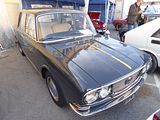
Lancia replaced the long-running Appia with a new model in 1963, the Fulvia. Like the larger Flavia which had been shown 3 years earlier, it came with front wheel drive, and a host of exquisite engineering which ensure that even though it was expensive, it was actually not profitable for its maker, and was a direct contribution to the marque’s bankruptcy and take over by Fiat in 1969. It was not long before the initial Berlina saloon model was joined by a Coupe. First seen in 1965. the Coupe proved to be the longest lived of all Fulvia variants, surviving until 1976 when it was effectively replaced by the 1300cc version of the Beta Coupe. Before that, it had undergone a steady program of updates, with more powerful engines, including a capacity increase from the initial 1200cc of the narrow angle V4 to 1300 and then later 1600cc, and the car was developed into a successful rally machine for the late 60s. The Sport Zagato version was designed by Ercole Spada at Zagato and was intended to be the more sporting model of the range. It was also considerably more expensive. Early cars had an unusual side hinged bonnet, but this was changed on the Series 2 models which were launched in 1970, and which also switched to all-steel bodies. Seen here were examples of the very elegant Coupe model.
The Beta family formed the core of Lancia’s range throughout the 1970s., The Berlina model came first, launched at the 1972 Turin Show. In its day, it sold in grater numbers than cars like the rival BMW, though few would believe that now. In 1973 the second style to appear was a 2+2 two-door coupé with a 93″ wheelbase, although due to the fuel crisis it did not become available to the public until early 1974. It was launched with 1.6 and 1.8 engines. New 1.6 and 2.0 engines replaced the original units in late 1975 followed by a 1.3 in early 1976, at which point the Fulvia Coupe was deleted. In 1978 automatic transmission and power steering became available. In 1981 the car received a minor facelift and at the same time the 2.0 became available with fuel Bosch electronic fuel injection. In 1983 a 2.0 VX supercharged engine became available with an output of 135 bhp. The bodywork was developed in-house by a Lancia team led by Aldo Castagno, with Pietro Castagnero acting as styling consultant. Castagnero had also styled the Beta’s predecessor, the Lancia Fulvia saloon and coupé. The car was popular in the mid 1970s with 111,801 examples being built, though they are quite rare now. Seen here was a Coupe VX models, with the supercharged engine.
After finishing the Beta family, Lancia turned their engine to a new flagship, calling their new model the Gamma, which continued the naming convention of using Greek letters that was started by its smaller stablemate. Launched at the 1976 Geneva Show, there were several surprises about the new car. As with several other cars of the period, the fastback style of the berlina featured a conventional boot at the rear, and was not a hatchback, despite its appearance. At the car’s press launch Pininfarina explained that a hatchback was avoided to save the inconvenience to back seat passengers when luggage is being loaded: “inconvenience” was thought to be a reference to possible draughts.More surprising, perhaps was the mechanical configuration. Lancia developed unique flat-4 engines for the Gamma (an idea initially was to use a Fiat V6). Engine designer De Virgilio also drew up an engine for the Gamma which was a V6 4-cam with either 3- or 4-litre displacement, but this never came to fruition. The Flat four engine finally chosen for the Gamma lacked the cachet afforded to luxury cars in this sector, which generally came with 6 or 8 cylinders. The 4-cylinder engine was unusually large for a modern 4-cylinder petrol engine, though Subaru EJ flat-4 engines matched it in volume and the later Porsche 944 and 968 had 3 litre straight-4 engines. The “4” had certain engineering advantages, but more than anything it allowed Aldo Brovarone (Pininfarina chief stylist) to design a rakish looking coupé with a low bonnet line and a steeply raked windscreen. Pressure cast in alloy with wet cylinder liners, the engine was also extremely light and though it only produced 140 bhp, (120 bhp in 2.0-litre form) in line with traditional Lancia thinking it generated a huge amount of torque, most of which was available at just 2000 rpm. The car was initially available with a displacement of 2.5 litres, as the Gamma 2500, but this was later joined by a 2.0 litre version (Gamma 2000), which resulted from the Italian tax system (cars with engines larger than 2.0 L are subject to heavier tax burden). The displacement was lowered by decreasing the bore rather than the stroke of the engine. Both displacements were using Weber carburettors, though the 2.5 litre later came in a version fitted with fuel injection, the Gamma 2500 I.E. Ironically, it was the engines that caused the Gamma to have a poor name. They overheated far too easily, wore its cams, and leaked oil. The wishbone bushes wore out early, and, because the power steering was driven from the left cam-belt, the car was prone to snapping that belt when steering was on full lock — with disastrous results. By the time the Facelifted car was launched most of these problems had been addressed, but the damage was done, and the car’s poor reputation cemented. Lancia referred to the change merely as a “face-lift”. The main change was that the engines went from carburettors to Bosch L-Jetronic fuel injection. At the same time a lot of cosmetic work was done; the cars got a new corporate grille, 15-inch “sunburst” alloy wheels, and a slightly upgraded interior, with new instrumentation and interior lighting, new badging, a new style handbrake and gear lever gaitor. But sales continued to lessen, and the car was deleted in 1984, Lancia having built 15,272 berlinas and 6,790 coupés. These days, the Coupe is more commonly seen than the Berlina, and indeed it was one of these here.
There was an also an example of the model that replaced it, the Thema. This was Lancia’s luxury car based on the Tipo Quattro platform, one of four cars to do, the others being the Alfa Romeo 164, Fiat Croma and Saab 9000. The Thema re-established Lancia as a high-quality luxury manufacturer with a galvanised steel chassis and rust protection that equalled or bettered that of its competitors. Build quality was higher than the Fiat Croma’s and on par with the Saab 9000, with which it shared a great deal of body engineering, including its doors. Lancia’s sales organisation, however, was poor in many markets and secondhand values for the car suffered. The first series was built between 1984 and 1988, and was available with 1995 cc 8 valve, twin-cam fuel injected or turbocharged engines or a 2849 cc V6. For most European markets a 2445 cc four-cylinder turbodiesel was also available, though this was not offered to UK buyers. One of these cars, in 2 litre Turbo ie spec, which was the most popular among UK buyers, was on show here. For a while, the Thema changed little, but in 1986, a station wagon designed by Pininfarina was added to the range, though this was also never sold in the UK. 21,074 Thema station wagons were built. The second series Thema, also seen here, and also with a 2 litre Turbo engine, was presented in the Paris Motor Show in September 1988 with 16v 2.0 litre engines replacing the 2.0 litre 8v units increasing the power output of the injection version to 146 PS and the turbo to 205 PS. The diesel engine size increased marginally, to 2499 cc. The series two was then replaced by the facelifted third and last series, introduced at the Paris Motor Show in September 1992 and produced from 1992-1994. Production of the Thema ceased in 1994 when Lancia presented a replacement. the Kappa, a car that would not be sold in the UK.
Lancia launched the Delta in 1979, as what we would now think of as a “premium hatch”. Offered in 1300 and 1500cc engines, this car, which collected the prestigious “Car of the year” award a few months later, brought Italian style and an expensive feeling interior to a new and lower price point in the market than Lancia had occupied since the early days of the Fulvia some 15 years earlier. The range grew first when a model was offered using the 4 speed AP automatic transmission and then in late 1982, more powerful models started to appear, with first a 1600cc engine, and then one with fuel injection, before the introduction of the HF Turbo. All these cars kept the same appearance and were quite hard to tell apart. These were the volume models of the range, but now they are very definitely the rare ones, as it is the performance versions which have survived and are now much loved classics, even though relatively were sold when they were new, thanks to a combination of the fact that they were quite costly and that they only ever came with left hand drive. The Integrale evolved over several years, starting off as the HF Turbo 4WD that was launched in April 1986, to homologate a new rally car for Lancia who needed something to fill the void left by the cancellation of Group B from the end of 1986. The Delta HF 4X4 had a four-wheel drive system with an in-built torque-splitting action. Three differentials were used. Drive to the front wheels was linked through a free-floating differential; drive to the rear wheels was transmitted via a 56/44 front/rear torque-splitting Ferguson viscous-coupling-controlled epicyclic central differential. At the rear wheels was a Torsen (torque sensing) rear differential. It divided the torque between the wheels according to the available grip, with a maximum lockup of 70%. The basic suspension layout of the Delta 4WD remained the same as in the rest of the two-wheel drive Delta range: MacPherson strut–type independent suspension with dual-rate dampers and helicoidal springs, with the struts and springs set slightly off-centre. The suspension mounting provided more isolation by incorporating flexible rubber links. Progressive rebound bumpers were adopted, while the damper rates, front and rear toe-in and the relative angle between springs and dampers were all altered. The steering was power-assisted rack and pinion. The car looked little different from the front wheel drive models. In September 1987, Lancia showed a more sophisticated version of the car, the Lancia Delta HF Integrale 8V. This version incorporated some of the features of the Delta HF 4WD into a road car. The engine was an 8-valve 2 litre fuel injected 4-cylinder, with balancing shafts. The HF version featured new valves, valve seats and water pump, larger water and oil radiators, more powerful cooling fan and bigger air cleaner. A larger capacity Garrett T3 turbocharger with improved air flow and bigger inter-cooler, revised settings for the electronic injection/ignition control unit and a knock sensor, boosting power output to 185 bhp at 5300 rpm and maximum torque of 224 lb/ft at 3500 rpm. The HF Integrale had permanent 4-wheel drive, a front transversely mounted engine and five-speed gearbox. An epicyclic centre differential normally split the torque 56 per cent to the front axle, 44 per cent to the rear. A Ferguson viscous coupling balanced the torque split between front and rear axles depending on road conditions and tyre grip. The Torsen rear differential further divided the torque delivered to each rear wheel according to grip available. A shorter final drive ratio (3.111 instead of 2.944 on the HF 4WD) matched the larger 6.5×15 wheels to give 24 mph/1000 rpm in fifth gear. Braking and suspension were uprated to 284 mm ventilated front discs, a larger brake master cylinder and servo, as well as revised front springs, dampers, and front struts. Next update was to change the engine from 8 valves to 16. The 16v Integrale was introduced at the 1989 Geneva Motorshow, and made a winning debut on the 1989 San Remo Rally. It featured a raised centre of the bonnet to accommodate the new 16 valve engine, as well as wider wheels and tyres and new identity badges front and rear. The torque split was changed to 47% front and 53% rear. The turbocharged 2-litre Lancia 16v engine now produced 200 bhp at 5500 rpm, for a maximum speed of 137 mph and 0–100 km/h in 5.5 seconds. Changes included larger injectors, a more responsive Garrett T3 turbocharger, a more efficient intercooler, and the ability to run on unleaded fuel without modification. The first Evoluzione cars were built at the end of 1991 and through 1992. These were to be the final homologation cars for the Lancia Rally Team; the Catalytic Evoluzione II was never rallied by the factory. The Evoluzione I had a wider track front and rear than earlier Deltas. The bodyside arches were extended and became more rounded. The wings were now made in a single pressing. The front strut top mounts were also raised, which necessitated a front strut brace. The new Integrale retained the four wheel drive layout. The engine was modified to produce 210 bhp at 5750 rpm. External changes included: new grilles in the front bumper to improve the air intake for engine compartment cooling; a redesigned bonnet with new lateral air slats to further assist underbonnet ventilation; an adjustable roof spoiler above the tailgate; new five-bolt wheels with the same design of the rally cars; and a new single exhaust pipe. Interior trim was now grey Alcantara on the Recaro seats, as fitted to the earlier 16V cars; leather and air conditioning were offered as options, as well as a leather-covered Momo steering wheel. Presented in June 1993, the second Evolution version of the Delta HF Integrale featured an updated version of the 2-litre 16-valve turbo engine to produce more power, as well as a three-way catalyst and Lambda probe. A Marelli integrated engine control system with an 8 MHz clock frequency which incorporates: timed sequential multipoint injection; self-adapting injection times; automatic idling control; engine protection strategies depending on the temperature of intaken air; Mapped ignition with two double outlet coils; Three-way catalyst and pre-catalyst with lambda probe (oxygen sensor) on the turbine outlet link; anti-evaporation system with air line for canister flushing optimised for the turbo engine; new Garrett turbocharger: water-cooled with boost-drive management i.e. boost controlled by feedback from the central control unit on the basis of revs/throttle angle; Knock control by engine block sensor and new signal handling software for spark park advance, fuel quantity injected, and turbocharging. The engine now developed 215 PS as against 210 PS on the earlier uncatalysed version and marginally more torque. The 1993 Integrale received a cosmetic and functional facelift that included. new 16″ light alloy rims with 205/45 ZR 16 tyres; body colour roof moulding to underline the connection between the roof and the Solar control windows; aluminium fuel cap and air-intake grilles on the front mudguards; red-painted cylinder head; new leather-covered three-spoke MOMO steering wheel; standard Recaro seats upholstered in beige Alcantara with diagonal stitching. In its latter years the Delta HF gave birth to a number of limited and numbered editions, differing mainly in colour, trim and equipment; some were put on general sale, while others were reserved to specific markets, clubs or selected customers. A number of these were among the displays.
Also here was a Stradale version of the Delta S4. Between October 1985 and 1986 Lancia built 200 examples of a road-going version of the Delta S4, officially named Lancia Delta S4 but widely known as “Stradale”, for the purpose of homologation in Group B. In Italy, the car was priced at about 100 million Lira: five times the price of the most expensive Delta of the time, the HF Turbo. The Stradale’s chassis was a space frame, similar to its rally counter-part, built out of CrMo steel tubes and aluminium alloy for the crash structures; it was covered by epoxy and fibreglass body panels. Like the rally car, the 1.8-litre four-cylinder engine was longitudinally mid-mounted, equipped with Weber-Marelli IAW integrated electronic ignition and fuel injection, a supercharger, a turbocharger and two intercoolers. In road tune the 1.8 produced 250 PS at 6,750 rpm and 291 N⋅m (215 lb⋅ft) of torque at 4,500 rpm. The “Stradale” kept a three differential four-wheel-drive system from the rally car; the centre differential sent 30% of the engine torque to the front open differential, and 70% to the rear limited slip. Lancia claimed the car could reach a top speed of 225 km/h (140 mph) and accelerate from standstill to 100 km/h (62 mph) in 6.0 seconds. In contrast to its bare bones racing sister, the S4 Stradale featured an Alcantara-upholstered interior, sound deadening, a suede steering wheel, and was equipped with power steering, trip computer and air conditioning.
LAND ROVER
A factory-backed display here focused on the Discovery, with the latest 5th generation model making one of its first public showings here in advance of sales starting in the Spring. There were examples of each of the preceding 4 generations here as well, showing the very clear lineage and evolution over the past 27 years. Among the cars present were one of the G4 Challenge vehicles and the millionth Discovery, a fourth generation car, to be produced.
Introduced in 1948, the very first Land Rover Station Wagon was built by Newport Pagnell-based coachbuilders, Tickford Ltd; it featured an aluminium-panelled, timber-framed body, and was intended to extend the Landie’s appeal beyond the agricultural sector. However, the Station Wagon was treated as a car by the taxation authorities, adding a hefty chunk of Purchase Tax to its already considerable cost. In total, only 641 were sold, with most sent for export, and today this early ‘luxury’ Land Rover is one of the most sought after variants.
The Range Rover is a popular modern classic in Italy and there were plenty of examples of the first generation of this innovative vehicle here.
MASERATI
Maserati had a large stand in the middle of one of the halls, as they have done in previous years, and there were three fabulous cars from their past on show, none of which would be all that familiar to most people. Perhaps the best known is the Eldorado, a car which became famous in 1958 as the first single-seater car in Europe to be sponsored by a brand not linked to the world of motorsport. The brand in question was Eldorado, an ice-cream manufacturer. This was the first example of modern sponsorship, where the car was painted in the colours of the partner company, abandoning the traditional colour assigned to each country by the International Federation. This was a real revolution for the day, of vital importance to the future of motorsport, which from that moment on opened its doors to new financial backers. Maserati was commissioned to build the car by Gino Zanetti, owner of the Eldorado ice-cream company. Determined to promote his brand on the international stage, Zanetti turned to the House of the Trident to create a single-seater car to compete in the “Trofeo dei due Mondi” (Race of Two Worlds) at Monza: the Automobile Club d’Italia had organised a 500 Mile race at the circuit based on the Indianapolis 500, with top American drivers lining up alongside Europe’s cream of the crop. The Maserati 420/M/58, chassis number 4203, was thus finished with a cream coloured livery, instead of Italian racing red. The name Eldorado was emblazoned in bold black lettering along the sides of the car, with two additional smaller logos on the nose and below the small deflector that acted as a windshield. The logo with the face of the smiling cowboy was positioned in the centre of the nose and on the sides of the rear fin. Below the two Eldorado brands on the sides, in bright racing red was “Italia”, denoting the nationality of the sponsor as well as that of the racing car manufacturer. The long silhouette of the “Eldorado” also bore the name of the driver chosen to race it in the “Monzanapolis”: Stirling Moss, one of the greatest drivers in the history of motor sports, and a former Maserati driver. The previous year, in 1957, the Modena-based manufacturer had won the Formula 1 World Championship with Juan Manuel Fangio, before deciding to withdraw from competitive racing and build racing cars on commission only for private customers, also providing them with assistance. This was precisely the ideal situation that Zanetti was seeking, and the reason why the Italian entrepreneur turned to Maserati. In the space of a few months, the engineer Giulio Alfieri created the “Eldorado”. The engine, derived from the V8 unit mounted in the 450S twin cam models, had its displacement reduced to 4,190 cc, generating 410 hp at 8,000 rpm; both the engine and transmission were offset to the left by nine centimetres. The aim of this decision was to ensure a more balanced weight distribution, taking into account the anti-clockwise direction of travel on the high banked corners at Monza. The gearbox had just two speeds while the De Dion rear axle had no differential. The tubular chassis was derived from that of the highly successful 250F, although it proved oversized compared to the latter, also as a result of numerous reinforcements introduced to enable the car to withstand the mechanical stress generated by the concrete track at Monza. To reduce the weight, Halibrand magnesium wheels were used along with Firestone 18-inch braided tread tyres inflated with helium. With these measures, the car weighed in at 758 kg. The aluminium bodywork, hand crafted by Fantuzzi, was characterised by an aerodynamic vertical fin behind the cockpit and a front carburettor scoop. On 29th June 1958, at the Monza track, the race was held in three heats to decide the final points table. This strategy was aimed at enticing European car manufacturers to enter their own cars, which had not originally been designed to compete in such a long race, and one that was so mechanically arduous. In the first heat Moss finished 4th. In the second he crossed the line 5th. In the final heat, however, his steering broke and the Maserati slammed into the guard-rail, dashing the English driver’s hopes of finishing the race in third place overall. Taking into account the three heats and the total number of laps completed, Moss nonetheless took seventh place in the end. He walked away unscathed from the crash and, all things considered, the “Eldorado” too suffered only limited damage, proving the value of its solid structure. Despite the success in terms of spectator numbers and entertainment value, the 500 Miles of Monza did not become a regular event on the racing calendar. Based on the findings from the race, the “Eldorado” was modified by the Gentilini bodywork shop, which removed the rear fin and reduced the hood scoop, after which the car was entered in the Indianapolis 500 in 1959. This time it was finished in red, the colour denoting Italy in competitions, but still emblazoned with the Eldorado sponsor’s name in white lettering on the sides, as well as the cowboy logo in a white circle on the nose and tail. The inexperience of the gentleman-driver, Ralph Liguori, meant that the car failed to qualify, as it set the 36th fastest time, with only the first 33 qualifying. With a professional driver behind the wheel, it would have been a very different result. But that is a whole other story. The Indy 500 race was dear to Maserati, which took victory in 1939 and 1940 with the driver Wilbur Shaw behind the wheel of an 8CTF. Shaw almost made it a hat-track in 1941, but was forced to withdraw during the penultimate lap while out in front, victory denied by a broken wheel. Maserati is the only Italian car manufacturer to have won on the Indiana race track and the only European brand to have triumphed on two consecutive occasions.
This is the Simun, a concept presented by Ghia at the Turin Motorshow in 1968. It used a 4.2-litre V8 from Maserati, had a wheelbase of 2600mm and front and rear tracks of 1480mm. It was commissioned by Maserati to study a high performance four seater car. It is a one-off, and is rarely seen these days.
Final car on the Maserati stand was a Tipo 61 Birdcage, dating from 1959. The car was produced between 1959 and 1961 by Maserati for racing in sports car events including the 24 Hours of Le Mans endurance classic. It used an intricate tubular space frame chassis, containing about 200 chro-moly steel tubes welded together, hence the nickname “Birdcage”. This method of construction provided a more rigid and, at the same time, lighter chassis than other sports cars of the time. By recessing the windscreen base into the bodywork, Maserati was able to reduce the effect of new Le Mans rules demanding a tall windscreen. The Camoradi team became famous racing the Tipo 61s but, despite being very competitive, the Birdcage was somewhat unreliable and occasionally retired from many races due to problems with the drivetrain. The Tipo 61 was unveiled in 1959 when Stirling Moss won its first race, attracting the attention of Lloyd “Lucky” Casner. Casner founded the Casner Motor Racing Division who raced three Tipo 61’s in the 1960 24 Hours of Le Mans. The Tipos never won Le Mans due to reliability issues, however in both 1960 and 1961 the Camoradi team won the 1000 km Nürburgring. The Tipo 61 was the most well known model but Giulio Alfieri designed 5 different models, all based on an intricate multi-tubular frame concept. This multi-tubular construction produced a light weight and rigid chassis that was a significant competitive advantage for a racing car. All models included independent front suspension, 4-wheel disc brakes and 5-speed transmission. A De Dion type rear axle was used on the Tipo 60 and 61. Tipo 60 featured a small 2-litre 4-cylinder engine of 200 hp, located in the front and tilted over at a 45° angle for a lower center of gravity. The weight was 570 kg (1,257 lb) and the car had at a maximum speed of 270 km/h (168 mph). Tipo 61 featured a 2.9-litre 4-cylinder engine of 250 hp, located in the front at a 45° angle for a weight of 600 kg (1,323 lb) pushing the car at a speed of 285 km/h (177 mph). The mid-engined Birdcage cars began with the Tipo 63. Maserati now changed to a mid-engine configuration using a similar multi-tubular chassis construction. The rear suspension was changed to an independent double wishbone configuration. The Tipo 63 through 65 cars have been described as a “historian’s nightmare”. Maserati was in difficult financial circumstances and Giulio Alfieri was trying to build a competitive car on a low budget. He would retrieve various engines from the Maserati parts bins. Then, he had them modified and installed in the ten various chassis that were constructed. The Tipo 63 was raced with four-cylinder and twelve-cylinder engines and the chassis was radically redesigned when the first version proved less competitive than the Tipo 61. Tipo 63 first used a 4-cylinder engine similar to the Tipo 61 and later a V12 engine from the Formula One 1957 Maserati 250F. Tipo 63 cars raced in 1961 with both engines, placing 4th at the 24 hours of Le Mans (12 cylinder version) with Briggs Cunningham’s team. And Count Volpi’s Scuderia Serenissima hired Medardo Fantuzzi to modify one of their Tipo 63 cars with a longer nose and a fin behind the driver. Tipo 64 featured the same 3-liter V12 as the Tipo 63 with an upgraded frame (many smaller light alloy tubes) – nicknamed “Supercage”. Tipo 65 featured a V8 engine of 5 liters delivering about 430 hp (321 kW) pushing the car at 350 km/h (217 mph). Only one car was built using a modified Tipo 63 chassis.
Elsewhere in the event there were lots of other Maserati models, with almost every different body style that the firm produced from the real start road car production through to the end of the twentieth century.
Oldest of these, and coming soon after that lovely 300S was the 3500GT and later 3500GT Vignale Spider, examples of both of which were on show. Maserati had made their first forays into the grand tourer market, with the 1947 A6 1500, 1951 A6G 2000 and 1954 A6G/54, but whilst these cars had proven that the expanding the business beyond race cars was feasible; these A6 road cars were still built at the rate of just a dozen examples a year, which hardly constituted series production. A different approach was going to be needed, with the objective of building fully accomplished grand tourers. An engine was not really a problem. The 2 litre twin cam unit that had enabled Maserati to achieve racing success and international visibility in the early 1950s, thanks to cars such as the A6GCM;, had already been enlarged to three litre capacity on the Maserati 300S. Chief engineer Giulio Alfieri felt the next step was to design an all-new 3.5-litre engine; the resulting long-stroke six, designed foremost for endurance racing on the Maserati 350S, was ready in 1955. The main development efforts that led to the 3500 GT were carried out in 1956–57, despite the frantic activity required by Maserati’s participation in the Formula 1 world championship. Alfieri modified the 350S’s engine to suit a touring car, such as switching to a wet sump oil system and changing the engine accessories. He also made several business trips to the United Kingdom in order to contact components suppliers. None were found in Italy, as Italian taxation system and the industry structure forced manufacturers to design every part in-house; a daunting task for small companies like Maserati. Thus the 3500 GT alongside Italian Weber carburettors and Marelli ignition, used many British-made components such as a Salisbury rear axle, Girling brakes and Alford & Alder suspension parts. Clearly the bodywork would have to be Italian. According to Carrozzeria Touring’s Carlo Felice Bianchi Anderloni it was Commendatore Franco Cornacchia, a prominent Ferrari dealer, that put in contact Maserati owner Omar Orsi with the Milanese Carrozzeria The first 3500 GT Touring prototype had a 2+2 body, with superleggera construction and was white in colour; it was nicknamed Dama Bianca (White Lady). Two 3500 GT prototypes were shown at the March 1957 Salon International de l’Auto in Geneva. Both had a 2,600 mm (102.4 in) wheelbase and aluminium bodywork; they were Touring’s Dama Bianca, and another one by Carrozzeria Allemano. Touring’s proposal was chosen for series production; few changes were made to it, chiefly a more imposing grille. Production of the 3500 GT started in late 1957; eighteen cars were built that year, the first handful leaving the factory before Christmas. All 3500 GTs had leather interior and Jaeger-LeCoultre instruments. A first Touring convertible prototype was shown at the 1958 Turin Motor Show, but it was a proposal by Carrozzeria Vignale (designed by Michelotti) shown at the 1959 Salon de l’Auto in Paris that went into production as 3500 GT Convertibile. The Convertibile did not feature Touring’s Superleggera construction, but rather a steel body with aluminium bonnet, boot lid and optional hard top; it was also built on an 10 cm (3.9 in) shorter wheelbase, and weighed 1,380 kg (3,042 lb). Front disc brakes and limited slip differential became optional in 1959, and were standardized in 1960; rear discs became standard in 1962. The 3500 GTi was introduced at the 1960 Salon International de l’Auto, and by the following year became the first fuel-injected Italian production car. It had a Lucas mechanical fuel injection, and developed 232 bhp. A 5-speed gearbox was now standard. The body had a lowered roofline and became somewhat longer; minor outward changes appeared as well (new grille, rear lights, vent windows). From 1961 convertible 3500s for export markets were named 3500 GT Spyder and GTi Spyder. In total, 2,226 3500 GT coupés and convertibles were built between 1957 and 1964. In the first year, 1958, just 119 cars were sold, while 1961 was the best-selling year, totalling 500. All together, 245 Vignale convertibles and nearly 2000 coupés were manufactured, of these, 1981 being Touring coupés, the rest were bodied by other coachbuilders: Carrozzeria Allemano (four coupés, including the 1957 prototype), Zagato (one coupe, 1957), Carrozzeria Boneschi (1962 Turin Motor Show and 1963 Geneva Motor Show ), Pietro Frua (two or three coupés, one spider) and Bertone (one coupé, 1959 Turin Motor Show) The last was a coupé by Moretti for the 1966 Geneva Motor Show. The car was replaced by the Sebring in 1964.
Dating from 1964 was this sublime Mistral Spyder. Known internally as Tipo AM109, the Mistral was a 2-seat gran turismo produced between 1963 and 1970, as a successor to the 3500 GT. It was styled by Frua and bodied by Maggiora of Turin. Named after a cold northerly wind of southern France, it was the first in a series of classic Maseratis to be given the name of a wind. The Mistral was the last model from the Casa del Tridente (“House of the Trident”) to have the company’s renowned twin-spark, double overhead cam straight six engine. Fitted to the Maserati 250F Grand Prix cars, it won 8 Grand Prix between 1954 and 1960 and one F1 World Championship in 1957 driven by Juan Manuel Fangio. The engine featured hemispherical combustion chambers fed by a Lucas indirect fuel injection system, a new development for Italian car manufacturers. Maserati subsequently moved on to V8 engines for their later production cars to keep up with the demand for ever more powerful machines. Three engine were fitted to the Mistral, displacing 3500, 3700 and 4000 cc and developing 235 bhp at 5500 rpm, 245 bhp at 5500 rpm and 255 bhp at 5200 rpm, respectively. Only the earliest of the Mistrals were equipped with the 3500 cc, the most sought after derivative is the 4000 cc model. Unusually, the body was offered in both aluminium and, from 1967, in steel, but no one is quite sure how many of each were built. The car came as standard with a five speed ZF transmission and four wheel solid disc brakes. Per Maserati practice, the front suspension was independent and the rear solid axle. Acceleration 0-60 for both the 3.7 litre and 4.0 litre engines was around or just under 7 seconds, and top speed approximately 140 mph (225 km/h) to 145 mph (233 km/h). The body was designed by Pietro Frua and first shown in a preview at the Salone Internazionale dell’Automobile di Torino in November 1963. It is generally considered one of the most beautiful Maseratis of all time. It is also often confused with the very similar looking but larger and more powerful Frua designed AC 428. A total of 828 coupés and 125 Spyders were built. Only the Spyder received the 3500 engine; just 12 were made, along with 76 3.7 litre and 37 4.0 litre versions. Twenty Spyders were right hand drive. The Mistral was succeeded by the Ghibli, which overlapped production from 1967 on.
The original Maserati Quattroporte (Tipo AM107) was built between 1963 and 1969. It was a large saloon powered by V8 engines—both firsts for a series production Maserati. The task of styling the Quattroporte was given to Turinese coachbuilder Pietro Frua, who drew inspiration from a special Maserati 5000 GT (chassis number 103.060) he had designed in 1962 for Prince Karim Aga Khan. While the design was by Frua, body construction was carried out by Vignale. The Quattroporte was introduced at the October-November 1963 Turin Motor Show, where a pre-production prototype was on the Maserati stand next to the Mistral coupé. Regular production began in 1964. The Tipo 107 Quattroporte joined two other grand tourers, the Facel Vega and the Lagonda Rapide, capable of travelling at 200 km/h (124 mph) on the new motorways in Europe. It was equipped with a 4.1-litre V8 engine, producing 260 hp at 5,000 rpm, and either a five-speed ZF manual transmission or a three-speed Borg Warner automatic on request. Maserati claimed a top speed of 230 km/h (143 mph). The car was also exported to the United States, where federal regulations mandated twin round headlamps in place of the single rectangular ones found on European models. Between 1963 and 1966, 230 units were made. In 1966, Maserati revised the Tipo 107, adding the twin headlights already used on the U.S. model. A leaf-sprung solid axle took place of the previous De Dion tube. The interior was completely redesigned, including the dashboard which now had a full width wood-trimmed fascia. In 1968 alongside the 4.1-litre a 4.7-litre version became also available (AM107/4700), developing 286 bhp. Top speed increased to a claimed 255 km/h (158 mph), making the Quattroporte 4700 the fastest four-door sedan in the world at the time. Around 500 of the second series were made, for a total of 776 Tipo 107 Quattroportes. Production ended in 1969.
This is a Sebring, which was based on the earlier Maserati 3500 GT, and aimed at the American Gran Turismo market, taking its name from Maserati’s 1957 racing victory at the 12 Hours of Sebring. A single two-seat spyder was built by Vignale in 1963 but did not enter production. The Series I (Tipo AM 101/S) was shown at the Salon International de l’Auto 1962 and again at the Salone dell’automobile di Torino in 1963. Employing all but the Maserati 3500’s coachwork, it could reach 137 mph and 0–60 mph in 8.5 seconds on 185×15 Pirelli Cinturato tyres. A Borg-Warner automatic transmission was available, a first for Italian automobiles. When leaving the factory it originally fitted Pirelli Cinturato 205VR15 tyres (CN72). A total of 348 Series I Sebrings were built between 1962 and 1965. The engine was updated in 1963, gaining 15PS for a total of 235 PS. The 3700 engine first appeared in 1964, although only a handful of Series I cars were thus equipped. In 1965, the modified Series II (Tipo AM 101/10) was introduced. It had lightly redesigned headlamps, modernised bumpers, new front indbicators, and new side grilles replacing the lower extraction vents used hitherto. It took minor design cues from the contemporary Quattroporte. At the rear, aside from the squared off bumpers, the taillights were now mounted horizontally rather than vertically and the bootlid opening was narrowed somewhat. The Series II rode on larger 205×15 Pirelli Cinturatos. A run of 247 units were made from 1964 until 1968. Along with the 3500 engine, the 3700 and the even larger 4000 were added. The 4000 GTiS has a 4,012 cc engine producing 255 PS at 5,200 rpm. It remained in production until 1968, when financial constraints forced Maserati to drop its older models from production. No major updates took place over the last three years of production, except for a slight power gain for the 4000, now up to 265 PS. 348 units of Sebring 3.5 and 245 of 3.7 and 4.0 (combined) were made, for a total of 593 units from 1962 to 1969.
There were a couple of the very pretty Ghibli model – the first of three very different models to bear the name – on dealer stands. First unveiled in prototype form on the Maserati stand at the November 1966 Turin Motor Show, this grand tourer with an all steel body, characterised by a low, shark-shaped nose, was designed by a young Giorgetto Giugiaro, then working at Carrozzeria Ghia. Deliveries started in March of the following year. While the 1966 Ghia prototype was a two-seater, on the production car two emergency rear seats were added—consisting of nothing more than a cushion without backrest—and the Ghibli was marketed as a 2+2, though everyone tends to think of this car as a 2 seater, and the later Indy as the real 2+2 from the range. The first Ghibli cars were powered by a front placed quad-cam 4.7 litre dry sump V8 engine that prodiuced 306 bhp, mated to a five-speed manual or, on request, to a three-speed automatic transmission. It had a 0-60 mph time of 6.8 seconds, a top speed of 250 km/h (155 mph). The car also featured pop-up headlamps, leather sport seats and alloy wheels. A convertible version, the Ghibli Spyder, went into production in 1969. Its convertible top folded away under a flush fitting body-colour tonneau cover behind the front seats; thus the Spyder eschewed any vestigial rear passenger accommodation, and was a strict two-seater. A removable hard top was available as an option. The 4.9-litre Ghibli SS was released later in 1969. Its V8 engine was stroked 4 mm to displace 4930 cc, and put out 330 bhp; its top speed of 280 km/h (174 mph) made it the fastest Maserati road car ever produced. In all, 1,170 coupés and 125 Spyders (including 25 Spyder SS) were produced.
Dating from the late 1960s was this Mexico. The Maserati Mexico’s design derived from a 2+2 prototype bodywork shown on the Vignale stand at the October 1965 Salone di Torino and built upon a 4.9-litre 5000 GT chassis, rebodied after it had been damaged. As the car after the show was sold to Mexican president Adolfo López Mateos, the model became known as the Mexico. By coincidence, John Surtees won the Mexican Grand Prix on a Cooper-Maserati T81 the following year. Vignale’s prototype was so well received that Maserati immediately made plans to put a version into production. The production Maserati Mexico debuted in August 1966 at the 20° Concorso internazionale di eleganza per auto in Rimini, while its international première was at the October Paris Motor Show. It was built on the first generation Quattroporte chassis with a wheelbase shortened by 11 cm (4.3 in). Originally powered by a 4.7-litre 90° V8 fed by four twin-choke 38 DCNL5 Weber carburetors that produced 290 bhp, the car managed to turn out a top speed between 240–250 km/h (149–155 mph). In 1969, however, contrary to Maserati tradition, the Mexico was also made available with a smaller engine, the 4.2-litre V8 engine. Apart from the smaller engine option the Mexico underwent few changes during its lifetime. Its luxurious interior included a rich leather seating for four adults, electric windows, wooden dashboard, iodine headlights and air conditioning as standard. Automatic transmission, power steering and a radio were available as optional extras. The 4.7-litre version was fitted with 650×15″ Borrani chrome wire wheels and the 4.2-litre version with steel disc wheels. When leaving the factory all Maserati Mexicos originally fitted Pirelli Cinturato 205VR15 tyres (CN72). The Mexico was the first production Maserati to be fitted with servo assisted ventilated disc brakes on all four wheels. In May 1967, under commission from the German concessionaire Auto Koenig for one client, Herr Rupertzhoven, Maserati built a ‘Mexico’ similar to Vignale’s original prototype design but was the work of Frua. Appearing like a 4-seat Mistral and built on the same tubular chassis as the 3500 GT (2600 mm wheelbase), this prototype ‘Mexico’ was fitted with the Mistral’s six-cylinder 3.7-litre Lucas fuel-injected engine. It was finished in Oro Longchamps with a black leather interior. Its dashboard came from the Quattroporte. 485 Mexicos were produced, 175 equipped with the 4.7 engine and 305 with the 4.2.
The Maserati Indy (Tipo AM 116) is a four-seater fastback grand tourer produced from 1969 to 1975. The Indy was conceived as an alternative to the Ghibli offering a V8 engine and room for four people; it effectively replaced both the ageing six-cylinder 2+2 Maserati Sebring—which descended from the 1957 3500 GT— and the first generation Quattroporte. Two coachbuilders showed their proposals at the November 1968 Salone dell’automobile di Torino, both based on a Maserati 4.2-litre chassis. On Ghia’s stand there was the Simùn, a 2+2 berlinetta designed by Giorgetto Giugiaro; on Carrozzeria Vignale’s, a sleek 4-seater fastback penned by Giovanni Michelotti. Both coachbuilders had already an established relationship with Maserati, as Vignale had been responsible for the 3500 GT Spyder, Mexico and Sebring, while Giugiaro had recently penned the Ghibli at Ghia. Vignale’s prototype was preferred, and the production model was launched by Maserati at the Geneva Motor Show the following March. The car was christened Indy in honour of Maserati’s two victories at the Indy 500. At its launch in 1969 the Indy was offered with a 4.2-litre V8 engine. From 1970 a 4.7-litre Indy 4700 was offered alongside the 4200; the same year some interior updates were introduced, including seats with retractable headrests and a new dashboard. In 1972, Maserati added the Indy 4900 to the range, equipped with the new 4.9-litre V8. Production of the Indy ended in 1975. In total 1,104 were produced, 440 of them Indy 4.2s, 364 Indy 4.7s and 300 Indy 4.9s. These days the cars worth a fraction of the prices charged for a Ghibli, which makes them something of a bargain to my mind.
It was good to see a couple of examples of the Bora here. Shortly after Citroën took a controlling interest in Maserati in 1968, the concept of a mid-engined two-seat sports car was proposed. Lamborghini and De Tomaso already had the Miura and Mangusta whilst Ferrari were known to be developing their own mid-engined contender. Initially known as Tipo 117 and later the Bora, the Maserati project got underway in October 1968 and a prototype was on the road by mid-1969. Shown in its final form at the Geneva Salon in March 1971, deliveries began before the end of the year. Maserati had developed a reputation for producing technologically out of date cars, but that changed with the Bora. A number of innovative features were introduced that distinguished the car from their previous offerings. Compared to other supercars it was civilised and practical, featuring a hydraulically powered pedal cluster that could be moved forward and backwards at the touch of a button and a steering wheel that could be tilted and telescoped, addressing the common problem of entering and exiting the vehicle common to all supercars. Most supercars offer little foot room and little to no provision for luggage, but the Bora has a full-size boot in the front of the vehicle, and was otherwise known as being much more civilised in comforts from its competitors, while still being rated at 171 mph by the Maserati factory. Unlike its competitors, the Bora used dual-pane glass separating its cabin from the engine compartment as well as a carpeted aluminium engine cap, greatly decreasing the engine noise in the cabin and increasing the comfort level for the driver. Two engines were offered initially, including a high-revving 4.7-litre V8 and a higher torque 4.9-litre V8; a US smog-qualified 4.9-litre engine was used (a stroked version of the 4.7), starting with 1973 deliveries. Eventually, production switched to using only a more powerful version of the 4.9-litre engine producing 320 hp at 6000 rpm. All these engines traced their lineage back to the famous 450S racecar, were aluminium alloy, had hemispheric combustion chambers with 16 valves total operated by four cams (chain-driven) and fed by eight throats of Weber carburettors, fired by electronic ignition. The extraordinarily competent and strong ZF-1 five-speed transaxle was used, as it was with the GT-40, Pantera, BMW M1, and other supercars of this era. Regardless of engine size or modification level, the Bora was considered an extraordinarily powerful car in its time. A combined steel monocoque chassis and body featured a tubular steel subframe at the back for the engine and transmission. Suspension was independent all round (a first for a Maserati road car) with coil springs, telescopic shocks and anti-roll bars. The development prototype and the broadly similar show car first seen at the 1971 Geneva Motor Show featured MacPherson strut based front suspension, but this was abandoned for production because, installed in combination with very wide front tires and rack-and-pinion steering, the strut-based solution produced severe kickback. For the production cars Maserati reverted to a more conservative wishbone front-suspension arrangement. Citroën’s advanced high-pressure LHM hydraulics were adopted to operate the ventilated disc brakes on the main circuit, and on an auxiliary circuit the pedal box [clutch, brake, foot-throttle], the driver’s seat [vertical adjustments], and the retractable headlights. Wheels were 7.5 x 15 inch Campagnolo light alloy rims with distinctive removable polished stainless steel hubcaps in the earlier automobiles, and tyres were Michelin XWX 205×70 front and rear, however these early cars exhibited problems with “tramlining” at speed. To solve this problem Maserati fitted later cars with 215×70 Michelins’. Maserati decided to install a subtly uprated version of their familiar DOHC 90° V8, displacement having been 4719 cc thanks to a bore and stroke of 93.9 x 85 mm. Mounted longitudinally, compression was set at 8.5:1 and with four Weber 42 DCNF downdraught carbs and electronic Bosch ignition, the Bora could boast 310 bhp at 6000 rpm. Great attention was paid to reducing noise and vibration, the engine and five-speed ZF transaxle being mounted on a subframe attached to the monocoque via four flexible mounts. The body was created by Giorgetto Giugiaro for Ital Design, fabrication of the all-steel panels being contracted to Officine Padane of Modena. Standing 1138 mm high, perhaps the most distinctive details were the brushed stainless steel roof and windscreen pillars. Inside, the bucket seats, dash, door trim, centre console and rear bulkhead were trimmed in leather, electric windows having been standard, most cars also getting air conditioners. The steering column was manually adjustable for rake and reach, whereas the LHM aux. circuit controls adjusted the driver’s seat vertically, the pedal box [consisting of the brake, clutch and throttle pedals] horizontally forwards and backwards by around three inches (76 mm)–a first such application in the world for a production car, and also to raise and lower the concealed headlights in the front fenders. The Bora was the basis for the Merak, which used the same bodyshell front clip but in a 2+2 configuration, made possible by using a smaller, lighter and less powerful Maserati V6 engine, also used in the Citroën SM. Maserati struggled after being bought by De Tomaso in 1975, and the Bora was discontinued after the 1978 model year.
The Merak was introduced at the 1972 Paris Auto Show, over a year after the Bora, a car whose front part of the bodyshell up to the doors, it shares. The front ends are differenced mainly by the use of dual chrome bumpers in place of twin trapezoidal grilles, but the similarities end at the B-pillar. Unlike its bigger sister the Merak doesn’t have a true, fully glassed fastback, but rather a cabin ending abruptly with a vertical rear window and a flat, horizontal engine bonnet pierced by four series of ventilation slats. Giugiaro completed the vehicle’s silhouette by adding open flying buttresses, visually extending the roofline to the tail. The main competitors of the Merak were the similarly Italian, mid-engined, 3-litre and 2+2 Dino 308 GT4 and Lamborghini Urraco P250. However unlike its transverse V8-engined rivals the Merak used a more compact V6, that could therefore be mounted longitudinally. Having been designed during the Citroën ownership of Maserati, certain Citroën hydropneumatic systems were used in the Merak, as for the Bora. These included the braking system and the clutch which were both hydraulically assisted and operated, and the pop-up headlights were hydraulically actuated. After 1976, when the French manufacturer gave up control of Maserati, the Citroën-derived parts were gradually replaced by more conventional systems. In 1977 Alejandro de Tomaso purchased Maserati and the Bora was discontinued after a production run of less than 600 cars, while the Merak remained on sale for six more years. The Merak’s V6 engine descended from the 2.7 litre Tipo C.114 originally designed by Giulio Alfieri in 1967 for use in the Citroën SM, that was bored out to 91.6 mm to displace 2,965 cc. It was a chain-driven double overhead camshaft, 12-valve unit featuring an unusual 90° angle between the cylinder banks. The lubrication system used a wet sump and an oil cooler. This V6 did not end its days on the Merak: it was later modified and made into the first ever production twin-turbocharged engine in the Biturbo, ending its career in the 1990s Ghibli after reaching the highest specific output of any production engine at the time. The powerplant was mounted longitudinally behind the passenger compartment, and joined through a single-plate dry clutch to a 5-speed, all syncromesh Citroën transaxle gearbox and a limited-slip differential. The original Merak’s three-litre engine produced 190 PS at 6000 rpm. Three twin-choke Weber carburettors (one 42 DCNF 31 and two 42 DCNF 32) fed the engine, and the compression ratio was 8.75:1. Maserati declared a top speed of over 240 km/h (149 mph). Early Meraks (1972 to 1975) were fitted with the Citroën SM’s dashboard, characterised by oval instrument gauges inset in a brushed metal fascia and a single-spoke steering wheel. 630 were made up to 1974. The lightened and more powerful Merak SS (Tipo AM122/A) was introduced at the 41st Geneva Motor Show in March 1975, although it did not enter production until the next year. It featured a 50 kg weight reduction and a 30 PS power increase to 220 PS (217 hp), thanks to the adoption of three larger 44 DCNF 44 carburettors and a higher 9:1 compression ratio. The SS was recognisable from a black grille between the pop-up headlights. A Maserati-designed upper fascia with round instruments and a four-spoke steering wheel replaced the previous SM-derived interior furniture. Later cars were bestowed with the full driver-oriented dashboard and three-spoke padded steering wheel of the Maserati Bora. The US-spec version of the Merak SS also saw a return to traditional hydraulics, eliminating the last of the Citroen high pressure system. 1000 units of the SS had been made by 1983, when all Merak production ceased. A third version of the Merak was made, In November 1977 at the Turin Auto Show, De Tomaso launched the Merak 2000 GT (Tipo AM122/D), which was basically a Merak with a smaller two-litre powerplant. It was built almost exclusively for the Italian market, where a newly introduced law strongly penalised cars with engine capacity over 2000 cc by subjecting them to a 38% Value Added Tax against the usual 19% VAT. The Merak’s competitors already offered similar two-litre models, specifically the Urraco P200 and Dino 208 GT4. The Merak 2000 GT featured a 1,999 cc engine generating 170 PS (168 hp) at 7000 rpm. Colour choice was limited to two shades: metallic light blue or gold. The two-litre cars were also distinguished by a black tape stripe running just below the mid-body character line, matte black bumpers in place of the usual chrome and the absence of the front spoiler, available as an optional. The SS’s front bonnet with the grille between the headlights was used on 2000 GTs. When production ended in 1983 just 200 Meraks 2000 GT had been made. Although a total of 1830 Merak models were made, they are rare cars now. Their low values meant that when they went wrong, which they inevitably did, it was not economic to repair or restore them, and a large number have been scrapped, which is a pity, as this is a great looking car.
Next addition to the range was the Khamsin. This car was conceived to take over from the Ghibli. First seen on the Bertone stand at the November 1972 Turin Auto Show, it was designed by Marcello Gandini, and was Bertone’s first work for Maserati. In March 1973 the production model was shown at the Paris Motor Show. Regular production of the vehicle finally started a year later, in 1974. The Khamsin was developed under the Citroën ownership for the clientele that demanded a front-engined grand tourer on the lines of the previous Ghibli, more conventional than the mid-engined Bora. In 1977 a mild facelift added three horizontal slots on the Khamsin’s nose to aid cooling. Inside it brought a restyled dashboard and a new padded steering wheel. One Khamsin was delivered to Luciano Benetton in 1981. Despite the many improvements over its predecessor, the Khamsin didn’t replicate its success; partly due to the concurrent fuel crisis that decreased demand for big V8 grand tourers. Production ended in 1982, with 435 vehicles made, a mere third of the Ghibli’s 1274 examples production run. 155 of which had been exported to the United States.
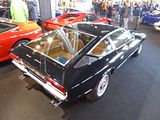
Maserati replaced their entire range in 1981 with the BiTurbo. Introduced initially as a single model, a 2 door coupe with a 2 litre twin-turbo V6 engine, over the next 15 years, it would evolve into a complex range of different models, and three basic bodystyles, as well as the special low-volume Karif and V8 engined Shamal cars. The car was designed by Pierangelo Andreani, Chief of Centro Stile Maserati up to 1981, and was somewhat influenced by the design of the recent Quattroporte III. The BiTurbo marked quite a change of direction for the Modense firm, a consequence of its acquisition by Alejandro de Tomaso in 1976. de Tomaso’s ambitious plans for the marque were to combine the prestige of the Maserati brand with a sports car that would be more affordable than the earlier high-priced models that had traditionally made up the Maserati range. The Biturbo was initially a strong seller and brought Italian prestige to a wide audience, with sales of about 40,000 units, but it quickly became apparent that the quality of the car was way off what the market expected, and the car is not regarded as one of the marque’s better models. Indeed, the Biturbo is number 28 in the BBC book of “Crap Cars” and in 2007 was selected as Time Magazine’s worst car of 1984, although they ranked the Chrysler TC by Maserati as a “greater ignominy”. Between 1987–89 a facelift was phased in, which helped to soften the sharp bodylines. The redesign included a taller and more rounded grille with mesh grille and bonnet, aerodynamic wing mirrors and 15″ disc-shaped alloy wheels, now mounted on 5-lug hubs. Some models received the wraparound bumpers with integral foglights and the deep sills introduced with the 2.24v. In 1991 the entire lineup was restyled for a second time, again by the hand of Marcello Gandini; the design features introduced with the Shamal were spread to the other models. Gandini, the Shamal’s designer, developed an aerodynamic kit that included a unique spoiler at the base of the windscreen hiding the windshield wipers, a rear spoiler, and side skirts. The new two-element headlights used poli-ellypsoidal projectors developed by Magneti-Marelli. Inset in body-colour housings, they flanked a redesigned grille, slimmer and integrated in the bonnet; the 1988 bumpers were adopted by all models. The 15″ disc-shaped alloys were replaced by new 16″ seven-spoke wheels, with a hubcap designed to look like a centerlock nut. The second facelift was referred to as “nuovolook”. The engines underwent change, too. As well as being the first ever production car with a twin-turbocharged engine, it was also the first production car engine with three valves per cylinder. The aluminium 90-degree SOHC V6 engine was roughly based on the 2.0 litre Merak engine, itself based on earlier V8 Formula One Maserati engines, designed by Giulio Alfieri. Because in Italy new cars with engine displacement over 2000 cc were subjected to a 38% value added tax, against 19% on smaller displacement cars, throughout the Biturbo’s production life there were both two-litre models aimed mainly at the domestic market and “export” versions, initially with a 2.5 litre V6. The carburettor 2.5 unit produced 185 hp and 208 lb·ft of torque in North American spec and slightly more elsewhere. Fuel injection was fitted in 1987 raising power to 187 hp. In 1989 the enlarged 2.8 litre engine bumped power to 225 hp and 246 lb·ft of torque for North America and 250 PS for Europe. In 1988, with the coupés being restyled, the Biturbo name was dropped in favour of 222—meaning 2-door, 2-litre engine and 2nd generation. The car carried all the visual clues of Gandini’s first facelift, with a more rounded grille and bonnet, different wing mirrors and rear spoiler. The engine size of the 222 E export model grew from the Biturbo’s 2.5- to 2.8-litres. A mixed velour-leather interior was standard on the domestic models, while export markets got leather upholstery as standard. 1990 saw the arrival of the 2.8 litre 222 SE, heir to the Biturbo ES. It inherited the latter’s limited paint finish availability (red, silver or black) and the dark trim and grille, while modern aprons and side skirts (blacked out as well) came from the 2.24v. After just a year the 222 SE was replaced by the 1991-restyled 222 SR; the SR offered adaptive suspension as an option. Simultaneously the very similar 222 4v. joined the lineup; it was a 222 SR with a 2.8 litre four-valve engine, the first DOHC car in the direct Biturbo E lineage. It used wider, 16″ 7-spoke wheels.
In keeping with Maserati tradition, the Shamal was also named after a wind, in this case a hot summer wind that blows in large areas of Mesopotamia. My favourite of the Biturbo generation Maserati models, it was introduced on 14 December 1989 in Modena, when Maserati president and owner Alejandro de Tomaso showed it to the press, it was the last model announced under the De Tomaso ownership, as in January 1990 half of Maserati was acquired by Fiat S.p.A.. Sales began in 1990. The Shamal was designed by Marcello Gandini, of Bertone fame. Clearly based on the Biturbo, as you can see in the doors, interior, and basic bodyshell, all of which were carried over from the Biturbo. Gandini’s styling signature is visible in the slanted profile of the rear wheel wheel arch, also present on the fourth generation Quattroporte IV and first seen on the Lamborghini Countach. Nonetheless, the Shamal has a look all of its own, with the centre pillar wrapping around the cabin as a roll bar, always finished in black, a distinguishing characteristic of the Shamal. The name “Shamal” appears on either side of the central pillar in chrome lettering. The car has alloy wheels, a small rear spoiler and a blacked-out grille with chrome accents. Another defining feature of the Shamal are its numerous headlamps in individual housings: outer round Carello low beams of the then-new projector type, inner rectangular high beams, combined indicators and position lamps in the bumper, and two pairs of square lights in the lower grille—fog lamps and driving lamps. The two-seat interior of the Shamal features extended leather seat cushions, temperature control and the famous Maserati oval clock, which is situated in the centre of the dashboard. The gear lever is finished in elm. While built for comfort as well as performance, the Shamal was not as luxuriously appointed as the similar Maserati Ghibli II. The Shamal used a traditional front-engine, rear-wheel-drive layout and an all-steel unibody construction. Suspension was by MacPherson struts upfront and semi-trailing arms at the rear. All Shamals were equipped with an adaptive suspension developed by Maserati together with Koni. The system varied the damping rates, based on road conditions and the level of comfort desired. It was powered by an AM 479 3,217 cc square (bore and stroke 80 mm) V8 engine, with two overhead camshafts per bank, and four valves per cylinder. It was twin-turbocharged with two IHI turbines and intercoolers, and equipped with a Marelli IAW integrated electronic ignition and fuel injection ECU per cylinder bank. The engine put out 325 PS at 6,000 rpm and 320 lb·ft at 3,000 rpm. Power was sent to the rear wheels through a six-speed Getrag manual transmission and Maserati’s Ranger limited-slip differential. The manufacturer claimed a top speed of 170 mph and a 0 to 62 mph acceleration time of 5.3 seconds. The final year of production for the Maserati Shamal was 1996 and factory figures indicate that 369 examples were produced.
Final Maserati model that I spotted was the rarely seen third generation Quattroporte. The Tipo AM 330 was developed under the Alejandro de Tomaso-GEPI ownership. After the brief parenthesis of the Citroen-era front-wheel drive Quattroporte II, the third generation went back to the classic formula of rear-wheel drive and large Maserati V8 engine. It was designed by Giorgetto Giugiaro. A pre-production Quattroporte was introduced to the press by Maserati president Alejandro de Tomaso on 1 November 1976, in advance of its début at the Turin Motor Show later that month. It was only three years later though, in 1979, that the production version of the car went on sale. Initially “4porte” badging was used, changed in 1981 to Quattroporte. Two versions of the V8 engine were available: a 4,930 cc one producing 280 PS and a smaller 4,136 cc engine producing 255 PS which was phased out in 1981. The interior was upholstered in leather and trimmed in briar wood. The Quattroporte III marked the last of the hand-built Italian cars; all exterior joints and seams were filled to give a seamless appearance. From 1987 the Royale superseded the Quattroporte, as a built-to-order ultra-luxury version of the Quattroporte. It adopted a higher compression 4.9-litre engine, putting out 300 PS. Besides the usual leather upholstery and veneer trim, the passenger compartment featured a revised dashboard with analogue clock, four electrically adjustable seats, retractable veneered tables in the rear doors and a mini-bar. Visually the Royale was distinguished by new disc-shaped alloy wheels and silver-coloured side sills. De Tomaso announced a limited run of 120 Royales, but when production ceased in 1990 only 53 of them had been made. In all, including the Royale, 2,155 Quattroporte IIIs were produced.
MATRA
To replace the M530, Matra worked in cooperation with the automaker Simca. Designed by the Greek, Antonis Volanis, the new car was marketed as Matra-Simca Bagheera to highlight the link, except for the final production year 1980, when it was re-badged Talbot-Matra Bagheera after Chrysler Europe’s demise and subsequent takeover by PSA. Named after the panther from The Jungle Book, the Bagheera was created using stock Simca components, including the engines, gearbox and suspension elements, but unlike the front wheel drive Simca 1100 and 1307 cars it shared them with, it was a mid-engined car. The Bagheera’s body was made of polyester, mounted on a steel structure. It was formed in the shape of a sleek hatchback, with a rear hatch that allowed access to the engine mounted behind the passenger compartment. There was only one row of seats, but it featured an unusual combination of three abreast, one of the few three-passenger sports cars ever made. When launched in 1973, the Bagheera was only available with a 4 cylinder 1294cc engine. In 1975, the range grew to include a 1442cc version of the same engine. The Bagheera is also notable as one of the few manufacturers in the world to have developed a “U engine” for this vehicle. As Matra engineers believed the Bagheera could use a more powerful unit, they created a unique construction out of two 1.3 litre Simca engines, joined side-by-side by a common pan unit, the two crankshafts being linked by chain. This resulted in a 2.6 litre 8-cylinder unit, producing 168 bhp. However, Chrysler Europe was unwilling to pursue the project due to the developing fuel crises as well as its own financial problems. Thus, the U8-powered Bagheera remained as a prototype and only three units were ever built. In 1976, the Bagheera underwent a major restyling, with basically only the rear hatch unchanged, producing the Bagheera type II. Another change took place in 1978, when the dashboard was replaced again, and in 1979 the Bagheera was given conventional door handles in lieu of the previous “hidden” ones. Production of the Bagheera ended in 1980, when it was replaced by Matra Murena, with 47,802 Bagheeras built in total. Very few Bagheeras remain in existence today, as they suffered badly from quality issues (the Bagheera won the ADAC Silberne Zitrone = “Silver Lemon” award in 1975 for the poorest quality car of that moment) and extensive body rot. Though the polyester panels couldn’t rust, the underlying steel chassis had almost no protection. Matra learned from this and fully galvanised the Bagheera’s successor.
McLAREN
Sole example of the fast=growing Woking-based British marque McLaren was this MP4 12C.
MERCEDES-BENZ
Mercedes-Benz is another of the manufacturers who typically has a very large stand on which they display a handful of rare and historic vehicles from their collection, along with associated brand new products. This year the theme was very much around sporting Mercedes models.
Oldest of these was the Mercedes-Benz W196, a Formula One racing car produced for the 1954 and 1955 F1 seasons. Successor to the W194, in the hands of Juan Manuel Fangio and Stirling Moss it won 9 of 12 races entered and captured the only two world championships in which it competed. Firsts included the use of desmodromic valves and Daimler-Benz developed mechanical direct fuel injection adapted from the DB 601 high-performance V12 used on the Messerschmitt Bf 109E fighter during World War II. The legendary 3-litre 300 SLR (Sport Leicht-Rennen, eng: Sport Light-Racing) was derived from the W196 for the 1955 World Sportscar Championship season. Its crash at Le Mans that year ended not only its own short-lived domination on the WSC circuit but spelled the end also for the W196, as Mercedes pulled out of competitive racing in 1955 and did not return for another three decades.
Next up was a fabulous example of the 300SL GullWing, a model known under development as the W198, the first iteration of the SL-Class grand tourer and fastest production car of its day. Introduced in 1954 as a two-seat coupé with distinctive gull-wing doors, it was later offered as an open roadster. Built by Daimler-Benz AG, the direct fuel injected production model was based on the company’s highly successful yet somewhat less powerful carburettor overhead cam straight 6 1952 racer, the W194. The idea of a toned-down Grand Prix car tailored to affluent performance enthusiasts in the booming post-war American market was suggested by Max Hoffman. Mercedes accepted the gamble and the new 300 SL – 300 for its 3.0 litre engine displacement and SL for Sport Leicht (Sport Light) – was introduced at the 1954 New York Auto Show rather than the Frankfurt or Geneva gatherings company models made their usual debuts. Immediately successful and today iconic, the 300 SL stood alone with its distinctive doors, first-ever production fuel injection, and world’s fastest top speed. Even with the upward opening doors, the 300 SL had an unusually high sill, making entry and exit from the car’s cockpit problematic. A steering wheel with a tilt-away column was added to improve driver access. The 300 SL’s main body was steel, with aluminium bonnet, doors and boot lid. It could also be ordered with an 80 kg (180 lb) saving all-aluminium outer skin at tremendous added cost; just 29 were made. Like the W194, the 300 SL borrowed its 3.0 litre overhead cam straight-6 from the regular four-door 300 (W186 “Adenauer”) luxury tourer introduced in 1951. Featuring an innovative diagonal aluminium head that allowed for larger intake and exhaust valves, it was canted to the right at forty-five-degrees to fit under the SL’s considerably lower bonnet line. In place of the W194’s triple two-barrel Solex carburettors, a groundbreaking Bosch mechanical direct fuel injection was installed, boosting power almost 25% over the Grand Prix car’s. Derived from the DB 601 V12 used on the Messerschmitt Bf 109E fighter of World War II, it raised output from 175 hp to 215 hp, almost double that of the original Type 300 sedan’s 115 hp. An optional, even more powerful version, with radical camshaft developed 240 hp @ 6100 rpm and a maximum torque of 217 lb⋅ft @ 4800 rpm, but was rough for city use. The result was a top speed of up to 260 km/h (160 mph) depending on gear ratio and drag, making the 300 SL the fastest production car of its time. However, unlike today’s electrically powered fuel injection systems, the 300 SL’s mechanical fuel pump would continue to inject gasoline into the engine during the interval between shutting off the ignition and the engine’s coming to a stop; this unburned gasoline washed lubricating oil from the cylinder walls, which not only left them unprotected in affected areas during start-up but would dilute the engine’s entire oil supply if the car was not driven hard or long enough to reach a sufficient temperature to evaporate the fuel out of the oil. Exacerbating the problem was the engine’s large racing-oriented oil cooler and enormous 10 litre oil capacity, which virtually guaranteed the oil would not get hot enough. In practice, many owners would block off airflow through the oil cooler and stick rigidly to the appropriately low 1,000 mile recommended oil change interval. An auxiliary fuel pump provided additional fuel for extended high speed operation or cold starts; overuse would also lead to dilution of the oil., Clutch operation was initially very heavy, remedied by an improved clutch arm helper spring which reduced pedal force. From March 1963 to the end of production later that year, a light alloy crankcase was used on a total of 209 vehicles. Aerodynamics played an important role in the car’s speed, with Mercedes-Benz engineers placing horizontal “eyebrows” over the wheel openings to reduce drag. Unlike many cars of the 1950s, steering was relatively precise and the four-wheel independent suspension allowed for a reasonably comfortable ride and markedly better overall handling. However, the rear swing axle, jointed only at the differential, not at the wheels themselves, could be treacherous at high speeds or on imperfect roads due to extreme changes in camber. The enormous fuel tank capacity also caused a considerable difference in handling depending on the quantity of fuel on board. More than 80% of the vehicle’s total production of approximately 1400 units were sold in the US, making the Gullwing the first Mercedes-Benz widely successful outside its home market and thoroughly validating Hoffman’s prediction. The 300 SL is credited with changing the company’s image in America from a manufacturer of solid but staid luxury automobiles to one capable of rendering high-performance sports cars. It should be noted initial sales were sluggish due to many things, of which the price was one. Initial prices were about $6,400, a new Chevrolet Bel-Air could be purchased for $1,700 in the same year. Then there were few mechanics, even at the dealers, who understood the fuel injection system enough to do repairs. Nonetheless, 1400 were built by 1957, at which point Mercedes introduced a roadster version which was broadly similar, but with conventional doors. It was produced until 1963, and achieved sales of 1858 units.
This is a C111, one of a series of experimental automobiles produced by Mercedes-Benz in the 1960s and 1970s. The company was experimenting with new engine technologies, including Wankel engines, diesel engines, and turbochargers, and used the basic C111 platform as a testbed. Other experimental features included multi-link rear suspension, gull-wing doors and a luxurious interior with leather trim and air conditioning. The first version of the C111 was completed in 1969. The car used a fiberglass body shell and with a mid-mounted three-rotor direct fuel injected Wankel engine (code named M950F). The next C111 appeared in 1970. It used a four-rotor engine producing 350 hp. The car reportedly could reach a speed of 300 km/h (186 mph). The company decided not to adopt the Wankel engine and turned to Diesel experiments for the second and third C111s. The C111-IID produced 140 kW (188 hp) and was based on the 240D 3.0 W115 model OM617 engine. The C111-III was powered by a 228 hp at 4,500 rpm straight-five OM617 turbocharged Diesel that broke nine Diesel and gasoline speed records. With more aerodynamic bodywork that gave it an air drag coefficient of .191,the C111 eventually reached 200 mph (322 km/h) at the Nardò Ring in 1978, and averaged 16.0 liters/100 km at 316 km/h (14.7 mpg at 195.4 mph) over a 12-hour cruise. A later 500 hp 4.8 L twin KKK-turbocharged V8 version set another record, with an average lap-speed of 403.78 km/h (250.958 mph). This was achieved by Hans Leibold in 1 minute, 56.67 seconds on May 5, 1979. Total production was 16 cars: 13 first and second generation Wankel engined cars, 2 diesel engined third generation cars used in the Nardo record attempt, and a single V8 engined fourth generation car.
In 1978, Mercedes-Benz made the decision to expand its efforts in rally competition. But its choice of platform to enter into the World Rally Championship was, to say the least, unique. At the time, the WRC was dominated by small saloons like the Fiat 131 Abarth and Ford Escort RS1800 — cars that finished first and second in the championship that year. Mercedes-Benz took a decidedly different route, as it had no small sporty sedan. What it did have was a large, heavy and expensive personal luxury coupe in the C107 SLC. While the choice would seem unnatural, under the direction of Erich Waxenberger the premier 450SLC was prepared and developed over the next few seasons into a rally winner. For the 1978 rally season, Mercedes-Benz entered what were effectively production 450SLCs into a few world rally events. These cars carried the standard M117 4.5-liter V8 — a single overhead cam, 16-valve 90-degree bank producing 227 bhp. The transmission was unusual for a rally car, as they carried the standard production 722.0 hydraulically controlled three-speed automatic. With little else than some skid plates, extra lights and roll cage protection fitted, these cars were entered into the gruelling Vuelta a la América del Sud — a 30,000 km lap of South America. Matched up against those Fiats, Fords and Africa-conquering Peugeots, the luxurious automatic Mercedes-Benz coupes seems to be at a distinct disadvantage. However, at the hands of Andrew Cowan, who would later go on to start Mitsubishi’s Ralliart race team, the big coupe won the event. Co-driving in Timo Mäkinen’s 450SLC was none other than Jean Todt, future Ferrari F1 director and FIA President. Video exists of the cars competing in 1978. While the standard 450SLC had proved unexpectedly triumphant, Mercedes-Benz was hard at work on a much improved model. Alongside the production M117 4.5s, Mercedes-Benz decided to up the ante on the rally effort with the introduction of the increased-capacity 5.0 M117. Now the the suffix E50, power increased to a reported 290-310, and the 5.0 ran in FIA Group 4 competition for the 1979, 1980 and (briefly) 1981 seasons. In order to help curb the substantial weight of the 107 chassis, aluminium doors, hood and trunk lid were produced for the 5.0. The 5.0s gained large black flares, some housing wider BBS RA light alloy wheels, instead of the standard Bundt alloys found on early cars. To order to conform to FIA Group 4 rules, the engine was destroked from the production 5,025 cc to 4,973 cc. Unlike previous Mercedes V8 blocks, this one was all aluminium to help reduce weight. Mercedes-Benz had to homologate the car in order to race, so the company created the C107.026. Ultimately, the company built 2,769 examples of the 450SLC and later 500SLC, but for 1978 the rules necessitated the production of at least 400 examples. These were obviously detuned compared to the race cars, but still packed a respectable 240 horsepower. As with the race cars, they featured aluminium bodywork to reduce weight. The automaker also had spoilers fitted, which was judged by some to be a bit shocking for the typical flagship Mercedes-Benz buyer of the time. (The owner could opt out of the spoiler, but doing so would also remove the aluminium bootlid and fit a standard steel unit in its place.) Mercedes-Benz claimed the use of aluminium cut 125 pounds off the curb weight. At the hands of Hannu Mikkola, the 450SLC 5.0 would win the Rallye Côte d’Ivoire and came second in the Safari Rally. Mikkola would ultimately place second in the World Rally Driver’s Championship for 1979, in part thanks to the 450SLC 5.0, and the 5.0 would continue to place in world rally events in 1980, finishing third at Rally Safari in the hands of Vic Preston, Jr. For the 1980 and 1981 seasons, Waxenberger once again turned the wick up on the C107. Now called the 500SLC, the C107 was moved to Group 2 – Touring Cars, as opposed to the Group 4 “Special Touring Cars”. This was allowed because over 1,000 units had been produced. The M117 was now over 300 hp, with Mercedes-Benz claiming an output of 329 hp by the end of the run. The biggest change between the 450SLC 5.0 and the 500SLC was the switch from the three-speed automatic used in ’78 and ’79 to a new four-speed unit. It also coincided with a nomenclature change at Mercedes-Benz, resulting in a 5.0 V8 for normal series production. However, while it shared the same M117 engine designation as the 450SLC 5.0, the internal structure of the engine was changed for larger-scale production. The 500SLC went 1-2 at the 1980 Bandama (Ivory Coast) Rally with Scandanavians Björn Waldegård and Jorge Recalde, and with Mikkola driving finished second at the Rally Codasur (Argentina) and third in New Zealand. These results contributed to a fourth-place overall standing for the SLC in the WRC. In the ultimate development of the 107 chassis, Waxenberger proposed a move to the much shorter (and lighter) SL platform. With the +2 taken out of the equation, the shorter wheelbase allowed for better response in cornering. As with the SLC, the 500SL carried a 722.2 four-speed automatic. To lighten the car, the windows were all replaced with lexan, while the roll cage material was changed to aluminum. A large, high-rise handbrake was fitted in front of the plastic Recaro racing seats to help rotate the big Benz. That rotation would be assisted by new drivers Walter Röhrl (the standing WRC Driver’s Champion that year) and Ari Vatanen for the 1981 season, which looked like it had the potential to be dominated by the big converted convertible. The only problem was funding. Daimler-Benz’s board called on Waxenberger to justify the budget, then promised only to deliver enough funds to run one car. Waxenberger, in a bold move, said he’d rather not run at all than only run one car and left the meeting. His wish was granted; funding to the rally program was cut for the 1981 season, leaving the ultimate development of the 500SL stillborn. The company hasn’t forgotten the project, though, as the 500SL rally has recently appeared in a promotional video of the bellowing convertible rally car sliding through the desert, and one of the four prototypes was crashed at the Goodwood Festival of Speed with Roland Asch at the wheel during a demonstration run. In what may be an even more unusual twist of the racing heritage of the SLC, in 1978 Affalterbach-based AMG Motorenbau GmbH entered a variant of the 450 into the European Touring Car Championship in Group 4 (and later, Group 2). Competing against the likes of the Alpina-built BMW 635CSi, Luigi BMW 3.0CSLs, Zakspeed Ford Escorts, Speiss Volkswagen Sciroccos, Eggenberger-run 320is and some trick Audi 80 GTE full works cars, the privateer entrant seemed out of place and outclassed. In short, all of them were lighter, but not more powerful. AMG took the standard 4,520 cc M117 V8 and managed to massage it to a claimed 390 horsepower for the 1980 season. Massive 11-inch wide BBS magnesium wheels were barely contained under the hugely custom flared arches, and the entire chassis was lowered several inches. However, as no manual transmission had been homologated with the 450SLC, AMG was forced to retain the standard 722 three-speed automatic! This left the heavy Mercedes again at a disadvantage to the much lighter manual Audi, BMW and Mazda entrants. However, the AMG SLC once again showed the legendary Mercedes-Benz legacy for engineering prowess on its way out. At the Nürburgring Nore in June 1980, the SLC triumphed — a four-hour war of attrition saw the sole Mercedes-Benz (in the hands of Clemens Schickentanz and Jörg Denzel) emerge as the winner. It was the only time a C107 would win in the European Touring Car Championship, but it pointed the tri-star towards a return to circuit racing and an end to its self-imposed ban following the 1955 Le Mans crash.
There was also a 190E 2.5-16 here.
Rather more recent cars in the display were the AMG GT GT3 race car and the new AMG C63S Coupe.
Elsewhere in the show were lots of other Mercedes models. Among there were further representatives of the 300SL, in Cabrio guise.
This may look like a pre-war car, but in fact Mercedes produced it, the W136 or 170 right up to 1955. Launched in 1936, it soon became Mercedes’ top-selling model, with over 75,000 made by 1939. Enough of the W136’s tooling survived Allied bombing during World War II (or could be recreated post-war) for it to serve as the foundation upon which the company could rebuild. By 1947 the model 170 V had resumed its place as Mercedes’ top-seller, a position it held until 1953. Most of the cars produced, and an even higher proportion of those that survive, were two or four door “Limousine” (saloon) bodied cars, but the range of different body types offered in the 1930s for the 170 V was unusually broad. A four-door “Cabrio-Limousine” combined the four doors of the four door “Limousine” with a full length foldaway canvas roof. Both the foor door bodies were also available adapted for taxi work, with large luggage racks at the back. There was a two-door two seater “Cabriolet A” and a two-door four seater “Cabriolet B” both with luggage storage behind the seats and beneath the storage location of the hood when folded (but without any external lid for accessing the luggage from outside the car). A common feature of the 170 V bodies was external storage of the spare wheel on the car’s rear panel. The two seater roadster featured a large flap behind the two seats with a thinly upholstered rear partition, and which could be used either as substantial luggage platform or as a very uncomfortable bench – the so-called mother-in-law’s seat. In addition to the wide range of passenger far bodied 170 Vs, a small commercial variant was offered, either as a flatbed truck or with a box-body on the back. Special versions of the 170 V were offered, adapted for use as ambulances or by the police, mountain rescue services and military. Production restarted in May 1946. The vehicles produced were versions of the 170 V, but in 1946 only 214 vehicles were produced and they were all light trucks or ambulances. Passenger car production resumed in July 1947, but volumes were still very low, with just 1,045 170 Vs produced that year. There was no return for the various open topped models from the 1930s. Customers for a Mercedes-Benz 170 V passenger car were restricted to the four door “Limousine” sedan/saloon bodied car. Production did ramp up during the next couple of years, and in 1949 170 V production returned to above 10,000 cars. From May 1949 the car, badged in this permutation as the Mercedes-Benz 170D, was offered with an exceptionally economical 38 PS diesel engine. The 170D was the world’s third diesel fuelled passenger car, and the first to be introduced after the war. A number of updates were made in 1950 and 1952, with more modern and more powerful engines among the changes, but with the appearance of the new Ponton bodied Mercedes-Benz 180 in 1953, the 170 models suddenly appeared very old fashioned. The 170 V was delisted in September 1953: in July 1953 the manufacturer had replaced the existing 170 S with the reduced specification 170 S-V. The car that resulted combined the slightly larger body from the 170 S with the less powerful 45 PS engine that had previously powered the 170 V. The vehicle provided reduced performance but at a reduced price, while salesmen steered more prosperous buyers to the new Ponton bodied 180. The diesel powered 170 S continued to be sold, now branded as the 170 S-D. The internal “W191” designation which had distinguished the previous 170 Ss was removed, and the 170 Ss manufactured from 1953 returned to the “W136” works designation that they had shared with the 170 V till the end of 1951. In September 1955 the last Mercedes-Benz W136, the Mercedes-Benz 170 S was withdrawn from production.
Follow on to the W136 model was the “Ponton”, of which this 220S is a 1957 example, and the staple of Mercedes’ range in the 1950s. The Ponton was Daimler-Benz’s first totally new Mercedes-Benz series of passenger vehicles produced after World War II. In July 1953, the cars replaced the pre-war-designed Type 170 series and were the bulk of the automaker’s production through 1959, though some models lasted through 1962. The nickname comes from the German word for “pontoon” and refers to one definition of pontoon fenders — and a postwar styling trend, subsequently called ponton styling. A bewildering array of models were produced, with a mixture of 180 four and 220 six cylinder engines, with Mercedes W numbers of W120 for the 4 cylinder cars, and W180 for the 220s, as well as W105 for the little known or seen 219, a six cylinder model with a smaller engine. Mercedes introduced fuel injection to the 220 model in 1958, creating the W128 220SE, and the company was rare among car makers in the 50s in offering a diesel engine, so 180D models were also offered. As well as the regular saloon models, there were Coupe and Cabriolet models which are very highly prized (and priced) these days. The 190SL roadster was closely related under the skin, despite its 300SL Gullwing like looks.
There was a 190SL present as well. Produced between May 1955 and February 1963, having first been seen in prototype at the 1954 New York Auto Show, this was designed as a more affordable sports car than the exclusive and rather pricey 300SL, sharing its basic styling, engineering, detailing, and fully independent suspension. While both cars had double wishbones in front and swing axles at the rear, the 190 SL did not use the 300 SL’s purpose-built W198 tubular spaceframe. Instead, it was built on a shortened monocoque R121 platform modified from the W120 saloon. The 190 SL was powered by a new, slightly oversquare 105 PS Type M121 1.9 litre four cylinder engine. Based on the 300 SL’s straight six, it had an unchanged 85 mm bore and 4.3 mm reduced 83.6 mm stroke, was fitted with twin-choke dual Solex carburettors, and produced 120 gross hp. In detuned form, it was later used in the W120 180 and W121 190 models. Both the 190 SL and the 300 SL were replaced by the Mercedes-Benz 230SL in 1963.
Chronologically, next up was a W111 “FinTail”, the staple of the Benz range through the early 1960s. Mercedes-Benz had emerged from World War II in the early 1950s with the expensive 300 Adenauers and the exclusive 300SL grand tourers that gained it fame, but it was the simple unibody Pontons which comprised the bulk of the company’s revenues. Work on replacing these cars began in 1956 with a design focused on passenger comfort and safety. The basic Ponton cabin was widened and squared off, with a large glass greenhouse improving driver visibility. A milestone in car design were front and rear crumple zones for absorbing kinetic energy on impact. The automaker also patented retractable seatbelts. Series production of the first of the new cars, the W111 4-door sedan began in August 1959, with the car making its debut at the Frankfurt Auto Show in autumn. Initially the series consisted of the 220b, 220Sb, and 220SEb. These replaced the 219 W105, the 220S W180 and the 220SE W128 Ponton sedans respectively. The 220b was an entry-level version with little chrome trim, simple hubcaps, and basic interior trim that lacked pockets on doors. Prices were DM16,750, 18,500 and 20,500, with a rough sales ratio of 1:2:1. All modes shared the 2195 cc straight-six engine carried over from the previous generation, producing 95 hp and capable of accelerating the heavy car to 160 km/h. The 220Sb featured twin carburettors and produced 110 hp raising top speed to 103 mph and improving 0–100 km/h acceleration to 15 seconds. The top range 220SEb featured Bosch fuel injection producing 120 hp at 4800 rpm, with top speed of 107 mph and a 0–100 km/h in 14 seconds. In 1961, the W111 chassis and body were shared with the even more basic 4-cylinder W110 and a luxury version built on the W111 chassis with its body and the 3-litre M189 big block 6-cylinder engine, many standard power features, and a high level of interior and exterior trim, was designated the W112. A 2-door coupe/cabriolet version of the W111/W112 was also produced. In summer 1965, the new Mercedes-Benz W108 sedan was launched and production of the first generation of W111’s was ended. Totals were: 220b – 69,691, 220Sb – 161,119, and 220SEb – 65,886. Earlier that year, Mercedes-Benz gave its budget-range W110 series a major facelift, opting to continue producing the W111 as a new model 230S. The previously 4-cylinder W110 received a 6-cylinder, practically identical in terms of chassis and drivetrain. In 1965 the W110 was equipped with a six-cylinder engine, creating the model 230. The 230S, became a flagship model of the Mercedes passenger cars (predecessors to today’s S-class). The 230S was visually identical to the 220S, with a modernised 2306 cc M180 engine with twin Zenith carburettors producing 120 hp.In this final configuration a total of 41,107 cars were built up to January 1968, when the last of 4-door fintails left the production line. Between 1959 and 1968 a total of 337,803 W111s were built.
The Mercedes range of the 1960s was quite complex, with body styles and mechanical updates proceeding at a different rate, and even by referring to the cars by their internal development codes (the “W” number), they are still quite hard to define unambiguously. In the W111 family, the Coupe was the first to appear, a replacement for the two-door W120 “Ponton” models, and work on it began in 1957. Since most of the chassis and drivetrain were to be unified with the sedan, the scope was focused on the exterior styling. Some of the mockups and prototypes show that Mercedes-Benz attempted to give the two-door car a front styling almost identical to what would be realised in the Pagoda (W113), but ultimately favoured the work of engineer Paul Bracq. The rear featured small tailfins, subtle compared to the fintails’ and evocative of the later squarish styling of the W108/W109. Production began in late 1960, with the coupe making its debut at the 75th anniversary of the opening of Mercedes-Benz Museum in Stuttgart in February of the next year. The convertible followed at the Frankfurt Auto Show a few months later. Almost identical to the coupe, its soft-top roof folded into a recess behind the rear seat and was covered by a tightly fitting leather “boot” in the same colour as the seats. Unlike the previous generation of two-door ponton series, the 220SE designation was used for both the coupe and convertible; both received the same version of the 2195 cc M127 engine. Options included a sliding sunroof for the coupe, automatic transmission, power steering, and individual rear seats. In March 1962, Mercedes-Benz released the exclusive two-door M189-powered 300SE. Like the 300 sedan, it was based on the W111 chasis but shared both Daimler’s top-range 2996 cm3 fuel-injected engine and the unique W112 chassis designation, efforts on Mercedes’ part to distance it from the maker’s modest W110 and W111 lineups and link it to the prestigious W188 300S two-door luxury sports tourer. It was distinguished by a chrome strip, and featured air suspension and a higher level of interior trim and finish. In summer of 1965, Mercedes-Benz launched replacements for both W111 and W112 sedans, the W108 and W109 respectively. With the tailfin fashion well eroded by the mid 1960s, the new design was based on the restrained W111 coupe, widened and squared off. Work on a future new chassis that would fully replace the Ponton-derived W111/W112 and W108/W109 was well under way. With a concept car of the first S-Class shown in 1967, Daimler declined to develop a two-door W108/W109 vehicle, instead continuing production of the aging W111/W112 with modest changes. The 220SE was superseded in early autumn 1965 by the 250SE, which featured the new 2496 cm3 M129 engine. Producing 150 hp. it gave the vehicle a significant improvement in top speed, to 120 mph. Visibly the only changes affected the new 14-inch rims, which came with new hub cabs and beauty rings accommodating the larger disk brakes and new rear axle from the W108 family. In November 1967 the 250 SE was superseded by the 280 SE. It was powered by the new 2778 cc M130 engine, which produced 160 hp. The top speed was hardly affected, but acceleration improved to 10.5 seconds. Inside the car received a wood veneer option on the dashboard and other minor changes, including door lock buttons and different heater levers. The hubcaps were changed yet again to a new one piece wheelcover, and the exterior mirror was changed. Despite its smaller engine, the 280 SE could outperform the early 1950s M189 powered 300 SE, resulting in the more expensive model’s retirement. The coupe and cabriolet retained their shared model model designation until replaced by a new-generation chassis in 1968. A final model was added in August 1969, the 280 SE 3.5. The car was fitted with the brand-new M116 3499 cc V8. It produced 200 hp, and had a top speed of 130 mph and a 0-100 km/h at 9.5 seconds. To accommodate the large engine, the car’s front grille was widened; front and rear bumpers were also modified with the addition of rubber strips. The rear lenses changed to a flatter cleaner design. This change was carried across the standard 280 SE. As the top of its range, the 280 SE 3.5 is seen as an ideological successor to the W112 300 SE, though it lacked the W112’s air suspension. The last 280 SE was produced in January 1971, with the 280 SE 3.5 ending in July. The total production over the decade was: 220 SEb – 16,902, 250 SE – 6,213, 280 SE – 5,187, and 280 SE 3.5 – 4,502 units. Not including 3,127 W112 300 SE models, the grand total of 2-door W111 models was 32,804 of which 7,456 were convertibles. These days the cars are much sought after and prices, especially for the convertible, are high and still rising.
Rather better known are the “Pagoda” series of W113 cars and from that highly desirable range were a number of cars encompassing one of each of the three variants offered. By 1955, Mercedes-Benz Technical Director Prof. Fritz Nallinger and his team held no illusions regarding the 190 SL’s lack of performance, while the high price tag of the legendary 300 SL supercar kept it elusive for all but the most affluent buyers. Thus Mercedes-Benz started evolving the 190 SL on a new platform, model code W127, with a fuel-injected 2.2 litre M127 inline-six engine, internally denoted as 220SL. Encouraged by positive test results, Nallinger proposed that the 220SL be placed in the Mercedes-Benz program, with production commencing in July 1957. However, while technical difficulties kept postponing the production start of the W127, the emerging new S-Class W112 platform introduced novel body manufacturing technology altogether. So in 1960, Nallinger eventually proposed to develop a completely new 220SL design, based on the “fintail” W 111 sedan platform with its chassis shortened by 11.8 in, and technology from the W112. This led to the W113 platform, with an improved fuel-injected 2.3 litre M127 inline-six engine and the distinctive “pagoda” hardtop roof, designated as 230 SL. The 230 SL made its debut at the prestigious Geneva Motor Show in March 1963, where Nallinger introduced it as follows: “It was our aim to create a very safe and fast sports car with high performance, which despite its sports characteristics, provides a very high degree of travelling comfort”. The W113 was the first sports car with a “safety body,” based on Bela Barényi’s extensive work on vehicle safety: It had a rigid passenger cell and designated crumple zones with impact-absorbing front and rear sections built into the vehicle structure. The interior was “rounded,” with all hard corners and edges removed, as in the W111 sedan. Production of the 230 SL commenced in June 1963 and ended on 5 January 1967. Its chassis was based on the W 111 sedan platform, with a reduced wheelbase by 11.8 in, recirculating ball steering (with optional power steering), double wishbone front suspension and an independent single-joint, low-pivot swing rear-axle with transverse compensator spring. The dual-circuit brake system had front disc brakes and power-assisted rear drum brakes. The 230 SL was offered with a 4-speed manual transmission, or an optional, very responsive fluid coupled (no torque converter) 4-speed automatic transmission, which was popular for US models. From May 1966, the ZF S5-20 5-speed manual transmission was available as an additional option, which was particularly popular in Italy. The 2,308 cc M127.II inline-six engine with 150 hp and 145 lb/ft torque was based on Mercedes-Benz’ venerable M180 inline-six with four main bearings and mechanical Bosch multi-port fuel injection. Mercedes-Benz made a number of modifications to boost its power, including increasing displacement from 2,197 cc, and using a completely new cylinder head with a higher compression ratio (9.3 vs. 8.7), enlarged valves and a modified camshaft. A fuel injection pump with six plungers instead of two was fitted, which allowed placing the nozzles in the cylinder head and “shooting” the fuel through the intake manifold and open valves directly into the combustion chambers. An optional oil-water heat exchanger was also available. Of the 19,831 230 SLs produced, less than a quarter were sold in the US. Looking identical, the 250 SL was introduced at the 1967 Geneva Motor Show. Production had already commenced in December 1966 and ended in January 1968. The short one-year production run makes the 250 SL the rarest of the W113 series cars. The 250 SL retained the stiffer suspension and sportier feel of the early SLs, but provided improved agility with a new engine and rear disc brakes. Range also improved with increased fuel tank capacity from 65 litres to 82. Like its predecessor, the 250 SL was offered with a 4-speed automatic transmission, and 4-speed or ZF 5-speed manual transmissions. For the first time, an optional limited slip differential was also available. The main change was the use of the 2,496 cc M129.II engine with a larger stroke, increased valve ports, and seven main bearings instead of four. The nominal maximum power remained unchanged at 150 hp, but torque improved from 145 lb/ft to 159 lb/ft. Resiliency also improved with a new cooling water tank (“round top”) with increased capacity and a standard oil-water heat exchanger. The 250 SL also marked the introduction of a 2+2 body style, the so-called “California Coupé”, which had only the removable hardtop and no soft-top: a small fold-down rear bench seat replaced the soft-top well between passenger compartment and boot. It is estimated that only 10% of the 250SLs that were brought into America were California Coupes. Of the 5,196 250 SLs produced, more than a third were sold in the US.The 280 SL was introduced in December 1967 and continued in production through 23 February 1971, when the W 113 was replaced by its successor, the entirely new and substantially heavier R107 350 SL. The main change was an upgrade to the 2,778 cc M130 engine with 170 hp and 180 lb/ft, which finally gave the W 113 adequate power. The performance improvement was achieved by increasing bore by 4.5 mm (0.2 in), which stretched the limits of the M180 block, and required pairwise cylinder casts without cooling water passages. This mandated an oil-cooler, which was fitted vertically next to the radiator. Each engine was now bench-tested for two hours prior to being fitted, so their power specification was guaranteed at last. The M130 marked the final evolution of Mercedes-Benz’ venerable SOHC M180 inline-six, before it was superseded by the entirely new DOHC M110 inline-six introduced with R107 1974 European 280 SL models. For some time, it was also used in the W 109 300 S-Class, where it retired the expensive 3 liter M189 alloy inline-six. Over the years, the W 113 evolved from a sports car into a comfortable grand tourer, and US models were by then usually equipped with the 4-speed automatic transmission and air conditioning. Manual transmission models came with the standard 4-speed or the optional ZF 5-speed, which was ordered only 882 times and thus is a highly sought-after original option today. In Europe, manual transmissions without air conditioning were still the predominant choice. Of the 23,885 280 SLs produced, more than half were sold in the US.
Sometimes known as the “New Generation”, to distinguish it from predecessor with the same model names, this is an example of the W114/115 range of cars that Mercedes introduced in 1968, which were produced until 1976 when they were replaced by the W123 range. W114 models featured six-cylinder engines and were marketed as the 230, 250, and 280, while W115 models featured four-cylinder engines and were marketed as the 200, 220, 230, and 240. All were styled by Paul Bracq, featuring a three-box design. At the time, Mercedes marketed saloons in two size classes, with the W114/W115, positioned below the Mercedes-Benz S-Class. The W114/W115 models were the first post-war Mercedes-Benz production car to use a newly engineered chassis, not derived from preceding models. The new chassis format of semi-trailing rear arms and ball-joint front end first displayed in the W114/W115 chassis would be used in all new Mercedes passenger car models until the development of the multi-link rear suspensions of the 1980s. The W108/109 S-Class chassis of the 280S/8, 280SE/8 and 300SEL/8 (and W113 280SL Pagoda) would be the last of the low-pivot swing axle and king pin/double wishbone front ends. The next S-Class -the W116 chassis- having the same engineering of the W114/115. Mercedes introduced a coupé variant of the W114 in 1969, featuring a longer boot and available with either a 2.5 or 2.8 litre six-cylinder engine. While a classic and understated design these generally cost less than the W113-based 280 SL model that ran through 1971, and its successor, the 3.5 or 4.5 litre V8 Mercedes SL R107/C107 (1971–1989) roadster and coupé. While a ‘hard-top’ unlike the fully convertible SL, the pillarless design allowed all the windows to be lowered completely for open air motoring. Only 67,048 coupés were manufactured from 1969 to 1976 (vs. 1.852,008 saloons). Of these 24,669 were 280C and 280CE (top of the range), and 42,379 were the lesser 250C and 250CE (A Mercedes-Benz 220D pickup on the W115 chassis was produced briefly in Argentina in the 1970s.) The W114 received a facelift in 1973 – with a lower bonnet-line, lower and broader grill, a single front bumper to replace the double bumpers, lower placement of the headlamps, A-pillar treatment for keeping the side windows clear, removal of the quarter-windows in the front doors, ribbed tail lights to minimise occlusion of the tail lights with road dirt, and larger side mirrors. The interior received inertia reel belts and a new padded steering wheel with a four-hole design. These cars were known to be extremely durable and tough, so the survival rate is quite great, especially in Germany, where they are popular classics.
With prices of the classic Pagoda model having risen to unaffordable for most people attention has started to switch to it successor, the R107 SL range, which had a long production life, being the second longest single series ever produced by the automaker, after the G-Class. The R107 and C107 took the chassis components of the mid-size Mercedes-Benz W114 model and mated them initially to the M116 and M117 V8 engines used in the W108, W109 and W111 series. The SL variant was a 2-seat convertible/roadster with standard soft top and optional hardtop and optional folding seats for the rear bench. The SLC (C107) derivative was a 2-door hardtop coupe with normal rear seats. The SLC is commonly referred to as an ‘SL coupe’, and this was the first time that Mercedes-Benz had based a coupe on an SL roadster platform rather than on a saloon, replacing the former saloon-based 280/300 SE coupé in Mercedes lineup. The SLC was replaced earlier than the SL, with the model run ending in 1981, with a much larger model, the 380 SEC and 500SEC based on the new S class. Volume production of the first R107 car, the 350 SL, started in April 1971 alongside the last of the W113 cars; the 350 SLC followed in October. The early 1971 350SL are very rare and were available with an optional 4 speed fluid coupling automatic gearbox. In addition, the rare 1971 cars were fitted with Bosch electronic fuel injection. Sales in North America began in 1972, and cars wore the name 350 SL, but had a larger 4.5L V8 with 3 speed auto (and were renamed 450 SL for model year 1973); the big V8 became available on other markets with the official introduction of the 450 SL/SLC on non-North American markets in March 1973. US cars sold from 1972 through 1975 used the Bosch D Jetronic fuel injection system, an early electronic engine management system. From July 1974 both SL and SLC could also be ordered with a fuel-injected 2.8L straight-6 as 280 SL and SLC. US models sold from 1976 through 1979 used the Bosch K Jetronic system, an entirely mechanical fuel injection system. All US models used the 4.5 litre engine, and were called 450 SL/SLC. In September 1977 the 450 SLC 5.0 joined the line. This was a homologation version of the big coupé, featuring a new all-aluminium five-litre V8, aluminium alloy bonnet and boot-lid, and a black rubber rear spoiler, along with a small front-lip spoiler. The 450SLC 5.0 was produced in order to homologate the SLC for the 1978 World Rally Championship. Starting in 1980, the 350, 450 and 450 SLC 5.0 models (like the 350 and 450 SL) were discontinued in 1980 with the introduction of the 380 and 500 SLC in March 1980. At the same time, the cars received a very mild makeover; the 3-speed automatic was replaced by a four-speed unit, returning to where the R107 started in 1971 with the optional 4 speed automatic 350SL. The 280, 380 and 500 SLC were discontinued in 1981 with the introduction of the W126 series 380 and 500 SEC coupes. A total of 62,888 SLCs had been manufactured over a ten-year period of which just 1,636 were the 450 SLC-5.0 and 1,133 were the 500 SLC. Both these models are sought by collectors today. With the exception of the SL65 AMG Black Series, the SLC remains the only fixed roof Mercedes-Benz coupe based on a roadster rather than a sedan. Following the discontinuation of the SLC in September 1981, the 107 series continued initially as the 280, 380 and 500 SL. At this time, the V8 engines were re-tuned for greater efficiency, lost a few hp and consumed less fuel- this largely due to substantially higher (numerically lower) axle ratios that went from 3.27:1 to 2.47:1 for the 380 SL and from 2.72:1 to 2.27:1 for the 500 SL. From September 1985 the 280 SL was replaced by a new 300 SL, and the 380 SL by a 420 SL; the 500 SL continued and a 560 SL was introduced for certain extra-European markets, notably the USA, Australia and Japan. Also in 1985, the Bosch KE Jetronic was fitted. The KE Jetronic system varied from the earlier, all mechanical system by the introduction of a more modern engine management “computer”, which controlled idle speed, fuel rate, and air/fuel mixture. The final car of the 18 years running 107 series was a 500 SL painted Signal red, built on August 4, 1989; it currently resides in the Mercedes-Benz museum in Stuttgart.
Mercedes-Benz introduced the W123 four-door versions on 29 January 1976. While there were some technical similarities to their predecessors, the new models were larger in wheelbase and exterior dimensions. The styling was also updated, although stylistic links with the W114 / W115 were maintained. Initially, all models except 280/280E featured quad unequal-size round headlights and the latter large rectangular units. When facelifted, these units became standard across the range. All W115 engines were carried over, with the 3-litre 5-cylinder diesel model being renamed from “240D 3.0” to “300D” (as it had already been called before in North American markets). The only new engine was the 250’s 2,525 cc inline-six (Type M123, a short-stroke version of the 2.8-litre six Type M110) that replaced the old 2,496 cc Type M114 “six”. In the spring of 1976, a Coupé version was introduced on a shorter wheelbase than the saloon (106.7 in versus 110.0 in. This W123C/CE was available as a 230C (later 230CE) and as a 280C/CE in most markets; in North America there were additional 300CD versions with naturally aspirated, later turbocharged 3-litre diesel engines. In North America, buyers favored diesel engines for upmarket cars, while CAFE legislation meant that Mercedes-Benz North America had to lower their corporate average fuel economy. This led to the introduction of a few diesel models only sold in the United States. It is a tribute to the car’s instant popularity – and possibly to the caution built into the production schedules – that nine months after its introduction, a black market had developed in Germany for Mercedes-Benz W123s available for immediate delivery. Customers willing to order new cars from their local authorised dealer for the recommended list price faced waiting times in excess of twelve months. Meanwhile, models that were barely used and were available almost immediately commanded a premium over the new price of around DM 5,000. From August 1976, long-wheelbase versions (134.8 in) were produced. These were available as 7/8 seater saloons with works bodies or as a chassis with complete front body clip, the latter serving as the base for ambulance and hearse bodies by external suppliers like Binz or Miesen. These “Lang” versions could be ordered as 240D, 300D and 250 models. At the Frankfurt Auto Show in September, 1977 the W123T estate was introduced; the T in the model designation stood for “Touring and Transport”. All engines derivative except “200TD” were available in the range. T production began in March, 1978 in Mercedes’ Bremen factory. It was the first factory-built Mercedes-Benz estate, previous estates had been custom-built by external coachbuilders, such as Binz. In early 1979, the diesel models’ power output was increased; power rose from 54 hp to 59 hp in the 200D, from 64 hp to 71 hp in the 240D and from 79 hp to 87 hp in the 300D; at the same time, the 220D went out of production. The first Mercedes turbo diesel production W123 appeared in September, 1981. This was the 300 TD Turbodiesel, available with automatic transmission only. In most markets, the turbocharged 5-cylinder 3-litre diesel engine (Type OM617.95) was offered only in the T body style, while in North America it was also available in saloon and coupé guises. June 1980 saw the introduction of new four-cylinder petrol engines (Type M102). A new 2-litre four with shorter stroke replaced the old M115, a fuel-injected 2.3-litre version of this engine (in 230E/TE/CE) the old carburettor 230. Both engines were more powerful than their predecessors. In 1980/81, the carburettor 280 versions went out of production; the fuel-injected 280E continued to be offered. In September 1982, all models received a mild facelift. The rectangular headlights, previously fitted only to the 280/280E, were standardised across the board, as was power steering. Since February 1982, an optional five-speed manual transmission was available in all models (except the automatic-only 300 turbodiesel). W123 production ended in January, 1986 with 63 final T-models rolling out. Most popular single models were the 240D (455,000 built), the 230E (442,000 built), and the 200D (378,000 built). The W123 introduced innovations including ABS (optional from August, 1980), a retractable steering column and an airbag for the driver (optional from 1982). Power (vacuum servo) assisted disc brakes were standard on all W123s. Available options included MB-Tex (Mercedes-Benz Texturized Punctured Vinyl) upholstery or velour or leather upholstery, interior wood trim, passenger side exterior mirror (standard on T models), 5-speed manual transmission (European market only), 4-speed automatic transmission (standard in turbodiesel models), power windows with rear-seat switch cut-outs, vacuum powered central locking, rear-facing extra seats (estate only), Standheizung (prestart timer-controlled engine heating), self-locking differential, sun roof, air conditioning, climate control, “Alpine” horn (selectable quieter horn), headlamp wipers (European market only), Tempomat (cruise control), power steering (standard after 1982/08), seat heating, catalytic converter (available from 1984 for California only, from fall (autumn) 1984 also in Germany for the 230E of which one thousand were built). These days, the cars are very popular “youngtimer” classics, with all models highly rated.
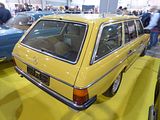
Final Mercedes of note was a 190E 2.5 16 Evo car from the late 80s.
MG
The post-war TC sports car – a continuation of a model announced just before the start of hostilities – proved particularly popular with Americans who took the majority of production. It was replaced in 1950 by the TD, which combined the TC’s drivetrain, a modified hypoid-geared rear axle, the MG Y-type chassis, a familiar T-type style body and independent suspension using coil springs from the MG Y-type saloon. A 1950 road-test report described as “most striking” the resulting “transformation … in the comfort of riding”. Also lifted from the company’s successful 1¼-litre YA saloon for the TD was the (still highly geared) rack and pinion steering. In addition the TD featured smaller 15-inch disc type road wheels, a left-hand drive option and standard equipment bumpers and over-riders. The car was also 5 inches wider with a track of 50 inches. For the driver the “all-weather protection” was good by the standards of the time. For night driving, instrument illumination was “effective but not dazzling, by a pale green lighting effect”. There was still no fuel gauge, but the 12 gallon tank capacity gave a range between refuelling stops of about 300 miles and a green light on the facia flashed a “warning” when the fuel level was down to about 2½ gallons. In 1950 the TD MkII Competition Model was introduced, produced alongside the standard car, with a more highly tuned engine using an 8.1:1 compression ratio giving 57 bhp at 5,500 rpm. The higher compression ratio engine was offered with export markets in mind, and would not have been suitable for the UK, where thanks to the continued operation of wartime fuel restrictions, buyers were still limited to 72 octane “Pool petrol”. The TD MkII also featured twin fuel pumps, additional Andrex dampers, and a higher ratio rear-axle. Nearly 30,000 TDs had been produced, including about 1700 Mk II models, when the series ended in 1953 with all but 1656 exported, 23,488 of them to the US alone.
The MGA replaced the long running T Series sports cars and presented a complete styling break from MG’s earlier sports cars. Announced on 26 September 1955, the car was officially launched at the Frankfurt Motor Show. A total of 101,081 units were sold through the end of production in July 1962, the vast majority of the 58.750 cars made were exported. Only 5869 cars were sold on the home market, the lowest percentage of any British car. It was replaced by the MGB. The MGA design dates back to 1951, when MG designer Syd Enever created a streamlined body for George Philips’ TD Le Mans car. The problem with this car was the high seating position of the driver because of the limitations of using the TD chassis. A new chassis was designed with the side members further apart and the floor attached to the bottom rather than the top of the frame sections. A prototype was built and shown to the BMC chairman Leonard Lord. He turned down the idea of producing the new car as he had just signed a deal with Donald Healey to produce Austin-Healey cars two weeks before. Falling sales of the traditional MG models caused a change of heart, and the car, initially to be called the UA-series, was brought back. As it was so different from the older MG models it was called the MGA, the “first of a new line” to quote the contemporary advertising. There was also a new engine available, therefore the car did not have the originally intended XPAG unit but was fitted with the BMC corporate B-Series type allowing a lower bonnet line. The MGA convertible had no exterior door handles, however the coupe did. It was a body-on-frame design and used the straight-4 1489cc “B series” engine from the MG Magnette saloon driving the rear wheels through a 4-speed gearbox. Suspension was independent with coil springs and wishbones at the front and a rigid axle with semi-elliptic springs at the rear. Steering was by rack and pinion. The car was available with either wire-spoked or steel-disc road wheels. The 1489 cc engine fitted with twin H4 type SU Carburettors produced 68 hp at first, but was soon uprated to 72 hp. Lockheed hydraulic drum brakes were used on all wheels. A high-performance Twin-Cam model was added for 1958. It used a high-compression (9.9:1 later 8.3:1) DOHC aluminium cylinder head version of the B-Series engine producing 108 hp. Due to detonation problems, a 100 bhp low-compression version was introduced later. Four-wheel disc brakes by Dunlop were fitted, along with Dunlop peg drive knock-off steel wheels similar to wheels used on racing Jaguars, unique to the Twin-Cam and “DeLuxe” MGA 1600 and 1600 MkII roadsters. These wheels and chassis upgrades were used on a small number of the “DeLuxe” models built after Twin-Cam production came to a halt. Aside from the wheels, the only outside identifier was a “Twin-Cam” logo near the vent aside the bonnet. A careful look at the rear wheel vents would also reveal another feature unique to Twin-Cam and DeLuxe: those 4 wheel Dunlop disc brakes . The temperamental engine was notorious for warranty problems during the course of production, and sales dropped quickly. The engine suffered from detonation and burnt oil. Most of the problems with the Twin-Cam engine were rectified with the low-compression version, but by then the damage had been done. Many restored Twin-Cams are running more reliably today than they ever did during production. The Twin-Cam was dropped in 1960 after 2,111 had been produced. Production ended in April 1960, but had slowed to a trickle long before. In May 1959 the standard cars also received an updated engine, now at 1588 cc producing 79.5 bhp . At the front disc brakes were fitted, but drums remained in the rear. Externally the car was very similar to the 1500 with differences including: amber or white (depending on market) front turn indicators shared with white parking lamps, separate stop/tail and turn lamps in the rear, and 1600 badging on the boot and the cowl. 31,501 of these were produced in less than three years. A number of 1600 De Luxe versions were produced with leftover special wheels and four-wheel disc brakes of the departed Twin-Cam, or using complete modified Twincam chassis left redundant by the discontinuance of that model. Seventy roadsters and 12 coupés were built. The engine size was increased again to 1622 cc by increasing the bore from 75.4 mm to 76.2 mm for the 1961 Mark II MGA. The cylinder head was also revised with larger valves and re-engineered combustion chambers. Horsepower increased to 90 bhp. It also had a higher ratio 4:1 rear axle, which made for more relaxed high-speed driving. An inset grille and Morris Mini tail lamps appearing horizontally below the deck lid were the most obvious visual changes. 8,198 Mark II roadsters and 521 coupés were built. As with the 1600 De Luxe, there were also some Mark II De Luxe versions; 290 roadsters and 23 coupés were produced.
MILLE MIGLIA CARS
MINI
When Issigonis designed the Mini, he planned another vehicle to share the Mini’s mechanical parts, but with a more rugged body shell. This was an attempt to take a portion of the military vehicle business from Land Rover. Issigonis had previously designed the Nuffield Guppy in a failed attempt to break into that market. By 1959, BMC had working prototypes of what was codenamed “The Buckboard”, later to become the Mini Moke. These prototypes were shown to the British Army as a parachute-droppable vehicle, but poor ground clearance and a low-powered engine did not meet the most basic requirements for an off-road vehicle. Only the Royal Navy showed any interest in the Buckboard, as a vehicle for use on the decks of aircraft carriers. Early promotional material made much of the lightness of the vehicle, showing four soldiers travelling in the Moke off-road, then picking it up by its tubular bumpers and carrying it when (inevitably) its low ground-clearance proved inadequate. In a further attempt to make something for the army, a few four-wheel drive Mokes were made by the addition of a second engine and transmission at the back of the vehicle with linked clutches and gear shifters. This did nothing for the ground-clearance problems, and mechanical complications discouraged development beyond the prototype stage. This vehicle was called “The Twini” and was shown to the US Army—again with no success. Three of these vehicles were used by the Brazilian Army after being captured during the 1969 Rupununi Rebellion from Guyanese rebels, who had crossed the border into Brazil. During the Rhodesian Bush War there was an attempt by the Rhodesian Security Forces to create an Armoured Moke as an improvised fighting vehicle, which was seemingly unsuccessful. In parallel to its military past, the Mini Moke met with great success in the 1980s with a world-renowned actress and model: Brigitte Bardot. Eventually BMC gave up on the idea of selling the Moke to the military, and in 1963 the decision was made to build a civilian version, targeting farmers and light commercial applications. Several prototypes were built in 1963, one of which is still known to exist in Pinner just outside London, England. The Moke was launched onto the British market in 1964. The British Customs and Excise department decided that the Moke should be classified as a passenger car rather than as a commercial vehicle, which meant that it attracted purchase tax, reducing sales in its intended commercial market. The Moke attracted attention as a “cult” vehicle as a result of the unprecedented success of the Mini and through media exposure in the popular television series The Prisoner, as well as in the Traffic song “Berkshire Poppies”. Despite this, only about a tenth of the 14,500 British produced Mokes were sold in the United Kingdom. Mokes continued to be made in Britain until 1968. British-made Mokes were fitted with a low-end 848 cc transverse inline-four engine, detuned to use low-octane fuel. They used the same suspension, gearbox and 10 inch wheels as the standard Mini.[18] In the initial offering, passenger seats, grab handles, heater, windscreen washer and a removable canvas top were all optional equipment delivered separately from the vehicle. Owners had to bolt these optional extras onto the vehicle themselves. The base price was GB£ 405. The “Mk I” Mokes had a single windscreen wiper and a floor-mounted headlight dip switch, and the only colour available was “Spruce Green”. In 1967, the “Mk II” Moke added a passenger-side wiper. Horn and headlight controls were moved onto the indicator stalk. These later British Mokes were also available in white. The John Player & Sons cigarette company ran a team of Mokes in autocross competitions on grass tracks through 1968. These vehicles were equipped with rollover protection and used the Mini Cooper S 1275 cc engine. Despite the lack of success in selling the Mini Moke to the British Armed Forces, an unknown number (unlikely to have been more than a handful) of examples were apparently used by Land Forces Falkland Islands during the Falklands War and its immediate aftermath; the source of these vehicles is unclear. At least one commandeered civilian Mini Moke was also used by the Argentinian Forces during their occupation of the islands. The Moke was built in Australia from 1966 to 1981 where it was originally marketed as the Morris Mini Moke and from 1973 as the Leyland Moke. Initially Australian Mokes had the same 10-inch wheels as British Mokes and Mini saloons but in 1968 these were replaced by 13-inch wheels with longer rear trailing arms, which made them more practical for gentle off-road or beach use than the British version. There was also a widening piece welded to the wheel arches, front and rear to allow for wider tyres and rims. The solid metal seats of the British Mokes were replaced with tubular-framed “deck-chair” seats. This variant started with a 998 cc engine, which was switched mid-production to 1,098 cc. In 1976, with the advent of new anti-pollution requirements (Australian Design Rule 27A), the locally manufactured 1,098 cc motor was replaced by an imported version of the 998 cc motor with an air pump and exhaust gas recirculation, which had been developed to meet UK (US?) anti-pollution requirements. For a brief period around 1971, Leyland Australia produced a variant referred to in Leyland literature as “Moke, special export”, but commonly called a “Californian”, which had a 1,275 cc engine and was fitted with side marker lamps and different rear lights to conform to US FMVSS standards. The fuel tank from the Austin Sprite or MG Midget was fitted beneath the rear load area, replacing the standard tank mounted in the left sidebox. The export Californian was readily recognisable by its roof and seats, trimmed in “Op-pop verve” black and white tiger striped vinyl or “Orange Bali” vinyl, which looked rather like a fruit salad, and was briefly marketed to the “flower power” culture in the United States. The name “Californian” and the 1275 cc motor were resurrected in 1977 for Australian market Mokes with denim seat covers, more comfortable seats (which concealed the same basic frame within), spoked wheels and complex tubular bumpers (known as “roo bars”). Australian Mokes were exported to many countries, and pioneered large-scale exports of Australian-made vehicles. Leyland Australia made much of these exports in its advertising. The use of Australian-made Mokes by the Israeli Army (complete with a machine-gun tripod mounted in the rear) attracted controversy and media attention. From 1975, a pickup version of the Moke was produced, with a 1.45 x 1.50 metre (55 x 59 in) drop-sided bed which protruded behind the back of the vehicle, and a cloth top over the cab area. At least two four-wheel drive Moke prototypes were manufactured by Leyland Australia in the late 1970s, but unlike the British version, these used just one engine. Leyland were planning to market this version, but Moke production in Australia ended in 1981 and all that remains of the project is one of the prototypes which is now owned by an enthusiast in Western Australia and a modified differential crownwheel with gearteeth cut in the side to drive the rear tailshaft, in the personal collection of a Melbourne Mini specialist. In 1977 a 1275 cc Cooper S-engined Moke (sponsored by Coca-Cola) was entered into the Singapore Airlines London-Sydney Marathon. The car was driven over 30,000 km (19,000 miles) over 30 days and finished in 35th place. As Australian Moke production wound down, manufacturing was transferred to British Leyland’s subsidiary in Portugal, which made 8,500 of the “Californian” Mokes in the Setúbal IMA plant between 1980 and 1984. In 1984 production was transferred to the Vendas Novas plant. Initially these Mokes were identical to late-model Australian Mokes; very soon, however, they were altered to use then-current British production Mini saloon components, including the standard-length Mini rear trailing arms and the 12–in wheels with modern low-profile tyres, which the saloon had acquired during the Moke’s absence from Europe. In 1990, British Leyland (by then called Rover Group) sold the “Moke” name to Cagiva, a motorcycle manufacturer in Bologna, Italy. Production continued in Portugal until 1993, when Cagiva transferred the tooling to their factory in Italy with the intention of restarting production in 1995—which they never did. Since Cagiva did not own the “Mini” name, the 1500 cars they built were sold simply as “Mokes”. This brought the total production run of Mokes and Moke derivatives to about 50,000.
MISC
MORETTI
I recognised this rarity instantly as a Moretti 850 Sportiva, as there are a couple of these in the UK, and they do appear at Italian car events from time to time. Based off the Fiat 850, Moretti clothed the car in a very attractive new body which has hints of the Ferrari Dino about it from some angles. These cars were made from 1967 to 1971 and it is believed that around 300 were produced.
MORGAN
The only Morgan I came across was this “Flat Rad” version.
NSU
One of the revelations of the Frankfurt Motor Show in September 1961, the Prinz 4 replaced the original Prinz. Its new body closely resembled the then fashionable Chevrolet Corvair, but was of course much smaller. Like the original Prinz, it was powered by a two-cylinder air-cooled engine in the rear. The Prinz 4 was much improved and continued to be a well-engineered car, like its predecessors. The engine carried on the tradition of eccentric rod driven camshaft inherited from NSU motorcycle engines and interestingly had a dynastart (combined starter/generator) built into the crankcase. Later four-cylinder engines adopted the more conventional (pre-engaged) separate starter motor and alternator. In 1968, Britain’s Autocar road tested a Super Prinz. They had tested a Prinz 4 in 1962, and in commenting on how little the car had changed in the intervening six years quipped some of their road testers appeared to have gained more weight than the commendably light-weight Prinz in that period. The test car achieved a top speed of 113 km/h (70 mph) and accelerated to 60 mph in 35.7 seconds. The home grown Mini 850 reached 97 km/h (60 mph) in 29.5 seconds in an equivalent recent test and also managed to beat the NSU’s top speed, albeit only by about 3%. At this time, the UK car market was heavily protected by tariffs, and the Prinz’s UK manufacturer’s recommended retail price was £597, which was more than the £561 asked for the 850 cc Mini, but certainly not completely out of touch with it. The testers concluded their report that the car was competitively priced in its class and performed adequately. They opined, cautiously, it offered ‘no more than the rest’ but neither did it ‘lack anything important’.
The Sport Prinz was a 2-seater sports coupe variant. It was designed by Franco Scaglione at Bertone studios in Turin. 20,831 were manufactured between 1958 and 1968. The first 250 bodies were built by Bertone in Turin. The rest were built in Neckarsulm at a company called Drautz which was later bought by NSU. The Sport Prinz initially was powered by the 583 cc Prinz 50 straight-2 engine but a maximum speed of 160 km/h (99 mph) was nevertheless claimed. From late 1962 a 598 cc engine was fitted. The NSU Spider was a Wankel rotary powered 2-seater roadster based on the Sport Prinz platform.
Largely forgotten now, was this NSU 1000 TT, an evolution of the Prinz, with a larger body, which was introduced at the 1963 Frankfurt Motor Show. A sporting NSU 1000 TT (with a 1.1 litre engine) also appeared, which was later developed into the NSU (1200) TT and NSU TTS models. All had the same body with inline-four air-cooled OHC engines and were frequently driven as sports cars, but also as economical family cars as well. The engines were very lively, and highly reliable. Paired with the low total weight, excellent handling and cornering, both the NSU 1000 and the much higher powered NSU 1200 TT/TTS outperformed many sportscars. The Prinz 1000 lost the “Prinz” part of the name in January 1967, becoming simply the NSU 1000 or 1000 C depending on the equipment. It has 40 PS, while the 1200 TT has 65 PS and the most potent TTS version has 70 PS from only one litre.[The 1000 received large oval headlights, while the sportier TT versions have twin round headlights mounted within the same frame. The first 1000 TT has 55 PS and uses the engine first introduced in the larger NSU Typ 110. 14,292 examples of the 1000 TT were built between 1965 and 1967, when it was replaced by the bigger engined TT. This, with a 1.2-litre engine, was built until July 1972 for a total of 49,327 examples. The TT can be recognised by its broad black stripe between its headlights. The TTS was built especially for competition, being successful in both hillclimbs and circuit racing. It has a front-mounted oil cooler and was built in 2,402 examples from February 1967 until July 1971. It was briefly referred to as the “Prinz 1000 TTS” when first introduced. There was also a competition model of the TTS available for sale, with 83 PS. Production of the Typ 67a (NSU 1000) came to a halt in December 1972.
That car was the Ro 80 and that was represented here as well. Noted for innovative, aerodynamic styling by Claus Luthe and a technologically advanced powertrain, the Ro 80 featured a 113 bhp, 995 cc twin-rotor Wankel engine driving the front wheels through a semi-automatic transmission with an innovative vacuum operated clutch system. Other technological features of the Ro 80, aside from the powertrain, were the four wheel ATE Dunlop disc brakes, which for some time were generally only featured on expensive sports or luxury saloon cars. The front brakes were mounted inboard, reducing the unsprung weight. The suspension was independent on all four wheels, with MacPherson struts at the front and semi-trailing arm suspension at the rear, both of which are space-saving designs commonly used today. Power assisted ZF rack and pinion steering was used, again foreshadowing more recent designs. The car featured an automatic clutch which was commonly described as a three-speed semi-automatic gearbox: there was no clutch pedal, but instead, touching the gear lever knob operated an internal electric switch that operated a vacuum system which disengaged the clutch. The gear lever itself then could be moved through a standard ‘H pattern’ gate. The styling, by Claus Luthe who was head of design at NSU and later BMW, was considered very modern at the time; the Ro 80 has been part of many gallery exhibits of modern industrial design. The large glass area foreshadowed 1970s designs such as Citroën’s. The shape was also slippery, with a drag coefficient of 0.355 (very good for the era). This allowed for a top speed of 112 mph. The company’s limited resources focused on improving the reliability of the rotary engine, with much attention given to the material used for the three rotor tips (apex seals) for the oval-like epitrochoid-shaped rotor housing that sealed the combustion chambers. A feature of the engine was its willingness to rev quickly and quietly to damagingly high engine speeds, but it was precisely at these high speeds that damage to key engine components occurred: all Ro 80s came with a rev counter, but cars produced after 1971 also came with an “acoustical signal” that warned the driver when the engine was rotating too fast. The Ro 80 remained largely unchanged over its ten year production. From September 1969 the rectangular headlights were replaced with twin halogen units, and air extractor vents appeared on the C-pillar behind the doors. In August 1970 a slightly reshaped plastic grill replaced the metal grill of the early cars, and a minimal facelift in May 1975 saw the final cars getting enlarged rear lights and rubber inserts in the bumpers which increased the car’s overall length by 15 mm to 4795 mm. Series production began in October 1967 and the last examples came off the production line in April 1977. During 1968, the first full year of production, 5,986 cars were produced, increasing to 7,811 in 1969 and falling slightly to 7,200 in 1970. After this output declined, to about 3,000 – 4,000 per year for the next three years. The relative thirst of the rotary engine told against the car after the savage fuel price rises accompanying the oil crisis of 1973, and between 1974 and 1976 annual production came in well below 2,000 units. In total 37,398 Ro80s were produced during the ten-year production run. Ultimately, it was the contrasting success of the similarly sized Audi 100 that sealed both the fate of the Ro80, and the NSU brand as a whole within the Auto Union-NSU combine, as parent company Volkswagen began nurturing Audi as its performance-luxury brand in the late 1970s. After the discontinuation of the Ro80 in 1977, the Neckarsulm plant was switched over entirely to producing Audi’s C- and D- platform vehicles (the 100/200, and later the Audi A6 and A8), and the NSU brand disappeared from the public eye.
OM
Superba
OPEL
The Kadett C Coupé GT/E models appeared in August 1975, a year before the rival Volkswagen Golf GTI. The GT/E was priced, in 1975, at 12,950 Marks which was approximately 30% higher than the manufacturer’s listed retail price (9,970 Marks) for a “1.2S” powered Kadett coupé. The fuel injected performance coupé now provided a basis for competition cars. Advertising of the time featured an aggressive two-tone yellow and white paint scheme, although it was also possible to specify a conventional “everyday” body colour. The Kadett GT/E was available, at extra cost, with a five-speed manual transmission. 1975 was the first year that five-speed transmission became available, if only, at this stage, as an option on the top-of-the-range Kadetts. In 1977 five-speed transmission became a standard feature of the Kadett GT/E. Opel’s response to the success of the Golf GTI was the Kadett GT/E, powered by the 1979 cc “20EH” (CIH) unit which had had the compression ratio raised and a resulting increase in maximum power to 115 PS (113 hp). The rear wheel suspension was enhanced through the integration of vertically mounted telescopic gas filled Bilstein shock-absorbers which enhanced road holding and provided a firm “sporting” quality to the ride. Opel produced 8660 of the cars between 1975 and 1977, mostly in black and yellow, and a further 2254 of the 2 litre models, yellow and white, between 1977 and 1979. There were also 8549 of the Kadett Rallye 1.6S and 2.0E , in yellow/white – produced between 1978 and 1979.
PAGANI
Displayed outside, though the cars were actually all in glass cases were an amazing array of Zonda models, with examples of each of the different versions produced.
PEUGEOT
Oldest of the Peugeot models here was this 1929 190S Torpedo. The Type 190 was launched in late 1928 and sold alongside the lightweight Peugeot 5CV (itself based on the Quadrilette), a best-seller of the 1920s, which it was intended to replace. The Type 190 was also a small vehicle, but more traditional compared to earlier models. Its body was available in torpedo and spider configurations. The Type 190 carried over the small 4-cylinder 695 cc engine from the 5CV, which developed 14 hp and could push the car to a maximum speed of 60 km/h. The 190S was one of the last Peugeot models to come with a timber-frame body. Each piece of the frame was individually shaped from ash or beech wood, using traditional carpenters’ tools. The type 190 was quite successful and a total of more than 33,000 vehicles were produced. In 1929, its intended successor, the Peugeot 201, was launched, though production of the Type 190 ran until 1931.
Also here was a 402, a large family car produced following its unveiling at the Paris Motor Show in 1935 until 1942. It replaced the Peugeot 401. The 402 was characterised by what became during the 1930s a “typically Peugeot” front end, with headlights well set back behind the grille. The style of the body was reminiscent of the Chrysler Airflow, and received in France the soubriquet “Fuseau Sochaux” which loosely translates as “Sochaux spindle”. Streamlining was a feature of French car design in the 1930s, as can be seen by comparing the Citroën Traction Avant or some of the Bugatti models of the period with predecessor models: Peugeot was among the first volume manufacturers to apply streamlining to the extent exemplified by the 402 and smaller Peugeot 202 in a volume market vehicle range. Recessed ‘safety’ door handles also highlighted the car’s innovative aspirations, as did the advertised automatic transmission and diesel engine options. Comparisons with Citroën’s large family car of the time were and remain unavoidable. In that comparison, the two approaches were different: the Citroen was mechanically advanced but looked very like many of its contemporaries whereas the Peugeot looked futuristic but the basic underpinnings of the 402 remained conventional, based on known technologies, and presumably were relatively inexpensive to develop and manufacture. It was Citroën that in 1934 had been forced to sell its car manufacturing business to its largest creditor. The car was launched with a four-cylinder water-cooled engine of 1991 cc with poppet valves and a three speed manual gearbox driving the rear wheels. The option of a Cotal three-speed automatic was offered, but this was an elaborate system more commonly seen on upmarket models from the likes of Delahaye and Delage. Priced in 1937 as a 2,500 Franc option, it was too expensive to appeal to most 402 buyers. With its claimed 55 hp the standard bodied car could achieve a top speed of 120 km/h (75 mph) at 4,000 rpm.In 1938 the capacity was raised to 2142 cc with the introduction of the Peugeot 402B, stated output now being 60 hp.Given the wide range of body lengths and styles offered, there was and is correspondingly wide range of different performance figures quoted for the standard-engined 402. Other engine versions existed, with a claimed output of 70 bhp for a Darl’mat bodied performance coupe version. Peugeot had been making diesel engines in the north, at their Lille engine plant, since 1928, for use in boats, railcars and agricultural tractors. By 1936 the manufacturer had readied their HL50 series diesel engine for installation in light commercial vehicles. French regulations at the time did not permit the fitting of diesel engines in road vehicles except for trucks and commercial vehicles, and even for their relatively cautious approach to diesel power for the 402 it was necessary for Peugeot to obtain a special dispensation from the authorities. By the final weeks of 1938 several prototype 402s had been fitted with the HL50 diesel unit already being used for light trucks. During the early months of 1939 several dozen long bodied 402 “conduite interieure” saloons were fitted with diesel engines and sold into the taxi trade. The HL50 engine used was a 2,300 cc unit with a claimed power output of 55 hp. Had the diesel powered version entered production the 402 would have been one of the very first diesel saloons available commercially. Fuel economy quoted for the 2.3 litre diesel unit was approximately 33% better than that for the 2.1 litre petrol powered 402. By the time war broke out, approximately 12, and possibly several dozen, diesel powered Peugeot 402s were in existence, but only one diesel powered 402 chassis still survived by the time the war came to an end. The development work was not wasted, however, and in 1959 Peugeot would launch one of the world’s earlier diesel powered saloons, albeit beaten to the market by Mercedes Benz. Sticking to a traditional separate chassis configuration also made it much easier for Peugeot’s 402 to be offered with a wide range of different bodies. Even by 1930s standards, the range of different 402 models based on the single chassis was large, comprising at one stage, by one estimate, sixteen different body types, from expensive steel bodied convertible cars, to family saloons which were among the most spacious produced in France. An aspect of the all-steel car bodies that became mainstream among the larger European automakers in the 1930s was the very high initial cost associated with the heavy steel presses and the dies needed to cut and stamp pressed steel sheeting into the panels that, when welded together, would form a sufficiently rigid and robust car body. The wide range of car bodies was therefore carefully devised to maximise the sharing of panels between the different body variants listed. There were three different standard wheelbases of 113 in (short), 124 in (“normal”) and 130 in (long). At launch, there were just two chassis lengths, but for 1937 the manufacturer added a third “short” chassis, inherited from the short-lived Peugeot 302. The short chassis was used from 1937 for the Peugeot 402 Légère, a model which was first exhibited in July 1937 and which featured on the Peugeot stand in place of the Peugeot 302 at that year’s October Motor Show. The car combined the 113 in wheelbase and body from the Peugeot 302 with the larger 1991 cc engine of the Peugeot 402. Whereas the 302 had produced a maximum output of 43 hp at 4,000 rpm, maximum power for the 402 Légère was listed as 55 hp still at 4,000 rpm. That translated into a difference in listed top speed between 105 km/h (65 mph) and 125 km/h (78 mph). The simple formula of combining one existing bodyshell with another engine that was also already in production enabled the manufacturer to produce an attractively brisk car with minimum investment. Approximately 11,000 were produced. From the outside the 402 Légère was initially virtually indistinguishable from the 302. However, on the front grille, whereas on the 302 the hole for the starting handle corresponded with the central digit in the car’s name spelled out on bottom part of the front grille, on the 402 Légère it was necessary to position the hole for the starting handle below the “402” name badge because the engine itself was positioned very slightly higher. An improvement over the 302 available to the driver, albeit only at extra cost, was the option of a Cotal pre-selector transmission, which could be controlled using a selector lever positioned directly behind the steering wheel, so that the driver needed to move his/her hand only minimally in order to change gear. Although sources tend to refer to the 402 Légère as a single model, there was nevertheless a choice of at least three bodies. Priced at 24,900 Francs in October 1937 was the four door “402 Légère berline” using the body already familiar from the 302. Not ready for presentation at the 1937 show, but nevertheless already priced (at 30,900 Francs) and advertised was the 402 Légère “coach”, which was a stylish thinner looking 2-door four seater car shaped somewhere between a sedan/saloon and coupe, with “glass on glass” side windows (allowing for the possibility, with the windows open, of a “pillarless” side profile) and front seats that tilted to permit access to the adequately spacious rear of the passenger cabin. Represented at the motor show by a prototype which differed in certain details from the cars that actually appeared a few months later was the 402 Légère “décapotable” priced at 31,900 Francs. Both the “coach” and the “décapotable” bodied cars featured a slightly more streamlined look than the “berline”, and their stylishness was enhanced by “spats” covering the upper portions of the rear wheels. The standard bodied berline, first presented at the Paris Motor Show in the late Autumn of 1935 sat on the “normal” 124 in chassis and was advertised as a six-seater, the passengers being accommodated in two rows on bench seats in what was, by the standards of the time and place, an unusually wide car. The four door “berline” came as a “6 glaces” (“six-light” or three windows on each side) saloon In 1936 the price list showed the saloon as the least expensive of the “normal” wheelbase 402s, priced from 23,900 francs. Closely resembling the 402 berline “6 glaces”, at first sight, was the 402 “normale commerciale” also offering seating for six people accommodated in two rows. However, at the back, in place of the more usual panels, the “commerciale” featured a two piece tailgate. The rear of the cabin was described as being “transformable pour transport de marchandises” (transformable for transport of goods) which presumably would have involved lifting out the rear seat. Later on there were also 402 commerciales exhibited with semi-squared off rear roof lines along the lines of a steel bodied station wagon/estate car conversion, but most of the 402 commerciales shared, from the side, the silhouette of the 402 saloon, presumably in order to avoid the cost of tooling up for volume-style production of a relatively small number of uniquely shaped body panels. Other models appearing on the “normal” wheelbase at the 1936 show included a Grand-luxe berline with a sliding steel sun roof, a 4/5 seater 2-door soft-top cabriolet priced in October 1936 at 30,900 francs, a 5/6 seater “coach” (elegant two door saloon) priced at 29,900 francs, a 2/3 seater roadster at 27,900 francs and a “coupé transformable Éclipse” which was a steel roofed convertible priced at 34,900 francs.
The Éclipse was significant as the first of many Peugeot coupes with a steel roof that would fold and stow in the boot. The retractable hardtop mechanism had been designed, and in 1931 patented, by Georges Paulin: the mechanism was bulky by more recent standards and necessitated a very long tail end. Despite the generous length of the 124 in wheelbase, this first application of the technology came with just two seats. Interest in the Éclipse resurfaced more than half a century later with the “reinvention” of the retractable hardtop by the 1995 Misubishi 3000GT Spyder and subsequent popularisation of the concept by cars such as the Mercedes-Benz SLK-Class. Several of the body types were priced (and presumably costed) to be produced in relatively low volumes, and despite appearing at the Motor Show in October 1936, three had been delisted by the start of 1937. The delisted variants were the 5/6 seater “coach”, the 4/5 2-door soft-top cabriolet and the steel roofed “Coupé transformable Éclipse”, although the third of these had already been effectively replaced in 1936 by a similar, but even longer, steel roofed convertible Éclipse, now with seating for 4/5 people and using the longest of the 402’s three chassis lengths The principal “long” Peugeot 402 in 1935 was the “402 Familiale”, closely resembling the “normal” length six light “berline, but with extra length used in the rear of the cabin to accommodate a third row of seats (“strapontins escamotables”) which could be folded away when not in use. By the time of the 1937 Motor show, in time for the 1938 model year, the 402 commerciale had also migrated from the “normal” to the “long wheelbase”. In addition, the manufacturer advertised a special taxi version of the long wheel base car, closely resembling the familiale and of which, it was boasted in 1937, several thousand were already in service “in Paris and the [other] principal towns and cities in France or the colonies”. Peugeot were slightly unusual among principal auto-makers at this time in never having acquired a Paris taxi business themselves, but the 402 taxi had nevertheless evidently been well received by independent taxi operators. Much attention at the 1936 show also focused on the “402 cabriolet metallique decouvrable” which was a reincarnation of the Éclipse, but now using the 130 in “long” wheel base which made enough space for a (rather cramped) second bench seat. Light commercial van and utility variants of the 402 were also produced (or derived from conversion), and during the car’s final years, during World War II, assumed increasing prominence within the range. France declared war on Germany in 1939 and after this date cabriolet and convertible versions of the 402 disappeared from the price lists. The April 1940 price list shows only the standard bodied and long wheelbase saloons. Peugeot only became a regular supplier to the army in 1938, but during 1939 and 1940 several thousand 202s and 402s were operating with the armed services, the long wheel base 402 being a particular military favourite. Approximately 75,000 402s were produced during the seven or more years of production.
Peugeot launched their new “supermini”, the 205 in January 1983, just one day after Fiat had presented the Uno, one of the car’s principal rivals. It was an immediate hit, with smart styling and a range of engines which combined with sharp handling made it good to drive. Mindful of the success of the Golf GTi, in the class above, and how a small car with good handling could take more power, as the Mini Cooper had proved, Peugeot came up with the GTi in early 1984. The first models had a 1.6 litre XU5J engine, producing 105 PS, which was uprated in 1987 with a cylinder head with larger valves thus becoming XU5JA, which took the power output up to 115 bhp. Visually the car retained the good looks of the 3 door version of the regular models, but it featured plastic wheel arch extensions and trim, beefier front and rear bumper valances and judicious use of red badging and trim. The shell also underwent some minor changes, including larger wheel arches (to suit the larger wheels , and the suspension was redesigned and sat lower on the GTI with stiffer springs, different wishbones and a drop-linked anti-roll bar. Red was a dominant colour inside. The car was an instant hit. At the end of 1986, Peugeot followed up with a more potent model, the 1.9 GTi, whose XU9JA engine produced 128 PS. Internally the engine of this car and the 1.6 model are very similar, the main differences on 1.9 litre versions being the longer stroke, oil cooler, and some parts of the fuel injection system. The shorter stroke 1.6 litre engine is famed for being revvy and eager, while the 1.9 litre feels lazier and torquier. Outside the engine bay the main differences between the 1.6 GTi and the 1.9 GTi are half-leather seats on the 1.9 GTi vs. cloth seats and disc brakes all-round (1.9 GTi) vs. discs at the front and drum brakes at the back; as well as the 14-inch Speedline SL201 wheels on the 1.6 GTi vs. 15 inch Speedline SL299 alloys on the 1.9 GTi. The 205 is still often treated as a benchmark in group car tests of the newest GTI models or equivalent. Peugeot itself has never truly recreated this success in future GTI models, although they came very close with the highly regarded GTI-6 variant of the Peugeot 306. A cabriolet version of the 205, known as the CJ (or CT in France), was designed and partially assembled by Pininfarina of Italy. A CTi version, with the same plastic arches and wheels as the 1.6 GTI was also available. Only minor changes were made to the car in the next few years, with the most obvious visual change being the switch to grey bumpers and trim from black ones in 1990, along with revised lights. A new dashboard had been incorporated across the entire 205 range a couple of years before this. Sales of the GTI in the UK in the early 1990s were badly hit by soaring insurance premiums, brought about by high theft and ‘joyriding’ of cars of this sort. Increasingly stringent emissions regulations meant the 1.6 GTi went out of production in 1992, while the 1.9 litre was sold for a couple more years thanks to re-engineering of the engine to enable it to work properly with a catalytic converter, which dropped power to 122 bhp. Many of them had a hard life, but there are some nice original cars out there and people are starting to spend serious money in restoring them.
POLIZIA, CARABINIERI & GUARDIA DI FINANZA
A popular feature at the event, there is a display of historic cars and other exhibits associated with various of the Italian law enforcement agencies, the Polizia, Carabinieri and the Guardia di Finanza, with the cars sourced from the “Museo delle Auto della Polizia di Stato” in Rome. As well as the indoor display, a couple of the cars were parked up outside this time. Alfa Romeo models have been popular for many years and there were examples of the Giulietta and Giulia from the 1950s and 1960s here, as well as an Alfetta Berlina, a Fiat Campagnola and a number of performance bikes.
There was also a Polizia version of the 250 GTE.
PORSCHE
Porsche always have a large stand at this event, and 2016 was no exception. A number of classics from the marque’s history are presented, along with the very latest models. These complement the other Porsche models which are to be found elsewhere at the event. Oldest of the Porsche models to be seen this time were both Coupe and Cabrio versions of the 356, the model created by Ferdinand “Ferry” Porsche (son of Dr. Ing. Ferdinand Porsche, founder of the German company), who founded the Austrian company with his sister, Louise. Like its cousin, the Volkswagen Beetle (which Ferdinand Porsche Senior had designed), the 356 was a four-cylinder, air-cooled, rear-engine, rear-wheel-drive car utilising unitised pan and body construction. The chassis was a completely new design as was the 356’s body which was designed by Porsche employee Erwin Komenda, while certain mechanical components including the engine case and some suspension components were based on and initially sourced from Volkswagen. Ferry Porsche described the thinking behind the development of the 356 in an interview with the editor of Panorama, the PCA magazine, in September 1972. “….I had always driven very speedy cars. I had an Alfa Romeo, also a BMW and others. ….By the end of the war I had a Volkswagen Cabriolet with a supercharged engine and that was the basic idea. I saw that if you had enough power in a small car it is nicer to drive than if you have a big car which is also overpowered. And it is more fun. On this basic idea we started the first Porsche prototype. To make the car lighter, to have an engine with more horsepower…that was the first two seater that we built in Carinthia (Gmünd)”. The first 356 was road certified in Austria on June 8, 1948, and was entered in a race in Innsbruck where it won its class. Porsche re-engineered and refined the car with a focus on performance. Fewer and fewer parts were shared between Volkswagen and Porsche as the ’50’s progressed. The early 356 automobile bodies produced at Gmünd were handcrafted in aluminium, but when production moved to Zuffenhausen, Germany in 1950, models produced there were steel-bodied. Looking back, the aluminium bodied cars from that very small company are what we now would refer to as prototypes. Porsche contracted with Reutter to build the steel bodies and eventually bought the Reutter company in 1963. The Reutter company retained the seat manufacturing part of the business and changed its name to Recaro. Little noticed at its inception, mostly by a small number of auto racing enthusiasts, the first 356s sold primarily in Austria and Germany. It took Porsche two years, starting with the first prototype in 1948, to manufacture the first 50 automobiles. By the early 1950s the 356 had gained some renown among enthusiasts on both sides of the Atlantic for its aerodynamics, handling, and excellent build quality. The class win at Le Mans in 1951 was clearly a factor. It was always common for owners to race the car as well as drive them on the streets. They introduced the four-cam racing “Carrera” engine, a totally new design and unique to Porsche sports cars, in late 1954. Increasing success with its racing and road cars brought Porsche orders for over 10,000 units in 1964, and by the time 356 production ended in 1965 approximately 76,000 had been produced. The 356 was built in four distinct series, the original (“pre-A”), followed by the 356 A, 356 B, and then finally the 356 C. To distinguish among the major revisions of the model, 356’s are generally classified into a few major groups. 356 coupés and “cabriolets” (soft-top) built through 1955 are readily identifiable by their split (1948 to 1952) or bent (centre-creased, 1953 to 1955) windscreens. In late 1955 the 356 A appeared, with a curved windshield. The A was the first road going Porsche to offer the Carrera 4 cam engine as an option. In late 1959 the T5 356 B appeared; followed by the redesigned T6 series 356 B in 1962. The final version was the 356 C, little changed from the late T6 B cars but with disc brakes to replace the drums.
In the 1950s and early 1960s, Porsche did not just build cars, but also Tractors. These have become quite collectible, so perhaps it was not a surprise to find one of them here.
Rather rarer, in Europe, is the 914, a car which was born of a joint need that Porsche had for a replacement for the 912, and Volkswagen’s desire for a new range-topping sports coupe to replace the Karmann Ghia. At the time, the majority of Volkswagen’s developmental work was handled by Porsche, part of a setup that dated back to Porsche’s founding; Volkswagen needed to contract out one last project to Porsche to fulfill the contract, and decided to make this that project. Ferdinand Piëch, who was in charge of research and development at Porsche, was put in charge of the 914 project. Originally intending to sell the vehicle with a flat four-cylinder engine as a Volkswagen and with a flat six-cylinder engine as a Porsche, Porsche decided during development that having Volkswagen and Porsche models sharing the same body would be risky for business in the American market, and convinced Volkswagen to allow them to sell both versions as Porsches in North America. On March 1, 1968, the first 914 prototype was presented. However, development became complicated after the death of Volkswagen’s chairman, Heinz Nordhoff, on April 12, 1968. His successor, Kurt Lotz, was not connected with the Porsche dynasty and the verbal agreement between Volkswagen and Porsche fell apart. In Lotz’s opinion, Volkswagen had all rights to the model, and no incentive to share it with Porsche if they would not share in tooling expenses. With this decision, the price and marketing concept for the 914 had failed before series production had begun. As a result, the price of the chassis went up considerably, and the 914/6 ended up costing only a bit less than the 911T, Porsche’s next lowest price car. The 914/6 sold quite poorly while the much less expensive 914/4 became Porsche’s top seller during its model run, outselling the Porsche 911 by a wide margin with over 118,000 units sold worldwide. Volkswagen versions originally featured an 80 PS fuel-injected 1.7 L flat-4 engine based on the Volkswagen air-cooled engine. Porsche’s 914/6 variant featured a carburettor 110 PS 2.0 litre flat-6 engine from the 1969 911T, placed amidships in front of a version of the 1969 911’s “901” gearbox configured for a mid-engine car. Karmann manufactured the rolling chassis at their plant, completing Volkswagen production in-house or delivering versions to Porsche for their final assembly. 914/6 models used lower gear ratios and high brake gearing in order to try to overcome the greater weight of the 6 cylinder engine along with higher power output. Suspension, brakes, and handling were otherwise the same. A Volkswagen-Porsche joint venture, Volkswagen of America, handled export to the U.S., where both versions were badged and sold as Porsches, except in California, where they were sold in Volkswagen dealerships. The four-cylinder cars were sold as Volkswagen-Porsches at European Volkswagen dealerships. Slow sales and rising costs prompted Porsche to discontinue the 914/6 variant in 1972 after producing 3,351 of them; its place in the lineup was filled by a variant powered by a new 100 PS 2.0 litre, fuel-injected version of Volkswagen’s Type 4 engine in 1973. For 1974, the 1.7 L engine was replaced by a 85 PS 1.8 litre, and the new Bosch L-Jetronic fuel injection system was added to American units to help with emissions control. 914 production ended in 1976. The 2.0 litre flat-4 engine continued to be used in the 912E, which provided an entry-level model until the 924 was introduced.
There were lots of examples of the 911 here. These ranged from one of the early 1960s cars, through a Targa and a Carrera G Series of the 1970s as well as 930 Turbo, and from the 80s a Cabrio and a Speedster as well as a 997 and the latest 991 Targa.
There were a couple of examples of the small front-engined car, too. An original 924 was joined by one of the last of the line, a 968 Cabrio.
This is a Stola modified version of the familiar Boxster, which was first seen at the 2003 Geneva Show. The Stola GTS features a 3.6 litre twin turbocharged engine producing a handy 480bhp. The more obvious changes however are on the outside. The restyling of the Boxster is quite dramatic and gives it an aggressive stance more appropriate for a car with such immense power. Stola said that they harked back to the 70’s with the styling and the most obvious cue there is the very 70’s colour scheme. The uprated engine gives the GTS the capability to reach 180mph and to reach 60mph in just 3.9 seconds. Hauling the 1260kg car to a rest is dealt with by uprated brakes – 332mm Brembos at the front and 328mm at the rear. Stola have done the decent thing and uprated the suspension in keeping with the rest of the performance enhancements. Just three cars were built, each simply badged as ‘Stola GTS’.
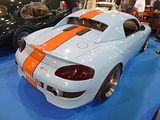

There was a more recent 718 Cayman here, too.
Final Porsche here was a Carrera GT. Synonymous with Porsche’s endurance racing programme and Le Mans in particular, where they have triumphed some 17 times, the design of the Porsche Carrera GT is firmly rooted in its motorsport lineage. After success in 1998 at the famous 24-hour race, a team of engineers started work on a new mid-engined V-10 model utilising advanced technologies and materials. However, the project was soon put on hold as the company decided to focus its energies in a different direction with the introduction of a new SUV and the development of the Porsche Cayenne. Fortunately, the Carrera GT project was kept alive, and a prototype was shown at the 2000 Paris Auto Show. Response to the car was enthusiastic prompting Porsche to commit to a limited production run of 1,500 cars. By the end of production in 2006, only 1,270 cars were built, making it rarer still. With its 5.7 litre, dry sump V-10 engine (producing around 612 brake horsepower) sitting low in the carbon-fibre chassis, the Carrera GT weighed in at 1,380kg and was capable of 0-60 mph in 3.5 seconds with a top speed of 205 mph. Open the driver’s door and you are immediately aware that this is a totally focussed, seriously fast Porsche with the sense of function only just lightened by the Beechwood gear knob – a nod to the famous Porsche 917 and its racing past.
RENAULT
Renault made over 8 million R4 models between 1961 and the end of production in 1992, and the car was very popular not just in its native France, but throughout Europe throughout the 70s, but when did you last see one? There are some left, but not many, as rust has claimed almost all those 8 million, even in its native France. There was one here, a late model car which had the 1108cc engine was standard, and the handbrake had been moved to the floor, though it still had the toffee apple on a stick style gear lever sprouting from the middle of the dash.
RENAULT-ALPINE
Sole example of the Renault-Alpine that I saw here was an A110. This was introduced as an evolution of the A108. Like other road-going Alpines, the 1961 A110 used many Renault parts – including engines. But while the preceding A108 was designed around Dauphine components, the A110 was updated to use R8 parts. Unlike the A108, which was available first as a cabriolet and only later as a coupé, the A110 was delivered first with “Berlinetta” bodywork and then as a cabriolet. The main visible difference with the A108 coupé was a restyling of the rear body to fit the larger engine, which gave the car a more aggressive look. Like the A108, the A110 featured a steel backbone chassis with fibreglass body. The A110 was originally available with 1.1 litre R8 Major or R8 Gordini engines. The Gordini engine delivered 95 hp at 6,500 rpm. The A110 achieved most of its fame in the early 1970s as a victorious rally car. After winning several rallies in France in the late 1960s with iron-cast R8 Gordini engines the car was fitted with the aluminium-block Renault 16 TS engine. With two dual-chamber Weber 45 carburettors, the TS engine delivered 125 hp at 6,000 rpm. This allowed the production 1600S to reach a top speed of 210 km/h (130 mph). The longer wheelbase 2+2 Alpine GT4, originally considered a version of the A108, was updated with A110 engines and mechanicals, now being marketed as the “A110 GT4”. The car reached international fame during the 1970–1972 seasons when it participated in the newly created International Championship for Manufacturers, winning several events around Europe and being considered one of the strongest rally cars of its time. Notable performances from the car included victory in the 1971 Monte Carlo Rally with Swedish driver Ove Andersson. With the buy-out of Alpine by Renault complete, the International Championship was replaced by the World Rally Championship for 1973, at which time Renault elected to compete with the A110. With a team featuring Bernard Darniche, Jean-Pierre Nicolas and Jean-Luc Thérier as permanent drivers and “guest stars” like Jean-Claude Andruet (who won the 1973 Monte Carlo Rally) the A110 won most races where the works team was entered, making Alpine the first World Rally Champion. Later competition-spec A110s received engines of up to 1.8 litres. As well as being built at Alpine’s Dieppe factory, A110 models were constructed by various other vehicle manufacturers around the world. The Alpine A110 was produced in Mexico under the name “Dinalpin”, from 1965 to 1974, by Diesel Nacional (DINA), which also produced Renault vehicles. The Alpine A110 was also produced in Bulgaria under the name “Bulgaralpine”, from 1967 to 1969, by a cooperative formed between SPC Metalhim and ETO Bulet, whose collaboration also resulted in the production of the Bulgarrenault. In 1974 the mid-engined Lancia Stratos, the first car designed from scratch for rally racing, was operational and homologated. At the same time, it was obvious that the tail-engined A110 had begun reaching the end of its development. The adoption of fuel injection brought no performance increase. On some cars, a DOHC 16-valve head was fitted to the engine, but it proved unreliable. Chassis modification, like the use of an A310 double wishbone rear suspension, homologated with the A110 1600SC, also failed to increase performance. On the international stage, the Stratos proved to be the “ultimate weapon”, making the A110, as well as many other rally cars, soon obsolete. The A110 is still seen in events such as the Rallye Monte-Carlo Historique and there was a nice example here.
ROLLS ROYCE
When new, the Silver Shadow was considered a big car, but looking at this one, it does not seem quite so massive any more.The Silver Shadow was produced from 1965 to 1976, and the Silver Shadow II from 1977 to 1980. Initially, the model was planned to be called “Silver Mist”, a natural progression from its predecessor Silver Cloud. The name was changed to “Silver Shadow” after realising that “Mist” is the German word for manure, rubbish, or dirt. The design was a major departure from its predecessor, the Silver Cloud; although several styling cues from the Silver Cloud were modified and preserved, as the automobile had sold well. The John Polwhele Blatchley design was the firm’s first single bow model. The original Shadow was 3 1⁄2 inches narrower and 7 inches shorter than the car it replaced, but nevertheless managed to offer increased passenger and luggage space thanks to more efficient packaging made possible by unitary construction. Aside from a more modern appearance and construction, the Silver Shadow introduced many new features such as disc rather than drum brakes, and independent rear suspension, rather than the outdated live axle design of previous cars. The Shadow featured a 172 hp 6.2 litre V8 from 1965 to 1969, and a 189 hp 6.75 ltire V8 from 1970 to 1980. Both powerplants were coupled to a General Motors-sourced Turbo Hydramatic 400 automatic gearbox, except on pre-1970 right-hand-drive models, which used the same 4-speed automatic gearbox as the Silver Cloud (also sourced from General Motors, the Hydramatic). The car’s most innovative feature was a high-pressure hydropneumatic suspension system licensed from Citroën, with dual-circuit braking and hydraulic self-levelling suspension. At first, both the front and rear of the car were controlled by the levelling system; the front levelling was deleted in 1969 as it had been determined that the rear levelling did almost all the work. Rolls-Royce achieved a high degree of ride quality with this arrangement. In 1977, the model was renamed the Silver Shadow II in recognition of several major changes, most notably rack and pinion steering; modifications to the front suspension improved handling markedly. Externally, the bumpers were changed from chrome to alloy and rubber starting with the late 1976 Silver Shadows. These new energy absorbing bumpers had been used in the United States since 1974, as a response to tightening safety standards there. Nonetheless, the bumpers on cars sold outside of North America were still solidly mounted and protruded 2 in less. Also now made standard across the board was the deletion of the small grilles mounted beneath the headlamps. Outside of North America, where tall kerbs and the like demanded more ground clearance, a front skirt was also fitted to the Silver Shadow II and its sister cars. In 1979 75 Silver Shadow II cars were specially fitted to commemorate the 75th anniversary of the company with the original red “RR” badges front and rear, pewter/silver paint, grey leather with red piping, scarlet red carpets, and a silver commemorative placard on the inside of the glove box door. 33 75th anniversary cars were designated for and shipped to the North American market. 8425 examples of the Shadow II were made, which, when added to the total of over 16,000 of the first generation cars made this the biggest selling Rolls Royce of all time.
Corniche
SAVIO
Two brothers founded this now little known Italian coachbuilder in 1919. Inspired by the concept of the Mini Moke, they produced something similar, based on the Fiat 600, the Jungla. Presented at the Turin Motor Show in 1965, three pre-series were made: a light green (as per the original brochure) then painted a cream with a light cover; a grey model with black cover subsequently destroyed in an accident; an ivory tint with a black roof (then redone) with a modified boot and an folding backseat for the transport of goods up to 250 kg. This latter also came serve as the basis for an armed forces version, built by Cecchignola. Among the distinguishing features of the Jungla were collapsible windscreen that was placed on two grommets attached to the bonnet, the interior was very spartan (consisting only of the Fiat 500 speedometer placed to the right of the steering wheel with a fuel gauge and warning lights for oil pressure, fuel reserve, battery charge from the dynamo, high beam and water temperature. There was only one windscreen wiper with an exposed motor, the external spare wheel was anchored to the bodywork and equipped with an anti-theft lanyard. It was possible to specify it in eight different colours; green (military and sage), red, orange, yellow (school bus), white, blue, beige. Until 1969 these models, instead of doors, had simple canvas-covered frames, on which the upper part, always in canvas, was inserted under pressure, including the side windows. From that year the doors were mounted on sheet metal, and the rear was modified with the use of new hinges that allowed the boot to open without removing the spare wheel and the body was strengthened with a modification of the side panels now with ribs. Total production, which ran until 1974, was 3200 cars including those supplied to various Italian state bodies: Enel, Stipel, Guardia, Carabinieri, Police hunting. Some cars had SEAT engine and with a fibreglass bonnet and one had Zastava mechanicals.
SIATA
Siata (Società Italiana Auto Trasformazioni Accessori or in English, “Italian Car Transformation Accessories Company”) was an Italian car tuning shop and manufacturer founded in 1926 by amateur race car driver Giorgio Ambrosini. Siata initially sold performance parts to modify and tune cars manufactured by Fiat. After World War II, the company began making its own sports cars under the Siata brand until its eventual bankruptcy following the first Arab oil embargo in the mid-1970s. Production of Siata’s first wholly original design the Siata Amica began in 1948 and continued through 1952. The Amica was powered by a Fiat 500 cc engine capable of producing 22 hp with an optional 750 cc unit producing 25 hp. The Amica was available in both two-seater convertible/spider and coupé configurations.
The Siata Spring was a 2-seater roadster built by Siata on the basis of the 850. Introduced in 1967, it featured retro styling with a mock upright radiator grille, separate wings and headlights, and running boards. In Italy it was initially priced at 795,000 Lire, 255 thousand Lire cheaper than Fiat’s Bertone 850 Spider. Top speed was 125 km/h (78 mph).
SIMCA
The humble 1000 served as the platform for the 1000 Coupe, a handsome sports coupe that made its appearance in 1962. Conceived to raise the profile of the new 1000 internationally, and mindful of the precedent set by Renault with their (initially Frua bodied) Renault Floride, Simca had turned initially to Facel to discuss a joint project with Facel producing the bodies, but Pigozzi felt that Facel’s proposal lacked the necessary style and was considered unrealistic: there were also concerns that Facel’s parlous financial position might impact the project adversely. Simca then turned to Bertone and commissioned a coupe version of their new car. Bertone gave the job to a recently recruited young designer called Giorgetto Giugiaro and the car, having already been heavily trailed, was formally launched at the Geneva Motor Show early in 1962, though official French homologation for production only took place in November 1962 and customer deliveries did not begin until 1963. The style of the car was widely admired, but the cost of the Bertone built body made it difficult for the car to compete on price alone, while use of the standard 944 cc engine block from the Simca 1000 meant that performance did not live up to its racey styling. From the start Simca presented the Coupé 1000 as a separate model. The car was moderately successful, especially in France, selling 10,600 cars in 5 years. In 1967, Simca upgraded the car to the more powerful 1200S Bertone Coupe that, with a horsepower upgrade in 1970, could reach the dizzying speed of almost 112 mph (180 km/h), making it the fastest standard production Simca ever built. When production ceased in 1971, it was revealed that around 25,000 of these cars had been made.
TALBOT
There was a nice example of the Sunbeam Lotus here, in the later of the two colour schemes in which the car was offered. The first ones were black and silver and the later ones, with a revised flush plastic grille were two tone blue and silver. The Sunbeam started off life as a Chrysler, launched in 1977, as the long awaited replacement for the Hillman Imp, production of which had ended a year earlier. Based on a cut-down version of the Avenger chassis, this neat looking hatch was initially offered with a choice of 1.0, 1.3 and 1.6 litre 4 cylinder engines and it retained rear wheel drive at a time when all the rivals were switching front wheel drive This was a move forced upon its maker by the lack of capital to do anything else, but whilst it was not great for space efficiency, it would have an advantage when it came to the sporting versions and indeed for what would turn out to be a very successful career in motorsport. The sporting road cars hit the market in 1979, and these are the only examples of the Sunbeam that you tend to see these days. By the time they hit the market, the Chrysler badging had gone, as a consequence of the sale of Chrysler’s European business to Peugeot-Citroen in the summer of 1978 meant that by mid 1979 a new name was required. The old Talbot branding was dusted off and overnight the cars all became Talbots. The first potent Sunbeam to appear had been the Ti, a sort of modern day version of the Avenger Tiger, with a 110 bhp twin carb 1600cc engine under the bonnet. It went on sale in the spring of 1979, as an appetiser for something more special, which had been unveiled at the Geneva Show in March, a few weeks earlier. The Sunbeam Lotus was the fruits of Chrysler’s commission to sports car manufacturer and engineering company Lotus to develop a strict rally version of the Sunbeam. The resulting ‘”Sunbeam Lotus” was based on the Sunbeam 1.6 GLS, but fitted with stiffer suspension, a larger anti-roll bar and a larger transmission tunnel. The drivetrain comprised an enlarged 2172 cc version of the Lotus 1973 cc 907 engine, a 16 valve slant four engine (the Sunbeam version being type 911, similar to the “Lotus 912”), along with a ZF gearbox, both mounted in the car at Ludham Airfield, close to the Lotus facility in Hethel, Norfolk, where the almost-complete cars were shipped from Linwood. Final inspection, in turn, took place in Stoke, Coventry. In road trim, the Lotus type 911 engine produced 150 bhp at 5,750rpm and 150 lb/ft of torque at 4,500rpm. In rallying trim this was increased to 250 bhp Production cars were not actually ready for deliveries to the public until after the mid-year rebranding, and thus became the “Talbot Sunbeam Lotus”. At first these were produced mostly in black and silver, although later models came in a moonstone blue and silver (or black) scheme. The car saw not only enthusiastic press reviews, but also much success in the World Rally Championship – in 1980, Henri Toivonen won the 29th Lombard RAC Rally in one, and, in 1981, the Sunbeam Lotus brought the entire manufacturer’s championship to Talbot. There is an enthusiastic following for Sunbeam Lotus cars these days.
TRIUMPH
Launched in 1955 the TR3 was a clear evolution of the TR2 and not a brand new model. It was powered by a 1991 cc straight-4 OHV engine initially producing 95 bhp, an increase of 5 hp over the TR2 thanks to the larger SU-H6 carburettors fitted. This was later increased to 100 bhp at 5000 rpm by the addition of a “high port” cylinder head and enlarged manifold. The four-speed manual gearbox could be supplemented by an overdrive unit on the top three ratios, electrically operated and controlled by a switch on the dashboard. In 1956 the front brakes were changed from drums to discs, the TR3 thus becoming the first British series production car to be so fitted. The TR3 was updated in 1957, with various changes of which the full width radiator grille is the easiest recognition point and the facelifted model is commonly referred to as the Triumph “TR3A”, though unlike the later TR4 series, where the “A” suffix was adopted, the cars were not badged as such and the “TR3A” name was not used officially, Other updates included exterior door handles, a lockable boot handle and the car came with a full tool kit as standard (this was an option on the TR3). The total production run of the “TR3A” was 58,236. This makes it the third best-selling TR after the TR6 and TR7. The TR3A was so successful that the original panel moulds eventually wore out and had to be replaced. In 1959 a slightly modified version came out that had raised stampings under the bonnet and boot hinges and under the door handles, as well as a redesigned rear floor section. In addition, the windscreen was attached with bolts rather than the Dzus connectors used on the early “A” models. Partly because it was produced for less time, the original TR3 sold 13,377 examples, of which 1286 were sold within the UK; the rest being exported mainly to the USA.
This is a Triumph Italia 2000 Coupé. It was built between 1959 and 1962, during which time 329 cars were produced. Designed by Giovanni Michelotti, the TR3 chassis and mechanical components were supplied by the Triumph Motor Company in the United Kingdom, and built by Alfredo Vignale in Turin, Italy. Designed by Giovanni Michelotti and built by Alfredo Vignale in Turin, under contract to Ruffino S.p.A. Industria Construzione Automobile of Naples – it was thought that these cars would appeal to people willing to spend more for the dependability and ease of obtaining stock mechanical parts of a Triumph, but who wanted a better looking car than the standard Triumph. At the time, Salvatore Ruffino was the owner of CESAC, the Italian company that distributed Standard-Triumph in Italy. He approached Standard-Triumph to supply chassis and mechanical components to build 1,000 cars. Ruffino approached a number of carrozzeria, including Zagato. He had not found a design that was to his liking and was later introduced to the young, Giovanni Michelotti. It was this introduction that was to lead to the Triumph Italia. The resulting two door coupé, now referred to as the “slope-nosed prototype,” was well received at the 1958 Turin Motor Show – “Italian artistry and British craftsmanship have come together and produced this new, superlative Italia 2000 Coupé.” A second prototype was built with a revised nose and rear roof line. The change was necessary after road tests with the first prototype highlighted some handling issues. This second prototype was much closer to the final “look” of the Italia. The first prototype was converted into another car, quite possibly the second prototype. This second car still survives. The 1959 Turin show featured another early car (probably Italia #3) on the Triumph stand and, by all accounts, the motoring press was impressed. The first two “show” cars were Italia #1 which was delivered to Standard-Triumph for testing and Italia #2 which was reputedly Ruffino’s personal car. These early show cars had many small differences from the later “production” run. The first 13 cars were assembled completely by Vignale. These cars have a number of different badges but not all appeared on all of these “show” cars. On the nose was a large “V” (for Vignale) badge, a “by G. Michelotti” badge on the bonnet, small “Vignale” scripts and a cloisonné Vignale-badge on the front wings, “Triumph Italia” on the rear wings with a set of Vignale crossed-flags (these are very similar to the ones on the S-T Vignale Vanguard, they are nautical flags for “V” and “S,” the “S” presumably for Standard-Triumph), a large Vignale script on the boot handle and a “Triumph 2000” script on the boot. After the first 13, Ruffino took over production on an assembly line he leased from Vignale for the remainder of production. Ruffino began full production in December 1959 with only a few changes from the Vignale-built “show” cars. The most noticeable differences include the badging. The car was no longer billed as the “Triumph Italia” and was now referred to as the “Italia 2000.” Other than a cloisonné Vignale-badge on the front wings and crossed-flags on the rear wings, all other references to Vignale were removed. The only reference to Triumph were the “T.M. Triumph” badges on the rear wings. Subsequent investigation points to the “T.M.” representing the Italian (Telaio e Motore) for “Chassis and Engine.” Perhaps the easiest method to identify a “production” Italia is the use of side marker lights on the front wings. While aluminium was used for a few internal panels, all Italias used steel for the bodywork. Each Italia has a small badge located near the bonnet catch, identifying its place in production. For the production series, this badge was riveted in place. If this badge is missing, the number can be found stamped on other parts of the car or written on the backs of the interior panels. In the case of a missing badge, it is important for owners to check in multiple places for numbers as occasionally parts from cars being assembled at the same time were interchanged with others. Cars in the 1XX or 2XX series may only have the last two digits of their numbers stamped on subsequent parts. Chassis were not used consecutively and this can make it difficult to identify a car if the S-T chassis plate is missing. If the original engine is still in place, the chassis number can be found from this. It would be highly unusual for a TR series car to have an engine and chassis number that are the same, because engines were pulled from the assembly line to supply other manufacturers, including Morgan and Peerless. No Italia has matching engine and chassis numbers. Ruffino envisioned building 1,000 cars, between 1960 and 1962, with worldwide distribution including the American marketplace. He had a verbal agreement to have every Triumph dealer (720) purchase an Italia. The Italia never became an official model of Standard-Triumph. Faced with ensuing financial and labour problems, Standard-Triumph was taken over by Leyland Motors in 1961. The new management did not follow through with the verbal contract that Ruffino had made with Triumph. Perhaps fearing increased competition, Triumph concentrated their efforts on the new TR4 to be released in 1962. The TR4, also designed by Michelotti, clearly borrowed many elements from the Italia: the distinctive bonnet bulge, kick-up door with wind-up windows, and roomier modern body design. With Triumph’s decision not to distribute the Italia, Ruffino S.p.A. re-badged the car as the Italia 2000 and continued production. Over a three-year production period (mid-1959 to mid-1962) Vignale produced approximately 329 cars. Six cars were produced in right-hand drive. The first show car, Italia #1, was converted to right-hand drive after being sold by Standard-Triumph. After a six-month halt in production, the last run of 30 cars was based on the TR3B chassis. These all used the TSF chassis specification and, as such, retained the 1991cc engine and non-synchro first gear transmission of the TR3.
Also here was the TR4. Successor to the TR3a, and code named “Zest” during development, the TR4 was based on the chassis and drivetrain of the previous TR sports cars, but with a modern Michelotti styled body. The TR 4 engine was carried over from the earlier TR2/3 models, but the displacement was increased from 1991cc to 2138 cc by increasing the bore size. Gradual improvements in the manifolds and cylinder head allowed for some improvements culminating in the TR4A model. The 1991 cc engine became a no-cost option for those cars destined to race in the under-two-litre classes of the day. Some cars were fitted with vane-type superchargers, as the three main bearing engine was liable to crankshaft failure if revved beyond 6,500 rpm; superchargers allowed a TR4 to produce much more horse-power and torque at relatively modest revolutions. The standard engine produced 105 bhp but, supercharged and otherwise performance-tuned, a 2.2-litre I4 version could produce in excess of 200 bhp at the flywheel. The TR4, in common with its predecessors, was fitted with a wet-sleeve engine, so that for competition use the engine’s cubic capacity could be changed by swapping the cylinder liners and pistons, allowing a competitor to race under different capacity rules (i.e. below or above 2 litres for example). Other key improvements over the TR3 included a wider track front and rear, slightly larger standard engine displacement, full synchromesh on all forward gears, and rack and pinion steering. In addition, the optional Laycock de Normanville electrically operated overdrive Laycock Overdrive could now be selected for 2nd and 3rd gear as well as 4th, effectively providing the TR4 with a seven-speed manual close ratio gearbox. The TR4 was originally fitted with 15×4.5″ disc wheels. Optional 48-lace wire wheels could be ordered painted the same colour as the car’s bodywork (rare), stove-enamelled (matte silver with chrome spinners, most common) or in matte or polished chrome finishes (originally rare, but now more commonly fitted). The most typical tyre originally fitted was 590-15 bias ply or optional radial tires. In the US at one point, American Racing alloy (magnesium and aluminium) wheels were offered as an option, in 15×5.5″ or 15×6″ size. Tyres were a problem for original owners who opted for 60-spoke wire wheels, as the correct size radial-ply tyre for the factory rims was 155-15, an odd-sized tyre at the time only available from Michelin at considerable expense. Some original TR4 sales literature says the original radial size was 165-15. The much more common 185-15 radials were too wide to be fitted safely. As a result, many owners had new and wider rims fitted and their wheels re-laced. The new TR4 body style did away with the classical cutaway door design of the previous TRs to allow for wind-down windows (in place of less convenient side-curtains), and the angular rear allowed a boot with considerable capacity for a sports car. Advanced features included the use of adjustable fascia ventilation, and the option of a unique hard top that consisted of a fixed glass rear window (called a backlight) with an integral rollbar and a detachable, steel centre panel (aluminium for the first 500 units). This was the first such roof system on a production car and preceded by 5 years the Porsche 911/912 Targa, which has since become a generic name for this style of top. On the TR4 the rigid roof panel was replaceable with an easily folded and stowed vinyl insert and supporting frame called a Surrey Top. The entire hard top assembly is often mistakenly referred to as a Surrey Top. In original factory parts catalogues the rigid top and backlight assembly is listed as the Hard Top kit. The vinyl insert and frame are offered separately as a Surrey Top. Features such as wind-down windows were seen as a necessary step forward to meet competition and achieve good sales in the important US market, where the vast majority of TR4s were eventually sold. Dealers had concerns that buyers might not fully appreciate the new amenities, therefore a special short run of TR3As (commonly called TR3Bs) was produced in 1961 and ’62. The TR4 proved very successful and continued the rugged, “hairy-chested” image that the previous TRs had enjoyed. 40,253 cars were built during production years. Most were sold new to the US, but plenty have returned, and it is estimated that there are not far short of 900 examples of the model in the UK at present.
The TR’s smaller and cheaper brother was the Spitfire and there was example of the first generation car here. Based on the chassis and mechanicals of the Triumph Herald, the Spitfire was conceived as a rival to the Austin-Healey Sprite and MG Midget, which were launched a year earlier. The Triumph soon found a strong following, with many preferring it to the BMC cars which in time would become in-house stablemates. Mark II models arrived in 1965 and a more comprehensive facelift in 1967 with the distinctive “bone in mouth” front grille necessitated by US bumper height regulations also brought changes, but it was with the Mark IV that the greatest number of alterations would come about. The Mark IV featured a completely re-designed cut-off rear end, giving a strong family resemblance to the Triumph Stag and Triumph 2000 models, both of which were also Michelotti-designed. The front end was also cleaned up, with a new bonnet pressing losing the weld lines on top of the wings from the older models, and the doors were given recessed handles and squared-off glass in the top rear corner. The interior was much improved: a proper full-width dashboard was provided, putting the instruments ahead of the driver rather than over the centre console. This was initially black plastic however was replaced with wood in 1973. An all-new hardtop was also available, with rear quarter-lights and a flatter rear screen. By far the most significant change, however, was to the rear suspension, which was de-cambered and redesigned to eliminate the unfortunate tendencies of the original swing-axle design. The Triumph GT6 and Triumph Vitesse had already been modified, and the result on all these cars was safe and progressive handling even at the limit. The 75 hp engine was now rated at 63 hp (for UK market employing the 9:1 compression ratio and twin SU HS2 carburettors; the less powerful North American version still used a single Zenith Stromberg carburettor and an 8.5:1 compression ratio) due to the German DIN system; the actual output was the same for the early Mark IV. However, it was slightly slower than the previous Mark III due to carrying more weight, and employing a taller 3.89:1 final drive as opposed to the earlier 4.11:1. The engine continued at 1296 cc, but in 1973 was modified with larger big-end bearings to rationalise production with the TR6 2.5 litre engines, which somewhat decreased its “revvy” nature; there was some detuning, to meet new emissions laws, which resulted in the new car being a little tamer. With the overall weight also increasing to 1,717 lb (779 kg) the performance dropped as a consequence, 0 to 60 mph now being achieved in 15.8 seconds and the top speed reducing to 90 mph. The overall fuel economy also dipped to 32mpg. The gearbox gained synchromesh on its bottom gear. The Mark IV went on sale in the UK at the end of 1970 with a base price of £735. In 1973 in the United States and Canada, and 1975 in the rest of the world, the 1500 engine was used to make the Spitfire 1500. Although in this final incarnation the engine was rather rougher and more prone to failure than the earlier units, torque was greatly increased by increasing the cylinder stroke to 87.5 mm (3.44 in), which made it much more drivable in traffic. While the rest of the world saw 1500s with the compression ratio reduced to 8.0:1, the American market model was fitted with a single Zenith-Stromberg carburettor and a compression ratio reduced to 7.5:1 to allow it to run on lower octane unleaded fuel, and after adding a catalytic converter and exhaust gas recirculating system, the engine only delivered 53 bhp with a slower 0–60 time of 16.3 seconds. The notable exception to this was the 1976 model year, where the compression ratio was raised to 9.1:1. This improvement was short-lived, however, as the ratio was again reduced to 7.5:1 for the remaining years of production. In the UK the 9:1 compression ratio, less restrictive emissions control equipment, and the Type HS2 SU carburettors now being replaced with larger Type HS4 models, led to the most powerful variant to date. The 1500 Spitfire now produced 71hp (DIN) at 5500 rpm, and produced 82 lb/ft of torque at 3000 rpm. Top speed was now at the magical 100 mph mark, and 0 to 60 mph was reached in 13.2 seconds. Fuel economy was reduced to 29mpg. Further improvements to the suspension followed with the 1500 included longer swing axles and a lowered spring mounting point for more negative camber and a wider rear track. The wider, lower stance gave an impressive skid pad result of 0.87g average. This put the Spitfire head and shoulders over its competition in handling. The American market Spitfire 1500 is easily identified by the big plastic over-riders and wing mounted reflectors on the front and back wings. The US specification models up to 1978 still had chrome bumpers, but on the 1979 and 1980 models these were replaced by black rubber bumpers with built-in over-riders. Chassis extensions were also fitted under the boot to support the bumpers. Detail improvements continued to be made throughout the life of the Mark IV, and included reclining seats with “chequered brushed nylon centre panels” and head restraints, introduced for domestic market cars early in 1977 along with a new set of column stalk operated minor controls (as fitted already in the TR7) replacing the old dashboard mounted knobs and switches. Also added for the model’s final years were a wood dash, hazard flashers and an electric screen washer, in place of the previous manual pump operated ones. Options such as the hard top, tonneau cover, map light and overdrive continued to be popular, but wire wheels ceased to be available. The 1980 model was the last and the heaviest of the entire run, weighing 1,875 lb (850.5 kg). Base prices for the 1980 model year was £3,631 in the UK. The last Spitfire, an Inca Yellow UK-market model with hardtop and overdrive, rolled off the assembly line at Canley in August 1980, shortly before the factory closed. It was never sold and is now displayed at the museum at Gaydon.
VAUXHALL
This long-running car was produced from 1913 to 1927, although it is believed that only 13 30/98s were made before war intervened and these were all for selected drivers, the last of these pre war cars, built in 1915 for Percy Kidner a joint Managing Director of Vauxhall. Actual production began in 1919. Also known as the E Type, the 30/98 name is believed to have been coined because the car had an output of 30 bhp at 1,000 rpm and 98 bhp at 3,000 rpm, though another explanation is that it had an RAC horsepower rating of 30 and a cylinder bore of 98 mm. Perhaps the most likely of all is that there was then a popular but heavier slower Mercedes 38/90. However it was found, the name 30-98 looked and sounded so well and the car proved popular. The 30/98s used the earlier Prince Henry chassis, but were distinguished by having more-or-less flat rather than V-shaped radiators. Laurence Pomeroy took the Prince Henry L-head side-valve engine, bored it out 3 mm, then cold-stretched the crankshaft throws 5 mm using a steam power hammer to lengthen the stroke. The camshaft was given a new chain drive at the front of the engine, high lift cams and new tappet clearances. The Prince Henry chassis was slightly modified and the whole given a narrow alloy four-seater body, a pair of alloy wings (front mudguards) and no doors. The first 30/98 was constructed at the behest of car dealer and motor sport competitor, Joseph Higginson—inventor of the Autovac fuel lifter—who won the Shelsley Walsh hill-climb motoring competition on 7 June 1913 in his new Vauxhall, setting a hill record in the process, having in previous weeks made fastest time of the day at Waddington Pike and Aston Clinton, but these were not racing machines but fast touring cars. The exhaust made a tranquillising rumble, there was no howl, no shriek, no wail, but there was the quiet satisfaction of knowing that if stripped for action, the car could lap Brooklands at 100 mph, and its makers guaranteed that. Most of them were built with a 4 seater open tourer body, though other body styles were produced as well.
VOLKSWAGEN
Known as the “Maggiolino” in Italy, the classic “Beetle” was a popular import, even in an era when the market largely bought the domestic product, so it was no surprise to find examples of this enduring classic here, with both a 1200 Saloon and a 1303 Cabrio among them. The Cabrio models were produced by Karmann at their Osnabruck facility. Production of an open-topped Type 1 Beetle Cabriolet began in 1949. The convertible was more than a Beetle with a folding top. To compensate for the strength lost in removing the roof, the sills were reinforced with welded U-channel rails, a transverse beam was fitted below the front edge of the rear seat cushion, and the side cowl-panels below the instrument panel were double-wall. In addition, the lower corners of the door apertures had welded-in curved gussets, and the doors had secondary alignment wedges at the B-pillar. The top was cabriolet-style with a full inner headliner hiding the folding mechanism and crossbars. In between the two top layers was 1 in (25 mm) of insulation. The rear window was tempered safety glass, and after 1968, heated. Due to the thickness of the top, it remained quite tall when folded. To enable the driver to see over the lowered top, the inside rearview was mounted on an offset pivot. By twisting the mirror 180 degrees on a longitudinal axis, the mirror glass would raise approximately 2 in (5.1 cm). The convertible was generally more lavishly equipped than the sedan with dual rear ashtrays, twin map pockets, a visor vanity mirror on the passenger side, rear stone shields, and through 1969, wheel trim rings. Many of these items did not become available on other Beetles until the advent of the optional “L” (Luxus) Package of 1970. After a number of stylistic and technical alterations made to the Karmann cabriolet, corresponding to the many changes VW made to the Beetle throughout its history, the last of 331,847 cabriolets came off the production line on 10 January 1980.
There was also a Type 2 here. This was one of the post 1968 models sometimes referred to as the ” Bay Window”, thanks to the large single piece windscreen which featured on the model for the first time.
Also related to the Beetle was this nice example of the Type 1, or sometimes known as Type 14, Karmann Ghia Cabrio. The model debuted at the October 1953 Paris Auto Show as a styling concept created for Ghia by Luigi Segre. In the early 1950s, Volkswagen was producing its economy car, the Type 1 (Beetle), but with an increase in post-war standards of living, executives at Volkswagen proposed adding a halo car to its model range, contracting with German coachbuilder Karmann for its manufacture. Karmann in turn contracted the Italian firm Ghia, who adapted styling themes previously explored for Chrysler and Studebaker to a Beetle floorpan widened by 12 in. Virgil Exner claimed that the design was his, based on the 1953 Chrysler D’Elegance. In contrast to the Beetle’s machine-welded body with bolt-on wings, the Karmann Ghia’s body panels were butt-welded, hand-shaped, and smoothed with English pewter in a time-consuming process commensurate with higher-end manufacturers, resulting in the Karmann Ghia’s higher price. The design and prototype were well received by Volkswagen executives, and in August 1955 the first Type 14 was manufactured in Osnabrück, Germany. Public reaction to the Type 14 exceeded expectations, and more than 10,000 were sold in the first year. The Type 14 was marketed as a practical and stylish 2+2 rather than as a true sports car. As they shared engines, the Type 14’s engine displacement grew concurrently with the Type 1 (Beetle), ultimately arriving at a displacement of 1584 cc, producing 60 hp. In August 1957, Volkswagen introduced a convertible version of the Karmann Ghia. Exterior changes in 1961 included wider and finned front grilles, taller and more rounded rear taillights and headlights relocated to a higher position – with previous models and their lower headlight placement called lowlights. The Italian designer Sergio Sartorelli, designer of the larger Type 34 model, oversaw the various restylings of the Type 14. In 1970, larger taillights integrated the reversing lights and larger wrap-around indicators. Still larger and wider taillights increased side visibility. In 1972, large square-section bumpers replaced the smooth round originals. For the USA model only, 1973 modifications mandated by the National Highway Traffic Safety Administration (NHTSA) included energy-absorbing bumpers. A carpeted package shelf replaced the rear seat. In late 1974 the car was superseded by the Porsche 914 and the Golf based Scirocco.
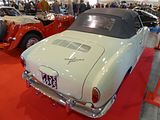
There was also a 181 Trekka here. These were made from 1968 to 1983. Originally developed for the West German Army, the Type 181 was also sold to the public, as the Kurierwagen in West Germany, the Trekker (RHD Type 182) in the United Kingdom, the Thing in the United States (1973–74), the Safari in Mexico and South America, and Pescaccia in Italy. Civilian sales ended after model year 1980. Manufactured in Wolfsburg (1968–74), Hannover (1974–83), Puebla, Mexico (1970–80), and Jakarta, Indonesia (1973–80), the Type 181 shared its mechanicals with Volkswagen’s Type 1 (Beetle) and the pre-1968 Volkswagen Microbus, its floor pan with the Type 1 Karmann Ghia, and its concept with the company’s Kübelwagen, which had been used by the German military during World War II. 90,883 were built.
A Type 3 saloon completed the array of rear-engined Volkswagens on show here.
Volkswagen marked the 40th anniversary of the iconic Golf GTi with a special display which included an example of each of the 7 generations that have been produced.
Elsewhere there were a number of other examples of the Golf including the long-lived Mark 1 Cabrio.
In 1989, the Rallye Golf appeared as a rallye “homologation special”. Distinguishable by its box-flared wheel arches (similar to the Audi quattro, BMW E30 M3 and Lancia Delta Integrale) and rectangular projector headlamps, this model featured Syncro four-wheel drive, a cable shifted transmission and a G-supercharger 1763 cc (less than the typical 1781 cc to meet the engine displacement rules) 161 bhp version of the injected 8 valve G60 1.8 litre engine. 5000 cars were built in Volkswagen’s Brussels, Belgium, plant, priced at about DM 50,000 each (or roughly twice as much as a base Golf GTI).
There was also a version called Golf Country (7,735 cars built), co-manufactured by Steyr-Daimler-Puch in Austria, designed for medium off-road driving. It had more suspension travel, Syncro four-wheel drive, improved ground clearance of 21 centimetres (8.3 in), bullbars at front and rear (generally over a single headlight grille), a skid plate for protecting the engine area, sub-frame to protect the rear Syncro differential and propshaft and a spare wheel mounted externally on a swing-away triangular frame on the back. In Europe, it was offered with the 98 bhp 1.8 litre 8v 1P petrol engine. There were also: 1500 “Country Allround” designed to appeal to a wider public, made without the electric luxuries like electric and heated mirrors, leather steering wheel and bullbar without headlight grills, in relation to a more affordable price range; 558 ” Country – Chrompaket” with Chrome bullbars, Sliding sun roof, Engine and interior pre-heater and beige leather interior; and 50 “Country GTI” 114 bhp 1.8 GTI petrol engine, made only for Golf Country project VW-staff. The Golf Country was particularly popular in Alpine regions in central Europe.
VOLVO
Accompanying the launch of the new V90 Volvo, the Swedish marque laid on a display of Volvo estate cars from the past 50 years, with a nice progression of these models on show.
Oldest of the collection was a 221 Estate from the “Amazon” family. The cars were tough, as strong success in rallying evidenced, but not that many have survived. There’s a complex history to this model, with lots of different numbers applied to the car during a 13 year production run. When introduced, the car was named the Amason (with an ‘s’), deriving from the fierce female warriors of Greek mythology, the Amazons. German motorcycle manufacturer Kreidler had already registered the name, and the two companies finally agreed that Volvo could only use the name domestically (i.e., within Sweden), modifying the spelling to Amazon. Subsequently, Volvo began its tri-digit nomenclature and the line became known as the 120 Series. Under prototype designation 1200, following the PV444’s internal designation as the 1100, the Amazon was released in the press in February 1956, with production initially set to begin in July of the same year, and deliveries commenced in August 1956 — under the now modified internal designation 120 series. The Amazon sedan’s ponton genre, three-box styling was inspired by US cars of the early 1950s, strongly resembling the Chrysler New Yorker sedan and the Chrysler 300C hardtop Coupe. According to designer Jan Wilsgaard, the Amazon’s styling was inspired by a Kaiser he saw at the Gothenburg harbour. The Amazon featured strong articulation front to rear, pronounced “shoulders”, and slight but visible tailfins. These features became inspiration for Peter Horbury when reconceiving Volvo’s design direction with the V70 after decades of rectilinear, slab-sided, boxy designs. The Amazon’s bodywork was constructed of phosphate-treated steel (to improve paint adhesion) and with heavy use of undercoating and anti-corrosive oil treatment. The Amazon shared the wheelbase, tall posture and high H-point seating of its predecessor, the PV. In 1959 Volvo became the world’s first manufacturer to provide front seat belts as standard equipment — by providing them on all Amazon models, including the export models — and later becoming the first car featuring three-point seat belts as standard equipment. The Amazon’s handbrake location, outboard of the driver’s seat, was intended to accommodate subsequent bench seat models with column shift transmissions — which never materialised. Buyers began to receive the first cars in February 1957, and initial models were two-tone red and black with light grey roof, light grey with a black roof, followed by a dark blue with grey roof in 1958. Further iterations included the 121, the base model with a single carburettor 66 bhp engine, the 122S introduced in 1958 as a performance model equipped with a dual carburettor 85 bhp engine. The estate version was introduced at the 1962 Stockholm Auto Show, and Volvo manufactured 73,000 examples between 1962 and 1969. The Amazon estate featured a two-piece tailgate, with the lower section folding down to provide a load surface and the upper section that hinged overhead. The vehicle’s rear licence plate, attached to the lower tailgate, could fold “up” such that when the tailgate was lowered and the vehicle in use, the plate was still visible. This idea was used by the original 1959 Mini. In recent years a similar arrangement was used on the tailgate of the Subaru Baja. In 1966 the Volvo PV ended production, replaced by the Amazon Favorit, a less expensive version of the Amazon, without exterior chrome trim, a passenger-side sun visor or cigarette lighter, and with a three-speed rather than four-speed transmission — available in black with red interior and later white or black with red interior. The newer Volvo 140 was becoming the company’s mainstream model, and the last of the four-door 120 saloons were produced in 1967, the year which saw the launch of the 123GT, which was a Model 130 with high-compression four-cylinder B18B engine (from the Volvo P1800), M41 gearbox, fully reclining seats, front fog and driving lights (on some markets), alternator, fender mounted mirrors, special steering wheel, dash with a shelf and tachometer, and other cosmetic upgrades. In 1969 the displacement of the old B18 engine was increased and the engine was called the B20. The last Amazon was manufactured on 3 July 1970. By the end of production, 234,653 four-door models, 359,917 two-door models and 73,220 station wagons had been produced, of which 60% were exported; a total of 667,791 vehicles.
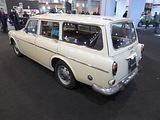
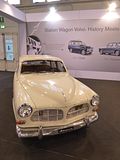
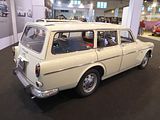
Other models in the display were the 240 Estate Polar, 850 T5-R and a V60 Polestar.
This is a nice example of the Volvo 1800ES, a sports car that was manufactured by Volvo Cars between 1961 and 1973. The car was a one-time venture by the usually sober Swedish Volvo, who already had a reputation for building sensible sedans. The project was originally started in 1957 because Volvo wanted a sports car to compete in the US and European markets, despite the fact that their previous attempt, the P1900, had failed to take off with only 68 cars sold. The man behind the project was an engineering consultant to Volvo, Helmer Petterson, who in the 1940s was responsible for the Volvo PV444. The design work was done by Helmer’s son Pelle Petterson, who worked at Pietro Frua at that time. Volvo insisted it was an Italian design by Frua and only officially recognised that it was by Pelle Petterson many years later. The Italian Carrozzeria Pietro Frua design firm (then a recently acquired subsidiary of Ghia) built the first three prototypes between September 1957 and early 1958, later designated by Volvo in September 1958: P958-X1, P958-X2 and P958-X3. In December 1957 Helmer Petterson drove X1, the first hand-built P1800 prototype to Osnabrück, West Germany, headquarters of Karmann. Petterson hoped that Karmann would be able to take on the tooling and building of the P1800. Karmann’s engineers had already been preparing working drawings from the wooden styling buck at Frua. Petterson and Volvo chief engineer Thor Berthelius met there, tested the car and discussed the construction with Karmann. They were ready to build it and this meant that the first cars could hit the market as early as December 1958. But in February, Karmann’s most important customer, Volkswagen forbade Karmann to take on the job, as they feared that the P1800 would compete with the sales of their own cars, and threatened to cancel all their contracts with Karmann if they took on this car. This setback almost caused the project to be abandoned. Other German firms, NSU, Drautz and Hanomag, were contacted but none was chosen because Volvo did not believe they met Volvo’s manufacturing quality-control standards. It began to appear that Volvo might never produce the P1800. This motivated Helmer Petterson to obtain financial backing from two financial firms with the intention of buying the components directly from Volvo and marketing the car himself. At this point Volvo had made no mention of the P1800 and the factory would not comment. Then a press release surfaced with a photo of the car, putting Volvo in a position where they had to acknowledge its existence. These events influenced the company to renew its efforts: the car was presented to the public for the first time at the Brussels Motor Show in January 1960 and Volvo turned to Jensen Motors, whose production lines were under-utilised, and they agreed a contract for 10,000 cars. The Linwood, Scotland, body plant of manufacturer Pressed Steel was in turn sub-contracted by Jensen to create the unibody shells, which were then taken by rail to be assembled at Jensen in West Bromwich. In September 1960, the first production P1800 left Jensen for an eager public. The engine was the B18, an 1800cc petrol engine, with dual SU carburettors, producing 100 hp. This variant (named B18B) had a higher compression ratio than the slightly less powerful twin-carb B18D used in the contemporary Amazon 122S, as well as a different camshaft. The ‘new’ B18 was actually developed from the existing B36 V8 engine used in Volvo trucks at the time. This cut production costs, as well as furnishing the P1800 with a strong engine boasting five main crankshaft bearings. The B18 was matched with the new and more robust M40 manual gearbox through 1963. From 1963 to 1972 the M41 gearbox with electrically actuated overdrive was a popular option. Two overdrive types were used, the D-Type through 1969, and the J-type through 1973. The J-type had a slightly shorter ratio of 0.797:1 as opposed to 0.756:1 for the D-type. The overdrive effectively gave the 1800 series a fifth gear, for improved fuel efficiency and decreased drivetrain wear. Cars without overdrive had a numerically lower-ratio differential, which had the interesting effect of giving them a somewhat higher top speed of just under 120 mph, than the more popular overdrive models. This was because the non-overdrive cars could reach the engine’s redline in top gear, while the overdrive-equipped cars could not, giving them a top speed of roughly 110 mph. As time progressed, Jensen had problems with quality control, so the contract was ended early after 6,000 cars had been built. In 1963 production was moved to Volvo’s Lundby Plant in Gothenburg and the car’s name was changed to 1800S (S standing for Sverige, or in English : Sweden). The engine was improved with an additional 8 hp. In 1966 the four-cylinder engine was updated to 115 PS, which meant the top speed increased to 109 mph. In 1969 the B18 engine was replaced with the 2-litre B20B variant of the B20 giving 118 bhp, though it kept the designation 1800S. For 1970 numerous changes came with the fuel-injected 1800E, which had the B20E engine with Bosch D-Jetronic fuel injection and a revised camshaft, and produced 130 bhp without sacrificing fuel economy. Top speed was around 118 mph and acceleration from 0–62 took 9.5 seconds. In addition, the 1970 model was the first 1800 with four-wheel disc brakes; till then the 1800 series had front discs and rear drums. Volvo introduced its final P1800 variant, the 1800ES, in 1972 as a two-door station wagon with a frameless, all-glass tailgate. The final design was chosen after two prototypes had been built by Sergio Coggiola and Pietro Frua. Frua’s prototype, Raketen (“the Rocket”), is located in the Volvo Museum. Both Italian prototypes were considered too futuristic, and instead in-house designer Jan Wilsgaard’s proposal was accepted. The ES engine was downgraded to 125 bhp by reducing the compression ratio with a thicker head gasket (engine variant B20F); although maximum power was slightly down the engine was less “peaky” and the car’s on-the-road performance was actually improved. The ES’s rear backrest folded down to create a long flat loading area. As an alternative to the usual four-speed plus overdrive manual transmission, a Borg-Warner three-speed automatic was available in the 1800ES. With stricter American safety and emissions standards looming for 1974, Volvo did not see fit to spend the considerable amount that would be necessary to redesign the small-volume 1800 ES. Only 8,077 examples of the ES were built in its two model years. Seen here is one of the 1800ES cars.
Needless to say, I enjoyed this event very much. There was a lot to see, and it was quite a challenge to do so in one day, but I gave it my very best shot. As in previous years, during the final couple of hours, the majority of other visitors head off home, and the show becomes quite quiet, which makes life a lot easier for the photographer, so I found a renewed burst of energy and sped around pretty much the whole site for a final time to get photos that had eluded me earlier in the day. Although I took more photos even than I did in 2015, there are plenty of cars that, for one reason or another, I missed, but with over 950 presented here, there are still plenty of memories of a varied array of fabulous machinery, quite a bit of which comes in the “super rare” category. It goes without saying that this event is firmly marked in my 2017 diary.


